

A GREATER OMAHA

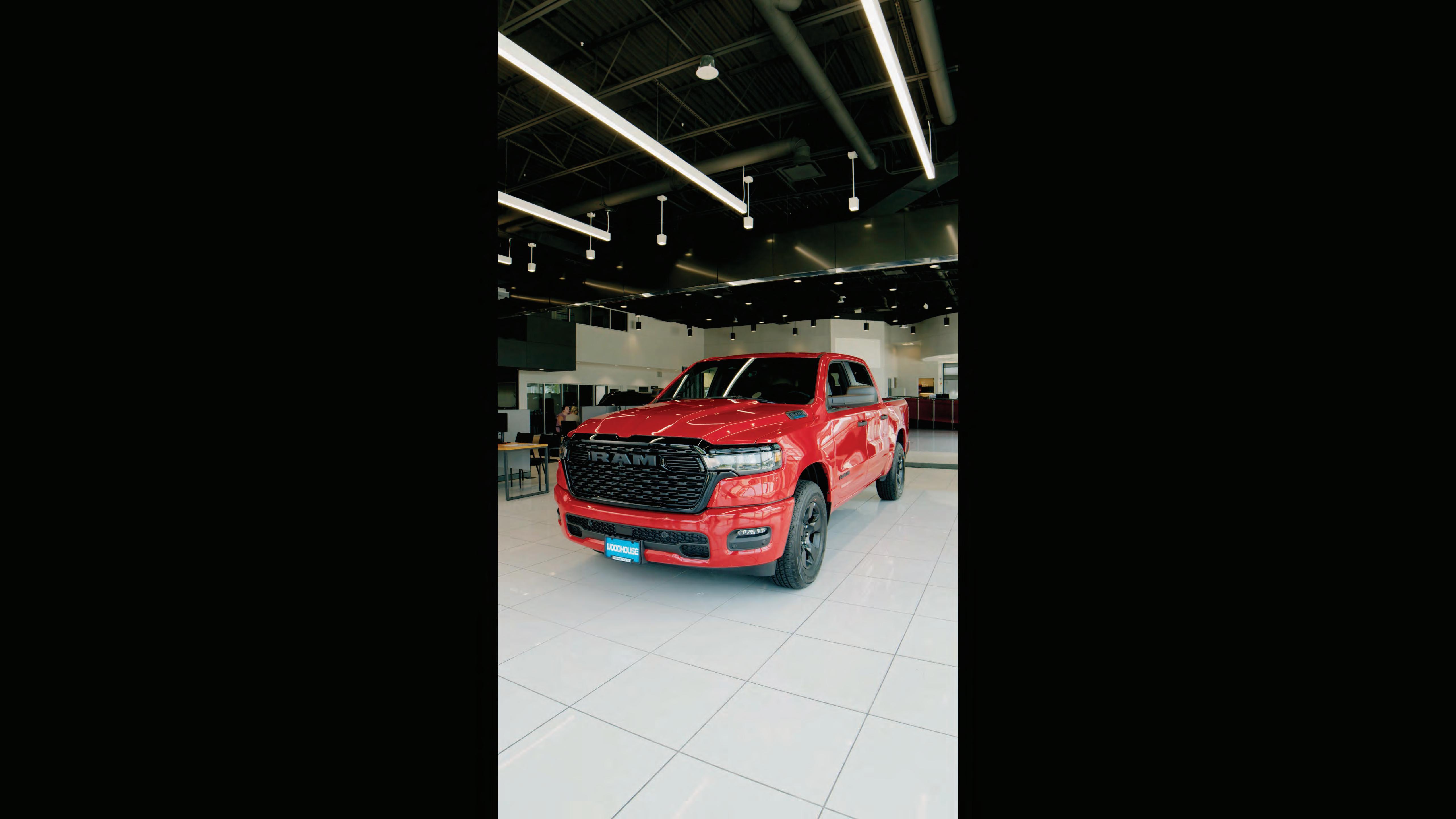

Whether we are reinventing a space or developing something new, we strive to create places that matter. At Noddle Companies, we are driven by our passion and commitment to making this a remarkable community.
THANK YOU to our clients, teammates, and community at large for allowing us to be part of our growing city.
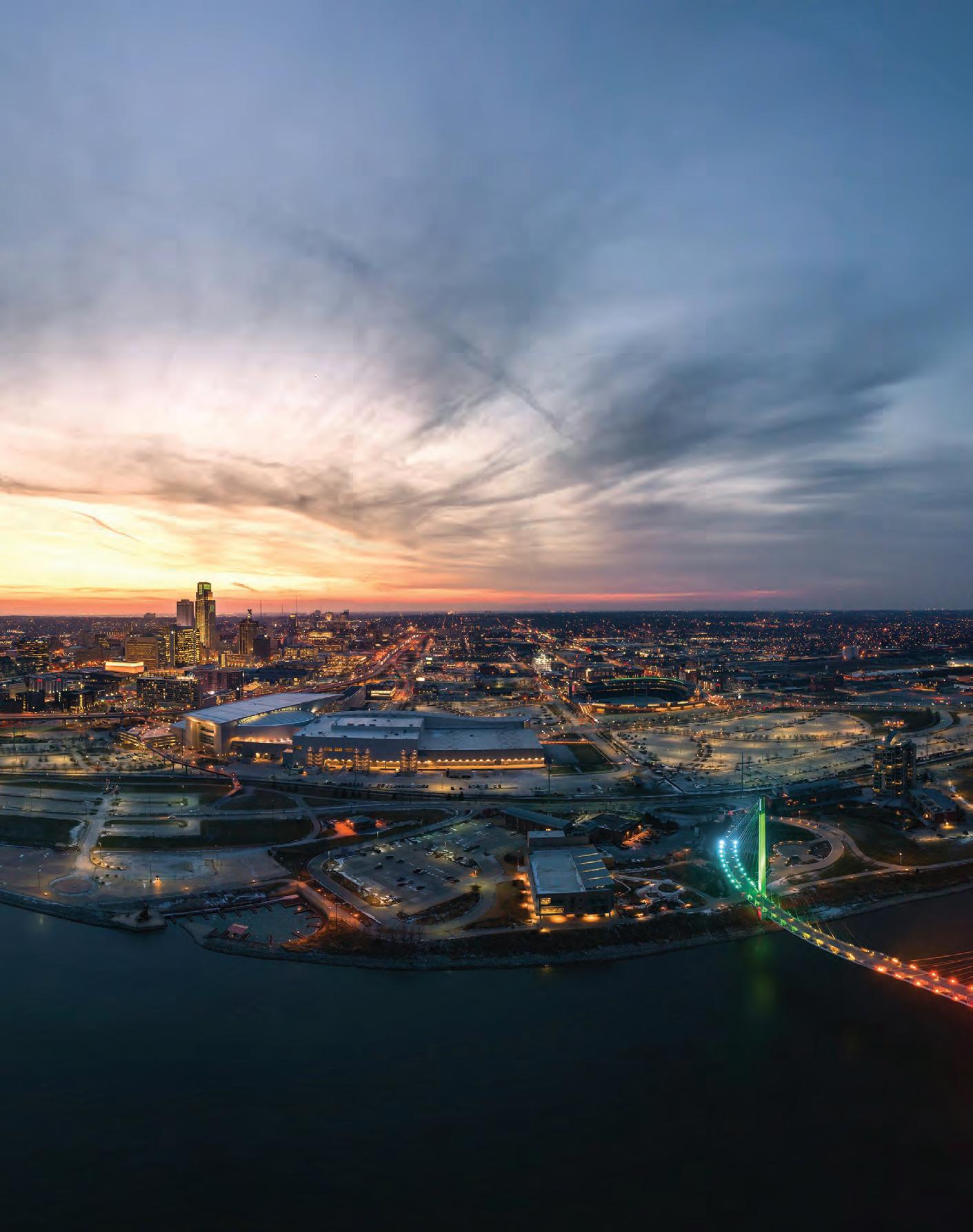
meet the magic of the performing arts
Come & Discover
Create memories with the best of Broadway, music, comedy, and other unique moments on and off the stage
Stay & Learn
Join creative learning programs and free events that spark imaginations—after all, you’re the architect of this magic
Join
Us Here
Holland Center, Orpheum Theater, Steelhouse Omaha, and Tenaska Center for Arts Engagement (opening 2026)


Jessie Davidson as Elphaba in the National Tour of Joan Marcus.

No matter what you’re buying, you aim to spend wisely—to buy the highest quality at a good price. We invest the same way.

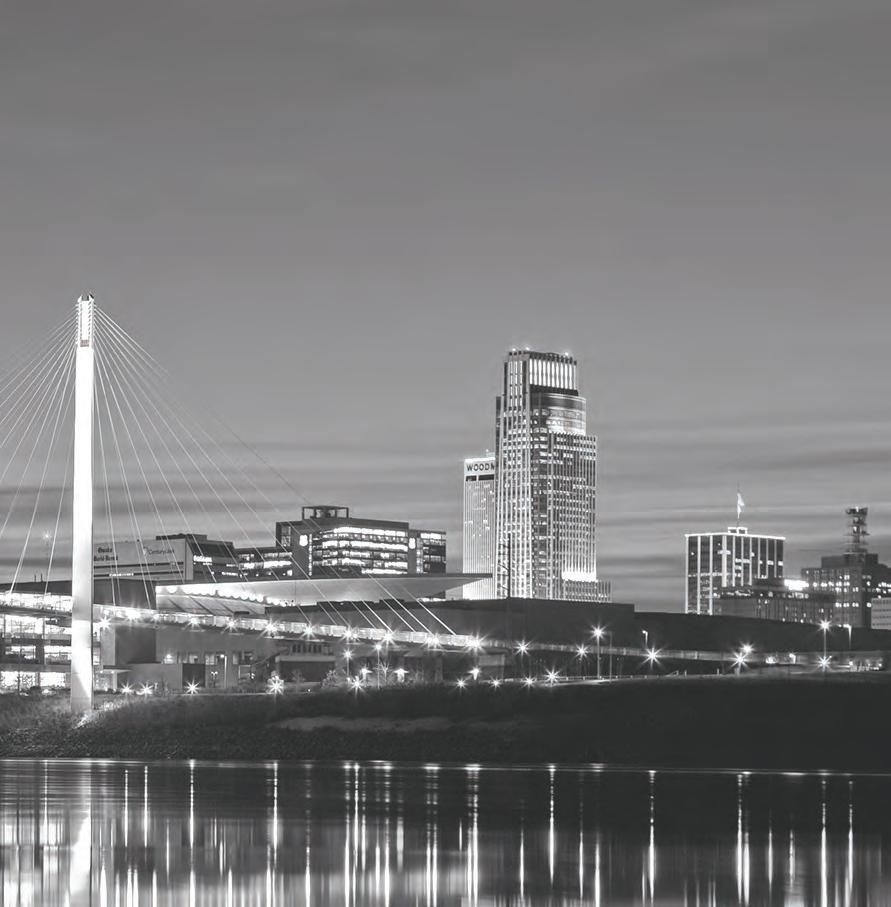

CREATING COMMUNITY
There is a place for everyone here. Whether you are a newcomer or lifelong resident, this is a vibrant metro area which feels like home. It is more than just a place; it is a collection of neighborhoods and people who care and collaborate. Omaha fosters connections that make life here extraordinary. Live, work, and play in this welcoming haven.

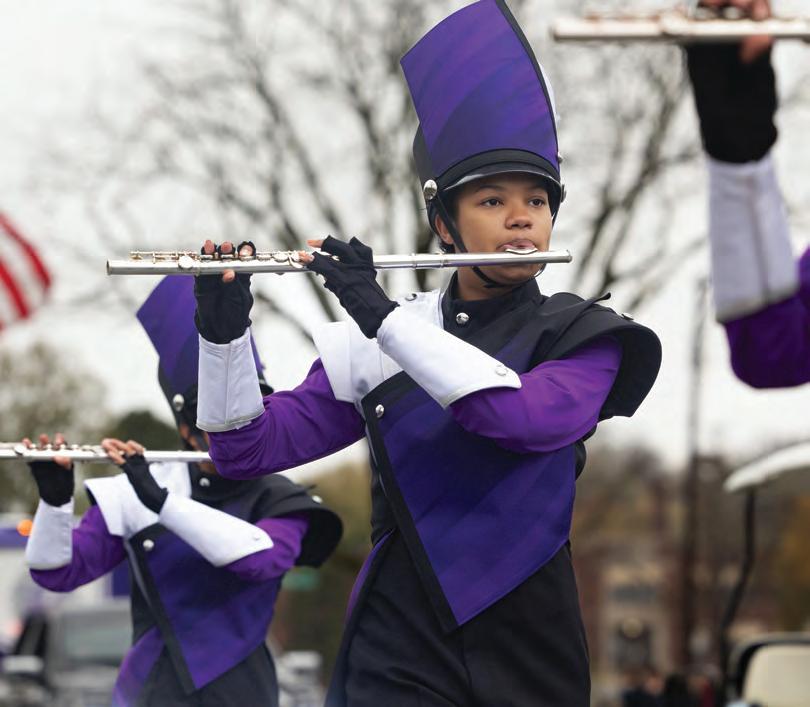
With flute in hand, a Bellevue East High School student proudly marches with the Chieftain Band during the Veterans Day Parade in Bellevue. MEGAN NIELSEN
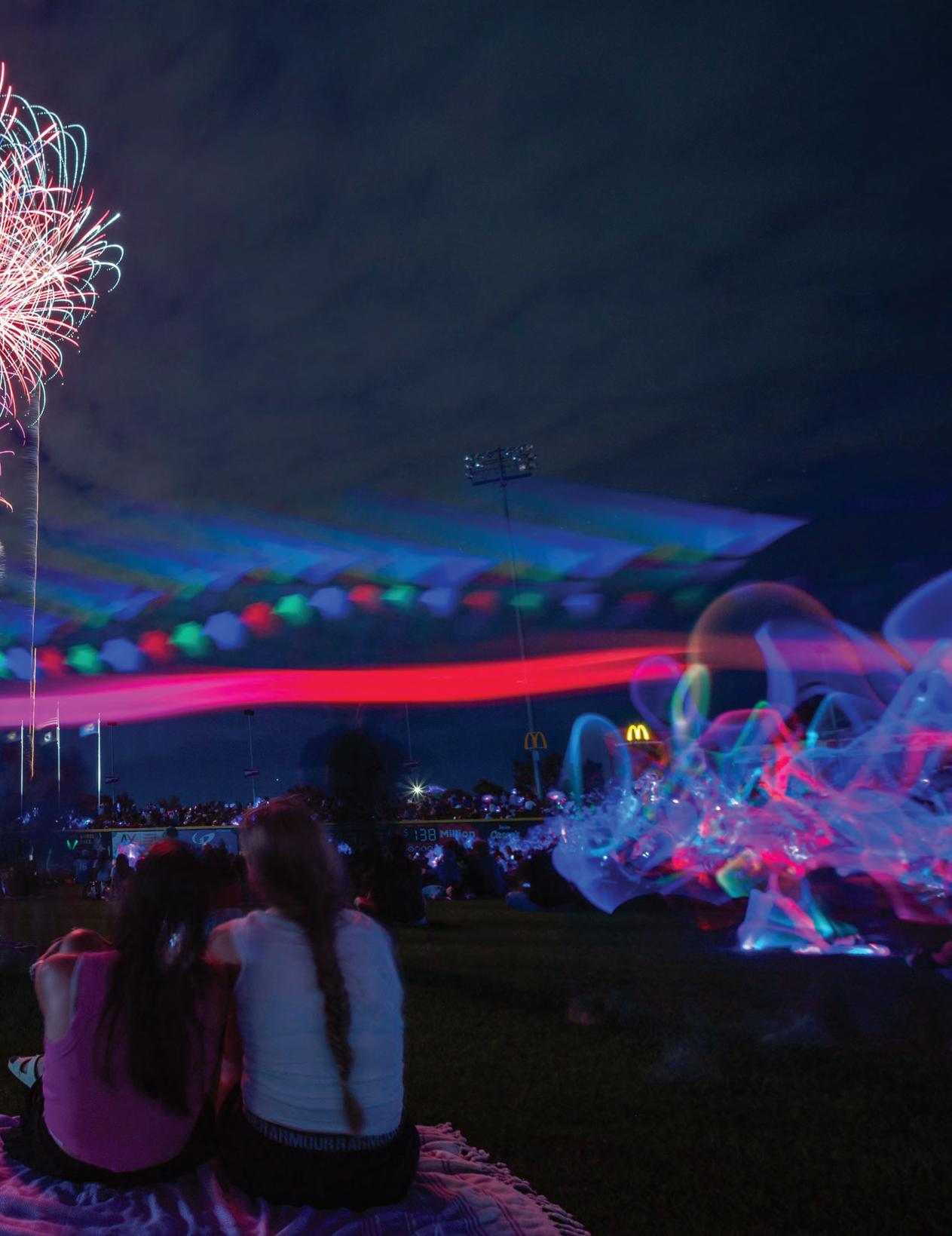
WE WELCOME.
Spectators wave glowsticks and watch fireworks following the Omaha Storm Chasers game at Werner Park in Papillion. CHRIS MACHIAN


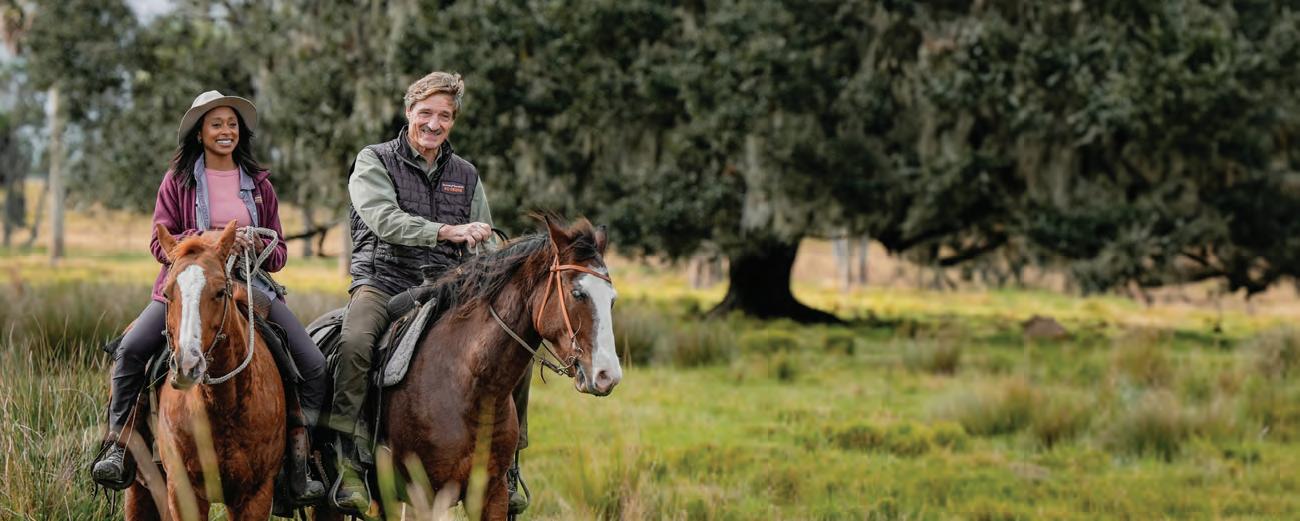




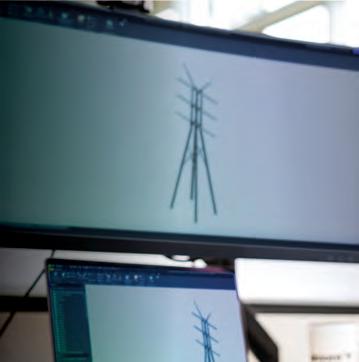




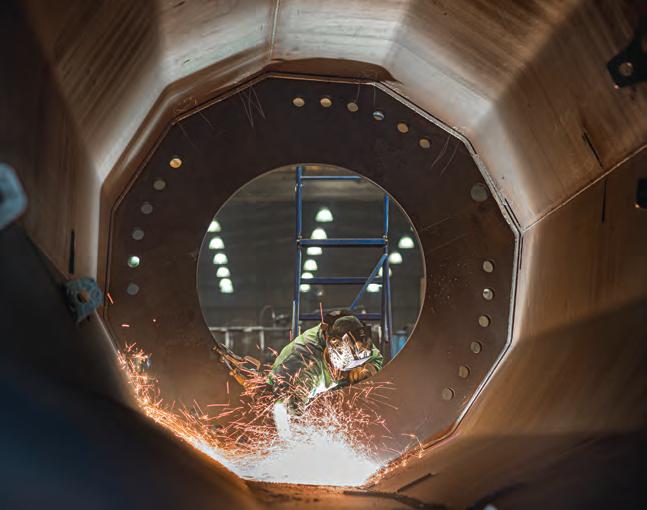
















MESSAGE FROM HEATH MELLO
Welcome to Omaha—an exceptional city filled with energy, innovation, and an unwavering sense of community. As President & CEO of the Greater Omaha Chamber, I have the privilege of witnessing firsthand the remarkable spirit that makes our city one of the best places in the nation to live, work, and thrive.
Omaha is a place of boundless opportunity, where we turn our ambitious vision into reality. Our city has long been recognized for its strong economy, outstanding quality of life, and a culture of collaboration that drives progress. What truly sets Omaha apart are the people who work every day to build something greater.
We are a city that values hard work and big ideas. Omaha is home to Fortune 500 companies, world-renowned startups, and a flourishing small business ecosystem that fuels economic growth. With a diverse and dynamic workforce, we seek to attract top talent from across the country, while also nurturing homegrown professionals through robust educational institutions and workforce development programs. From cutting-edge tech firms to legacy industries that have stood the test of time, Omaha continues to redefine what it means to be a leader in the business world.
Beyond the boardrooms and factory floors, Omaha is a place where community matters. We are a city that takes pride in its neighborhoods, invests in its future, and looks to one another for our needs. Our world-class arts and culture scene, top-tier healthcare system, and abundance of parks and recreational opportunities make Omaha a place where people build their futures.
As you turn the pages of this book, I invite you to discover the essence of Omaha. You’ll read about the businesses that are shaping our economy, the visionaries who are driving change, and the moments that define our city’s past, present, and future. You’ll see why people from all walks of life choose Omaha—not just as a stop along the way, but as a place to put down roots and make a lasting impact.
The momentum in our city is undeniable, and the future has never been brighter. We are building a Greater Omaha together, and whether you are a long-time resident, a new arrival, or a visitor considering making this city your home, you have a role to play in this journey.
Omaha is a city of possibility. And I, for one, can’t wait to see what we accomplish next.
Sincerely,
Heath Mello President & CEO of the Greater Omaha Chamber


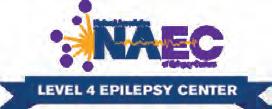
Quicker Access to Cutting Edge Epilepsy Care is at Boys Town
Boys Town National Research Hospital is a regional leader in the treatment and care of children and adolescents with epilepsy. The Boys Town Pediatric Epilepsy Program is an accredited level 4 epilepsy center, allowing us to serve as a regional treatment facility for patients affected by complex epilepsies.
The program is led by a team of pediatric epileptologists, specialized neurologists and board-certified pediatric neurosurgeons who are supported by a host of advanced diagnostic and treatment methods including:
Two next-generation MEG (magnetoencephalography) systems to pinpoint the area of the brain (down to the millimeter) causing seizures
The Boys Town Epilepsy Monitoring Unit – one of the most technically advanced pediatric-focused inpatient imaging units in the region
Genetic neurologists to diagnose genetic epilepsy syndromes
The latest surgical and neurostimulation options available when medications can't control epileptic seizures
Behavioral health experts and dietitians for individualized treatment plans
Boys Town Pediatric Neuroscience accepts both physician and self referrals. To schedule an appointment, call 531-355-7420.
Learn more at boystownhospital.org.


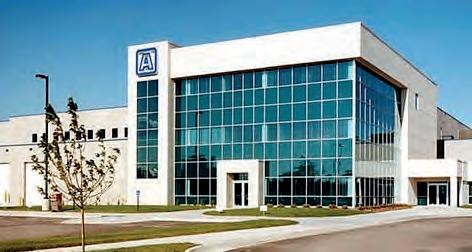

“A Greater Omaha,” 2026 edition, is a Greater Omaha Chamber publication created and produced in partnership with the Omaha World-Herald to showcase the communities and region that make Omaha — A Greater Omaha.

President & CEO, Heath Mello
808 Conagra Drive, Suite 400
Omaha, NE 68102
402-346-5000
info@OmahaChamber.org
OmahaChamber.org
SelectGreaterOmaha.com
GREATER OMAHA CHAMBER PROJECT TEAM
Project Manager: Jessica Perreault
Art Director: Mike Pechacek
Content Editors: Aron Wehr
Contributor: Madison Kielty
OMAHA WORLD-HERALD PROJECT TEAM
Project Lead: Andy Gassman
Copy Editor: Pam Thomas
Writers: Steve Jordon, Kevin Warneke & Mike Watkins
Designers: Sam Kirkwood
Photographers: Danielle Beebe, Katy Cowell, Ted Graham, Nikos Frazier, Z Long, Chris Machian, Eileen T. Meslar, Matthew Mueller, Megan Nielsen, Liz Rymarev, Kent Sievers, Lily Smith, Brendan Sullivan, & Anna Reed
OMAHA WORLD-HERALD SALES TEAM
President & Publisher: Chase Rankin
Vice President Advertising: Andy Gassman
Advertising Staff: Mike Baldwin, Brandon Bell, Rick Carr, Tierney Clifford, Dayatara Craddock, Shannon Garner, Jennifer Johnson, Erin Kohl, Murray Miller, Sam Kirkwood, & Austin Smith. ON THE COVER
Aerial of Downtown Omaha, Adobe Stock Images
View digital publication at Go.omaha.com/AGreaterOmaha
Copyright 2026
Omaha World-Herald, 2301 N. 117th Ave, Suite 201 Omaha, NE 68164 | 402-444-1000 | Omaha.com
Every effort has been made to ensure the accuracy of the information in this publication. Greater Omaha Chamber and the Omaha World-Herald assume no responsibility for misinformation. No part of this publication may be reproduced without joint permission of Greater Omaha Chamber and The World-Herald.
Printed by Aradius Group
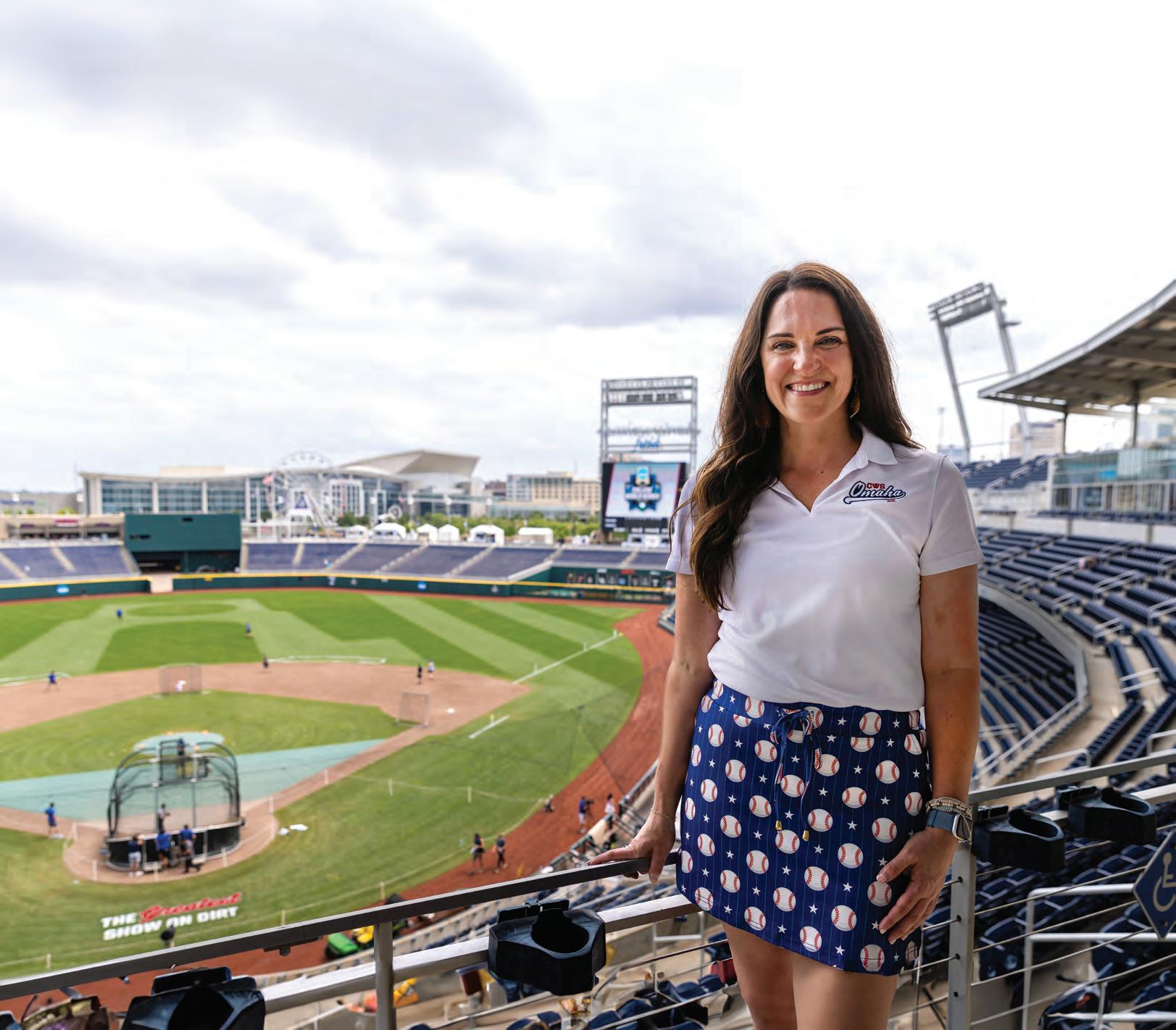
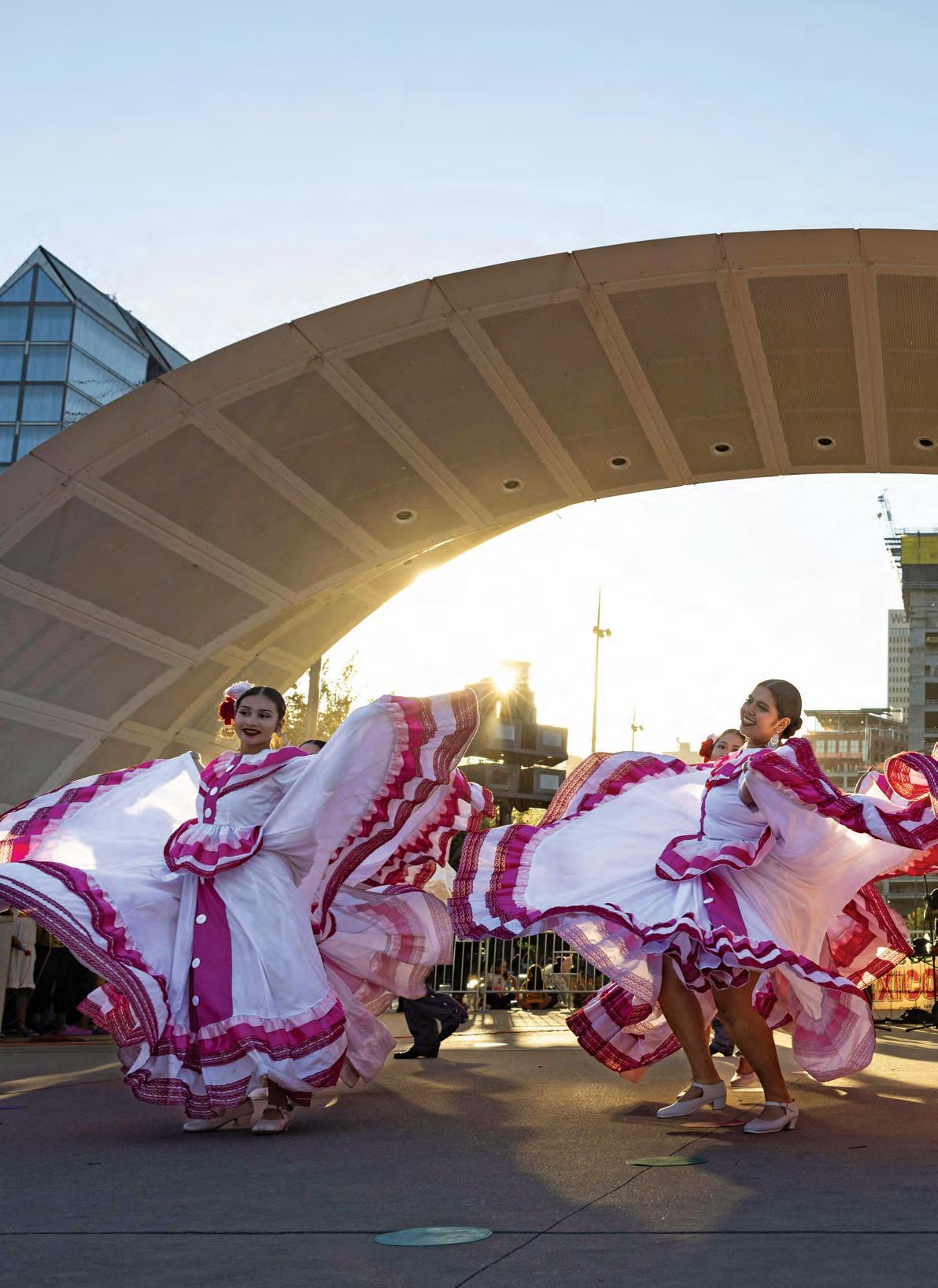
GREAT PEOPLE CREATE GREAT COMMUNITY
One million people can’t be wrong.
Where we choose to call home stands as a testimony to what we deem important: libraries, parks, and neighborhoods. The list goes on – schools, transportation, and entertainment. Affordable housing, medical care, and safety.
But mostly it’s the people who take a good community and make it great. And it’s the people who best tell its story.
Rankings
Neighborhoods
Parks & Recreation
Education
Medical
Military

Andyn Gay holds up a peace sign during the 12th annual Head for the Cure 5k race at Zorinsky Lake Park. MATTHEW MUELLER
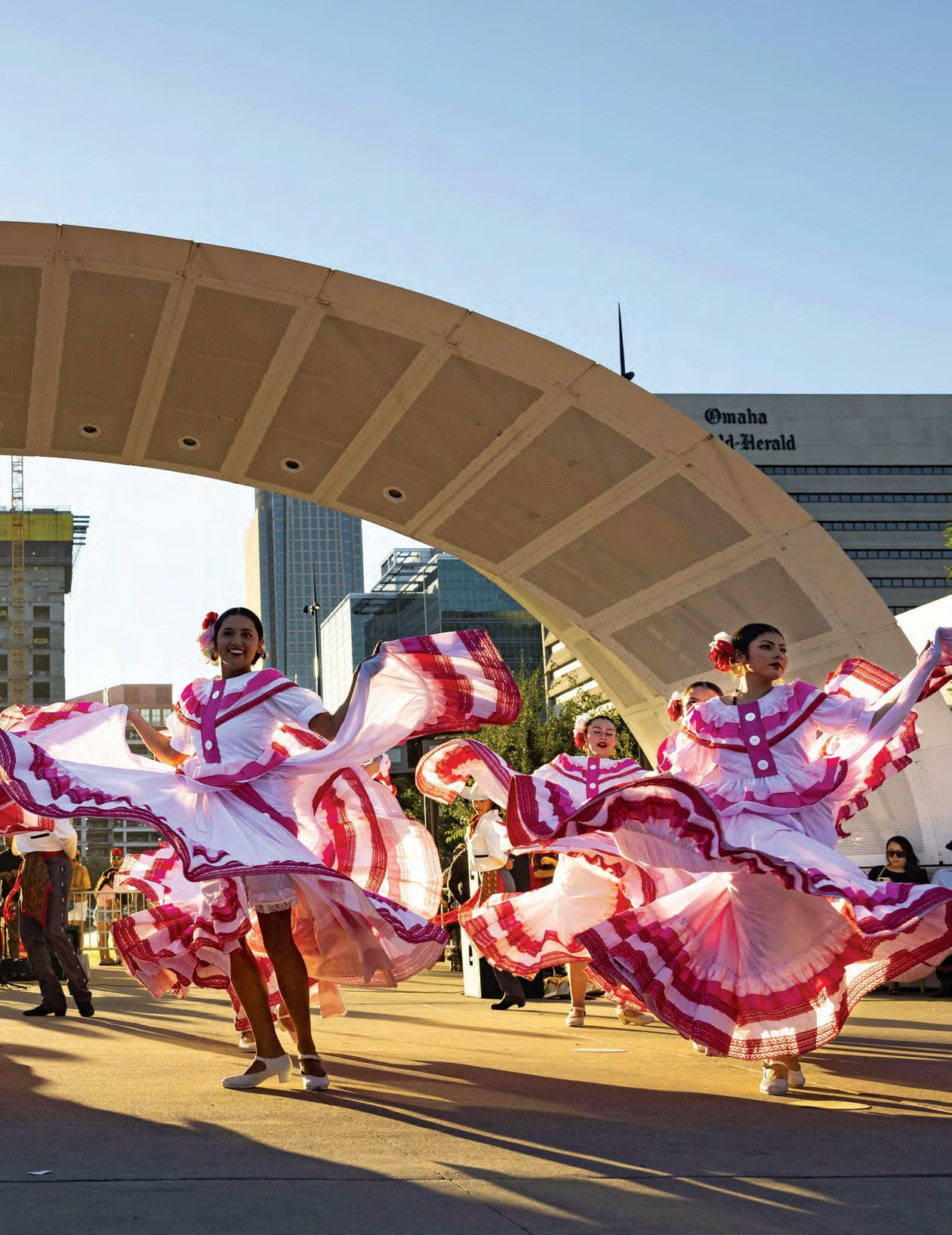
WE LIVE.
Dancers perform a folkloric dance at a cultural dance event hosted by Raíces de México at Gene Leahy Mall. MEGAN NIELSEN

This Is Where They Want to Be
When they decided to relocate their family, Nick and Brooke Krantz had endless options.
The two work remotely, Nick Krantz said, so living where their employers are based wasn’t required. “Location and accessibility was my pitch to Brooke,” Nick Krantz said. “Omaha is centrally located.”
For the Krantzes, centrally located had a special meaning – they knew Omaha is situated near our country’s geographic center, making them equidistant to either of the countries’ coasts. The couple had lived in Denver for five years and Dallas for four, yet decided they wanted to live where they could be closer to their extended families in Colorado and Illinois. Omaha is roughly halfway between.
Krantz already knew Omaha stood out among its peers throughout the country as a great place to live – because his brother, who attended Creighton University, told him. “He loves it here. He mentioned the rankings, and they’re good to know – but we knew that wouldn’t be the deciding factor. Location would be.”
The Krantz family of five now calls the Elkhorn area home – and they couldn’t be happier with their decision. Nick Krantz is quick to explain why they are satisfied with their choice:
• “Just the way everything is laid out – it’s so simple and organized.” For the Krantzes, this means travel to their children’s activities – no matter where they are held – isn’t difficult.
• “It’s a mid-major city without a big-city price tag. It’s not costing an arm and a leg to go to the grocery store. Or the gas station.”
• “We feel safe. That’s huge when you have a family with young kids.”
• Omaha provides countless examples of entertainment, and especially its strong list of breweries. “We love going to breweries. Omaha has good ones.”
• And the kicker: “Everyone is so genuine and kind here – it’s from the heart. People care about you and your family. Our neighbors knocked on our door when we moved in and introduced themselves. They made us feel welcome.”

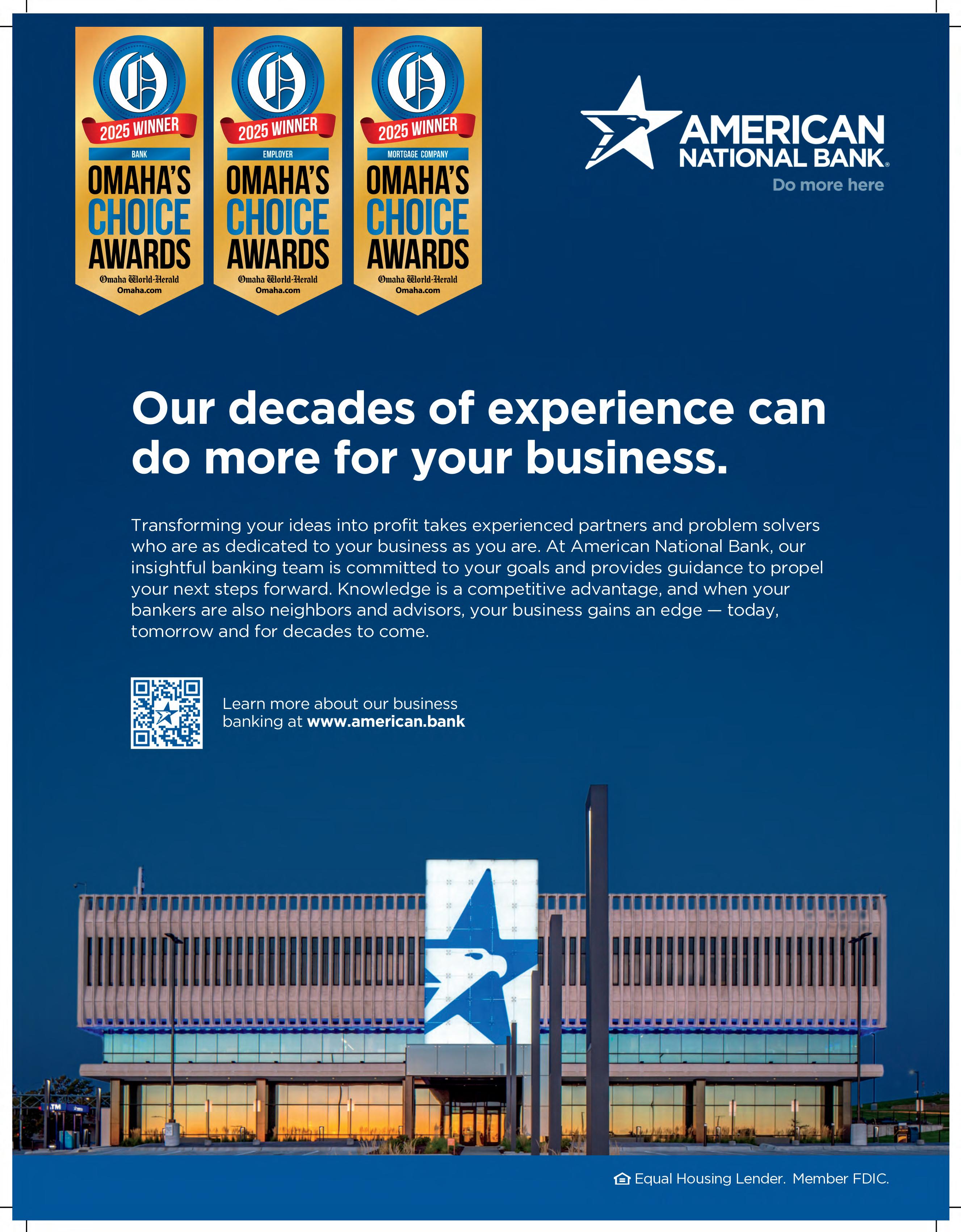

OMAHA SCORES
HIGH IN BEST PLACES TO LIVE
So Many Reasons Behind the Enviable Rankings
Bill Wagner traveled the world during his time flying for American Airlines. When his 32-year career ended, Wagner didn’t look far and didn’t need much time to decide where to spend his days in retirement.
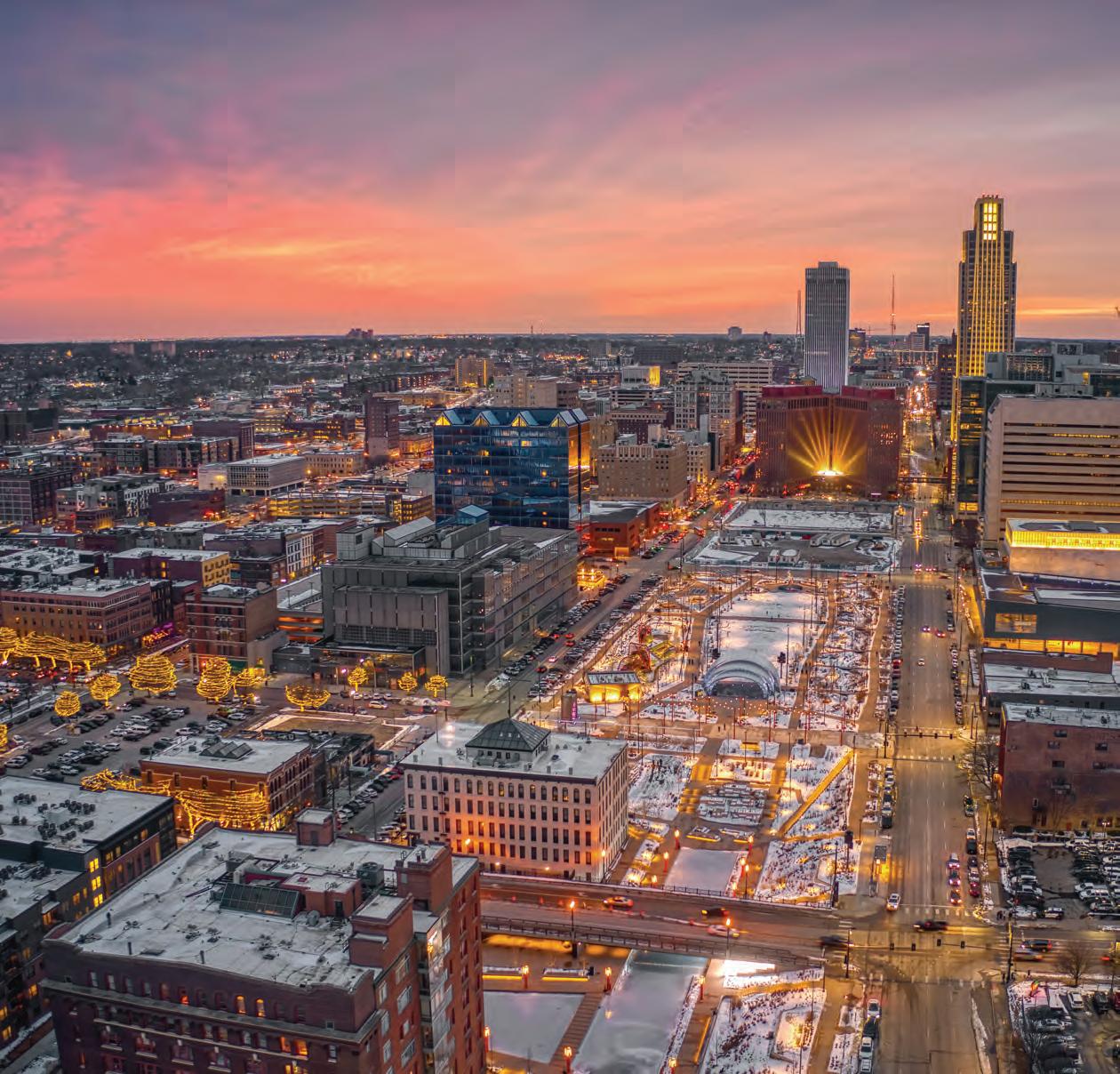
“I saw the world,” he said, “but I chose to remain in Omaha. The biggest reason? The people here are the best.”
Wagner knows that Omaha scores high in national ranking, especially on lists of best places to live. He knew that Forbes had ranked Omaha as the top city to move to in 2024. He also knew that Omaha continues to draw national attention. “Omaha is just a quality place to live and be. I’m staying put.”
Here is a sample of the latest rankings and ratings to include Omaha and the metropolitan area that’s built around it:
Omaha, according to Livability editors, ranks among the top 100 U.S. cities to call home. “The city is perfect for families looking for great schools and quality health care and for young professionals who crave a low cost of living, a strong economy, and ample job opportunities. Some 45,000 companies, including many Fortune 500s and Fortune 1000s, are based here,” the editors wrote.
Omaha ranks among the top 10 fastestgrowing U.S. metros for jobs and new talent, according to LinkedIn
News. “High-flying growth in finance and insurance are boosting the local economy, while a rise in small business activity is opening more doors for local entrepreneurs.”
Omaha ranks seventh in Workforce’s list of emerging tech markets in North America. The publication cited Intern Nebraska, a state program that provides financial assistance to local businesses that create internships, as an example for growing talent. It also cited the Nebraska Tech Collaborative for building Omaha’s tech workforce.
Omaha ranks sixth among the best U.S. cities for small businesses, according to B2B Reviews. Omaha’s population status in the state is one reason for the top ranking: “Omaha ranks sixth overall but fourth for city population, with 24.64% of the state’s population living there. Additionally, 33.26% of Nebraska small businesses are in Omaha. Entrepreneurs looking to start a business in Nebraska may find Omaha a great location.”
The list goes on. Omaha finds itself on lists applauding its recreation areas, its promotion of work-life balance for its residents, and its appeal for recent
college graduates looking for a place to live and work.
Omaha’s strength as a community on the rise hit another milestone in March: The eight-county Omaha metropolitan area topped 1 million in population for the first time.
“Big cities do big things,” said Jean Stothert, then Omaha’s mayor.
“Hitting the 1 million mark places Omaha in another echelon,” said Heath Mello, Chamber president and CEO.
Exactly, said Wagner, the retired airline pilot who proudly calls Omaha home.

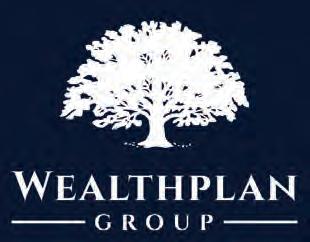








Source: U.S. News & World Report
#5
Best Markets for First-Time Homebuyers
2024 –
Source: Realtor.com
#5
America’s Best Cities for Corporate Workers
2024 –
Source: Checkr.com
#11
Best Cities for New College Grads – 2024 –
Source: Checkr.com
Source: Forbes.com
#1
Papillion: Best Place to Live In The Omaha Area – 2025 –
Source: Niche.com #3
Work-Life & Mental-Health Balance
Source: CoWorkingCafe.com
#10
Omaha: LinkedIn Cities on the Rise – 2025 –
Source: CoWorkingCafe.com
#9
Omaha: Best Cities to Move to – 2024 –
Source: Forbes.com
#9 Top Cities for Young Professionals
Source: Pheabs.com
#18
Best Places to Live in US – 2024 –
Source: U.S. News & World Report

Building a Healthier Nebraska
The cornerstone of Nebraska’s health care future is rising in midtown Omaha.
Project Health, a bold, $2.19 billion investment, is the nexus for training the next generation of health professionals, driving groundbreaking discoveries and expanding access to life-changing treatments.
Bridging the Gap: How the Learning Community Empowers Families
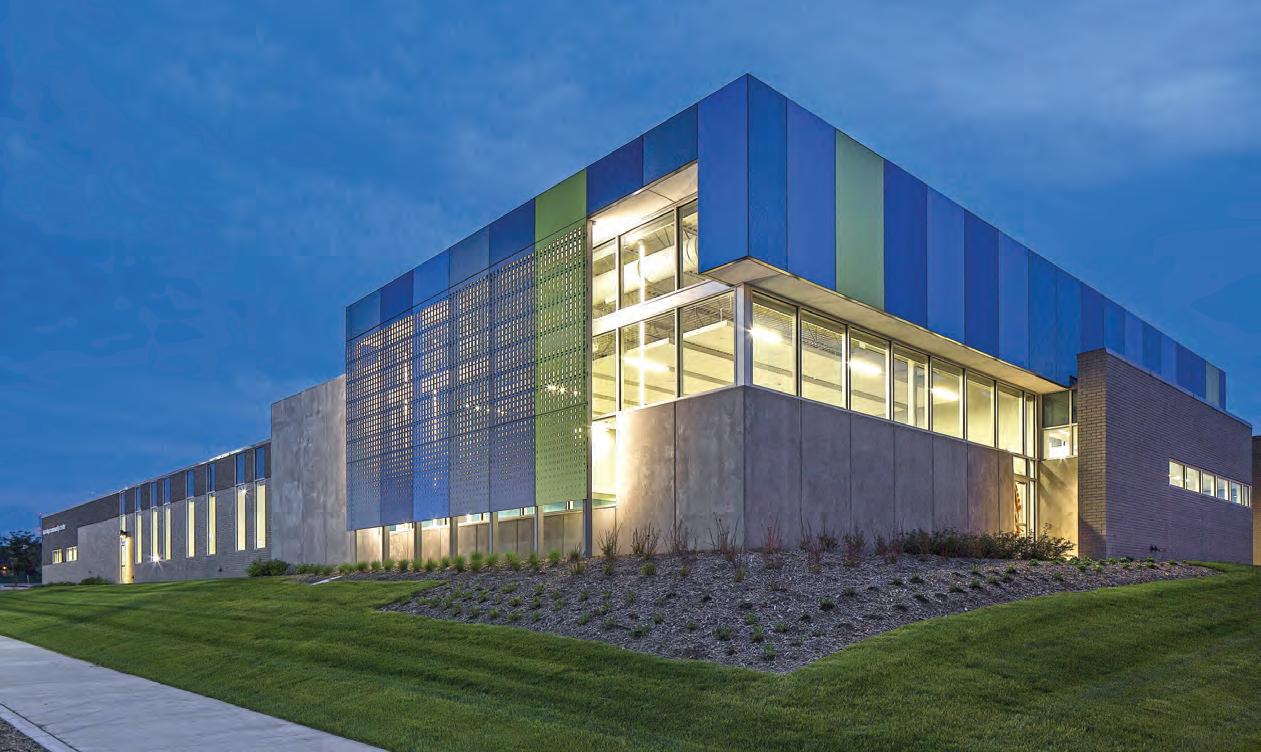
By Monica Wells - Director of Strategic Initiatives
In Douglas and Sarpy Counties, education is more than what happens in the classroom. The Learning Community of Douglas and Sarpy Counties is rewriting the story of opportunity by focusing on entire families — parents and children learning side by side — and by bringing together schools, partners, and community leaders who share the vision of closing the opportunity gap.
A Mission to Close the Opportunity Gap
The Learning Community operates with a clear purpose:
• Vision: All children within the Learning Community achieve academic success without regard to social or economic circumstance.
• Mission: Together with school districts and community organizations as partners, we demonstrate, share, and implement more effective practices to measurably improve educational outcomes for children and families in poverty.
Collaboration is at the heart of this mission. By working closely with school districts, local organizations, and trusted community leaders, the Learning Community ensures that families not only gain access to education, but also to a network of support that helps them grow, thrive, and achieve long-term success.
The 2-Generation Model in Action
Both the Learning Community Center of North Omaha and the Learning Community Center of South Omaha operate under a shared
2-Generation (2-Gen) approach — designed to support parents and children simultaneously.
At both centers, families have access to:
• Adult Education Opportunities – including English classes, GED preparation, workforce development, and parenting workshops.
• Skill-Building Workshops – on workforce readiness, child development, and school readiness.
• High-Quality Child Learning Classrooms – preparing young children for kindergar ten and beyond.
• Home Visits – guided by the Growing Great Kids curriculum, where Navigators work with families to set goals, nurture child development, and connect to community resources.

2023.
Gerald M. Kuhn, II has been serving as CEO of the Learning Community since
RIGHT: Our family learning programs at The Learning Center of South Omaha always have a waiting list. Both of these facilities serve as a hub for early childhood education, family skill-building workshops, parent outreach, and training for community childcare providers and educators.

Community partners play a critical role in delivering these services, from providing health and mental health resources to leading workforce training programs. Together, they create a wraparound system that meets families where they are and helps them achieve their goals.
Eligibility
While both centers share the same approach, eligibility reflects their unique neighborhoods:
• Parent University (North Omaha): Families must live in North Omaha, eligibility requires being pregnant or the parent/guardian of a child from birth until kindergarten entry. Participation is free and includes childcare and transportation.
• Family Learning (South Omaha): Families must live in South Omaha, eligibility requires being pregnant or the parent/guardian of a child from birth until kindergarten entry. Participation is free and includes childcare and transportation.
More Than a Program — A Community
The Learning Community’s strength lies in collaboration. By partnering with schools, nonprofits, healthcare providers, and local leaders, the Learning Community surrounds families with a network of resources designed to remove barriers and build pathways to success.
This shared effort creates lasting change: parents gain the skills to support their children’s education, children enter school ready to learn, and communities grow stronger together.
To take advantage of services or get involved, call 402-905-9984 or visit our website, LearningCommunityDS.org.

LEFT: The Learning Community Center of North Omaha was completed in September 2014.

Omaha’s Parks: WHERE NATURE & COMMUNITY FLOURISH

On a sun-filled Saturday morning, the Thompson kids, Jason and Mandy, race their bikes along the winding trail at Zorinsky Lake while their golden retriever bounds ahead. Sarah and her husband, Anthony, walk hand-in-hand, grateful for a space that feels like a retreat just minutes from home.
Every day throughout the Omaha metro, families like the Thompsons are embracing the city’s parks and trails – not just as recreational spaces, but as lifelines for connection, wellness, and community.
“Every weekend that we don’t have something else happening, we’re at Zorinsky,” Sarah said. “It’s our reset button. The kids bike the trails, my husband paddleboards with our oldest, and I walk our dog while soaking in the quiet. It’s the one place where we all unplug – and actually talk.”
The Thompsons especially love Zorinsky because it offers something for everyone:
• Biking and scootering for the kids
• Water activities like kayaking and paddle boarding
• Nature views and shaded picnic spots for family lunches
• Pet-friendly paths for their dog, Max
Parks like Zorinsky, Chalco Hills, and Standing Bear Lake are favorites among local families for their mix of trails, playgrounds, and peaceful scenery.
The Thompsons say it’s their go-to for relaxing – whether it’s a quick evening walk or a full Saturday adventure.
“In a world that often feels disconnected, Omaha’s parks offer something rare: a place where neighbors become friends, kids grow up outdoors, and families find their rhythm,” Sarah said.
The Thompsons aren’t alone. Families across Omaha enjoy the city’s expansive park and trail system. Whether it’s biking, hiking, picnicking, or strolling, these green spaces have become essential for connection, wellness, and play.
Omaha’s park system is a hidden gem in the Midwest, offering more than 250 parks spread across 11,000 acres of lush green space. The city’s commitment to accessibility and wellness shines through in its 125-plus miles of trails, 17 aquatic facilities, and playgrounds like the Discovery Playground at Lewis & Clark Landing, which features musical instruments, turf hills, and a mini zip line.
Players enjoy the new pickleball courts at Omaha’s RiverFront. MATTHEW MUELLER
Whether you’re hiking wooded paths, enjoying a summer splash pad, or attending a local event, Omaha’s parks invite you to explore, relax, and thrive.
Some Highlights of Metro Area Parks:
Benson Park & Splash Garden
• Features: No-sand playground, splash pad, fishing lake, and picnic shelters
• Location: 7002 Military Ave.
• Highlight: Busy during summer months, especially for families
Chalco Hills Recreation Area
• Features: Rocket ship play structure, car maintenance zone, rock wall, xylophones, turf and sand play zones, plus trails and picnic areas
• Location: 8901 S. 154th St.
• Highlights: Space-themed playground and nature immersion
Dream Playground at Seymour Smith Park
• Features: Colorful play structures, ramps, sensory panels, swings, and nearby skate park and trails
• Location: 6802 Harrison St.
• Highlight: Accessible playground for children of all abilities
Elmwood Park
• Features: Updated playground, wooded trails, fitness area, golf course, pool, and picnic areas
• Location: 802 S. 60th St.
• Highlight: One of Omaha’s oldest and most visited parks
Fontenelle Park
• Features: Basketball and tennis courts, football fields, golf course, and nature trails
• Location: 4407 Fontenelle Blvd.
• Highlights: Lagoon and spray ground
Gene Leahy Mall at the Riverfront
• Features: Iconic giant slides, interactive water play area, fenced playground, dog park, event lawn, and public art installations
• Location: downtown Omaha
• Highlight: draws thousands during events
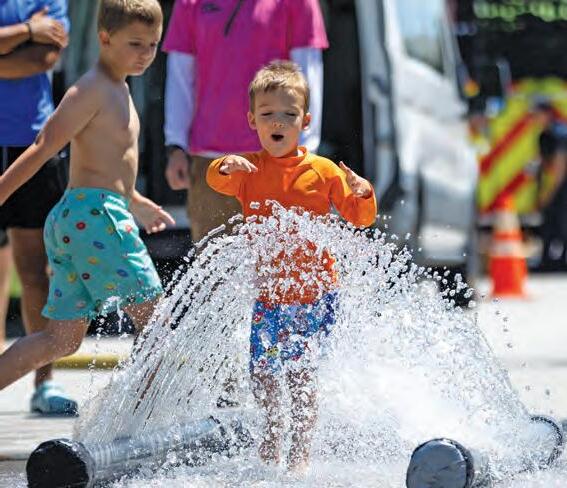

A cyclist pedals along the Field Club Trail in Omaha. The City of Omaha and UNMC have been awarded a federal grant to build a $13.5 million bike and walking path that will connect the Field Club Trail with the Beltway Trail in South Central Omaha. NIKOS FRAZIER

Hanscom Park
• Features: Updated playground, dog park, pool, lake, and mature trees
• Location: 3201 Woolworth Ave.
• Highlight: Was donated to city in 1872
Hummel Park
• Features: Hiking trails, large metal slides, nature programs, and scenic overlooks
• Location: 11808 John J. Pershing Drive
• Highlights: Popular for outdoor events and nature lovers
Heartland of America Park
• Features: Skate ribbon open year-round, lakefront swings, walking paths, and proximity to the Missouri River
• Location: Adjacent to Gene Leahy Mall
• Highlights: Popular during College World Series and summer months
Lewis & Clark Landing
• Features: Discovery Playground with zip line, musical instruments, turf hills, tunnels, and water features
• Location: 201 Riverfront Drive
• Highlight: High foot traffic during summer
Maple Village Park
• Features: Spinner bowls, monkey bars, firefighter poles, and soft sand ground
• Location: 3865 Parkview Drive
• Highlight: A neighborhood favorite
Memorial Park
• Features: A place to commemorate and honor those who served and died in conflicts; annual location for the Independence Day celebration and free concert
• Location: 6005 Underwood Ave.
• Highlight: Dedicated in 1948 by President Harry S. Truman to honor World War II veterans
OPPD Arboretum
• Features: Quiet walking paths, native plant displays, and educational signage
• Location: 10600 Blondo St.
• Highlights: A favorite for birdwatchers and nature walks
Pacific Meadows Playground
• Features: Curvy slides, climbing tower, tennis courts, and walking trails
• Location: West Papio Trail
• Highlights: Great for sledding in winter and climbing in summer
Rockbrook Park
• Features: Sand play area, swings, climbing structures, and quiet green spaces
• Location: 3525 S. 94th St.
• Highlight: Known by neighbors as “Rocket Park”
Standing Bear Lake
• Features: Playground, fishing, no-wake boating, and 3.3 miles of trails
• Location: 6404 N. 132nd St.
• Highlight: Estimated tens of thousands of visits annually
Stinson Park at Aksarben Village
• Features: Playground, event lawn, concerts, and proximity to shops and restaurants
• Location: 2285 S. 67th St.
• Highlight: Located on the for mer Aksarben racetrack grounds
Tranquility
Park
• Features: 9-mile single-track loop for mountain biking, sports fields, and nature trails
• Location: 12222 West Maple Road
• Highlights: Popular among trail runners and cyclists
Turner Park
• Features: Open green space, seasonal events, and shaded seating
• Location: 3110 Farnam St., Midtown Crossing
• Highlight: Popular for community gatherings
Walnut Grove Park
• Features: Picnic pavilions, spring rider ponies, lagoon, and shaded benches
• Location: 15050 Q St.
• Highlight: Quiet urban retreat
Zorinsky Lake Park
• Features: Extensive trails, new fully inclusive playground in 2025, accessible fishing dock, and sports fields
• Location: 3808 S. 156th St.
• Highlights: One of Omaha’s busiest parks for runners and cyclists
Some Features of Omaha Parks Trails
There are over 125 miles of paved trails throughout the City of Omaha, with a number of those trails connecting to trails outside of the city. A map of the metro area trails titled “Paths of Discovery” is available online and in hard copy form at community centers, libraries, bike shops, and other establishments. All trails are concrete unless otherwise noted.
Indoor and Outdoor Pools
Omaha has 14 outdoor pools and three indoor pools. Dive into the city’s comprehensive table showcasing affordable pricing, making a splash in the city’s vibrant aquatic scene accessible to all. Pool passes and punch cards are a great option for frequent pool users.
Spray Grounds
Omaha’s 14 water spray grounds serve as a fun and interactive gathering place during the hot summer months. A variety of spray features appeal to toddlers and older children, with parents often joining in the fun. Spray grounds are free, and water-play activities extend beyond the normal pool season.
Learn more about locations, hours, and further amenities at Omaha’s parks at parks.cityofomaha.org.

CENTRAL LIBRARY TO OPEN NEW CHAPTER IN 2026
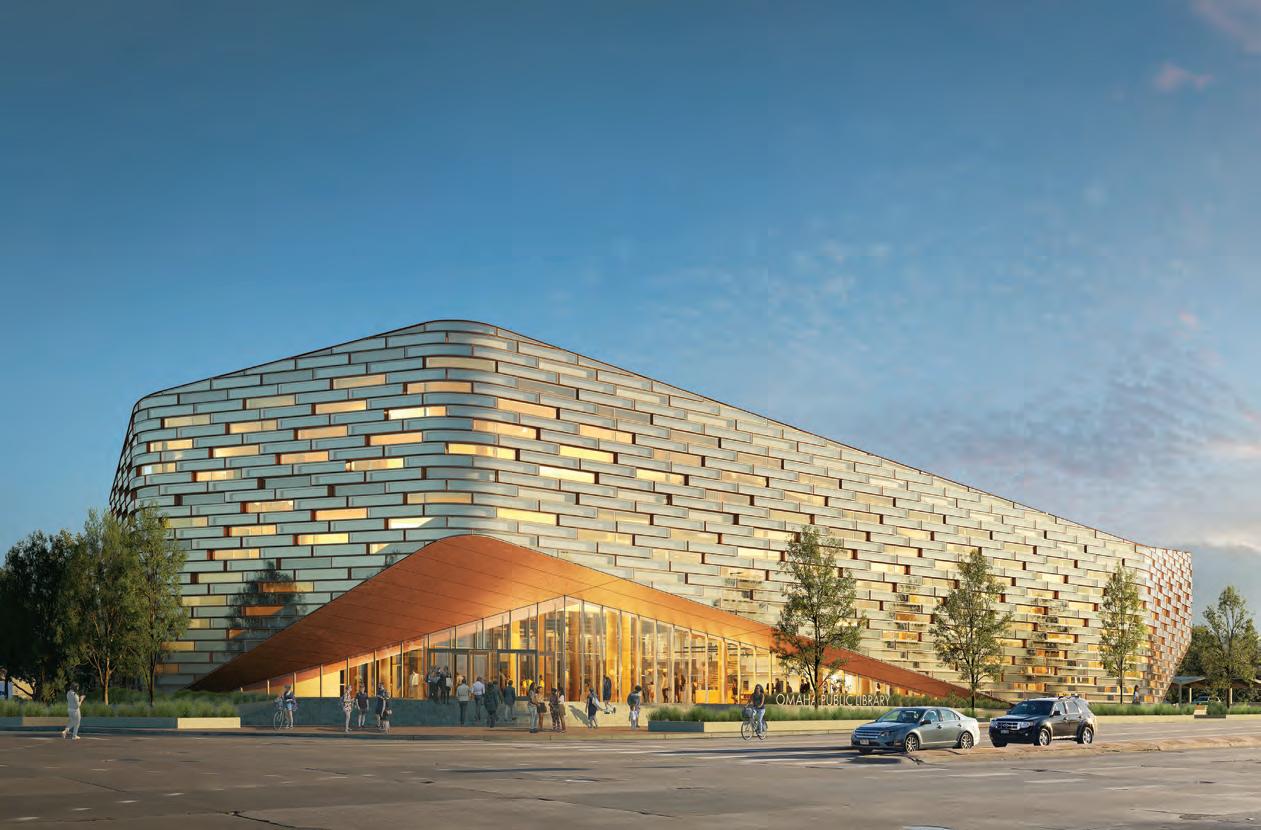
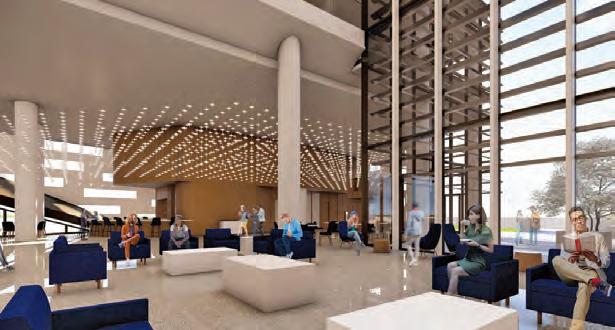
Omaha’s decision to build the new Central Library in the Crossroads section of town – 72nd and Dodge Streets – is deeply symbolic and strategically significant.
Historically, this intersection is one of Omaha’s most iconic, once home to the city’s first major shopping mall. It was a bustling hub that drew people from all over the metro area.
The library aims to be a hub of learning, creativity, and civic life. It’s a place where paths meet, ideas spark, and futures are shaped.
“The whole area is being revitalized, and we’re excited to be a focal point of that,” said Omaha Library Executive Director Laura Marlane.
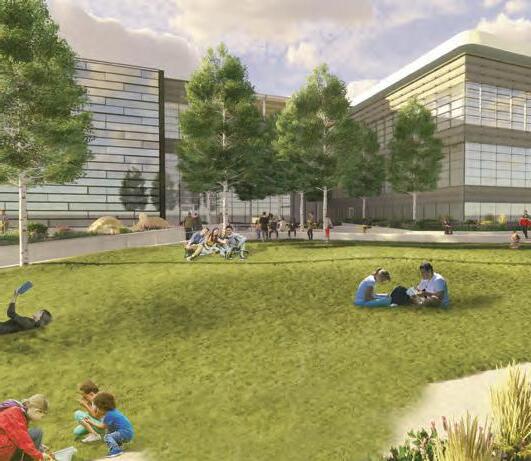
The site of the former Crossroads Mall is undergoing a major transformation north of the library.
“This has always been a vibrant driving corridor. We are setting the tone for innovation in this space,” Marlane said.
It’s not just a building – it’s a statement about investing in the heart of the city. The location is central, well-connected by public transit, and designed to serve people from all walks of life.
Opening in spring 2026 at 96,000 square feet, it’s one of the largest public library investments in the United States in recent years. It will feature an Automated Storage and Retrieval
Architectural renderings courtesy of HDR.
Architectural rendering courtesy of Alley Poyner Macchietto Architecture.
System – a first for a U.S. public library – allowing it to store up to 650,000 items in a climate-controlled vault.
The library will feature podcasting and video production studios and will provide access to professionalgrade equipment for creating audio and video content – ideal for aspiring creators, educators, and entrepreneurs.
Alibraryisafocalpoint,asacredplace toacommunity;anditssacrednessis itsaccessibility,itspublicness. It’severybody’splace.
– Ursula K. Le Guin, author
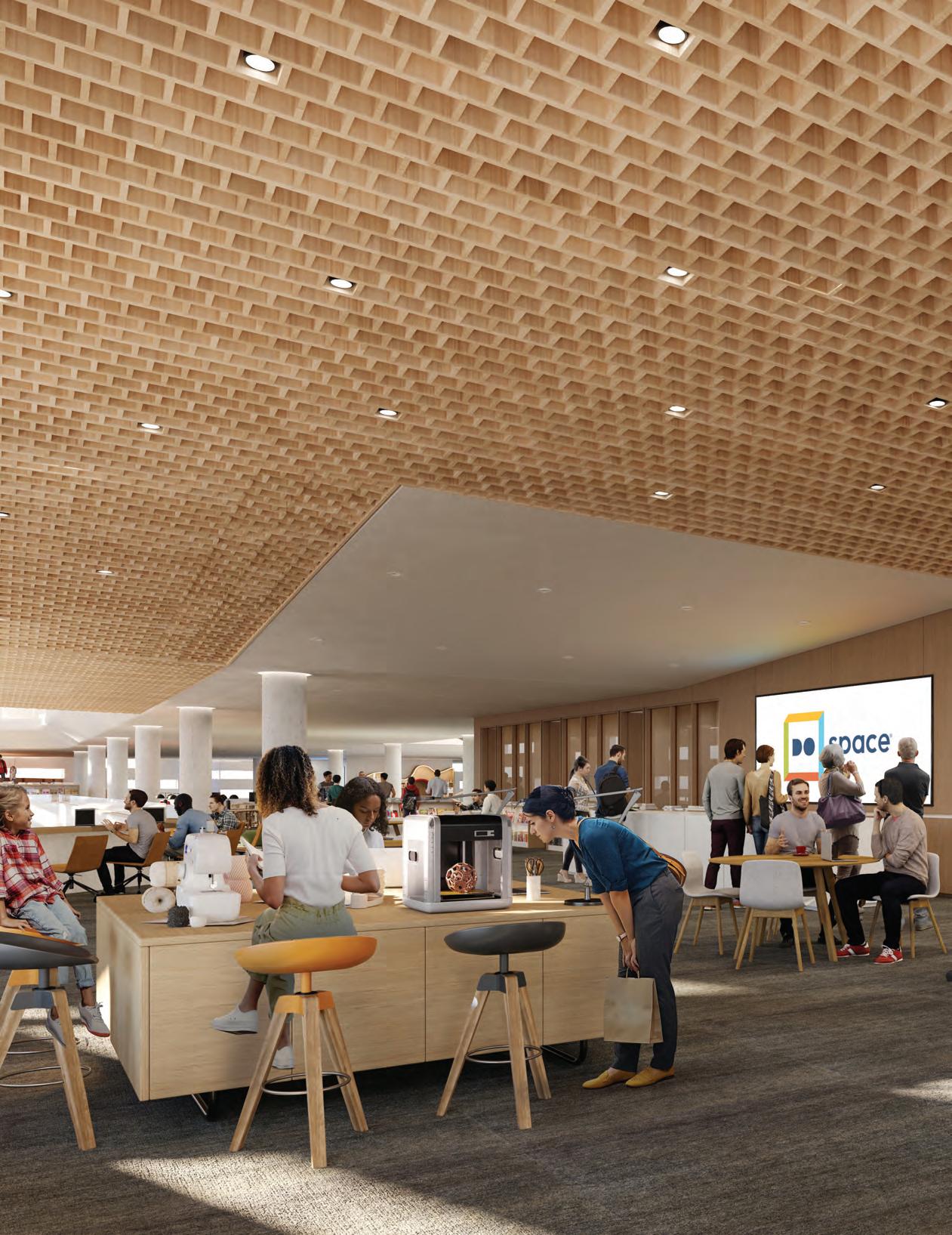
Beyond books, it will offer creative technology, collaborative workspaces, cultural events, and art displays. A beautiful outdoor garden will provide an oasis for learning and living among nature.
Architecturally, the building is a modern marvel. Its sleek exterior is designed to provide a subtle visual reference to the lifted edge of a book’s pages. Inside, sculpted soffits, specialty ceilings, and wood finishes will create an inviting atmosphere.
One of the most anticipated features is the Commons – a bright, flexible gathering space designed for collaboration, events, and casual interaction.
“The library’s mission is to serve as a dynamic hub where ideas and community connect,” Marlane said. “It will expand access to local history and genealogy collections, offer meeting rooms for groups of all sizes, and provide resources for workforce development.
“We will promote digital equity across age and income, support lifelong learning and career advancement and achievement, and create space for creative expression and innovation. These have always been the hallmarks of libraries, and this new space continues to fulfill that mission.”
Architectural rendering courtesy of Alley Poyner Macchietto Architecture.

Working toward an America where children and families receive the effective, compassionate care they need to be healthy in body, mind and spirit. Children like Brandi


Overcoming Challenges, Inspiring Change
When Brandi was just nine years old, her mother was diagnosed with breast cancer. Her mom grew more sick over the years and Brandi, as the oldest of three children, stepped into a mothering role. “Things got really hard,” she shared. Her father had left when she was young. Her mother passed away when she was 14 and Brandi found herself bouncing around until she arrived at Boys Town.
Boys Town became a sanctuary for Brandi, providing stability and support during her turbulent teenage years. “I really think a Boys Town kid can be anyone. We all have hardships in life,” she said.
One of the most comprehensive residential programs in the world, the village of Boys Town is a community with nearly 60 Family-Homes, tree-lined streets and a small-town feel. Youth flourish here because they are safe and are part of a community whose sole purpose is to help them heal.
Brandi’s mother made her promise to know her genetic risk and take preventive measures. So at 22, she underwent a preventative mastectomy, reducing her risk of cancer from 87% to less than 2%.
While learning about preventative mastectomies, Brandi met Denise Ibsen-Cole, a Boys Town employee who had previously undergone the same procedure. Inspired by their Boys Town connection, the two bonded instantly and Denise became a guiding light for Brandi. “I think of Father Flanagan’s miracles and Denise was mine,” Brandi said.
At 23, Brandi founded the Hereditary Cancer Foundation in memory of her mother, helping high-risk individuals get genetic testing and support.
Today, Brandi helps families like hers understand the importance and impact of genetic testing. Had it not been for her second chance at Boys Town, countless families would be without this lifesaving support.

Photos provided by Boys Town.
STRONG SCHOOLS LAUNCH STUDENTS ON PATH TO SUCCESS
Achieving excellence in education means never standing still. It means providing curriculum that challenges students to achieve what they thought might be impossible. It means constantly looking to improve and expand facilities to meet the ever-evolving academic environment.
Two examples from schools in Greater Omaha drive this approach home:
• The Millard Activity Center, funded entirely by private donations, will include basketball and volleyball cour ts, an innovation lab, an esports lounge for competitive gaming, a training gym, and an outdoor adventure course. The 85,000-square-foot center is expected to be completed by fall 2026.
• A new football stadium at Omaha North High School will be adjacent to a new YMCA building. Omaha Public Schools and city officials announced the project, named Game ON, in April. Lead funders are the Lozier Foundation and Sherwood Foundation.
School systems in Greater Omaha prepare students for what comes next: attending college, entering the workforce, or serving in the military. Strong school districts – with award-winning educators and topranked students – can be found throughout the eight-county area. They include:
Archdiocese of Omaha
Bellevue Public Schools
Bennington Public Schools
Council Bluffs Community School District
Elkhorn Public Schools
Gretna Public Schools
Millard Public Schools
Omaha Public Schools
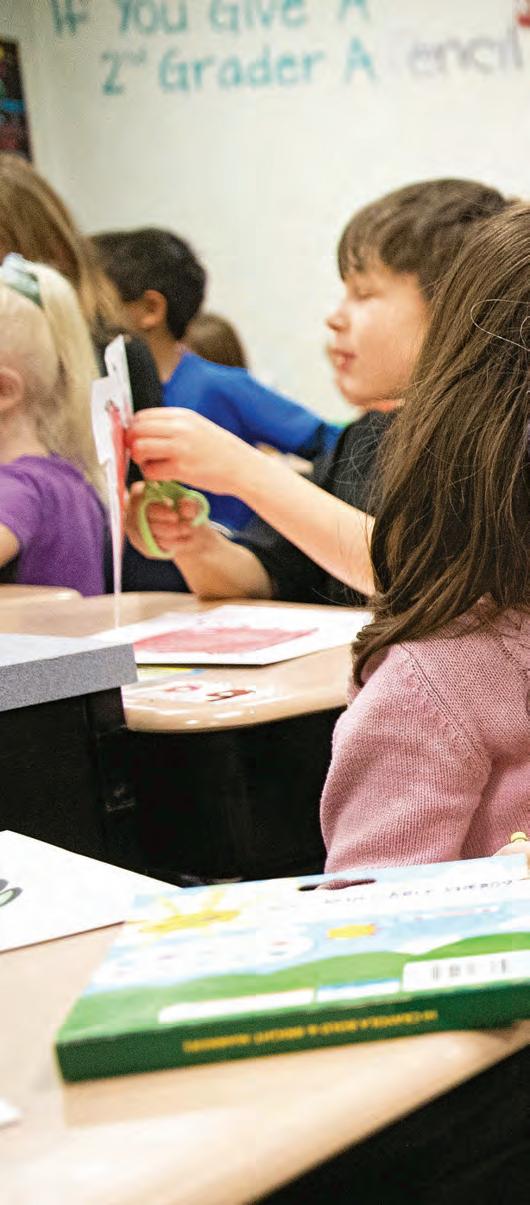
Papillion-La Vista School District
Ralston Public Schools
Westside Community Schools
Several of the districts are highlighted on the following pages.
Second-graders pet a therapy dog
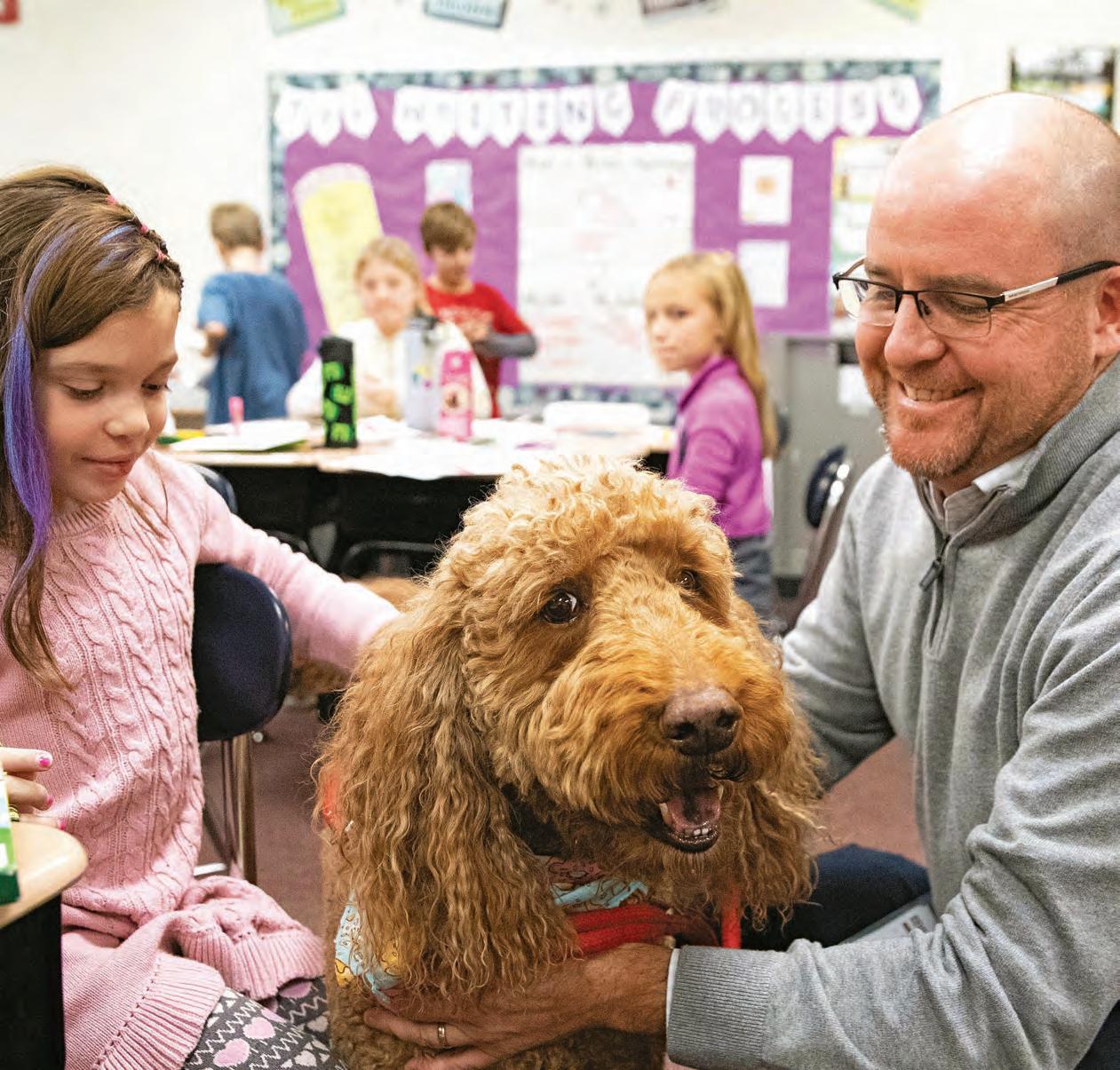
OMAHA PUBLIC SCHOOLS
Omaha Public Schools is Nebraska’s largest and most diverse school district, serving more than 52,000 students in grades K-12. Nearly 9,000 staff members support the district’s mission to prepare all students for success in college, career, and life. The district consists of 65 elementary schools, 13 middle schools, nine high schools, one K-12 virtual school, and eight alternative programs. Students have access to advanced coursework in nearly every subject area, including all core classes, music, art, and physical education.
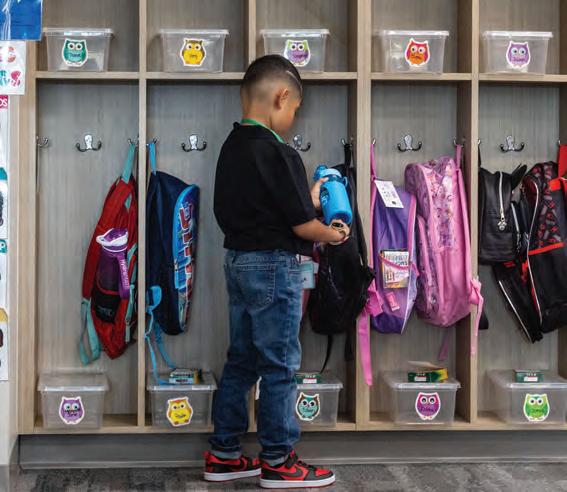
owned by Principal Skip Hanlon, at Ackerman Elementary School. EILEEN T. MESLAR
Did You Know? Did You Know?
• Omaha Public Schools offers more Advanced Placement (AP) courses than any other district in Nebraska.
• Students earned more than 20,000 college credits during the 2024-25 school year.
• Omaha Public Schools students earned more than 1,500 industry-recognized certifications.
• Elementary Student to Teacher Ratio is 13.8
• Students across all nine high schools participate in co-curricular, career and technical student organizations. Students showcase their learning at state and national levels in Educators Rising, DECA, FBLA, FFA, HOSA and SkillsUSA.





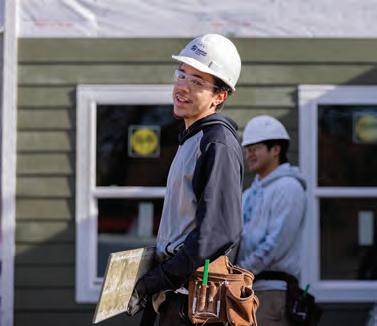
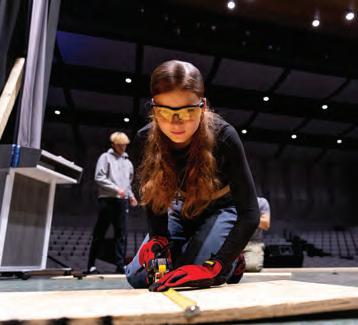
During the 2024-25 school year, the district’s high school students earned more than 1,500 industry-recognized certifications and earned more than 20,000 college credits. Students participated in more than 10,000 experiential learning opportunities, connecting with more than 250 businesses and partners.
Omaha Public Schools recently announced a united focus on literacy. The district’s “Moonshot” initiative has a goal of all students reading on grade level by 2030. The district engaged staff, students, families, and community partners on this districtwide improvement effort.
ARCHDIOCESE OF OMAHA CATHOLIC SCHOOLS
Academic achievement in the classroom is just one staple of schools that are part of the Archdiocese of Omaha. Catholic schools provide faith-filled, loving environments where learning flourishes and lives are enriched.
Nearly 19,000 students attend one of 66 Catholic schools situated in 23 counties in northeast Nebraska. Slightly more than half are found in the Greater Omaha area.
Academic success is one outcome of a Catholic education. Educators also instill respect, confidence, accountability, and the importance of service and hard work.
Catholic high school students routinely outperform their peers on standardized tests. For example, according to the most
MILLARD PUBLIC SCHOOLS
Our families have told us that they chose Millard for the opportunities and level of excellence our schools can give their children. This is our entire focus.
– Dr. John Schwartz, Superintendent Millard Public Schools
Millard is a district of choice, helping more than 23,000 students and their families find the right college and career path for their students. Classified as excellent by the Nebraska Department of Education, Millard offers dozens of academic, athletic, and activity options.
Ninety-six percent of parents rate the district as excellent or good. Millard students score higher on the national ACT exam than both state and national averages, and high school graduation and college-going rates are above the state average. Millard students have won more than 135 NSAA State Championships.
The district supports 28 Advanced Placement classes; eight programs of choice, including STEM Schools; kindergarten through 12th grade International Baccalaureate programs; elementary and middle school Montessori programs; and elementary Core Knowledge programs.
Millard’s five career academies are Health Sciences, Business & Entrepreneurship, Business & Logistics Management, Education, and STEM. Students learn in a one-to-one technology environment, with iPads for elementary students and laptops for secondary students.
Catholic schools in the Archdiocese of Omaha strive for academic excellence in a faith-based environment, grounded in Catholic traditions.
– Vickie Kauffold, Superintendent of Schools Archdiocese of Omaha
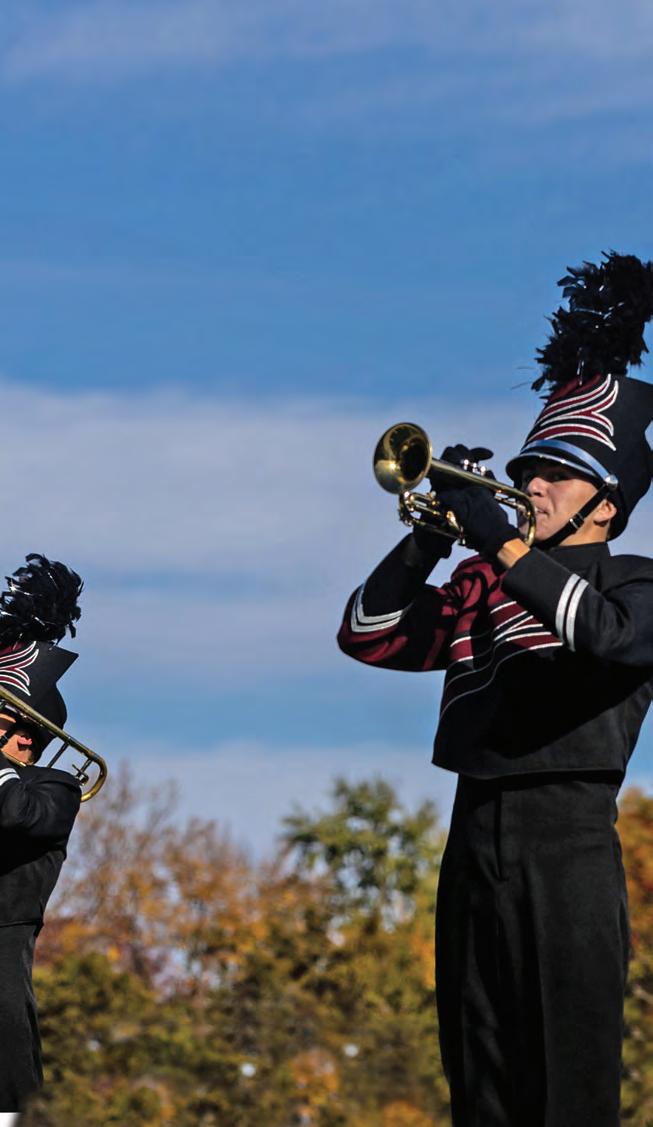
recent results, the average ACT score for seniors attending Catholic high schools in Nebraska was 4.4 points higher than the state average. Students, on average, also met college readiness benchmarks at a rate twice that of the Nebraska average.

WESTSIDE COMMUNITY SCHOOLS
Westside Community Schools is proud of the close-knit community found throughout its 10 elementary schools, one middle school, and one high school. Westside Community Schools has been around since 1947, but its three founding school districts have roots dating to the 1800s.
Community, innovation, and excellence have always been at the core of the district. Westside is proud to foster a community of learners inside its classrooms that mirrors the demographics of the city of Omaha. As Superintendent Mike Lucas often says: “Walking down the halls of Westside Middle School is a lot like walking down the halls of Westroads Mall.”
The Westside district has always been an innovator, finding new and exciting ways to engage students. In fact, Westside was the first district in Nebraska to have a special education program,
Excellence is what we strive for – knowing that excellence might look different from student to student. Our teachers and staff strive for excellence in their work and expect excellence in their students. We believe that those high expectations lead to amazing results.
– Dr. Mike Lucas, Superintendent Westside Community Schools
well before it was mandated. The district believes the best teachers can find ways to challenge learners at all levels.
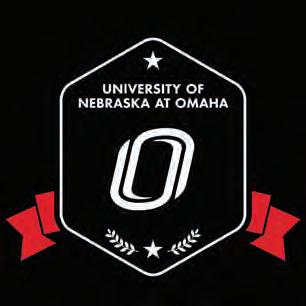



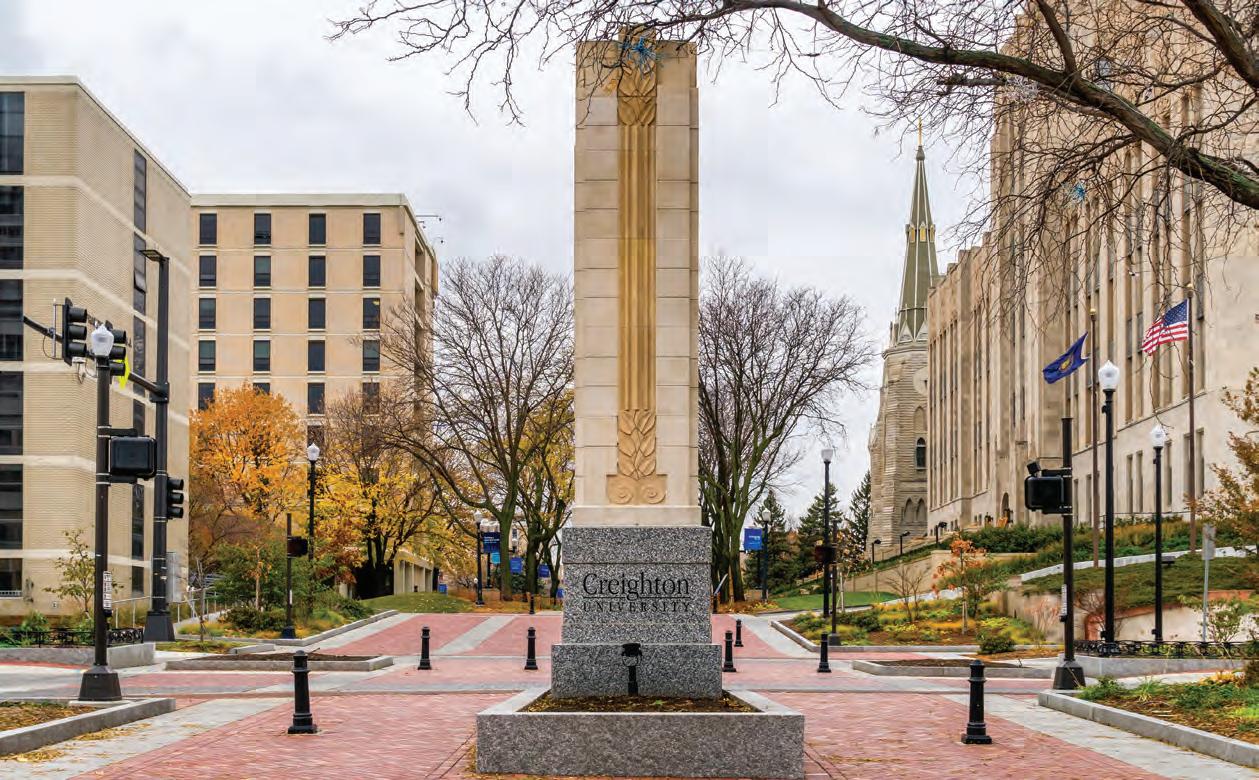
BELLEVUE UNIVERSITY
From the day we opened our doors in 1966, Bellevue University has been laser-focused on one thing – preparing people for the work the world needs done. We’ve built programs that move with the economy, not behind it, so our graduates bring immediately valuable skills to the job on day one. Whether it’s cyber defense, health care leadership, business strategy, or data science, we teach what matters now and what will matter next.
– Mary Hawkins, Ph.D., President Bellevue University
Founded in 1966, Bellevue University is a nonprofit, openaccess, and accredited leader in preparing students for workforce success. Serving nearly 19,000 students worldwide, the university offers more than 100 career-focused programs in business, technology, health care, education, and more. With an average student age of 34, Bellevue University understands the needs of working adults.
The university partners with hundreds of employers, community colleges, and military organizations to extend its reach, ensuring that learning is relevant and applied. More than 72,000 graduates contribute to industries across the globe, strengthening the local economy and the communities they serve.
COLLEGE OF SAINT MARY
College of Saint Mary, a private, Catholic university founded by the Sisters of Mercy, equips women to lead with intention, compassion, and impact. As one of the Midwest’s only allwomen’s colleges, College of Saint Mary prepares students for purpose-driven careers through leadership opportunities, service-learning, and academic rigor.
College of Saint Mary was founded on the belief that there is no greater good to society than the careful education of young women. Today, we continue our work to empower women through education and foster a culture of leadership and community service. Our students graduate from CSM prepared for successful careers, equipped to be bold and ready to drive change, contributing to the ongoing growth of Omaha.
– Heather Smith, President College of Saint Mary
CSM offers undergraduate degrees in disciplines such as biology, chemistry, education, kinesiology and exercise science, and nursing. Graduate programs include education, physical therapy, teaching, physician assistant studies, and organizational leadership. Students are part of a mission to make a difference in the world.
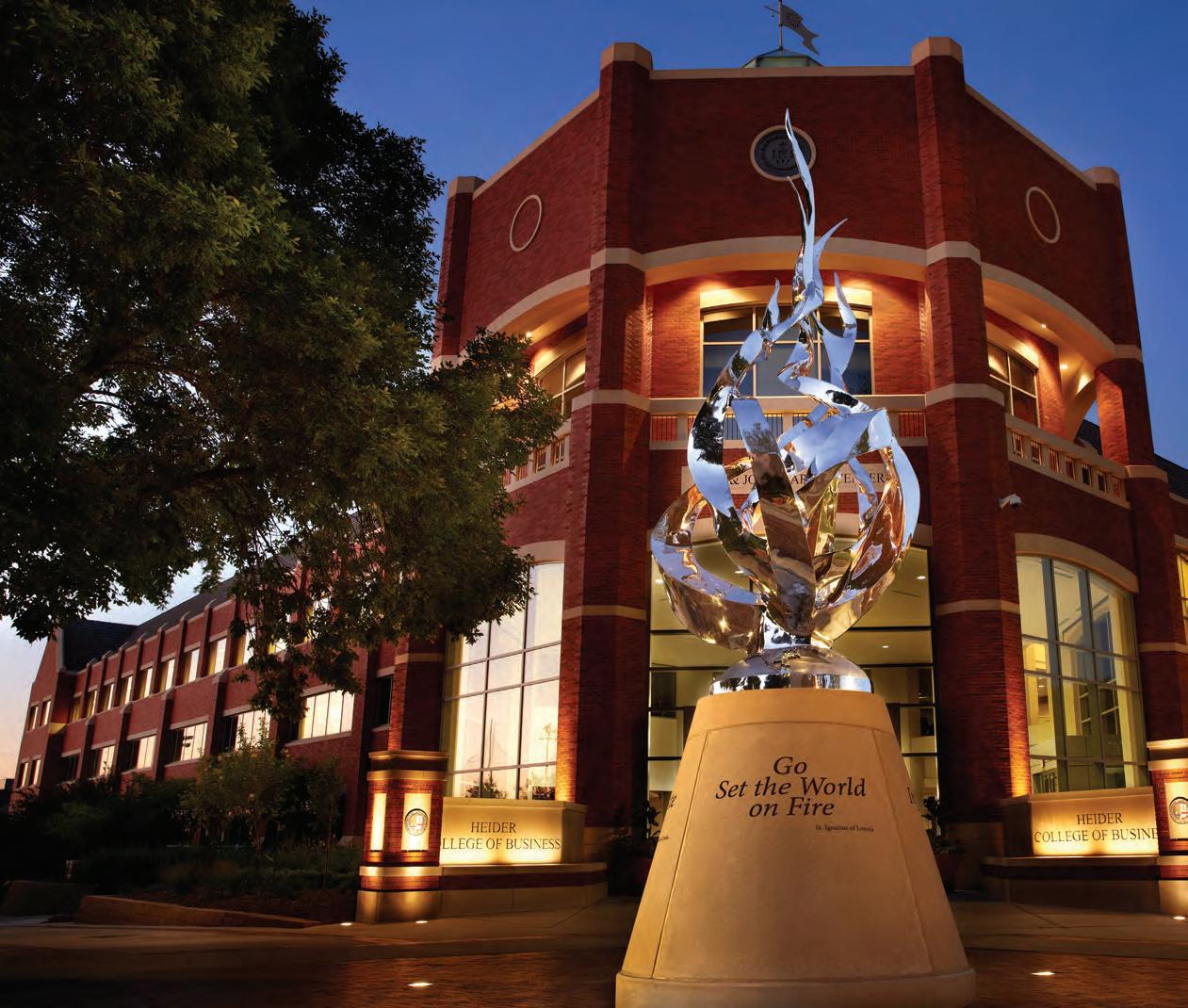
Teaching for the Age of AI
Teaching for Tomorrow
AI is rewriting the rules of early-career work. Routine tasks are automated. Job descriptions evolve overnight. What once defined the “first rung” of a career ladder may no longer exist by the time a student receives their degree.
Creighton University’s Heider College of Business is embracing that disruption and preparing students not just for their first job but for the many reinventions their careers will demand.
“Success today isn’t just about what you know, it’s about how ready you are to learn, unlearn and grow,” says Regina Taylor, professor of marketing and management in the Heider College of Business. “We’re helping students cultivate a growth mindset, one that sees change as opportunity and reflection as a professional skill.”
At Heider, that mindset starts in the classroom. Faculty are redesigning coursework and integrating tools that help students
understand how AI is reshaping their fields, from marketing and analytics to accounting and management. Students explore real-world applications of AI while learning to think ethically, critically and creatively.
Integrating AI Into Career Preparation
Because the world is moving so quickly, what a student learns in class today may shift dramatically within a year. That is why Creighton is focused on skills that endure: analytical thinking, creative problem-solving and a lifelong commitment to learning, all anchored in our Jesuit, Catholic values
Whether it is day one on the job or day 400, Heider graduates are equipped not just to keep up with change but to help shape it.
To learn more about the Heider College of Business, visit Creighton.edu/business.
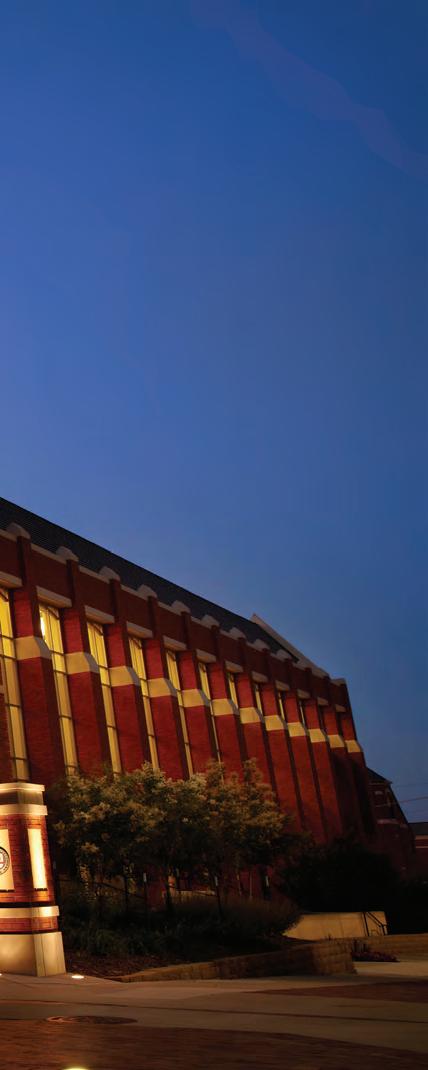


CREIGHTON UNIVERSITY
Creighton University is a private Jesuit, Catholic institution and ranks in the top third of U.S. News & World Report’s rankings for best colleges. With a full range of undergraduate majors, master’s and doctoral programs, opportunities for original research and non-degree offerings for working professionals, Creighton students of all faith traditions learn to think critically, seek justice, serve others, and lead in their communities and on the global stage.
Creighton’s primary campuses, located in Omaha and Phoenix, are home to more than 8,000 undergraduate and graduate
Creighton University has enhanced our campus and community by investing over $500 million in Omaha’s urban core since 2015, fueling innovation and attracting top talent that brings brain gain to Nebraska. Nearly 80 percent of our undergraduates come from outside the state, and half choose to stay here after earning their degrees, creating momentum that extends beyond our campus and energizes the entire state.
– The Rev. Daniel S. Hendrickson, S.J., Ph.D., President Creighton University
students. The Omaha campus is home to nine undergraduate, graduate and professional schools and colleges.
At Creighton, students have the support of a community that helps them
METROPOLITAN COMMUNITY COLLEGE

Metropolitan Community College, Nebraska’s largest community college, provides a robust offering of student-centered education to a community of learners in Douglas, Sarpy, Dodge, and Washington Counties. With a convenient network of more than a dozen locations, collaboration and partnerships with employers, and engagement with K-12 educators and community organizations, MCC provides affordable and accessible education for all.
MCC has seven academic focus areas that put students on a career path, flexible community and workforce training, and leading dual enrollment and youth engagement programs.
MCC is laying the groundwork for a Sarpy County campus southeast of the intersection of Nebraska Highways 370 and 50.
succeed. And they do. Within six months of graduation, 98% of recent alumni are pursuing an advanced degree, participating in a service program or employed.
At MCC, our commitment to our students and community is represented by the diversity of our programs, which are available to all learners at all stages of their educational and career journeys. From accelerated micro-credentials and customized corporate training programs to four-year transfer degrees and everything in between, MCC is in your neighborhood with the classes, programs and resources to help you reach your goals.
– Randy Schmailzl, President, Metropolitan Community College

Founded in 1908, UNO enrolls around 15,000 students across more than 200 academic programs. It houses the Peter Kiewit Institute, which focuses on engineering, information science, and technology. ADOBE STOCK IMAGES
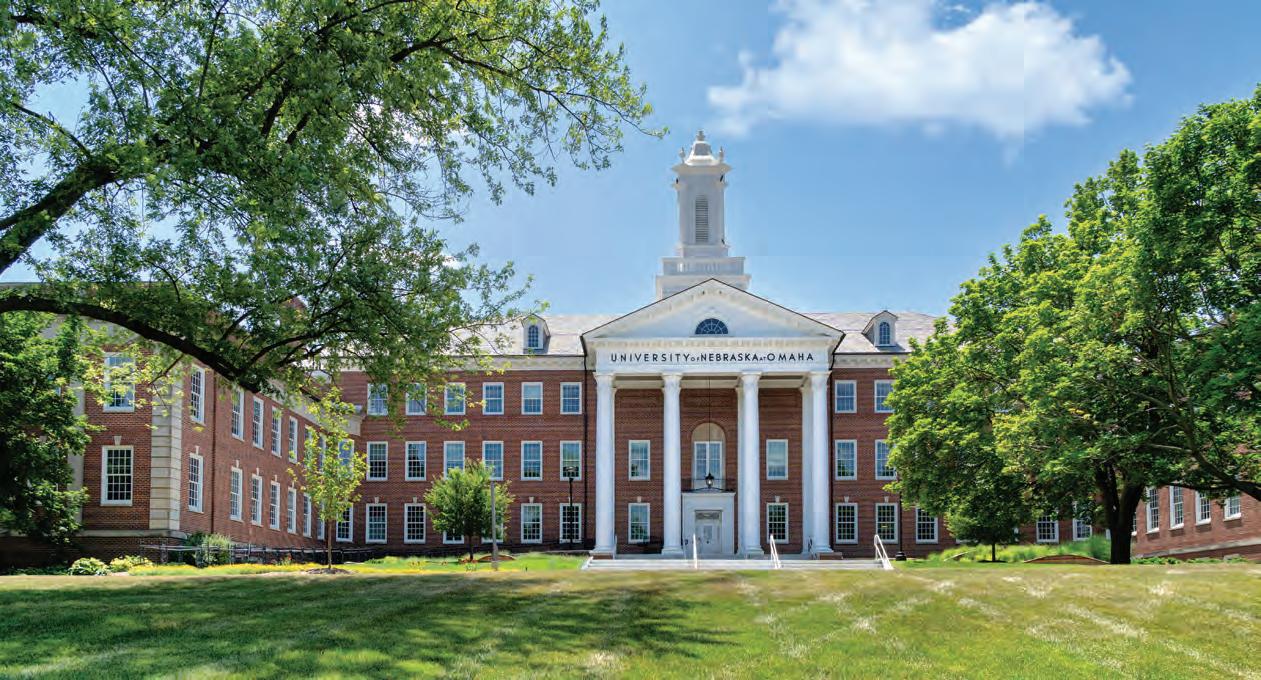
MIDLAND UNIVERSITY UNIVERSITY OF NEBRASKA AT OMAHA
Founded in 1883, Midland University offers opportunities in more than 30 undergraduate academic areas, in 24 online graduate and doctoral programs, and a wide range of professional studies programs at both its Fremont and Omaha locations.
Midland University is a vital partner to the Omaha metro area. Our student body is diverse, drawing from across the nation and the world. We are proud to see that nearly 70 percent of students who come from outside Nebraska choose to stay in the Omaha-Fremont area after graduation – a clear sign that we are educating the next generation of Nebraska’s workforce.
– Aly Williams, Ph.D., President Midland University
With a campus alive with energy, a tradition of excellence, and a future-focused mindset, Midland blends the best of both worlds: the comfort of a close-knit community and the reality of a university overflowing with excellence.
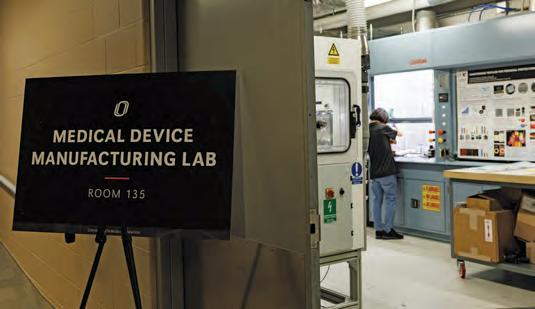
The University of Nebraska at Omaha, an urban-metropolitan university, serves nearly 15,000 students across more than 200 programs. Founded in 1908, UNO is nationally recognized for excellence in online learning, graduate education, and military support, and is ranked No. 1 among public universities nationally for veterans by Military Times. UNO’s focus on affordability means graduates carry the lowest student debt in the University of Nebraska system, averaging $19,000, one-half of the national average.
With nearly 80,000 alumni in the Omaha area contributing $2.4 billion in annual economic impact, UNO fuels the state’s workforce, retaining 81% of graduates in Nebraska after one year and 67% after five – the best of the NU system’s undergraduate campuses. The university’s impact includes $40 million in research funding, eight nationally ranked graduate programs, and partnerships with more than 100 employers offering more than 8,000 internships.
Every great city deserves a great public university with a shared vision of success. UNO is constantly evolving the way we teach, work, and learn so we can deliver educational experiences and produce research that will help this great city of Omaha thrive. Our university is a destination for bright minds and entrepreneurial spirits across the state and the world because Omaha offers unparalleled opportunities for innovation, collaboration, and growth.
– Joanne Li, Ph.D., CFA, Chancellor University of Nebraska at Omaha

SHE’S SKILLED IN THE CLASSROOM & ON THE TRACK

Tonya Gordon, a nine-time AllAmerican and former record holder for the University of South Dakota track and field team, continues to compete in the masters division. TED GRAHAM
Tonya Gordon Teaches Students That Challenges Help Them Grow
Tonya Gordon can take a moment and turn it into a teachable moment.
Some of those times come inside the classroom no matter the subject she’s discussing with her third-grade students at Westgate Elementary School in Omaha. Gordon reinforces they are in a risk-free environment and it’s OK to make mistakes. “Just so they learn from them.”
Other teachable moments come outside – where her students are quick to challenge her to a game of one-on-one in basketball or to a foot race. They know that Gordon is a track athlete who competes at an international level. Still, they do not shy away from presenting their teacher with a challenge.
Does Gordon, a nine-time All-America track athlete at the
University of South Dakota, let her students win in a race, a game of basketball, or some other competition? “Absolutely not,” she said, noting that her father, a track coach, often raced his daughter and never let her win.
Does she use these friendly competitions as opportunities to talk about doing their best and being good sports in victory or defeat? “Absolutely.”
Scott Becker, Gordon’s principal at the Westside Community Schools elementary, is a fan of the 46-year-old teacher who has spent 24 years in the classroom. Her strengths in the classroom are grounded in her ability to build relationships with her students.
Becker said he appreciates how Gordon brings her students
Tonya Gordon celebrates after reaching the triple jump finals and placing second in the javelin at the 2025 Masters World Championships in Gainesville, Florida.
PHOTO COURTESY OF TONYA GORDAN
into her life beyond the classroom. “She has shared how some of the struggles and the victories came together.”
Gordon stepped away from track competition early in her teaching career. Her other focus was her daughter, Ad’astra, who’s now 9. Gordon remained in shape physically – but not competition-ready shape.
At age 40, Gordon aspired to return to competition and compete in masters track events. Her husband, Steve Gordon, who coaches the College of Saint Mary track and field team, is also her coach. Their daughter trains with them and also competes.
Gordon typically trains five to six days a week, incorporating weightlifting into the mix. Training is a family affair, she said. “We’re together, but we all do our own thing.”
Gordon won the women’s triple and long jumps at the 2024 USA Track & Field Masters Indoor Championship in Chicago. At the 2025 World Masters Athletics Indoor Championships in Gainesville, Florida, she placed sixth in the triple jump, 11th in the long jump and second in the javelin in her age category (45 to 49).
Her daily training often serves as a fitting end for busy days at school, she said. “I like my alone time and my quiet time. And that’s where the athletic piece is good for me. Working out and training is a type of therapy for me.”
Gordon’s classroom is just the opposite, she said. After instructing her entire class on a topic, she breaks them into groups where they work at a place that complements their strengths and targets areas for improvement. She might work with one small group while her associates work with others. Often, she and her teaching partner, Mary Morris, bring their classes together.
The two collaborate whenever they can – with a shared goal of bringing real-world experiences to their students. Recently, their reading module focused on the ocean. Gordon’s niece studied marine biology and was working in ocean conservation in Hawaii.
Her niece shared her work with Gordon’s class via FaceTime – and Gordon shared the information with Morris’ class. “If something is happening in the world and it’s appropriate for third-graders, we talk about it,” Gordon said.
Their classes came together last year to learn about crayfish. Brynnleigh Gaff remembers she got to sit in front and hold the crayfish. “I was nervous at first,” she recalled, “but then I was getting the hang of it.”

Brynnleigh’s mother, Maya Gaff, said Gordon made a huge impact on her daughter. These improvements extended beyond academics, Gaff said. Her daughter was better able to concentrate on her daily chores, including her homework.
“Mrs. Gordon is an amazing teacher,” Gaff said. “My daughter can be a little difficult at times. Tonya was able to adapt and figure out what Brynnleigh needed to do well. She made my daughter feel comfortable in class.”
At the end of each school day, Gordon said, she reflects on her interactions with her students.
“A good day would be one where I might feel exhausted. But I’m still leaving with a smile on my face. I feel proud and happy of what we accomplished in the classroom, whether that was academically, behaviorally, socially, or emotionally –whatever it might be and whatever growth they made. I take all that as a win.”
On the track, Gordon said, she isn’t so concerned about winning – although she admits it can be thrilling – as she is working for continual improvement. It’s the same approach she takes with her students.
At the moment, Gordon is focused on reaching 37 meters in the javelin – she threw 33.7 meters at Gainesville – and 9 meters in the triple jump. She jumped 8.56 meters when she placed sixth.
When she talks with her students about their goals, Gordon said, she is quick to talk about her goals for track.
Let’s just call it another teachable moment.
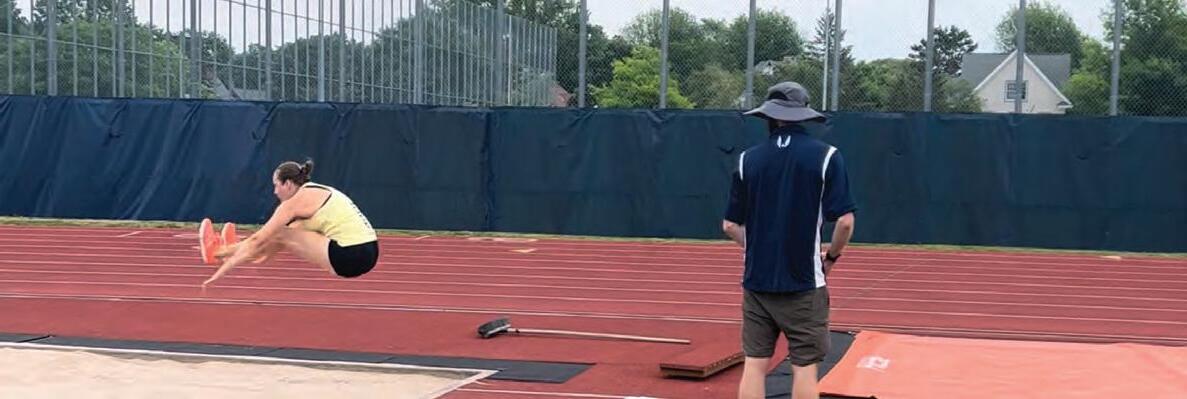
Tonya Gordan swept her age group in the long jump, triple jump, and javelin at the 2023 Mid-American Regionals in St. Paul. PHOTO COURTESY OF TONYA GORDAN
BEST HEALTH CARE IS ‘ALL RIGHT HERE’
Having Two Medical Schools Puts Greater Omaha in the Company of Larger Cities
Greater Omaha, when it comes to health care, you are in good hands.
Here is the reason: Greater Omaha features two medical schools – one public and one private – five nationally acclaimed health care organizations, and numerous treatment centers and clinics. Thousands of health care professionals, including nearly 3,000 physicians, provide this care and educate the next generation of caregivers for Greater Omaha.
“You would be hard-pressed to need to look elsewhere to find the care you need. It’s all right here,” said Carol Wang, executive director of the Metro Omaha Medical Society. “And that care is provided by the very best in health care.”
Wang should know – she works hand-in-hand with the physician-members of the 159-year-old medical society. “Our health care professionals save lives, provide compassionate care, and push the realm of what we never thought possible.”
Greater Omaha’s organizations never settle in their quest to provide the best in care, Wang said. Some examples:
• The Behavioral Health and Wellness Center at Children’s Nebraska, built in partnership with the Mental Health Innovation Foundation, will open early in 2026. The facility will provide comprehensive, world-class behavioral health care and offer a full spectrum of mental health services to meet the growing needs of children and adolescents in Nebraska and the Midwest.
• Methodist Jennie Edmundson Hospital in Council Bluffs partnered with Acadia Healthcare, the nation’s leading provider in behavioral health care, to build a 96-bed inpatient treatment facility. The facility, set to open in 2026, includes 24 inpatient beds for the behavioral health needs of children and adolescents.

Other news of note came in July when the U.S. Department of Veteran Affairs announced that the Omaha VA Hospital was included in its five-year development plan. Inclusion means the 75-year-old hospital is slated to be replaced.
Wang notes Greater Omaha, with its two medical schools, finds itself in company with much larger communities. “To have one medical school is such a blessing, but two sets you apart.” The University of Nebraska Medical Center and Creighton University Medical Center, Wang said, draw attention to the state and continually look to improve the academic environment for their students.

The University of Nebraska Medical Center, founded in 1869 and part of the University of Nebraska system since 1902, features colleges of medicine, dentistry, pharmacy, nursing, public health, and allied health professions. It offers nearly 70 residency and fellowship programs. Together with its partner, Nebraska Medicine, UNMC has an annual economic impact of $5.9 billion on Nebraska’s economy. UNMC is an innovator in the fight against infectious diseases. Its experts led the response to the Ebola outbreak and the COVID-19 pandemic.
On tap: Project Health, a $2.19 billion health care facility at UNMC and Nebraska Medicine, will be a clinical learning
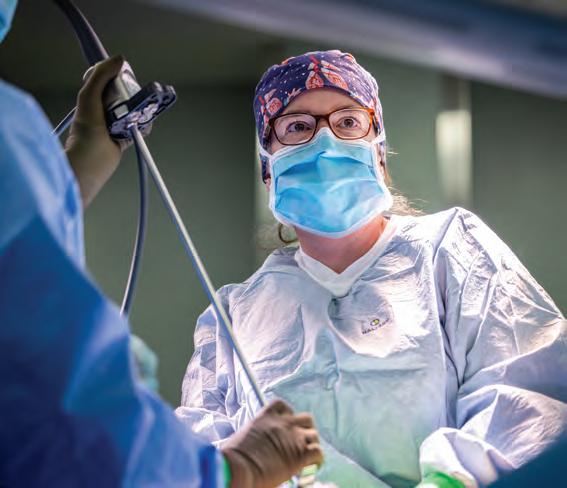
Thoracic surgeon Dr. Karin Trujillo performs robotic-assisted surgery. PHOTO COURTESY OF METHODIST
The final signatures are added to the final beam for the Behavioral Health & Wellness Center at Children’s Nebraska. NIKOS FRAZIER
Children’s Nebraska: Expert Pediatric Care for Every Step of the Journey
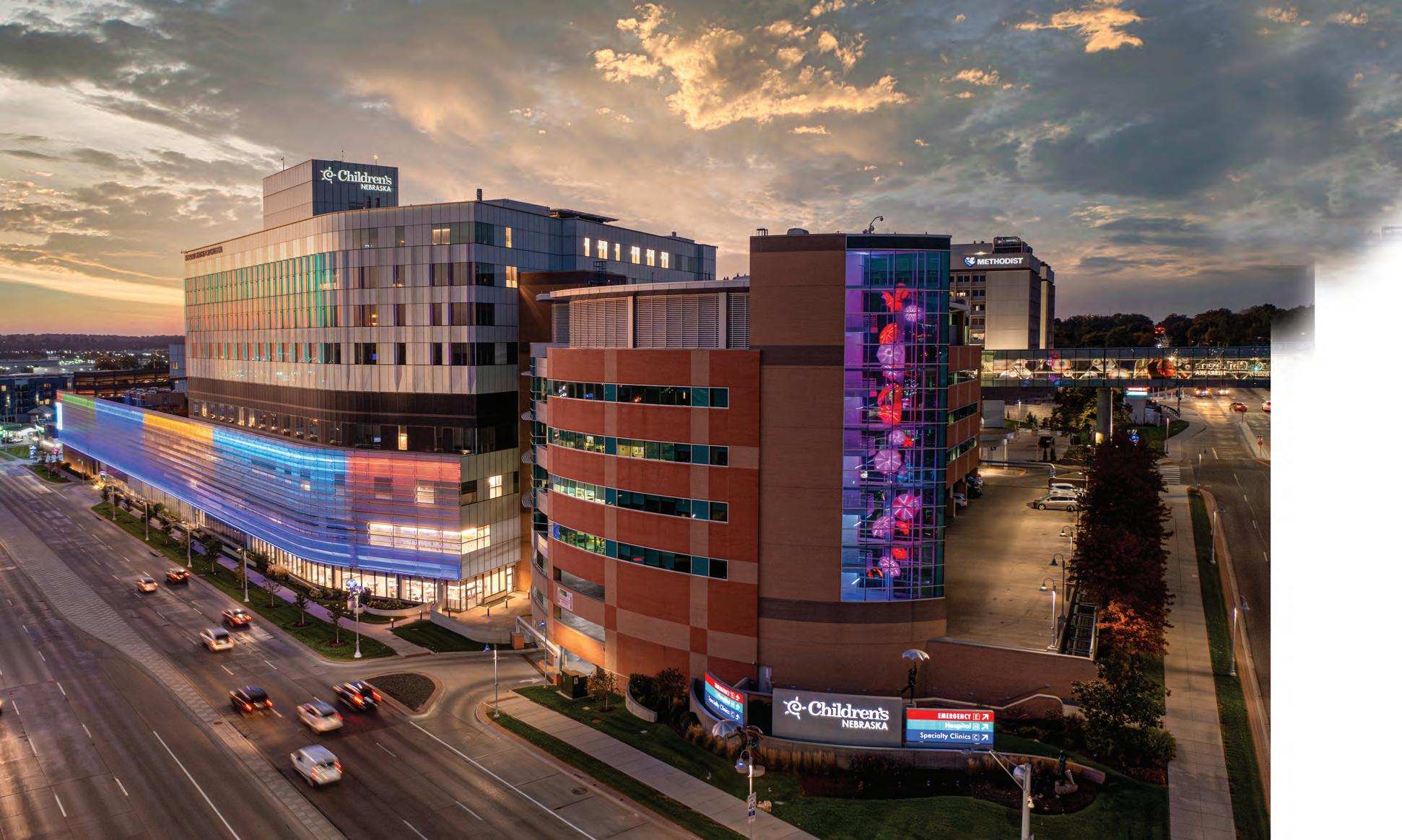
At Children’s Nebraska, our mission is to improve the life of every child – at every stage of life, for every health need that may arise. As the state’s only hospital dedicated solely to children, we provide a true continuum of care: from family-centered primary care and prevention to highly specialized treatment and long-term support.
For newborns, Children’s is home to the state’s first and only Level IV Neonatal Intensive Care Unit, providing lifesaving expertise for the tiniest patients. As children grow, they benefit from access to our more than 50 pediatric specialties and the state’s only Level I pediatric trauma center and Level 4 epilepsy center dedicated exclusively to kids. Whether a child needs innovative surgical intervention – employing 3D printing, robotic-assisted procedures or virtual reality therapies – or ongoing management of complex conditions, Children’s ensures they receive the right care at the right time.



This year, we expanded our continuum of caring for the whole child with the opening of the Behavioral Health & Wellness Center – the first facility of its kind in the region – to meet the rising demand for pediatric mental health services. From urgent care and outpatient therapy to inpatient and partial hospitalization programs, the center offers comprehensive care and holistic support for both body and mind.
Behind this life-changing mission are our people. Guided by values of innovation, collaboration, accountability, respect and excellence, our team members embody a People First culture that fosters joy, growth and belonging. That culture fuels exceptional care and outcomes for children and families across a five-state region and beyond.
Together, we are Children’s Nebraska – caring for kids at every step of the journey and building a healthier future for generations to come.
Learn more at ChildrensNebraska.org.
President of the Mental Health Innovation Foundation, Ken Stinson, speaks on stage at the groundbreaking of the Behavioral Health & Wellness Center at Children’s Nebraska. KATY COWELL

center to educate and train the next generation of health care providers, conduct research, and offer clinical trials.
Creighton University Health Sciences is a nationally ranked and recognized institution that delivers a leading health sciences education, featuring programs in medicine, nursing, dentistry, physician assistant, occupational therapy, physical therapy, and pharmacy. Through the university’s innovative approach to interdisciplinary education, students learn and train alongside other health sciences professions, mirroring the team-based care they will encounter in their careers.
In play: Two recent projects underline the growth of Creighton’s health sciences enterprise — the CL and Rachel Werner Center for Health Sciences Education (opened in 2023) and the Creighton University Health Sciences Campus – Phoenix (opened in 2021). These state-of-the-art facilities are studentfocused, with nearly every square foot dedicated to classrooms, collaboration, and hands-on learning.
The Metro Area’s Five Major Health Care Systems
BOYS TOWN HOSPITAL
Since its founding in 1977, Boys Town Hospital has been an internationally recognized leader in clinical and research programs. Its research focuses on hearing and balance, speech and language, neuroscience, and behavioral health. The findings in its research labs become innovative care for the children, families, and patients served.
Major milestones since the opening of the hospital include the construction of the Lied Learning and Technology Center,
which is now the main hospital on the Village of Boys Town campus; the Boys Town Residential Treatment Center adjacent to the west hospital in 2013, with an addition in 2017; and the Psychiatric Inpatient Center in 2019.
In 2024, Boys Town Hospital attained a breakthrough with brain atlases, which are tools that map the brain. Atlas55+ was mapped by the Boys Town Brain Architecture, Imaging, and Cognition Lab and its affiliates. The atlas allows scientists researching brain and cognition changes in later adulthood to have a reliable map of the brain. The atlas can aid in the diagnosis of neurodegenerative disorders such as mild cognitive impairment or Alzheimer’s disease by providing a baseline for what healthy aging brain networks look like.
CHI HEALTH
CHI Health is the largest health care system in Nebraska, with 14 hospitals and more than 136 clinics spread throughout the state and western Iowa. The faith-based hospital system, which includes five full-service hospitals in Greater Omaha, cares for more than 1 million patients each year and is one of the area’s largest employers with more than 11,000 employees. CHI Health, a member of CommonSpirit Health, provides $240.8 million in community benefit for fiscal year 2024.
Community members in Greater Omaha can find care at CHI Health Lakeside, Immanuel, Midlands, Mercy Council Bluffs, and Creighton University Medical Center-Bergan Mercy – one of the area’s two Level 1 trauma centers. Among the medical services provided by CHI Health are emergency care, general surgery, orthopedics, heart and vascular care, neurology, maternity and women’s health, and oncology. In addition, CHI Health’s network of primary care clinics is embedded throughout the community, offering walk-in priority care and other services.
Holcomb, MD Head and Neck Oncology








Andrew
We’re Number NE!

Number One Digital News
Subscription Website
#1 in Total News Website Traffic
(SEM Rush, December 2023 vs. WOWT.com and KETV.com)
#1 in Pages Per Visit – BY 3X!
(SEM Rush, December 2023 vs. WOWT.com and KETV.com)
1.5 Million Monthly Users (Google Analytics)
2.7 Million Monthly Sessions (Google Analytics)
15.6 Million Monthly Page Views (Google Analytics)
4 Minutes Average Time on Website
89% Growth in Digital Subscriptions since 2020
Number One Local News Audience Reach
68K Average Daily Print Readership
20.2K Opted-in Email Subscribers
163K Followers on Social Media (120K Facebook, 29K Instagram, 5K LinkedIn)
8.7K App Downloads
CHILDREN’S NEBRASKA
Children’s Nebraska is dedicated to improving the life of every child through pediatric care, advocacy, research, and education. It is the only full-service, pediatric health care center in Nebraska, providing expertise in primary care and more than 50 pediatric specialty services to children of all ages across a five-state region and beyond.
Children’s is home to Nebraska’s only Level 4 regional Newborn Intensive Care Unit, the only Level 2 Pediatric Trauma Center statewide, and the state’s only Level 4 Epilepsy Center dedicated exclusively to pediatrics. The Dr. C.C. and Mabel L. Criss Heart Center at Children’s Hospital houses nationally known experts in cardiology, cardiothoracic surgery, and more.
Children’s was recognized as a best children’s hospital by U.S. News & World Report in 2024-25, ranked among the best in the specialties of pulmonology & lung surgery and nephrology.
METHODIST HEALTH SYSTEM
Founded in 1982 with its flagship hospital established in 1891, Methodist Health System serves Nebraska and western Iowa. It is home to four hospitals, more than 30 clinic locations, a nursing and allied health college, two neonatal intensive care units (Level 3 and Level 2), a medical supply distributorship, a central laundry, and the new behavioral health hospital in Council Bluffs.
Methodist offers a number of clinical research opportunities, the latest in technological advancements, and services that span the full scope of medicine. It prides itself on being a regional leader in cardiovascular care, cancer care, primary care, orthopedics, and women’s health – overseeing more than 5,000 births annually and consistently being recognized for offering the highest level of maternity care nationally.
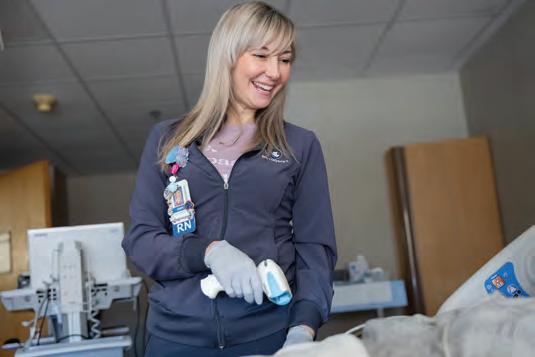
In recent years a number of prestigious awards and accreditations have put Methodist in distinguished company nationwide, positioning it as a premier place to work and receive highly specialized care.
NEBRASKA MEDICINE
The Nebraska Medicine health network provides access to more than 1,400 doctors and nearly
70 specialty and primary care health centers in metro Omaha and the surrounding region. Its two hospitals – Nebraska Medical Center and Bellevue Medical Center – have more than 800 licensed beds. More than 10,000 employees are part of the region’s leading academic health network.
Nebraska Medicine and its research and education partner, the University of Nebraska Medical Center, share the same mission: to lead the world in transforming lives and creating a healthier future for all individuals and communities through premier educational programs, innovative research, and extraordinary patient care.
Nebraska Medicine is internationally recognized for life-saving cancer care, organ transplantation, and infectious disease treatment and prevention. Nebraska Medical Center is the state’s largest hospital and for 14 consecutive years has been awarded best in state by U.S. News & World Report and ranked by Forbes as one of the state’s best employers.


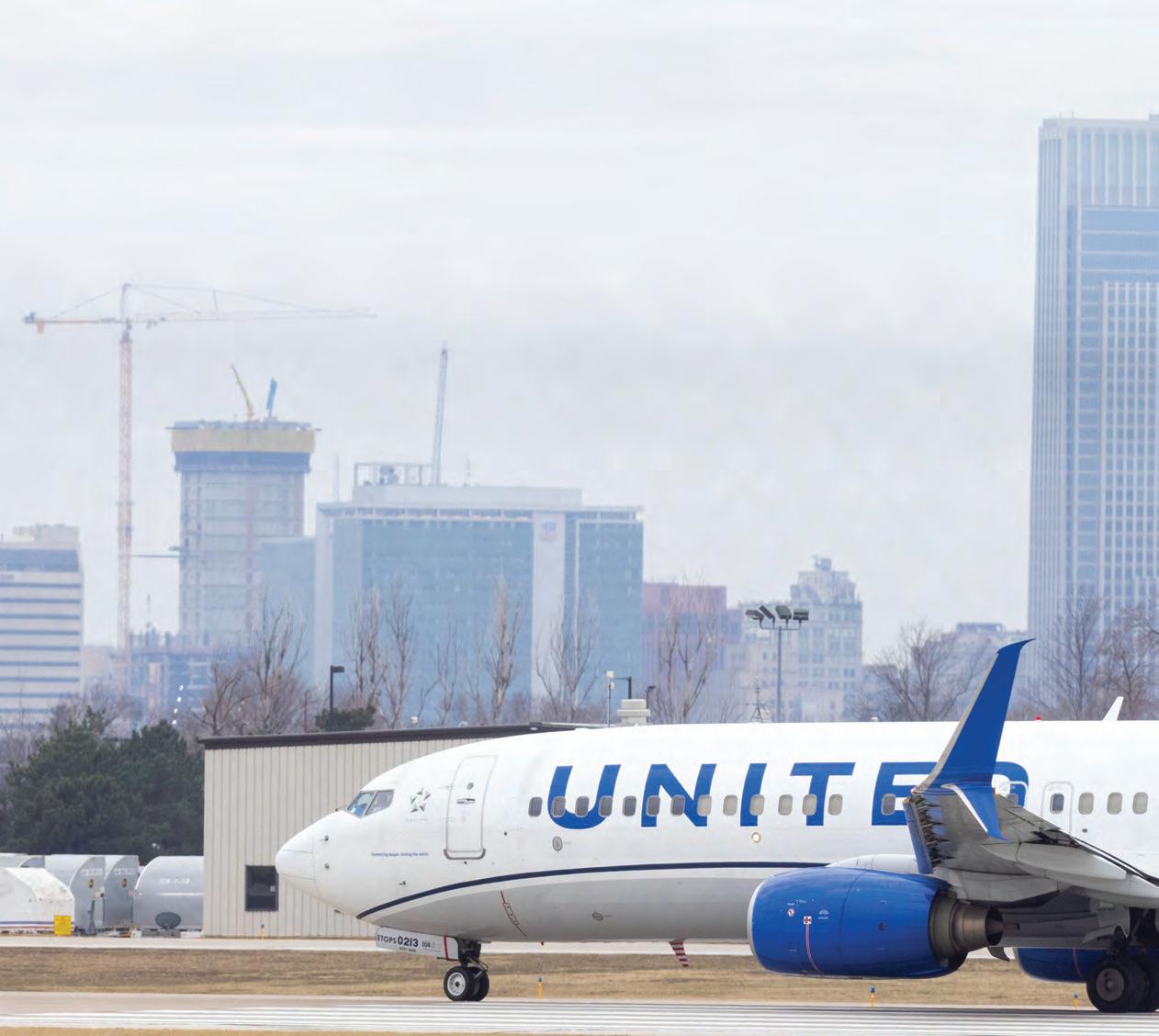
Bob Recker rather enjoys his commute to work and the return home. Both provide an opportunity for Recker to ride his bicycle on Omaha’s Keystone Trail.
“It’s a good way to start my day,” said Recker, medical director for Think Whole Person Healthcare, which is situated in central Omaha. “And then finish it.”
Recker’s journey takes him through Elmwood Park and on some city streets before he accesses the Keystone Trail, which is part of Omaha’s connected bicycle trail system of more than 100 miles. He reverses the trip on his way home. In all, Recker’s trek to work and back logs him about 25 miles of cycling. “I enjoy the ride – and get some exercise along the way.”
While motor vehicles remain the go-to means for getting from here to there in the greater metropolitan area, they’re not the
only option. But first things first. Visitors to the area – and our residents – long have commented about the relative ease and efficiency in traversing Omaha. Mostly, they say, the northsouth, east-west grid makes for easy going. The Interstate system complements Omaha’s street layout.
The area’s trail system – with the Keystone, West Papio and South Omaha trails serving as its core – enables joggers, walkers, and cyclists (and those who aspire to be) every opportunity for exercise throughout the year. City planners continue to improve the trail system and expand its reach.
The Metro bus system provides another means of transportation for those without their own vehicles or those who would rather keep them parked in the garage. The Metro offers service to more than 2,100 bus stops across the Omaha metro area.
TRANSPORTATION IN OMAHA TAKES THE FAST TRACK
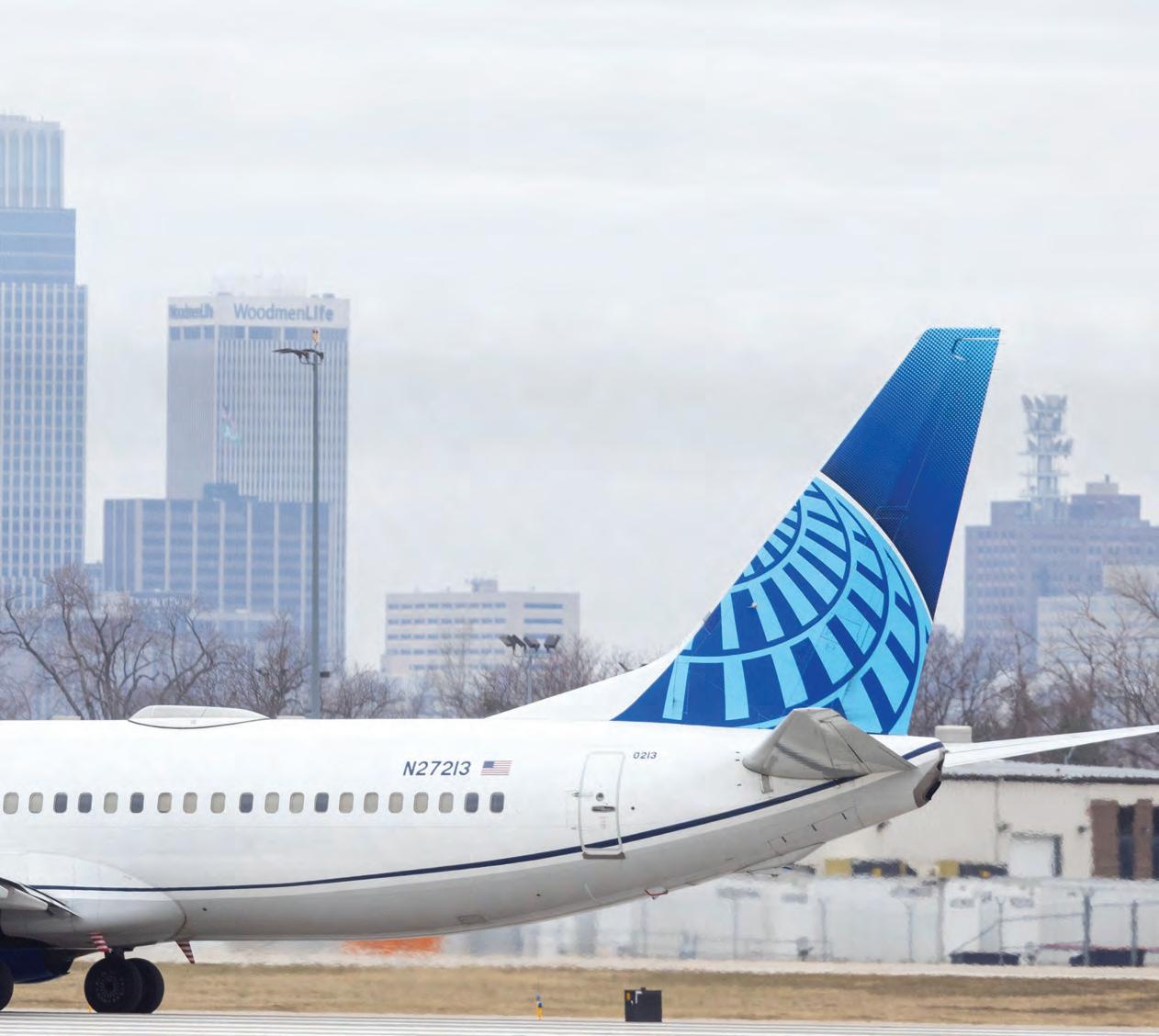
Eppley Airfield (OMA) offers about 70 daily departures to more than 30 nonstop destinations. In 2024, OMA handled a record 5.277 million passengers, a 5% increase over the previous year. CHRIS MACHIAN

Omaha’s public transportation is run by Metro Transit, which operates a network of local buses plus the ORBT (Omaha Rapid Bus Transit), a frequent, high-capacity route along Dodge and Douglas Streets.
MEGAN NIELSEN

Aaron Filipi, who lives in the Elmwood Park neighborhood, is grateful one of those bus stops is near his home. On the occasions when his daughter needs to borrow his SUV, Filipi hops on a bus near 49th and Dodge Streets, transfers to another at the Westroads transit center, and is dropped off within blocks of his work office in the Old Mill area. Walks and waits included, he said, he’s to work within 30 minutes. He has a similar travel time on his return trip. “The Metro is my backup plan,” he said, “and it’s been a lifesaver.”
A more recent option for bus travel is Metro’s Omaha Rapid Bus Transit, which combines smart technology and streamlined
travel for faster transportation. ORBT serves an eight-mile route along Dodge and Douglas Streets from downtown Omaha to Westroads Mall and features enhanced stations and roomier buses.
In addition, MOBY, Metro’s shared, ADA complementary paratransit service, offers door-to-door service for those who cannot access the Metro because of a disability or disabling health condition. MOBY service mirrors the Metro in geographic area served and hours of operation.
Travel to and from Omaha is about to get even better. In 2024, the Omaha Airport Authority unveiled a $950 million Eppley Airfield terminal expansion and renovation project featuring additional arrival-departure gates and gates geared for international flights. Developed with long-term growth in mind, Eppley’s terminal size will nearly double.
Other highlights of the project, scheduled for completion in 2028:
• A single, unified concourse with a centralized Transportation
• Security Administration security screening checkpoint.
• An increase to 22 arrival-departure gates from the current 20, with the ability to add gates.
• Larger gate-boarding areas.
• New expanded restaurants and retail concessions beyond the security checkpoint.
• A new automated inline baggage handling system and an expanded baggage claim area.
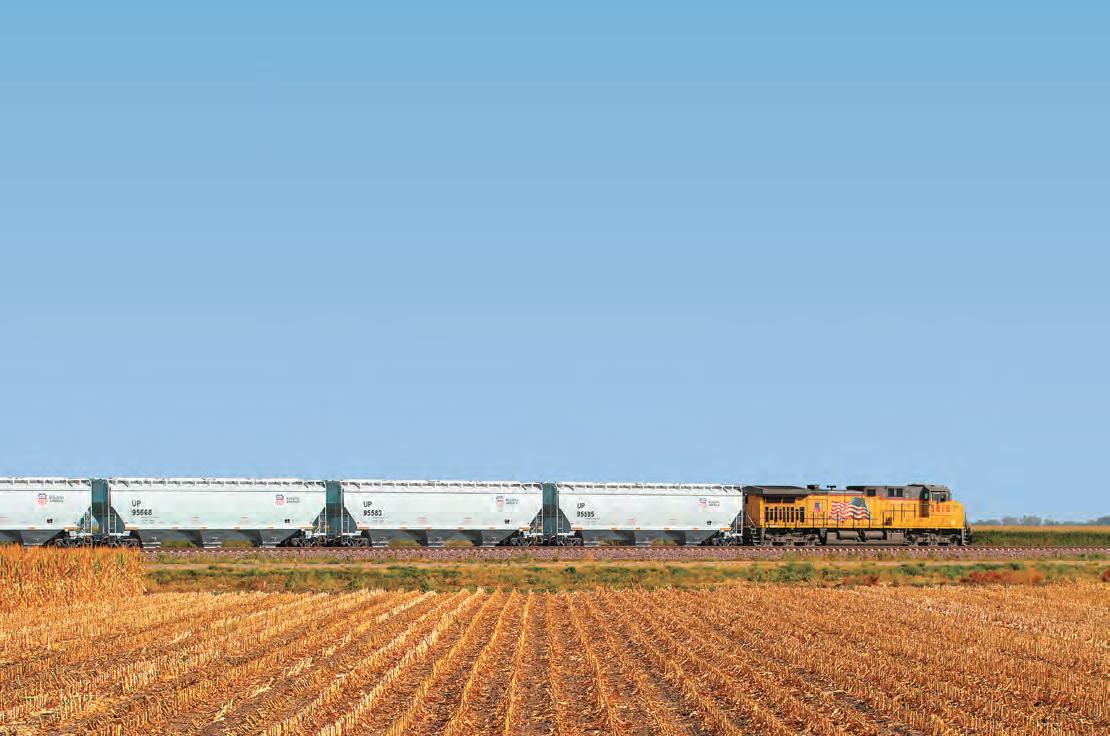
Connecting the Nation from the Heartland
Signed into existence by President Abraham Lincoln, Union Pacific laid the rail that united the nation in 1869. Since then, our employees have lived and worked in this great community we call ‘home,’ establishing deep roots and a prominent place in the nation’s history.
163 years later, we’re just picking up steam.
Union Pacific and Norfolk Southern are building the nation’s first coast-to-coast railroad to strengthen communities and build a stronger, more competitive America. A seamless railroad means faster service, fewer handoffs and greater supply chain options through enhanced competition.
“Union Pacific is an engine for growth in Nebraska,” said U.S. Sen. Pete Ricketts. “This has the potential to create jobs, increase wages, and streamline the supply chain. This merger is a great deal for Nebraska and America.”
It’s also a deal the nation’s largest railroad union supports.
“We are protecting jobs, protecting families, and protecting the future of the U.S. supply chain,” said SMART-TD President Jeremy R. Ferguson.
Learn more.
“We are transforming Eppley Airfield,” Dave Roth, the airport authority’s chief executive officer, told the Omaha WorldHerald. “I don’t think there’s a square foot (of the terminal) we aren’t touching.”
Increasing travel numbers necessitated the project, Roth said. Passenger traffic at Eppley set a record of nearly 5.28 million travelers in 2024. That’s up from 5.03 million in 2023 and the previous record of 5.04 million in 2018.
Also on Omaha’s docket is its streetcar project, which will connect downtown with the Blackstone neighborhood to the west. The streetcar project is intended to promote dense development within Omaha’s urban core and connect downtown and midtown destinations and entertainment venues, among them the city convention center and arena, the riverfront parks, the Holland Center, the Old Market, Midtown Crossing, and the University of Nebraska Medical Center.
“Let me be clear: The benefits of the streetcar will be felt in every neighborhood of the city,” Omaha Mayor John Ewing told the World-Herald.
For the moment, however, Jared and Layla Van Cleve just wanted to explore Omaha’s Old Market on a recent Friday evening. Father and daughter had traveled from Moberly, Missouri, to Omaha for a Tyler Childers concert at CHI Health Center Arena, and remained an extra day. Their mode of transportation that evening: two Lime scooters – the electric rentals that can be found throughout downtown. “We’ve never ridden one before,” Van Cleve said, “and thought it would be fun to give it a try.”
His daughter added: “Not before we practice in the parking lot first.”
Omaha Mayor John Ewing provides an update on the Omaha Streetcar Project near the future site of the streetcar vehicle maintenance facility. NIKOS FRAZIER



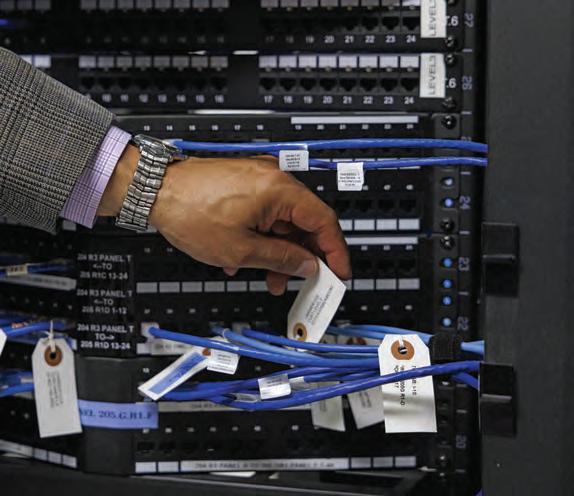
Ken Moreano, president and CEO of Scott Data, gives a tour of the Center for Cardiovascular Research in Biomechanics. The vision is to develop innovative materials and devices to address cardiovascular disease.
MEGAN NIELSEN
AT THE HEART OF INNOVATION
Biomechanics Expansion Positions UNO as Hub for Cardiovascular Breakthroughs
The University of Nebraska at Omaha is quietly engineering a medical revolution.
With a $17.1 million expansion – which broke ground in spring 2025 – to its world-renowned Biomechanics Research Building, UNO is positioning itself as a national hub for cardiovascular breakthroughs.
The new Center for Cardiovascular Research in Biomechanics (CRiB) promises not just academic prestige but also life-saving innovations that could ripple across Nebraska and beyond.
Established in 2024 after UNO received an $11 million grant from the National Institutes of Health, CRiB focuses on developing flexible, durable materials for stents and grafts that mimic the dynamic nature of arteries. That is especially important for treating peripheral arterial disease, which affects over 12 million Americans.
“Researchers at UNO are tackling the problem of stent failure due to mechanical mismatch, aiming to reduce repeat surgeries
and amputations,” said Dr. Nick Stergiou, assistant dean and director of the Division of Biomechanics and Research Development. “Advanced modeling allows for patient-specific simulations of blood flow and tissue mechanics, helping doctors tailor interventions before they’re even performed.”
The three-story addition will add 19,000 square feet to the east end of the building and will include laboratory, instructional, and office spaces when it opens in 2028. The center’s aim is to develop innovative materials and devices to address the pressing challenges posed by vascular diseases.
“When a university and its community join forces, the results can be transformational,” said Dr. Stergiou, who is also the Distinguished Community Research Chair in Biomechanics. “UNO Biomechanics is proof. We have created something that is more than a research building.
“We have created an amazing present, but we are also developing a tremendous future that will attract even more brilliant students, innovative scientists, and global collaborators to Omaha.”
Biomechanics is the study of how the principles of mechanics are applied to biological systems, particularly the musculoskeletal system, to understand and improve movement. Research can explain how the body moves, improve athletic performance, help in the design of safer equipment like prosthetics and athletic shoes, and help prevent injuries.
“Regarding biomechanics, I can certainly say that its impact on the greater Omaha community has been huge,” Dr. Stergiou said.
For example, he said, the Center for Research in Human Movement Variability, which is part of UNO Biomechanics, had a $27.5 million impact on the Omaha community from 2019 through 2023. In addition, UNO Biomechanics had 52 new inventions, 18 new patent applications, and five licensed startups in just the last five years, he said.
“It is creating a small biomechanics ‘silicon valley’ by itself,’’ Dr. Stergiou said.
This expansion marks the third phase of a visionary project that began in 2013 and has since positioned UNO as a global leader in biomechanics research. Ruth Scott and her late husband, Bill, have provided philanthropic support for each phase of construction.
UNO’s expansion is driven by several key goals, including advancing life-saving research, growing faculty and student capacity, fostering interdisciplinary collaboration, and strengthening Omaha’s reputation as a hub for cutting-edge health science.


But this expansion isn’t just about bricks and mortar – it is about transforming lives through science, education, and innovation.
“This project will not only address a critical health crisis, but it will also reinforce UNO’s role as a leading public research university that innovates for the public good,” said UNO Chancellor Joanne Li. “This addition cements UNO Biomechanics as the destination in the world to teach, learn, and discover in this vital field.”
Mon: 10:30am-9:0 0pm Tuesdays: Closed Wed-Thurs: 10:30am-10:0 0pm
Fri-Sat: 10:0 0am-11:0 0pm Sun: 10:0 0am-10:0 0pm
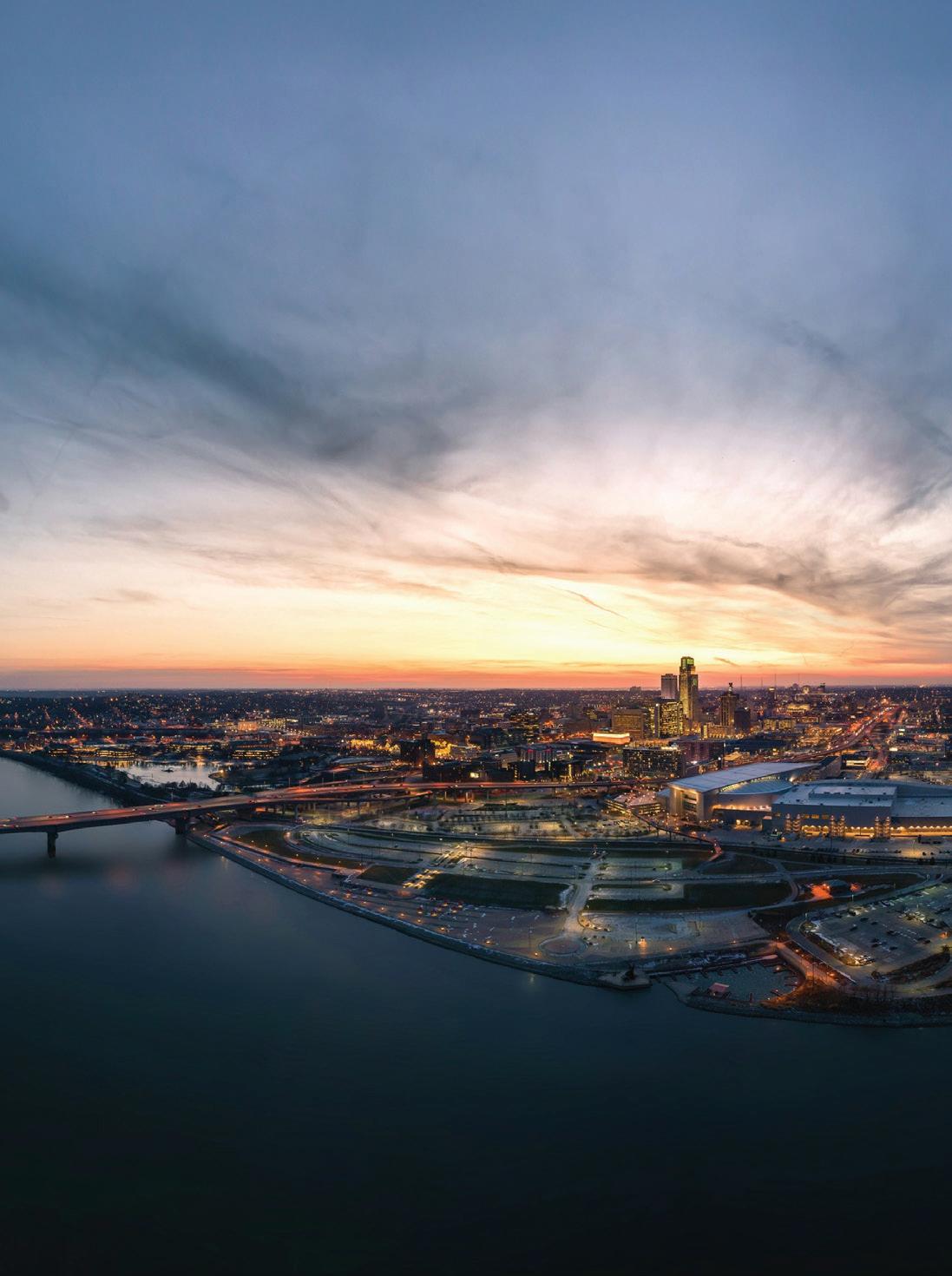
For 85 years, we’ve backed and believed in the people who make our hometown the best place to live and grow.
We’ve never coasted and we never will because Blue believes in Omaha, and
OMAHA & OFFUTT: A SYMBIOTIC PAST, PRESENT AND FUTURE

Offutt Air Force Base is home to U.S. Strategic Command and the 55th Wing of Air Combat Command.
The identities of Omaha and Offutt Air Force Base are inextricably linked.
The base, located south of Omaha in Bellevue, contributes significantly to the local economy and culture, with thousands of active-duty personnel, civilians, and retirees living in the area. In turn, Omaha provides a supportive environment for military families, with robust housing, education, and recreational options.
Omaha wouldn’t be what it is today without its military families and veterans who call the area home. Omaha enjoys a special relationship with Offutt, one of the state’s largest employers.
“With nearly 6,000 active-duty personnel and thousands of civilian employees, Offutt Air Force Base is one of Nebraska’s largest employers—its presence extends well beyond Bellevue, shaping communities and economies across the Greater
Omaha region,” said Randy Norwood, Assistant Vice President of Military Affairs & Strategic Partnership for the Greater Omaha Chamber.
Offutt Air Force Base has played a vital role in the metro area’s identity since the first air unit was assigned to the post in 1918. Home to the U.S. Strategic Command, the 55th Wing, and other units, Offutt plays a crucial role in national defense and global security.
Modern Strategy
As Offutt continues to modernize and expand its strategic capabilities, Omaha stands ready to support its mission — whether through infrastructure, policy, or community engagement. Together, they form a resilient partnership built on shared history and mutual respect.
A E-4B Nightwatch aircraft takes off as another one prepares for take off. Runway renovations have temporarily forced the planes to move out of Offutt Air Force Base. CHRIS MACHIAN

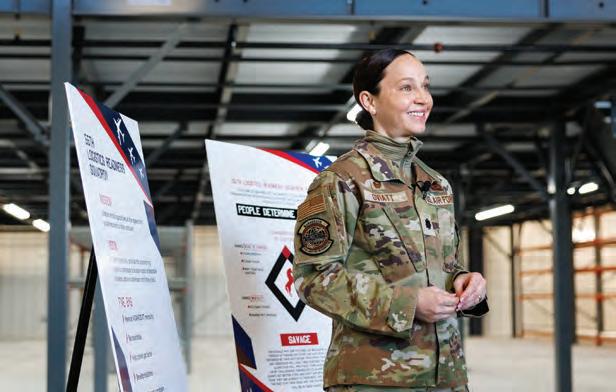
Lt. Col. Caitlin Oviatt, 55th Logistics
Readiness commander, answers questions during a tour of the new $19.5 million logistics readiness squadron at Offutt Air Force Base. NIKOS FRAZIER
U.S.

Force
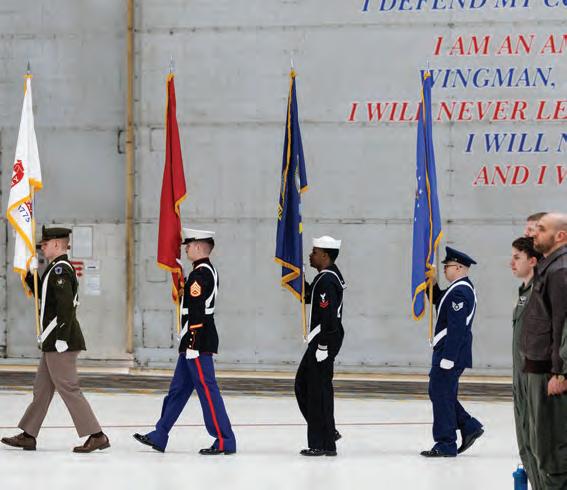
The presence of Offutt has had a significant impact on the local economy, providing jobs, business opportunities, and support services to the extended Omaha community. Annually, Offutt employs more than 10,000 military and civilian personnel with an annual payroll of more than $1 billion – creating a strong workforce and community contributing to the region’s economic growth and stability.
In addition, over 8,000 dependents accompany military members to Offutt, and an additional 26,000 members of the military have retired in the Omaha area. Offutt’s total economic impact in 2024 was nearly $3 billion, and military activity supports nearly 23,000 jobs tied directly to Offutt.
Benefiting Everyone
The relationship between Omaha and Offutt continues to grow stronger through strategic investments and intentional collaboration:
• $54.3 million in federal funding was advanced in 2025 for military construction projects at Offutt.
• Offutt has played a key role in international exercises like Talisman Sabre 2025, deploying RC-135 aircraft and personnel to Australia to reinforce global partnerships.
• The School Liaison Program connects military families with local education systems, supporting thousands of students across Nebraska and Iowa.
These developments reflect a modernized, globally integrated Offutt AFB – one that remains deeply rooted in Omaha’s civic and cultural fabric.
95th Wing Activation
On February 28, 2025, the Air Force officially activated the 95th Wing at Offutt AFB. The new wing consolidates elements of the 595th Command and Control Group, the 610th Command and Control Squadron, and missile-command Air National Guard units. Its activation strengthens Offutt’s role as the nation’s hub for command-and-control operations and provides a streamlined organizational structure to support national defense.
New CATM Facility
Offutt’s 55th Security Forces Squadron recently completed a new Combat Arms Training and Maintenance facility, which includes a 40,500-square-foot complex with classrooms, a simulator room, and a 25-meter firing range. This upgrade will allow the squadron to train more personnel and reduce training time.
New 55th Wing Commander
The new commander of the 55th Wing at Offutt Air Force Base is Col. Aaron T. Gray. He assumed command on June 17, taking over from Col. Mark Howard.
The
Air
Thunderbirds perform during the Defenders of Freedom Air and Space Show at Offutt Air Force Base. NIKOS FRAZIER

Gray, a former deputy commander of the 55th Wing, brings a lot of experience. As an RC-135V/W Rivet Joint, EC-130H Compass Call, T-44 and T-37 pilot he’s clocked more than 3,200 flying hours, including 1,600 combat hours. Gray will be responsible for supporting more than 50 associate units, including U.S. Strategic Command, the 557th Weather Wing, the 95th Wing, and more than 45,000 service members, civilians, family members, and retirees.
Mutual Respect
Beyond economic considerations, the relationship between Offutt Air Force Base and Greater Omaha is characterized by mutual respect, understanding, and collaboration.
“The 2024 SAF/IE Community Partnership Award is an excellent example of the teamwork between Offutt AFB and Omaha, showing how our efforts together support servicemembers and the community.”
Base leadership and local stakeholders have a forum for dialogue and partnership. This Strategic Command Consultation Committee facilitates communication, cooperation, and problem-solving on issues of mutual interest. Those issues can include infrastructure development, environmental concerns, and community relations.
Military personnel and their families are integral members of the community, participating in local events, supporting charitable causes, and forming lasting friendships with civilians. Likewise, civilians in Omaha show their appreciation for the military through gestures of support, such as care packages, volunteer work, and public displays of gratitude.
“The partnership between Offutt Air Force Base and the Omaha community strengthens both our military and our region,” Norwood said. “By working together on quality-of-life initiatives, education, and workforce development, we support servicemembers, veterans, their families, and the broader community while driving regional prosperity.”
Furthermore, Offutt and Omaha partner on projects that enhance the quality of life for military personnel, civilians, and families in the region. Initiatives such as housing assistance, health care services, and educational opportunities demonstrate a commitment to supporting the well-being and success of all community members.
By working together on these initiatives, Offutt and Omaha
A ceremonial ribbon is cut on the new $19.5 million logistics readiness squadron during a ceremony at Offutt Air Force Base. NIKOS FRAZIER
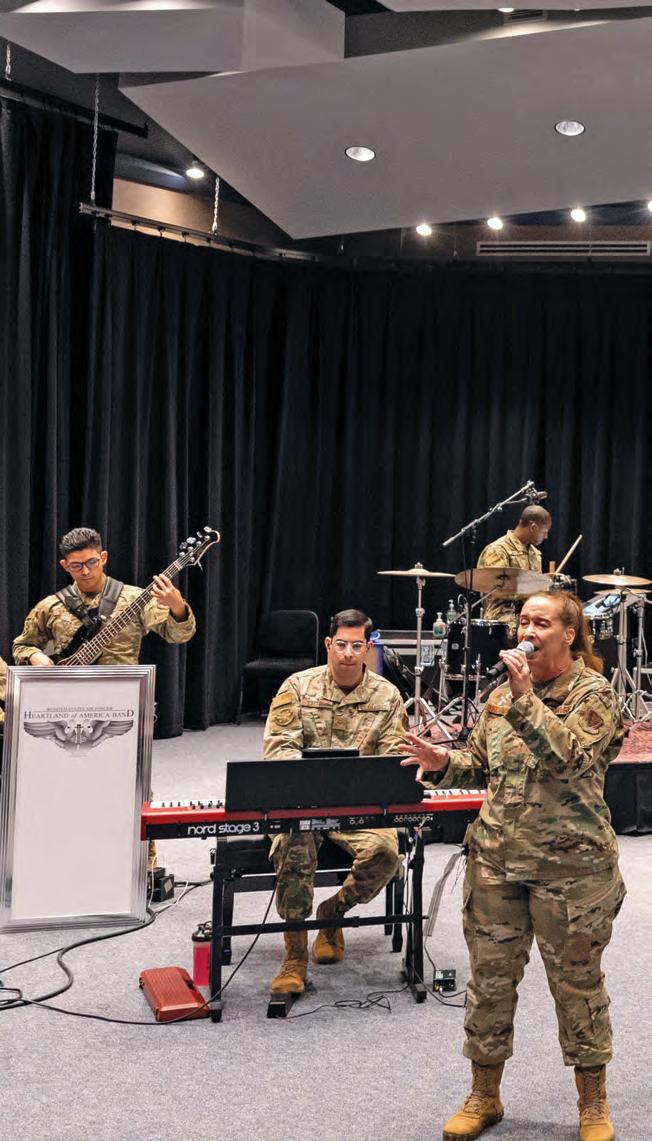
The Heartland of America Band at Offutt Air Force Base performs more than 150 concerts each year around Nebraska and for overseas troops to boost morale. ANNA REED
Omaha has emerged as a dynamic real estate powerhouse, outpacing major metros like Austin, Houston, and Charleston.
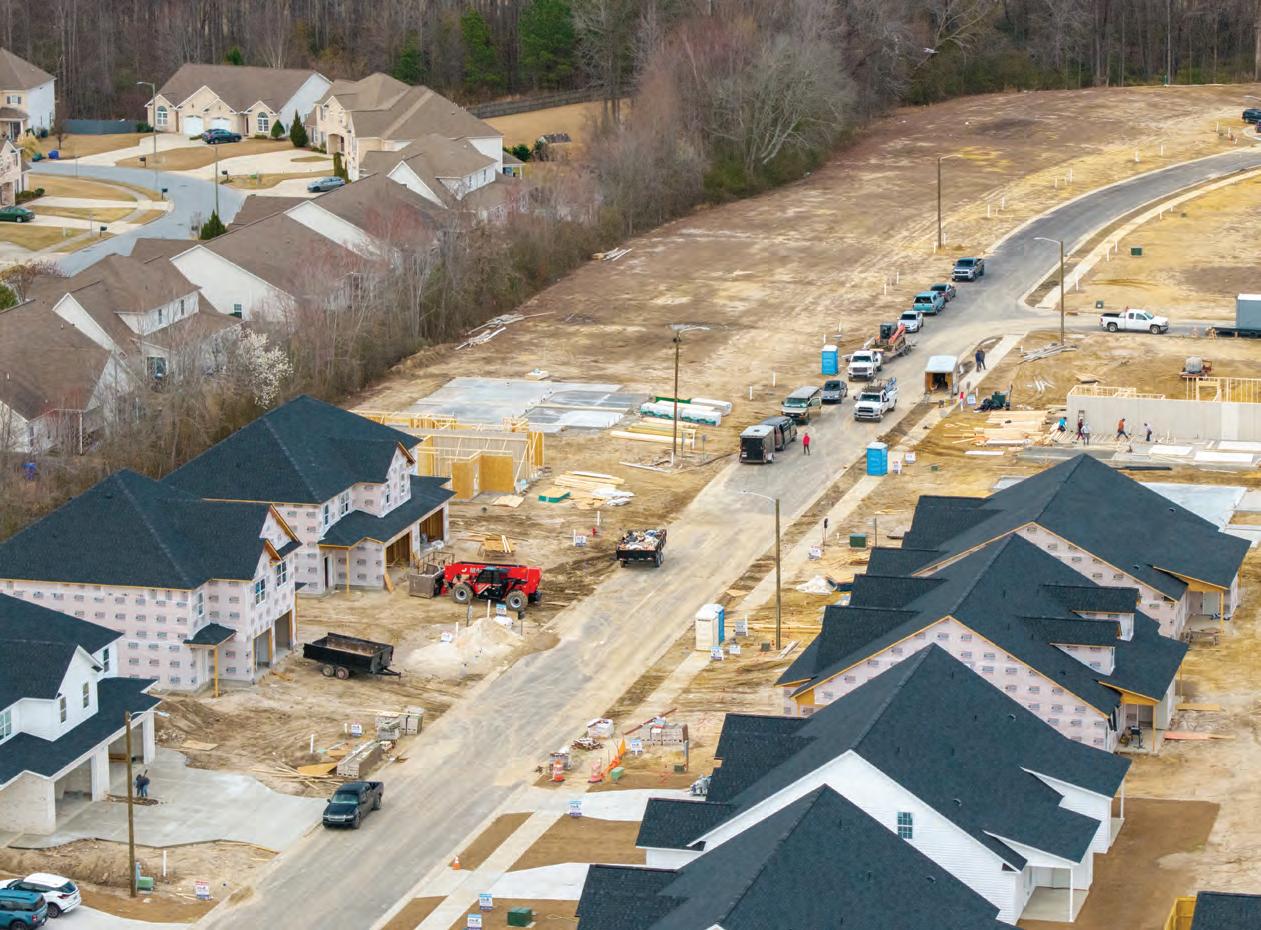
OMAHA HAS NATION’S HOTTEST HOUSING MARKET
Residents are Drawn by Lower Costs, Good Jobs, Big-City Amenities
Looking around Omaha, it is easy to see the transformation the city has made in the past decade. Experts say a large part of this progression has been Omaha’s healthy residential real estate market.
This obvious development and growth has now been recognized by a national audience. U.S. News & World Report named the Omaha metro as the hottest housing market in the country for 2025.
Once considered a “sleeper hit,” – a place that was affordable and provided a good quality of living – Omaha has emerged as a dynamic real estate powerhouse, outpacing major metros like Austin, Houston, and Charleston.
According to Omaha real estate executives, there is something fueling this surge in the city’s meteoric rise in national rankings.
“Omaha’s real estate market has remained stable if not very strong through the Great Recession and pandemic, and we’re seeing a continuation of that now,” said Andy Alloway, President/CEO of Nebraska Realty. “We’ve seen a 5-6% appreciation each year, and I don’t see that slowing down as long as inventory remains low and demand is high.”
Economic Recipe for Success
According to the magazine, Omaha scored 76.2 on its Housing Market Index, a metric that evaluates more than 50 metropolitan
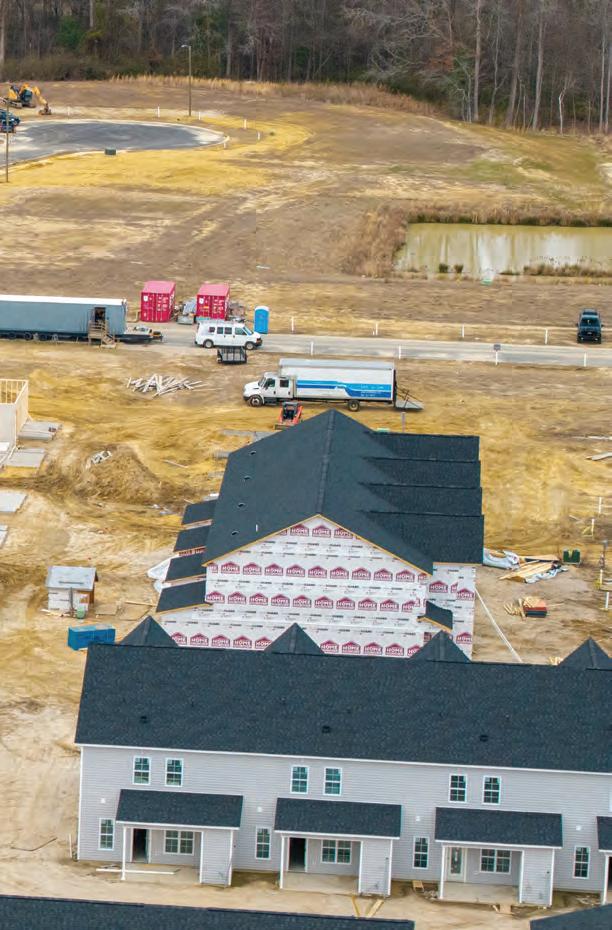
statistical areas (MSAs) based on demand, supply, financing, and resiliency. That score rose 0.7 of a point year-over-year, while the national average fell 0.8 of a point to 66.6. Second and third in the rankings are Austin (72.3) and Houston (72.1).
“When we talk with people from other markets, they often mention years of 10–20% home appreciation followed by sharp declines. That kind of volatility does not happen here,” said Susan Clark, President and Co-Owner of PJ Morgan Real Estate and President of the Nebraska Realtors Association. “Omaha’s housing market is steady, predictable, and much more stable — which is a huge advantage, especially for long-term investments.”
Omaha’s MSA offers a mix of strengths, thanks in large part to robust economic development activities, an unemployment rate lower than the overall U.S., a cost of living lower than many large metro areas, and a practical process to encourage new housing development at a lesser risk to homebuilders.
“We have something for anyone, including urban vibrancy, great suburban neighborhoods, historic neighborhoods with character and family dynamics, and recreational spaces as well,” said Heath Mello, President & CEO of Greater Omaha Chamber.
Omaha ranks No. 10 on LinkedIn’s 2025 list of the 25 fastestgrowing U.S. metros for jobs and talent.
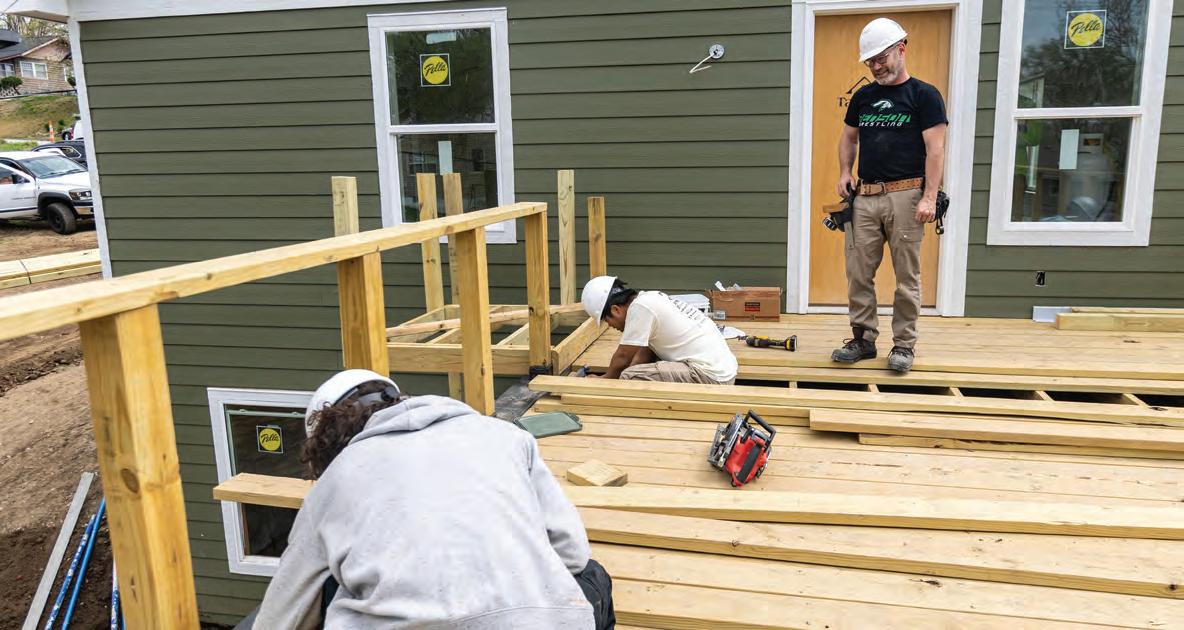
Students at Omaha Benson High School gain hands-on experience in home construction through Omaha Public Schools’ career pathway program, designed to prepare the next generation of builders. CHRIS MACHIAN
With the region having crossed over the 1 million population threshold in 2024 and jobs growing at a healthy clip, Mello is not surprised by Omaha’s top ranking.
On the economic front, he noted that besides a low unemployment rate, Omaha’s labor participation rate of nearly 67% compares favorably with a national rate of just over 62%.
The Greater Omaha Economic Development Partnership extends across eight counties with a number of employment centers and with a broad area from which to draw commuters.
“We are working to grow the economy with some strong industries with a unique employment base,” Mello said.
“This lends itself to economic resiliency, so we are not overly dependent on one industry, which makes it smoother for us versus the rest of the country.”
Relocating to Omaha
Omaha ranks No. 10 on LinkedIn’s 2025 list of the 25 fastestgrowing U.S. metros for jobs and talent. According to this study, Omaha’s economy has outpaced national growth in the key sectors of finance and insurance; health care and social assistance; and information technology.
“This is the first time Omaha has ever been named as the U.S News hottest housing market,” said Jeff Beals of NAI NP Dodge and co-owner of Grow Omaha Media. “It’s a true testament to our economy and local business community that a mid-sized, midwestern metro area can achieve such an honor.”
Greater Omaha is where longtime residents and those looking
to relocate find it such an appealing place to buy a home:
• Affordability: At the time of the ranking, Omaha’s median home price was at $304,000, down from a record high of $325,000 in mid-2024. That is significantly lower than the national median of $419,000, making it an attractive option for first-time buyers and families seeking value.
• Low unemployment: With an unemployment rate of just 2.8% compared to the national average of 4.1%, Omaha’s job market is consistent and stable.
• Sanitary and Improvement Districts: Nebraska’s unique SID law allows developers to fund infrastructure outside city limits through bonds and special assessments. This reduces risk and accelerates new housing development.
• Big-city amenities, small-town costs: Omaha offers a wide range of cultural, dining, and shopping experiences without the sticker shock of coastal cities.
• Doing energy differently: Omaha has the unique advantage as the nation’s only all-public power state. Omaha’s robust utility infrastructure is built to support growth, providing businesses with reliable and scalable energy, water and gas services.
Omaha’s real estate market is not just hot – it allows for every kind of taste in a home. From historic homes in the Old Market to new builds in suburbs like Elkhorn, Gretna, and Bennington to a growing market for homes and condos in and near a flourishing downtown, the city offers something for every lifestyle

and budget. Prices and demand continue to remain strong in surrounding communities Fremont, Ashland, Springfield, Louisville, and Blair, which makes the overall market strong.
According to U.S. News, home values increased 2.5% over the previous year. Homes purchased in 2019 have appreciated by about 60%, showing strong long-term investment potential.
“We are seeing a growing trend where homeowners are not selling their previous homes when they move into a new one — they are holding onto them,” said Clark. “That shows real confidence in the market. People recognize Omaha housing as a strong investment, and with the equity many families now have, it’s a powerful asset to build long-term financial security.”
With supply-chain issues during and after the pandemic improving and costs for materials leveling off, the number of new and existing homes for sale is increasing, offering more options for buyers.
A Strong Market
“We saw building new homes increase as interest rates decreased and costs for supplies and materials continued to drop,” Alloway said. “Even during the tough times after COVID, Omaha never saw prices drop – we just saw the increase in home costs go down.
“Omaha continues to have a healthy market because of our conservative nature and approach. I don’t see that changing as long as inventory and demand remain strong.”

A strong sense of quality-of-life factors into Omaha’s strong housing position. According to Forbes, Omaha was the best city in the entire nation to move to in 2024. “A big driver of people moving to Omaha is jobs, but perhaps just as often, it is lifestyle,” said Clark.
Omaha is not seeing any signs that the housing market is cooling – especially in the $250,000 and below market. And with its blend of affordability, economic vitality, and community-driven development, Omaha is poised to remain a top destination for homebuyers and investors alike.
This recognition as the nation’s hottest housing market is not a fleeting headline — it is the culmination of years of steady growth, thoughtful planning, and a deep commitment to quality of life. As new residents arrive and longtime locals reinvest, the city’s confidence in its future is clear: Omaha is not only a great place to buy a home — it is a place to build a life.
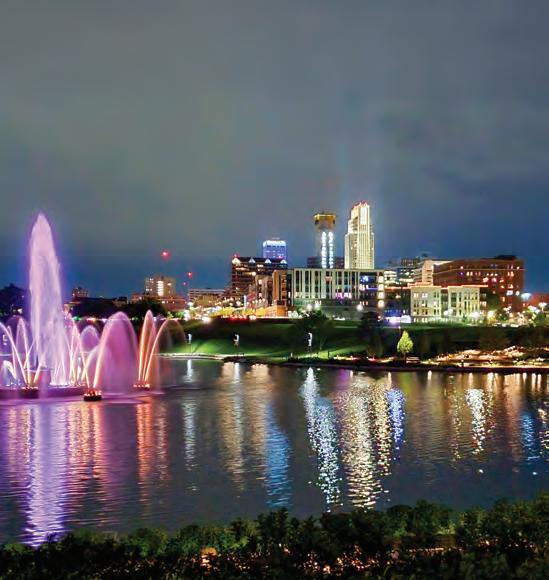
Omaha is a great place because we have great educational systems that prepare our people to be great employees and great partners with the business community.
– Omaha Mayor John Ewing
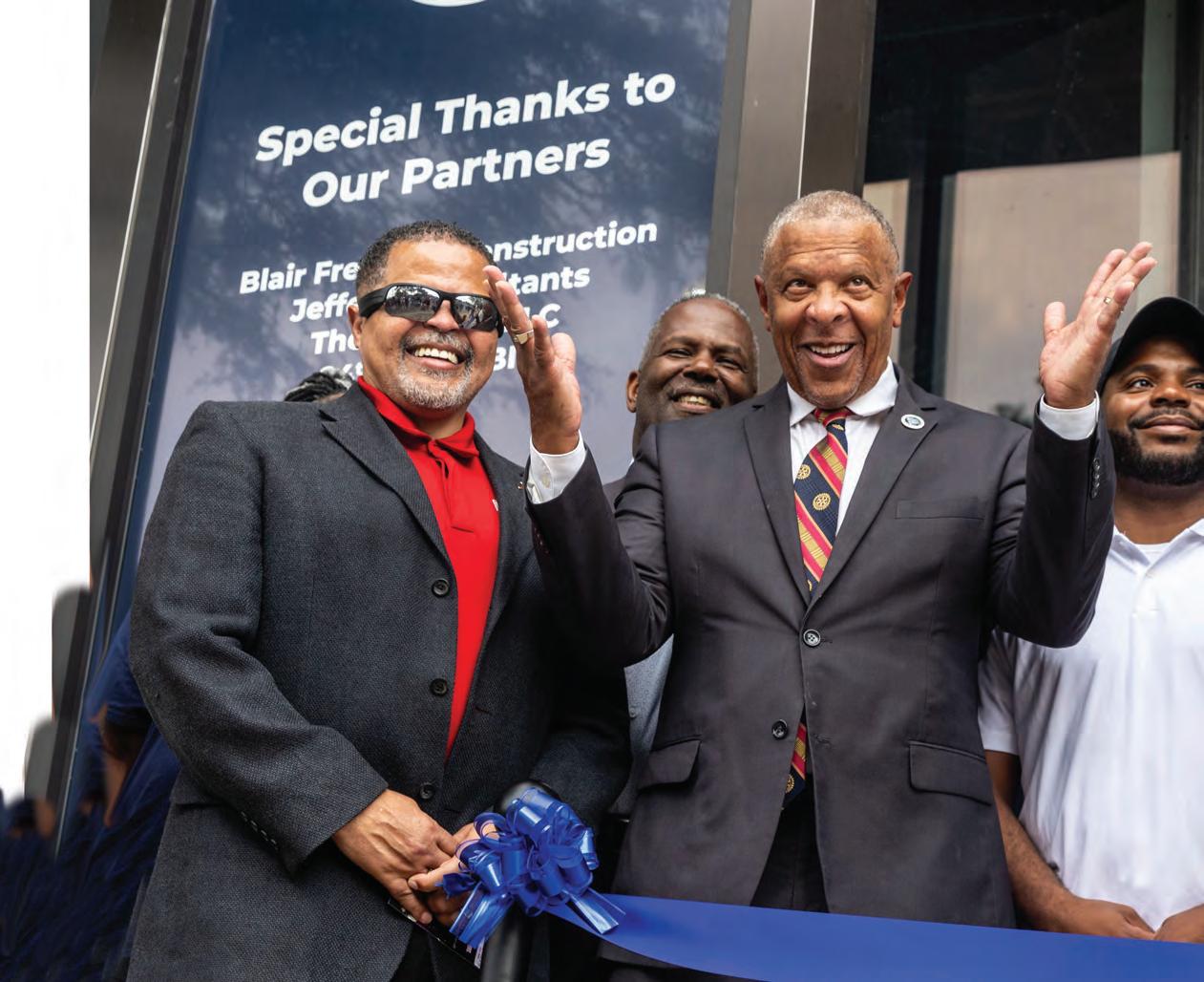
Transitions in Omaha
NEW MAYOR EAGER TO TELL OMAHA’S STORY
Ewing Says a Can-Do Attitude is One of the City’s Greatest Strengths
John Ewing, Omaha’s new mayor, has a message for its citizens – and those who are looking to join them: You belong here. “We need to make sure everyone understands they belong and have a place here.”
“What I want every member of our community to understand is that we are creating a city where everyone has an opportunity to reach their fullest potential based on the content of their character and the work ethic they bring to all they do,” said Ewing, who was sworn in as Omaha’s 52nd mayor in June.
It’s now his job to tell Omaha’s story, he said, and he does not have to be asked twice. “We have to tell our story and tell others how great we are in order to continue to grow and prosper.” Don’t be surprised if “great” is a favorite adjective the mayor uses when describing Omaha and its people.
Ask him what makes Omaha stand out among its peer communities throughout the United States, and he lists
the ways. “No. 1 – that can-do attitude. No. 2 is that great investment the philanthropic community makes in the quality of life for the people of this community.”
He is just getting started. “Another thing that stands out is the public-private partnerships we have in Omaha. They allow us to be able to make investments that impact the quality of life for the people of Omaha.”
One more: “We also are fortunate of having great city employees who do a good job of providing for our basic needs and services.”
All these qualities, he said, do not go unnoticed, which is why Omaha routinely is included on lists of best places to locate, live, and prosper. He talks about the community’s low crime rate, its stellar public schools systems, and the post-secondary education institutions found in Omaha.
“Our people and their willingness to come together when we need to address issues that face our community are what make Omaha a great place to live.”
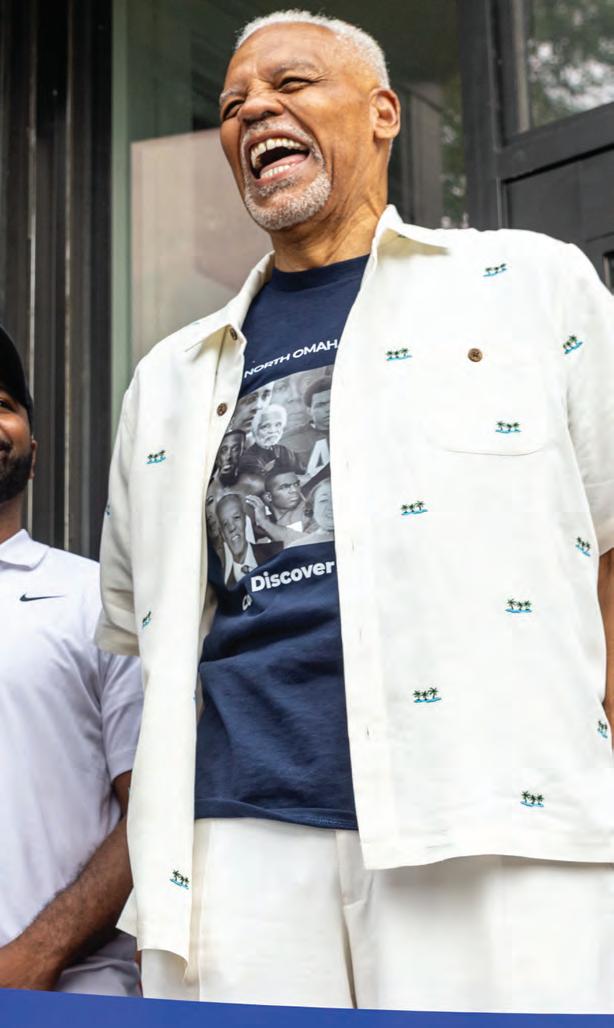
If Omaha’s mayor sounds like he knows his community – and is its No. 1 fan – that is because he is. Ewing and his wife, Viv, chose to call Omaha – where they both were born and raised – home when they married in 1984. “We decided as we got married that we would make Omaha the place that we would live, raise our children, and build a life together.”
And they did. Ewing served 25 years in the Omaha Police Department, retiring in 2006 with the rank of deputy chief. He then served 18 years as Douglas County treasurer. Viv Ewing, who earned her master’s degree from the University of Nebraska at Omaha and her doctoral degree from the University of Nebraska-Lincoln, worked as a human resources executive for the Omaha Public Power District and Conagra Brands before serving as a community volunteer.
that career path. He turned his focus to public service. “I had a lot of people who inspired me, starting with my parents, followed by relatives, certainly my teachers, principals and so many others in our educational system. Because of them I place such a high value on partnerships.”
Ewing’s short-term to-do list starts with taking recommendations from the mayor’s many task forces and transition them into implementation. Issues to tackle include increasing affordable housing, reducing poverty, and boosting economic development.
Long-term priorities, he said, center on attracting companies to launch in or relocate to Omaha, and to retain those already in place. “We want to grow our economy and make Omaha even more enticing for young professionals, and that starts with entertainment options, continuing to make housing more affordable, and improving public transportation.”
After just months on the job, Ewing said he has been surprised by the level of excitement and anticipation he sees in Omaha’s citizens. “They’re excited about the possibilities that exist for Omaha to be even better than we’ve ever been. A lot of people believe Omaha is a great city, but you can never rest on your laurels. You can never be satisfied.”
Ewing says he can tell Omaha’s story in fewer than 30 words: “Omaha is a great place because we have great educational systems that prepare our people to be great employees and great partners with the business community.”
It’s a great story to tell.

Together, they called Omaha home and decided the time was right to make his run for Omaha’s top job. Ewing, who is Omaha’s first Black mayor, defeated Jean Stothert, who served three terms and was the city’s first female chief executive. As a business major at UNO, Ewing said, he aspired to follow
From left, Eric Ewing, Omaha Mayor John Ewing, State Sen. Terrell McKinney of Omaha, and Preston Love Jr. take part in the ribbon cutting for the North Omaha Visitors Center. CHRIS MACHIAN
MANY OPPORTUNITIES TO VIBE IN GREATER OMAHA
Greater Omaha has moved far past its origins as a series of small towns along the Missouri River. Our region is now a hotbed for artisans and performers. We not only make art but we protect and perform it. We are the place where residents and visitors from across the globe flock together for events, celebrations, games, concerts, museums, art, and much more. We are constantly evolving – as well as keeping our traditions strong – to ensure that Greater Omaha is the place to be.
We are Greater Omaha – and we vibe!
Performing Arts
Galleries
Museums & Attractions
Sporting Events
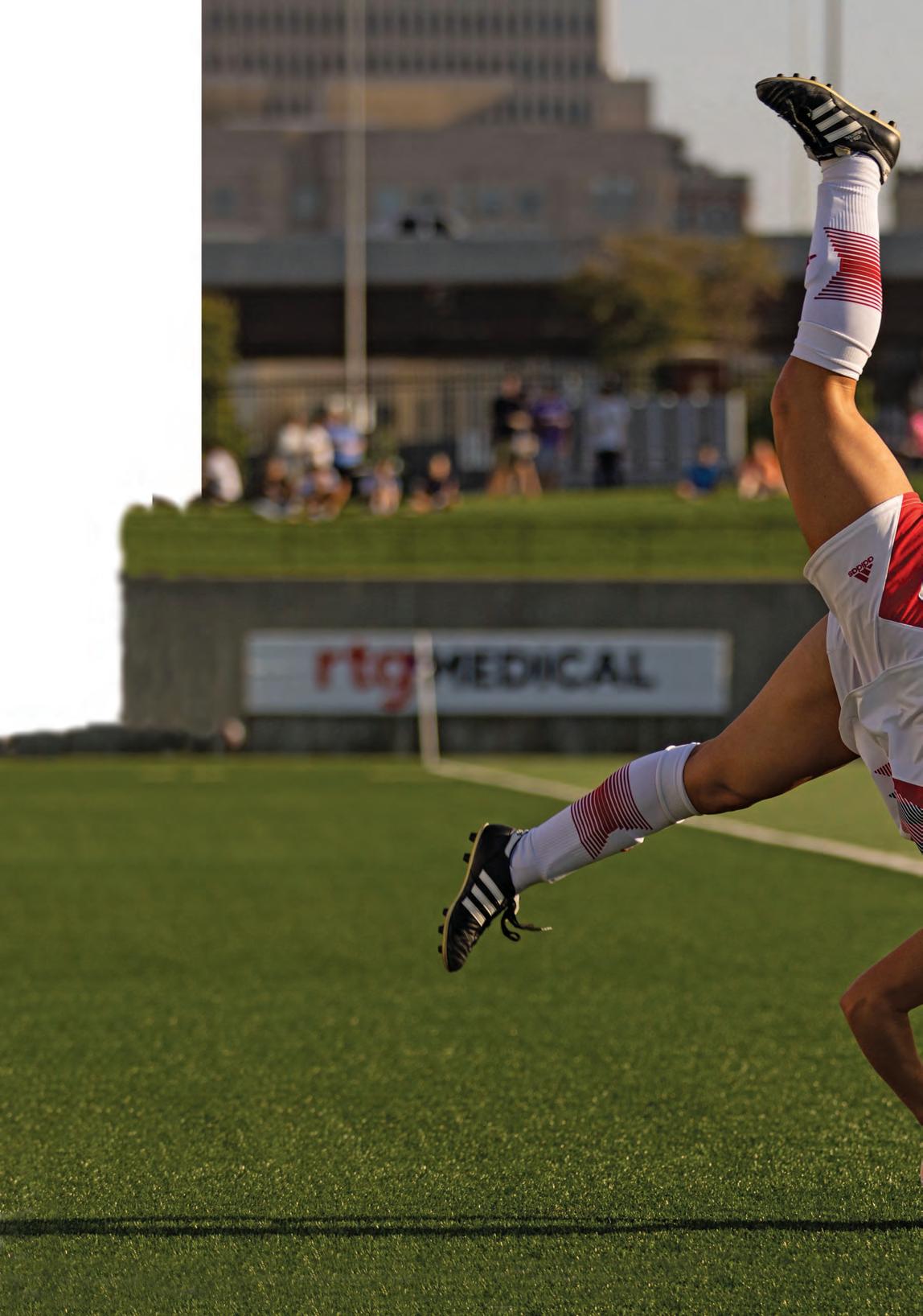
Nebraska’s midfielder Jordan Zade delivers an acrobatic flip-bomb during the Nebraska vs. Creighton women’s soccer match. ANNA REED
WE VIBE.


Eddie Money performs in front of thousands at the free summer concert at Memorial Park. BRENDAN SULLIVAN
Food lovers celebrate and enjoy the great restaurants and entertainment at the Heartland of America Park during the Taste of Omaha.

Live & Alive: Greater Omaha
Moves With a Pulse of Creativity
To “vibe” in Greater Omaha is to slip into a rhythm that balances Midwest charm with a surprising pulse of creativity. In Omaha, we vibe when we attend a Creighton game or Omaha Supernovas volleyball match at the CHI Health Center, College World Series game at Schwab Field, or baseball game at Werner Park. We vibe when we admire and interact with an exhibit at the Omaha Children’s Museum, The Joslyn, Hot Shops, Union for Contemporary Art, or Luminarium. We vibe when we attend and rejoice in a performance at the Orpheum, Steelhouse, Bluebarn Theatre, or Gene Leahy Mall Performance Pavilion.
Live Music & Local Grooves
The Slowdown (North Downtown Omaha), The Waiting Room (Benson), The Astro (La Vista), Barnato (Village Pointe), and Stir Cove (Council Bluffs) are among many great places to catch a band while sipping on a Nebraska-brewed IPA. We also can’t forget the annual Maha Music Festival, which celebrates a variety of genres while fostering a sense of community among music lovers.
The crowds aren’t just there for the music; it’s communal, open, and laid-back, swaying in sync with the beat. A warm Thursday night in the summer, lights dimmed low, and the crowd echoing back lyrics. They’re not just hearing the music – they’re living it!
Coffee Shop Culture
Pop into Archetype Coffee or Harvest Moon, and you’ll see
that vibing in Greater Omaha can also mean diving deep into conversations over pour-over hot and cold drinks. These spots hum with soft jazz, the flick of laptops, and quiet energy.
The vibe is intellectual but approachable, like a book club that decided to meet at a candlelit café instead of someone’s living room. There’s art on the walls and sketches in the margins of notebooks. Creativity drips from every corner.
Nature as Sanctuary
If the city buzz gets too loud, vibing can shift to the outdoors. Strolling through Heartland of America Park or hitting the trails at Chalco Hills encourages activity and allows space to breathe.
Watching the fountains dance at sunset while geese coast across the lake – that’s Greater Omaha’s slow beat at work. It’s reflective, grounding, and ideal for people who find rhythm in solitude.
Art & Neighborhood Energy
Head to Benson or the Old Market district for the eclectic vibe. Murals sprawl across brick walls, boutiques sell handcrafted jewelry, and locals gather on patios to sip drinks and peoplewatch. First Fridays – monthly art walks – turn the sidewalks into pop-up galleries.
You don’t rush through; you stroll, chat with artists, and maybe leave with a piece that makes you think.
In Greater Omaha, to vibe is to belong without needing to fit in. It’s the feeling of being exactly where you need to be – whether that’s lost in a melody, immersed in a canvas, or simply breathing in the prairie air. It’s subtle, sincere, and effortlessly cool.
LIZ RYMAREV

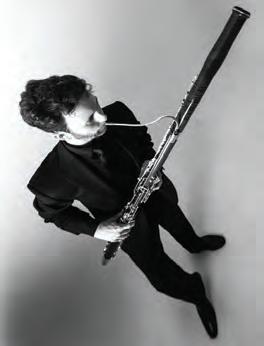

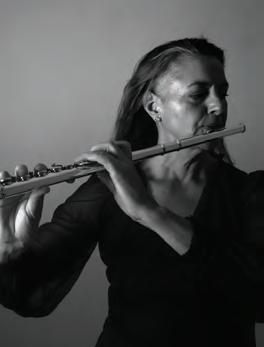
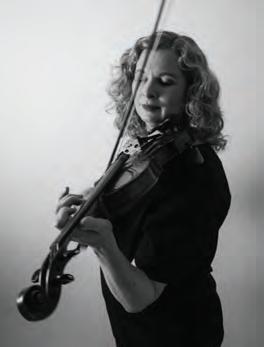
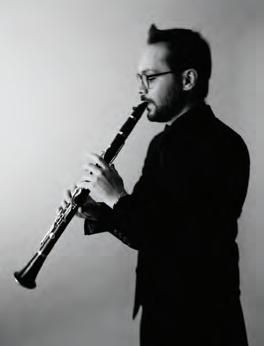
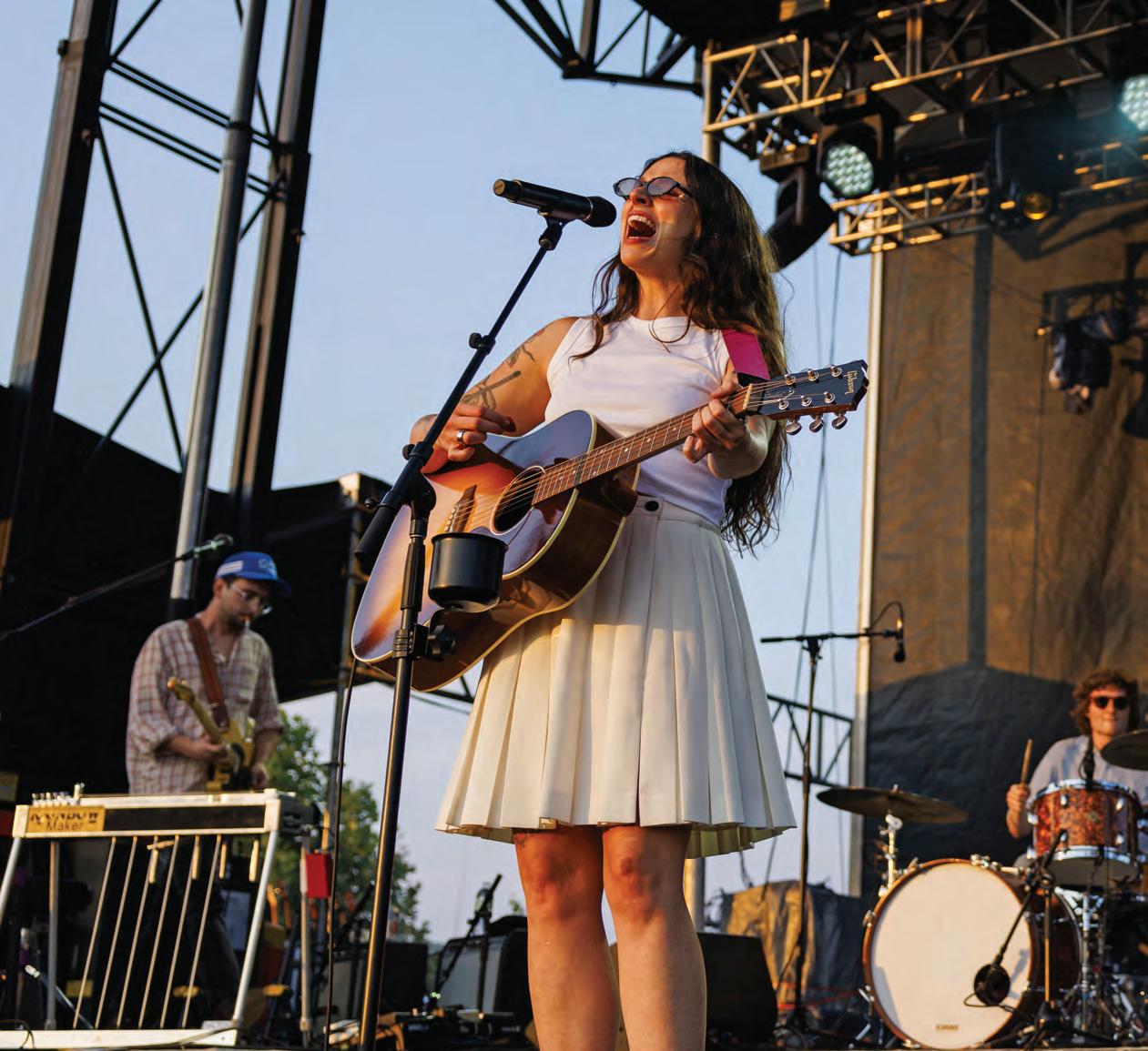
OMAHA PERFORMING ARTS:
Shaping the Future of Downtown Culture
Steelhouse meets audiences where they are; Tenaska Center for Arts Engagement will do the same
Joan Squires, president of Omaha Performing Arts, views the Holland Performing Arts Center, Steelhouse Omaha, and the forthcoming Tenaska Center for Arts Engagement – collectively known as the Dick & Mary Holland Campus – as catalysts to connect and educate.
Each offers an opportunity to meet the interests, needs, and wants of different audiences and demographics. When you add the historic Orpheum Theater a few blocks away to the equation, there really is not an audience left untouched.
“We’re known by performing arts colleagues across the country for what we have built here in Omaha,” Squires said. “They
can’t believe we have so many outstanding venues for different types of performances and educational access.
“When we designed the Holland and Steelhouse, and now the Tenaska Center, we always made sure to address the artists’ needs as well as those of the patrons. I think it’s one of the reasons we can present so many great performances every year.”
Although the Holland has been entertaining the Omaha community for two decades, Steelhouse and the Tenaska Center, which is slated to open March 2026, are recent additions. Together, these two venues fill gaps by expanding
an American indie
project performs
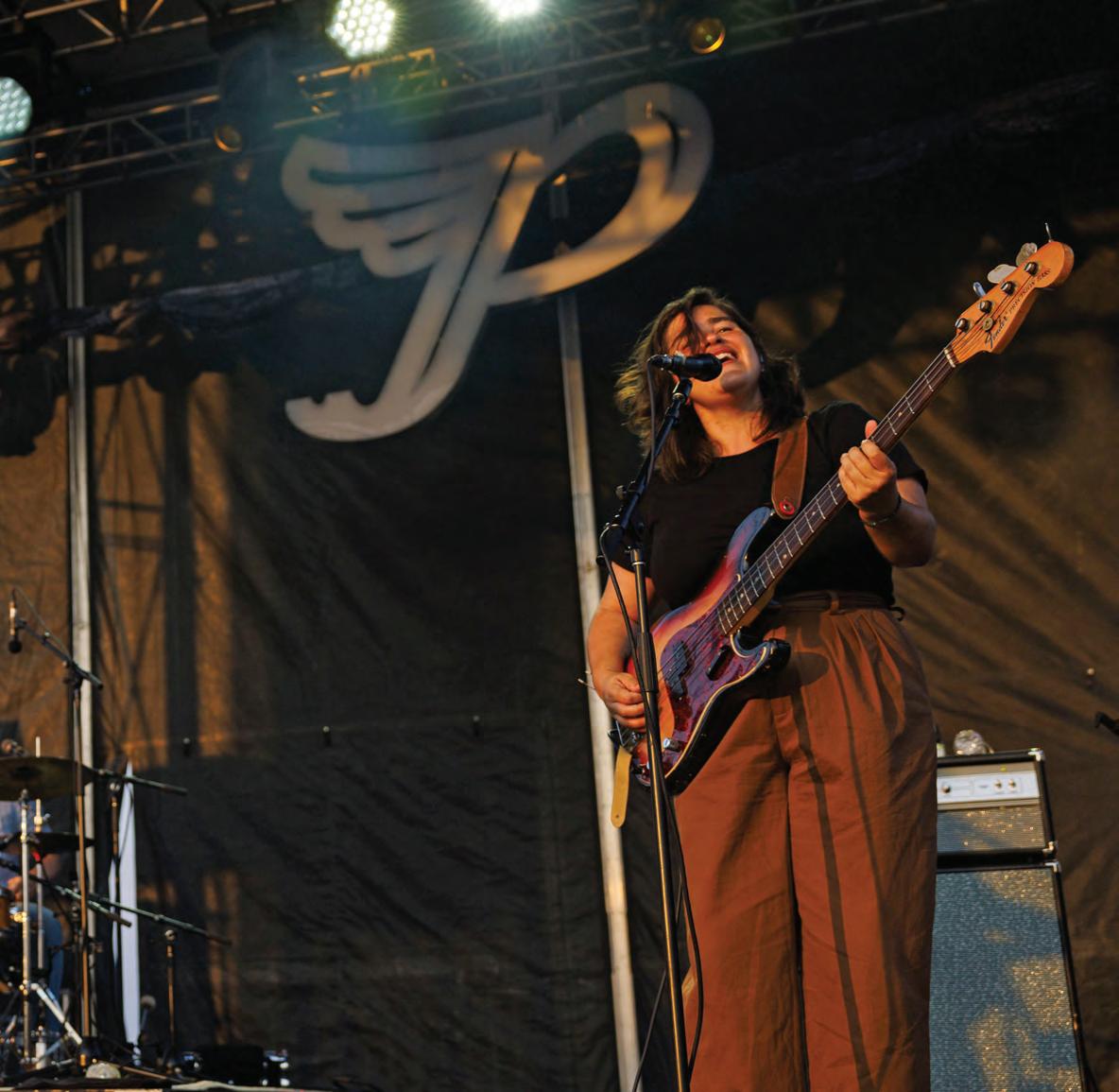
genre diversity beyond classical, opera, dance, and Broadway –creating immersive, informal environments that are targeted to newcomers of all ages.
They offer entry points for both fans and future artists, from concertgoers to camp participants, while building community and career pathways.
The Orpheum and Holland remain vital cultural anchors, but Steelhouse and the Tenaska Center are also meeting younger audiences where they are – in sound, style, and spirit.
“We’ve had great venues for what some people might call ‘more traditional audiences’ at the Orpheum and even the Holland, but Steelhouse is bringing in bands that skipped over Omaha in the past, and the Tenaska Center is engaging
with young people and the community in an educational environment created with them in mind,” Squires said.
Engaging Young Artists
The $108 million Tenaska Center for Arts Engagement broke ground in 2023 and is poised to become a transformative force in Omaha’s cultural landscape when it opens in March 2026. The center is named in recognition of a principal gift from Omaha-based Tenaska, a stable and reliable leader in the energy industry that is committed to the communities where they do business.
The four-story, 103,000-square-foot building is unlike its sister venues, which focus primarily on performances, as the Tenaska Center is dedicated entirely to education, rehearsals, and
Waxahatchee,
music
during Maha Festival at Heartland of America Park. MEGAN NIELSEN

community engagement, along with a 500-person capacity event hall. It houses state-of-the-art rehearsal halls, classrooms, and flexible event spaces designed to support a wide range of programs – from early childhood arts education to professionallevel training in music, dance, theater, and technical production. It is also capable of hosting large community and private events in a dedicated event space.
This center addresses a long-standing need for space. Omaha Performing Arts’ educational programs already reach over 100,000 students, teachers, and community members from across Nebraska annually, but limited facilities have forced them to host workshops in stairwells and lobbies. The Tenaska Center fills this gap by offering a permanent, purpose-built home for these initiatives – allowing them to expand in both frequency and scope.
“This is not just a building – it’s a critical venue for growth and experiences,” Squires said.
Programs like Broadway Day Camp, Jazz Ensemble, dance workshops and master classes with visiting artists will now have room to flourish year-round. In addition to expanding current offerings, the Tenaska Center will introduce new programs designed to reflect the different interests of the community.
Complementing the Campus
Steelhouse Omaha has quickly become a game changer in the city’s arts and entertainment scene. Opened in 2023, this sleek, industrial-inspired facility was designed to fill a critical gap in Omaha’s cultural infrastructure: a midsize concert venue.
With a flexible audience capacity of 1,500 to 3,000, Steelhouse has already proven itself as a magnet for national talent and
a hub for high-energy performances from artists like All Time Low, Lord Huron, Duran Duran and Counting Crows. It’s a place where fans can stand, dance, and immerse themselves in the show – something the more traditional venues don’t offer.
Its arrival has also diversified Omaha’s entertainment offerings. While the Holland Performing Arts Center focuses on classical music, jazz, and popular music, and the Orpheum Theater hosts Broadway tours, opera and dance, Steelhouse leans into contemporary music and pop culture along with comedians.
Fans and artists have praised the acoustics, layout, and ease of access, with multiple bars and restrooms making the experience

smooth and enjoyable. The venue’s design – flat floor, balcony seating, and industrial aesthetic – creates an immersive environment that feels both modern and intimate.
A Cultural Catalyst
Steelhouse is not just a concert venue – it is an impetus for growth. Through an exclusive partnership with Live Nation, a live entertainment company, the venue brings in a steady stream of high-profile performers.
Among them have been rock legends, country and indie favorites like Jack White and Flatwater Calvary; hip-hop artists like Bryson Tiller and Ken Carson; comedians like Matt Rife and Kathleen Madigan; and EDM shows, including Marc Rebillet.
“Together, these venues form a synergistic campus where a jazz legend might perform at the Holland, a Broadway show dazzles at the Orpheum, a rock concert electrifies Steelhouse, and a dance camp unfolds at the Tenaska Center for Arts Engagement – all simultaneously,” Squires said.
All of these venues contribute to Omaha’s quality of life, helping to attract and retain the workforce. Omaha Performing Arts’ annual economic impact prior to the Tenaska Center is over $61 million, and these investments activate and connect the many other significant downtown investments including the Riverfront Revitalization, CHI Omaha, Charles Schwab Field, the Kiewit Luminarium and more. Squires added: “We know the Holland Campus along with the Orpheum help make this a more vibrant and attractive community for all.”
Cast members perform during a dress rehearsal for “Titanic the Musical” at the Omaha Community Playhouse. MEGAN NIELSEN

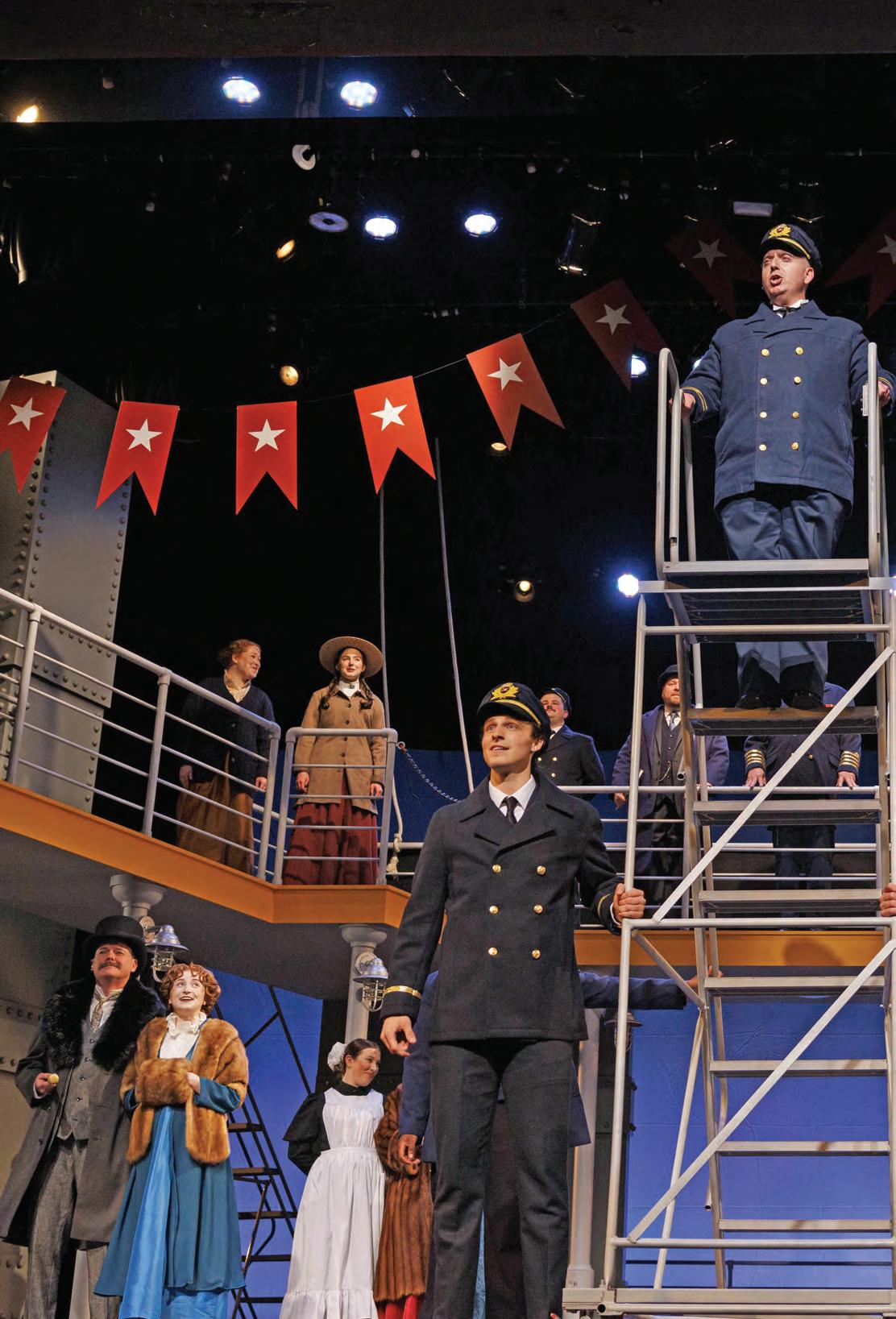
POWERFUL SENSE OF COMMUNITY CONNECTS OMAHA ARTS SCENE
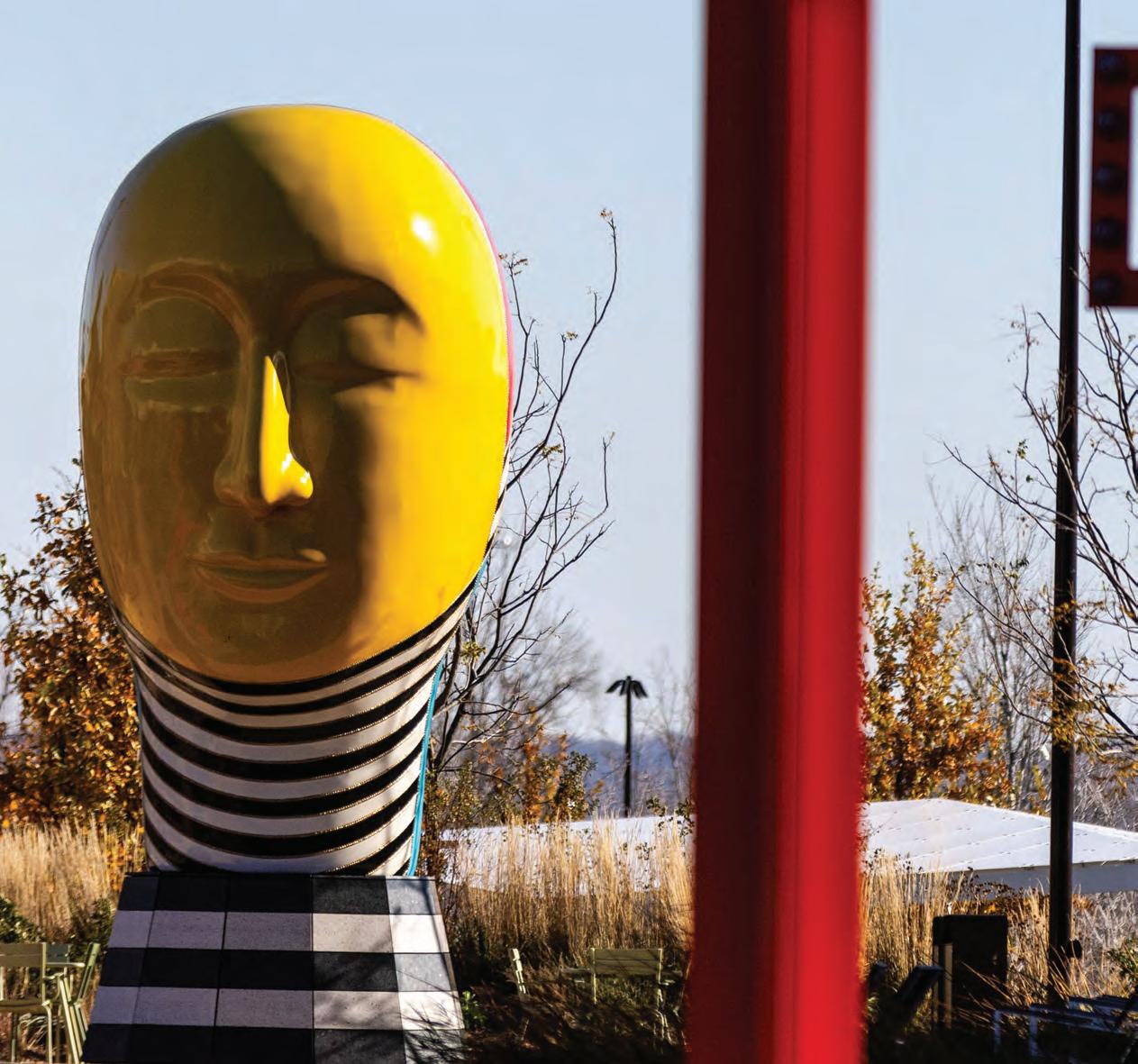
Lakesha Green, executive director of the Union for Contemporary Art, relishes the fact that the Omaha arts scene is dynamic and evolving.
For her and the artists at the nonprofit arts center, there’s a powerful sense of community – from established institutions to grassroots collectives.
“We’re seeing more cross-disciplinary collaboration, more representation of historically excluded voices, and more spaces that make art accessible to broader audiences,” she said.
The arts center’s experience is definitely not unique. Reaching back to the founding of the Bemis Center for Contemporary Arts in 1981, Omaha has had a rich history of supporting
artists and fostering creativity through its residency programs, exhibitions, and public programs.
“Art has the unique ability to create empathy, build bridges, and reframe narratives,” Green said. “In Omaha, we’ve seen how creative expression can shift perspectives, spark critical conversations, and even influence public policy or neighborhood revitalization.”
The Omaha arts vibe
Along with the Bemis, the Union for Contemporary Art joins other mainstay galleries like Hot Shops, The Joslyn, and KANEKO as part of a vibrant arts community. Many places are
Omaha’s art scene works to not only create beauty but also change. Art connects, builds empathy, teaches people to see the world from different perspectives, and fosters resilience through the challenges of the creative process.

situated just miles apart – and their exhibits, classes, and events draw crowds.
Omaha’s arts scene is a vibrant tapestry of creativity, collaboration, and community – where historic architecture meets cutting-edge expression. Whether you’re into contemporary installations, fiery glasswork, or classical masterpieces, the city offers a rich palette of experiences.
Omaha’s artistic heartbeat offers a variety of art, including painting and drawing, photography, sculpture and 3D art, photography, glass and metalwork, textile and fiber art, conceptual and contemporary installations, printmaking and collage.
Hot Shops Art Center
Omaha’s original art factory and largest artist collective – 26 years and counting – Hot Shops is a living museum with over 100 artists working across three floors. It boasts four “hot” studios – glassblowing, pottery, bronze casting, and blacksmithing – over 92,000 square feet.
The collective has open studios where visitors can watch artists create in real time, resulting in rotating exhibits and hands-on workshops.
“Hot Shops Art Center is Omaha’s largest artist collective and home to masters of the ‘fiery arts,’” said Executive Director Kim Sellmeyer. “We are the place to find local artists and to come if
you want to blow glass, watch bronze being poured, or even try your hand at molding and casting your own bronze sculpture.”
Sellmeyer said Hot Shops keeps the “rare, hands-on art forms” alive and accessible.
“Nearly every major visual arts venue in Omaha is free to enter, and many offer scholarships or grants for classes, ensuring that cost isn’t a barrier,” she said. “It’s a rich, collaborative, and welcoming ecosystem.”
Bemis Center for Contemporary Arts
A nationally recognized hub for contemporary art and artist residencies, this edgy, experimental gallery and studio is deeply rooted in community engagement. Its live/work residency program for artists from around the world provides first-hand exhibitions that challenge norms and spark dialogue. The Bemis also provides lectures, performances, and open studios.
Joslyn Art Museum
Omaha’s flagship art museum housed in a stunning Art Deco building with a recent award-winning expansion, it has more than 11,000 works including Monet, Renoir, Pollock, and Native American art. General admission is free.
Passageway Gallery
A cozy, artist-run gallery in the Old Market, it highlights local artists showcasing photography, painting, sculpture, and more in a charming setting tucked into a historic passageway.
The Union for Contemporary Art
Focusing on socially engaged contemporary art, the Union for Contemporary Art is rooted in activism, identity, and community storytelling. The arts center, located in North Omaha, includes a gallery, a workshop, and performing arts spaces.
The Wanda D. Ewing Gallery showcases work by women artists of the African diaspora, continuing Ewing’s legacy of challenging visual culture norms.
Whether it’s through its artist fellowship, community garden, youth engagement programs, or exhibitions, the center fosters both individual growth and collective action.
“At The Union, our mission is rooted in the belief that art and social justice go hand in hand,” Green said. “We work to uplift
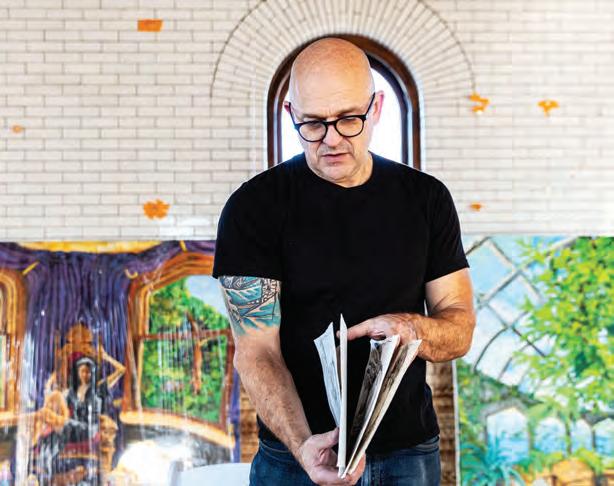
Dan Toberer of Hot Shops Art Center, throws and shapes a pot on the wheel during the Omaha Summer Arts Festival in Aksarben.
EILEEN T. MESLAR
the creative voices of North Omaha while making sure that the arts remain a powerful tool for community development and healing.’’
Gallery 1516
A contemporary space supporting Nebraska and regional artists, it offers traveling exhibitions and musical performances as well as collaborations with universities and cultural institutions.

Old Market Artists Gallery
A collective gallery in the heart of the Old Market, it offers rotating exhibits from member artists with a mix of mediums, including ceramics, fiber, and mixed media.
KANEKO
Founded by internationally acclaimed artist Jun Kaneko, KANEKO explores large-scale ceramic sculpture, abstract forms, and experimental installations. Kaneko’s signature works include dangos – massive, hand-built ceramic pieces with bold patterns like polka dots, stripes, and zigzags. KANEKO hosts exhibitions, performances, lectures, and educational programs.
Watie White prepares to hang the portraits he drew for an exhibit inside the carriage house at the Joslyn Castle. CHRIS MACHIAN
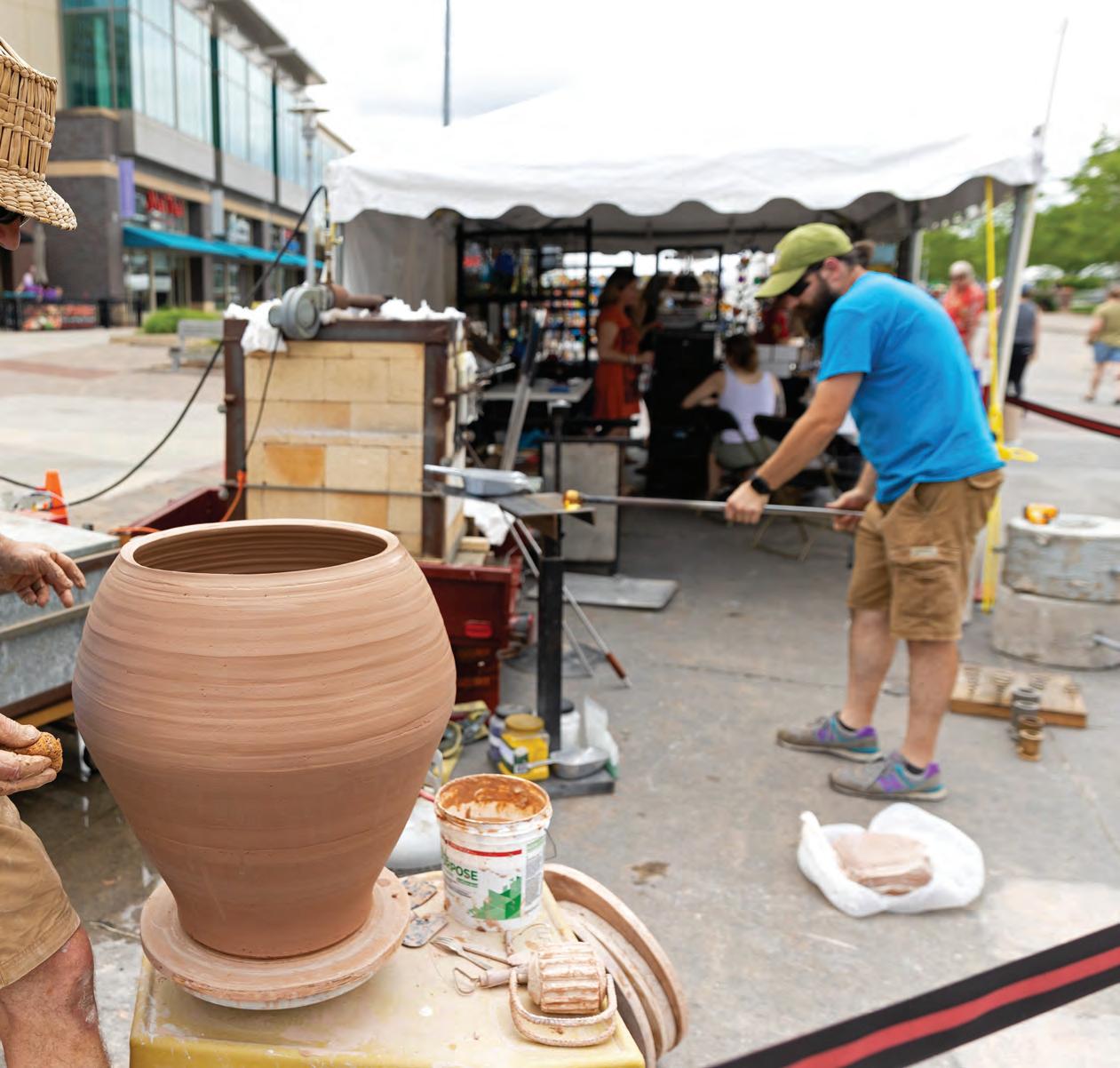
Art connects us
Omaha’s art scene works to not only create beauty but also change. Art connects, builds empathy, teaches people to see the world from different perspectives, and fosters resilience through the challenges of the creative process.
“The visual arts scene in Omaha is diverse, accessible, and constantly evolving,” Sellmeyer said. “There truly is something here for everyone, thanks to the dedication of so many arts organizations.”
“A scene like this doesn’t just enrich residents’ lives – it’s a major draw for the creative class, the innovators and problem-solvers who choose where to live based on cultural vibrancy as much as economic opportunity. Omaha’s arts scene is a cornerstone of that appeal.”
Since its grand reopening in September 2024, The Joslyn has emerged not just as a revitalized cultural landmark but also as a national model for how museums can reimagine their role in the 21st century.
Following a $100 million renovation and expansion with the transformative Rhonda & Howard Hawks Pavilion, the museum has been met with widespread acclaim from critics, visitors, and the art world at large – and it’s been a welcomed boon.
Floating above granite garden walls and wrapped in pink aggregate panels that echo the museum’s original Georgia Pink marble, the pavilion has been praised for its “cloud-like form” and seamless integration with the historic 1931 Art Deco building and the 1994 Norman Foster-designed Scott Pavilion.
“The public reception has been terrific,” said Executive Director & CEO Jack Becker. In the first 10 months after reopening, the museum welcomed more than 215,000 visitors. “Looking at calendar year attendance, 2025 is on pace to be one of the best years in the Museum’s history.”
The Joslyn has recently received an array of local, regional, and national awards and honors across architecture, sustainability, and cultural impact. Among the most notable are:
• World’s Most Beautiful Museums, Prix Versailles
• National Recognition Award, American Council of Engineering Companies
• Grand Award, American Council of Engineering Companies Nebraska
• Best Art Museums, USA Today 10 Best Readers’ Choice Awards
• Best of the Midwest Travel Award, Midwest Living Magazine
• Finalist/Top Attraction (Douglas County), Omaha Metropolitan Area Tourism Awards
• Headliner of the Year, Greater Omaha Chamber of Commerce
• Laurels Award for People-Centered Design, Omaha by Design
• LEED Gold certification for the Hawks Pavilion as a model for sustainable museum architecture
These honors reflect not only the architectural brilliance of the Snøhetta-led expansion but also Joslyn’s growing role as a cultural and civic landmark in the Midwest and beyond.
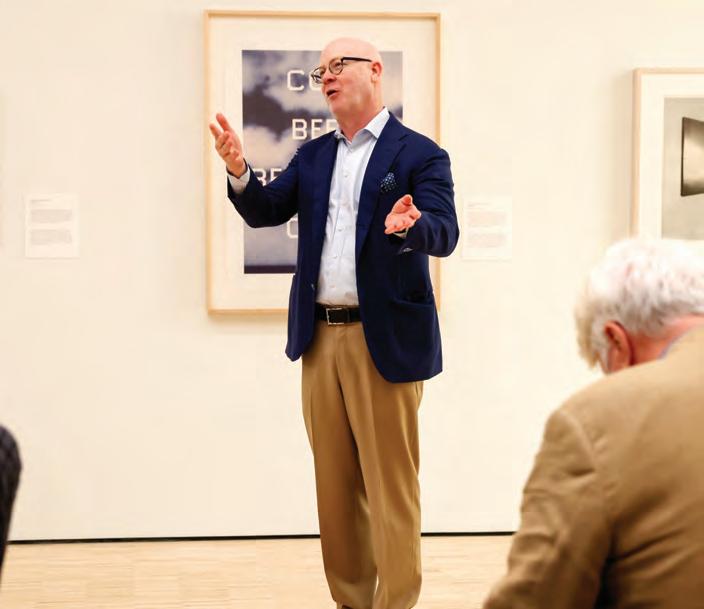
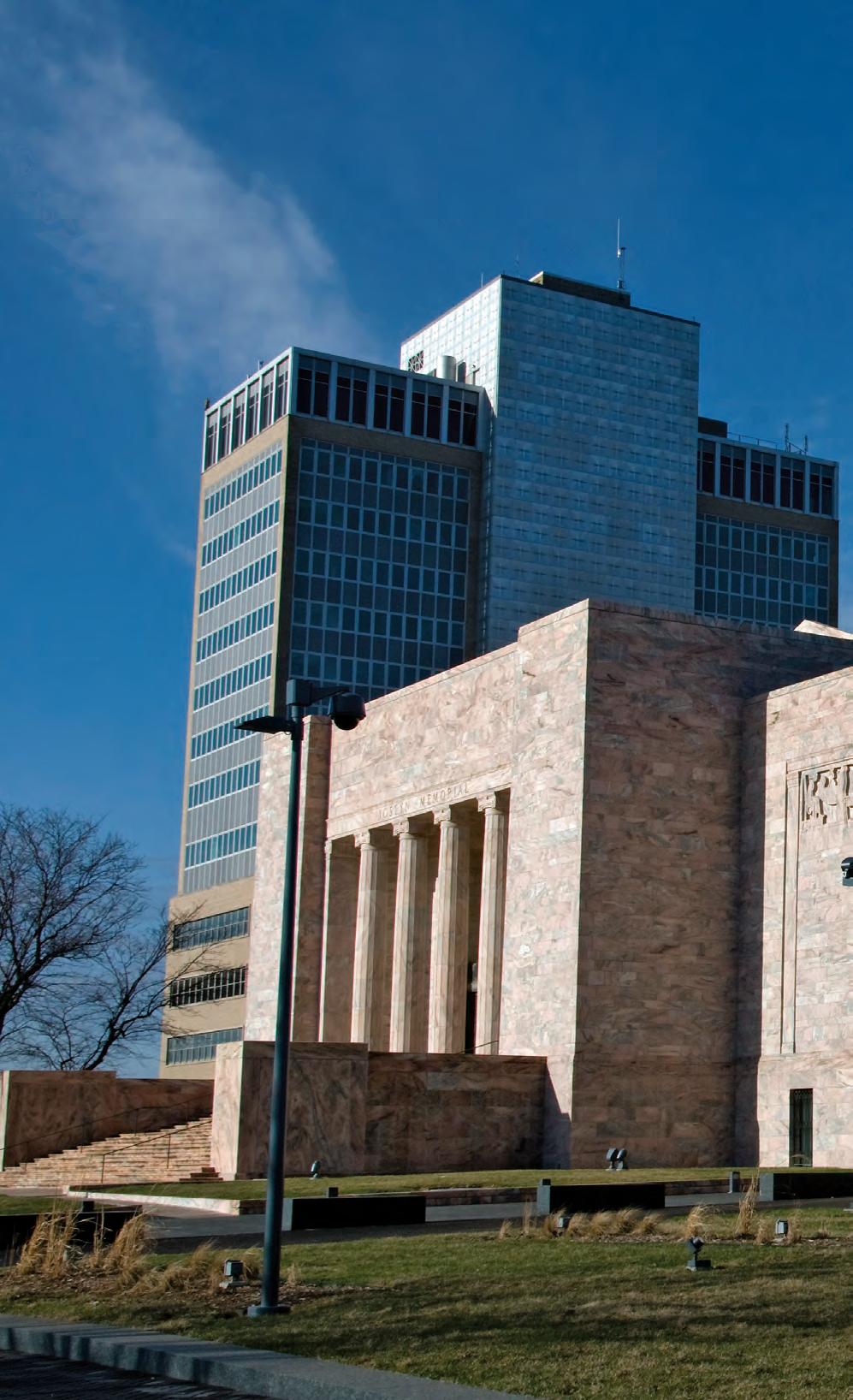
Jack Becker, executive director and CEO of Joslyn Art Museum, talks about the new artwork hanging in the Hawks Pavilion. NIKOS FRAZIER

THE REIMAGINED JOSLYN WINS LOCAL, GLOBAL ACCLAIM

The Hawks Pavilion’s award-winning design includes new educational spaces and community programming areas. Awards validate the museum’s mission to be a peoplecentered, accessible institution, encouraging deeper community engagement.
Curatorial Vision
One of the most significant changes is the complete reinstallation of the museum’s permanent collection – the first since its founding in 1931. This curatorial overhaul emphasizes cross-cultural perspectives, integrating Native American art with American and European works to reflect themes of migration, exchange, and resilience.
The museum’s Native American holdings, curated by Annika K. Johnson, now sit alongside works by Mary Cassatt and William Merritt Chase, creating literal and thematic connections between Indigenous and Western artistic traditions. This approach has been hailed as a thoughtful and necessary evolution in how museums present American art.
Recent acquisitions include:
• Wopila (2024) by Lakota artist Dyani White Hawk, a beaded painting composed of nearly half a million glass bugle beads.
• Falls of Minnehaha (1862) by Robert S. Duncanson, a poignant landscape by one of the first African American painters to gain inter national recognition.
A Bold New Chapter
Inside, the museum now boasts 40% more gallery space, a reimagined entrance sequence, and a transparent atrium that
connects all three buildings. The redesign also includes a new museum shop, expanded studio classrooms, and a rejuvenated sculpture garden featuring works by Alison Saar, Hank Willis Thomas, Mark di Suvero, and Joel Shapiro.
“Planning for our exhibitions begins years in advance, and we have some terrific shows upcoming,” Becker said. “In addition to major ticketed exhibitions in the Scott Pavilion, we are featuring rotating works on paper and media exhibitions in the Hawks Pavilion, regular installations in our Riley Contemporary Artists Project Gallery, and more.”
The Joslyn has originated an ambitious and immersive exhibition, “Dripping Earth: Cannupa Hanska Luger,” that is garnering national attention. Luger draws inspiration from his ancestral connection to the Northern Plains in newly created ceramics, video projections, prints, and monumental sculpture.
“It is the largest solo exhibition for this important artist to date, and I think visitors will really be surprised by it and will love it,” Becker said.
Public Appreciation
Visitors have responded enthusiastically to the museum’s new layout, expanded programming, and curatorial direction. Attendance has surged. The museum’s commitment to free general admission continues to make it accessible to a broad audience.
This reopening marks a turning point – not just for Omaha’s cultural landscape but also for how museums nationwide might rethink their spaces, collections, and missions. Joslyn has seen an increase in rentals of its facilities for private events from business meetings to weddings.
Snøhetta architect, Craig Dykers talks about the Hawks Pavillion at The Joslyn. NIKOS FRAZIER
The Joslyn partnered with the Greater Omaha Chamber Young Professionals (YP) program during the 2025 YP Week and hosted nearly 100 Young Professionals and Executives from across the Greater Omaha Region.
“The Joslyn was generous in sharing their community room with the program and provided an incredible space for Young Professionals to make meaningful connections while exploring the museum’s wonders,” said Merrick Brtek, Director of Workforce Development for the Greater Omaha Chamber. “Omaha is lucky to have a space like the Joslyn within our vibrant urban core.”
Oneofthemostsignificant changesisthecomplete reinstallation of the museum’spermanent collection – the first since itsfounding in 1931.
By embracing architectural innovation, curatorial excellence, and community engagement, the Joslyn has positioned itself as a beacon of creativity and connection.
“People from all 50 states and over 50 nations outside of the U.S. have visited, but we are most pleased with The Joslyn’s place as a major cultural resource for our immediate community, with about 75% of our visitors coming from the eight counties comprising Omaha’s Metropolitan Statistical Area,” Becker said.
“As our neighbors seek experiences with original works of art, and connection with others, they find those opportunities, and more, at The Joslyn.”

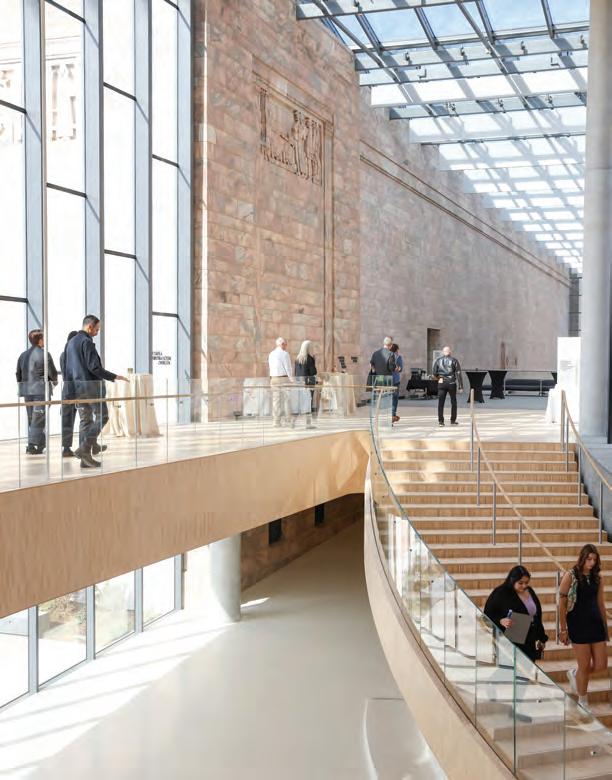



Light pours through The Joslyn’s glass ceiling, illuminating its sweeping staircase as visitors explore the renovated space.
NIKOS FRAZIER
Transitions in Omaha
OVER 25 YEARS, DIXON TRANSFORMS ENTERTAINMENT LANDSCAPE
For a quarter century, Roger Dixon was more than a CEO – he was a visionary force behind Omaha’s rise as a national entertainment and convention destination.
As the recently retired President & CEO of the Metropolitan Entertainment & Convention Authority (MECA), Dixon leaves behind a legacy of architectural ambition, economic revitalization, and civic pride that has reshaped the city’s skyline and spirit.
“Roger has been an iconic leader who took a new endeavor in Omaha and made it something great,” said Omaha Mayor John Ewing. “He has set the bar high for the next leader. That’s the kind of leadership Omaha needs to continue moving forward toward an even greater future.”
Build Them and They Will Come
When Dixon arrived in Omaha, the city’s riverfront was a patchwork of abandoned railyards and industrial remnants.
“I remember driving in from the airport and asking the cab driver where this new arena and convention center was going to be built, and he

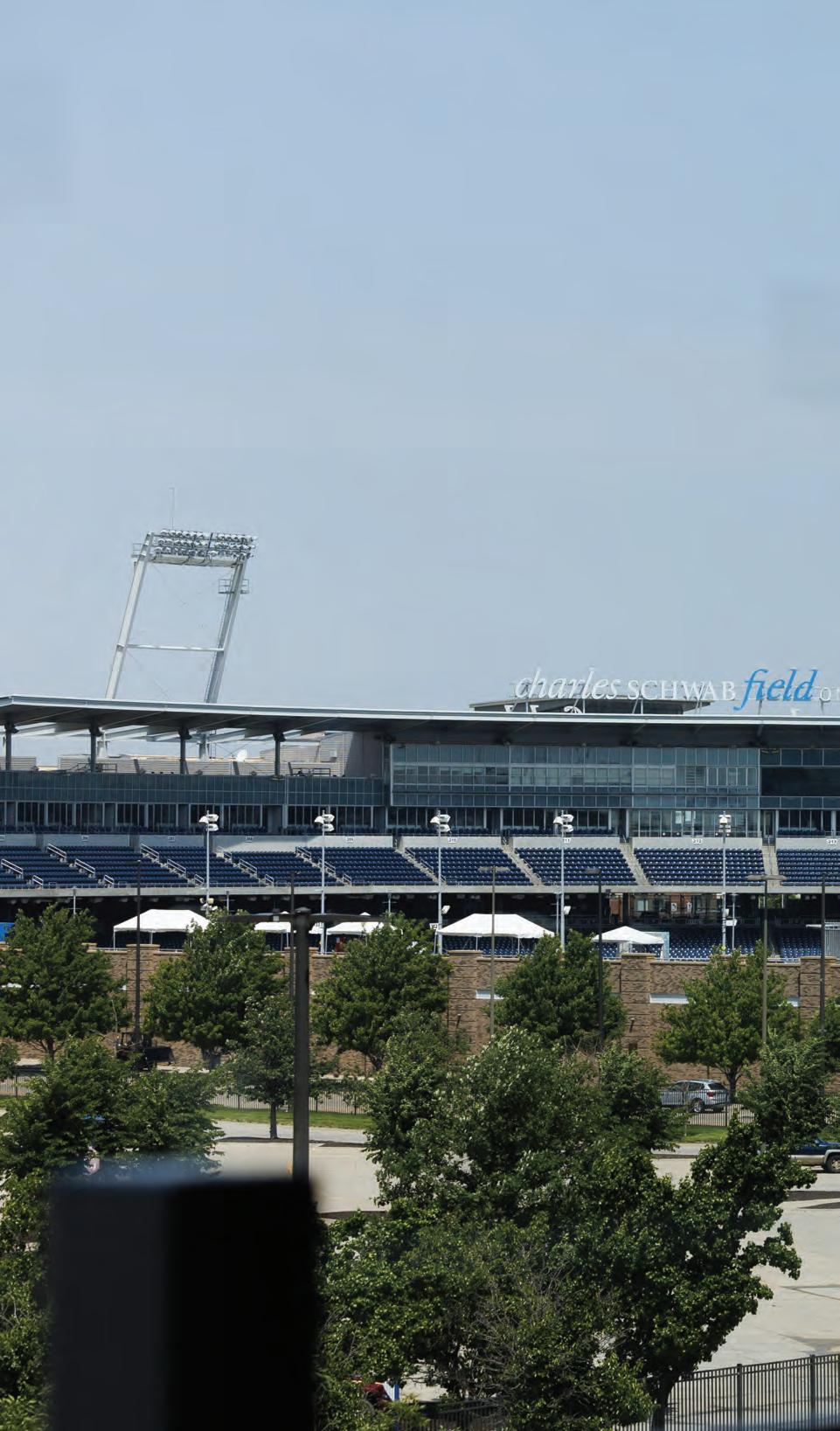

Roger Dixon, CEO of MECA, poses for a photo at the CHI Health Center. Dixon will be retiring from MECA later this year. MEGAN NIELSEN
Rogerhasbeenaniconicleader who took a new endeavor in Omaha and made it somethinggreat.
– Omaha Mayor John Ewing
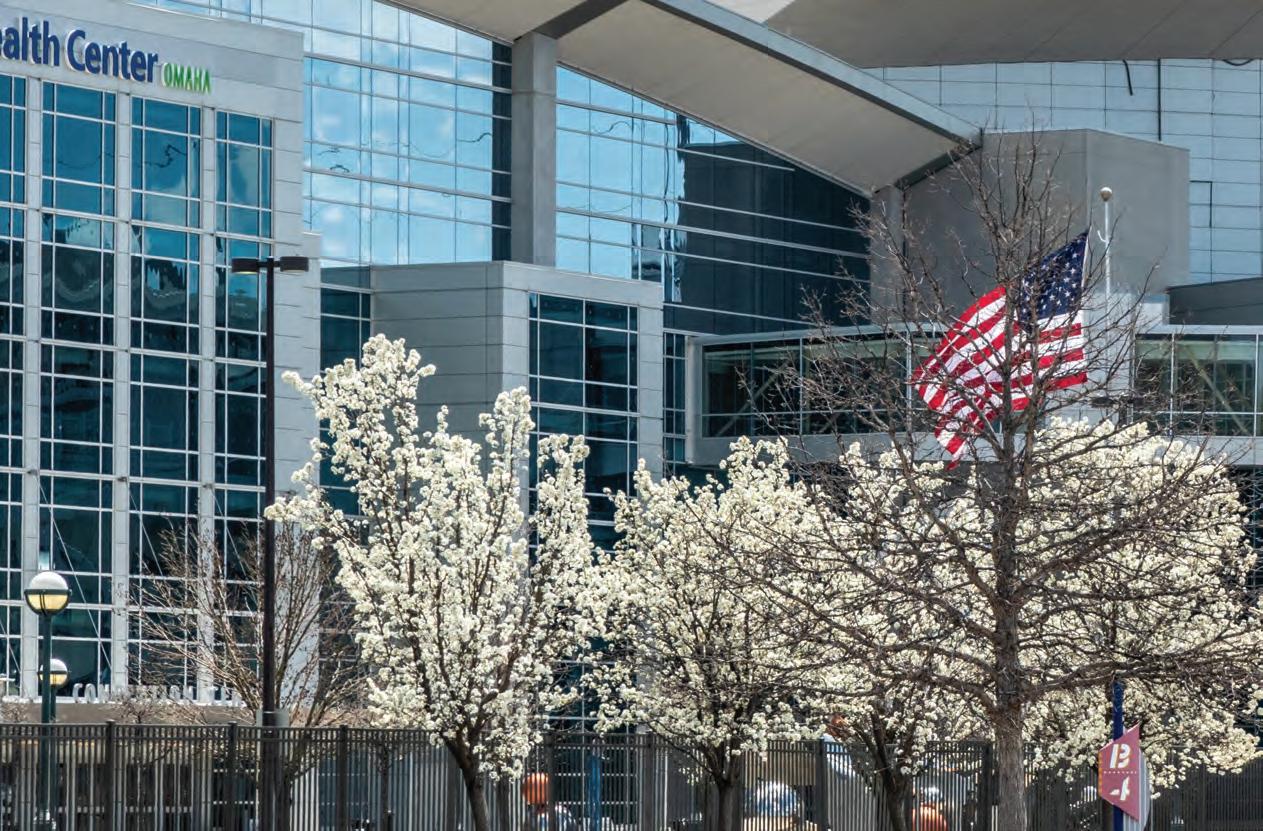
said over there by the river,” Dixon said. “The Asarco plant was still there, and that area of town was so undeveloped, I was surprised. But I also saw it as a great opportunity to build something that would change the city forever.”
Today, thanks to his leadership, downtown Omaha is home to three of the city’s most iconic venues that welcome people from near and far to a vibrant city.
• CHI Health Center Omaha: A state-of-the-art arena and convention center that hosts everything from NCAA championships to sold-out concerts. The convention center is undergoing a $200 million expansion, which is expected to generate an additional $1.2 billion in economic activity once completed in 2027. It will make it possible for Omaha to compete for larger national and international conventions that previously bypassed the city due to space limitations. It’s Dixon’s final gift to the city as the leader of MECA.
• Charles Schwab Field Omaha: The permanent home of the College World Series, drawing hundreds of thousands of fans each summer and more than $115 million to city coffers.
• The Riverfront: A $400 million revitalization project that transformed 72 acres into three interconnected parks –Gene Leahy Mall, Heartland of America Park, and Lewis & Clark Landing. These developments are instrumental in bringing the new museum, Kiewit Luminarium to the riverfront as well.
Together, these projects represent $747 million in development and have welcomed over 32 million visitors through their doors over the past few years.
“Roger has turned bold ideas into enduring institutions that have welcomed millions of visitors, generated billions in economic impact, and put Omaha on the map as a premier destination for sports, concerts, and conventions,” said Heath Mello, Greater Omaha Chamber President & CEO. “His leadership, operational excellence, and commitment to creating world-class experiences has greatly contributed to our modern downtown and our regional economy.”
Billion Dollar Impact
Under Dixon’s stewardship, MECA’s venues have generated more than $2 billion in economic impact for Omaha. That figure isn’t just impressive – it’s transformative. MECA’s venues have become synonymous with world-class entertainment. Under Dixon’s leadership, Omaha has hosted top-tier concerts from Taylor Swift to Elton John at the CHI Health Center.
“The CHI Health Center made Omaha a must-stop location for the biggest concerts and shows,’ said Dixon, who is a 1976 graduate of Southern Illinois University. “Before that, we didn’t have a venue large enough, so that was the beginning of changing the perception of Omaha as a metropolitan city.”
Between 2008 and 2021, Omaha hosted four consecutive Olympic Swim Trials, a feat unmatched by any other city. At the same time, NCAA and youth volleyball and basketball
CHI Health Center Omaha is a state-of-the-art arena and convention center that hosts everything from Creighton Basketball, Olympic trials, NCAA championships to sold-out concerts. The convention center is currently undergoing a $200 million expansion. GETTY IMAGES

tournaments have brought national attention and fanfare as well as thousands from outside the city.
Likewise, more than 100 sold-out Creighton men’s basketball games have turned the CHI Health Center into a collegiate sports fortress. And, of course, there’s the annual College World Series at Schwab Field each June – bringing thousands of baseball fans to the city’s core.
“As a member of the MECA board, I was involved with bringing Roger to Omaha back in 2000,” said Jack Diesing Jr., president & CEO of College World Series Inc. “He’s been a critical builder and also a great operator for change in Omaha.
“He has left a tremendous mark of excellence in all that he’s done for Omaha.”
These events, as well as others, bring in visitors from across the country – filling hotel rooms, restaurants, and retail shops. MECA’s operations support thousands of jobs in hospitality, event management, and maintenance, and the influx of visitors contributes millions in local taxes, helping fund city services and infrastructure.
Civic Vision
Dixon’s impact goes beyond bricks and mortar. His projects have catalyzed a downtown renaissance, turning onceneglected areas into vibrant hubs of activity. The Riverfront, in particular, has become a symbol of community connection. Gene Leahy Mall, the heart of downtown for decades, was
reimagined with interactive play areas, public art, and event lawns. Similarly, Heartland of America Park now features a skate ribbon, lakefront swings, and walking paths. Lewis & Clark Landing boasts the Discovery Playground and immersive water features. These parks host numerous events each month and welcome millions of visitors annually.
“Roger played a pivotal role in bringing the arena and convention center to life, and for the past 25 years, he’s been just as committed to elevating Omaha as a leading Midwestern destination for conventions and events,” said Deborah Ward, the former executive director of Visit Omaha who worked with Roger for 18 of his 25 years. “His vision and dedication to quality have shaped one of the most respected facilities in the country.”
And while his career spans nearly 50 years, it’s Dixn’s Omaha chapter that stands as his crowning achievement.
“I’m honored to have had the opportunity to help build and operate Omaha’s premier arena and convention center and a world-class baseball stadium, along with modernizing 72 acres in downtown Omaha to serve as a vibrant epicenter for the city over the last 25 years,” said Dixon, who planned to stay in Omaha after his end-of-the-year retirement.
“I may have led these projects, but I didn’t do any of these by myself. It truly has been a team effort, and that goes beyond MECA. The city of Omaha, Omaha Sports Commission, College World Series, foundations, and private donors – everyone has worked together to make all of this happen.”
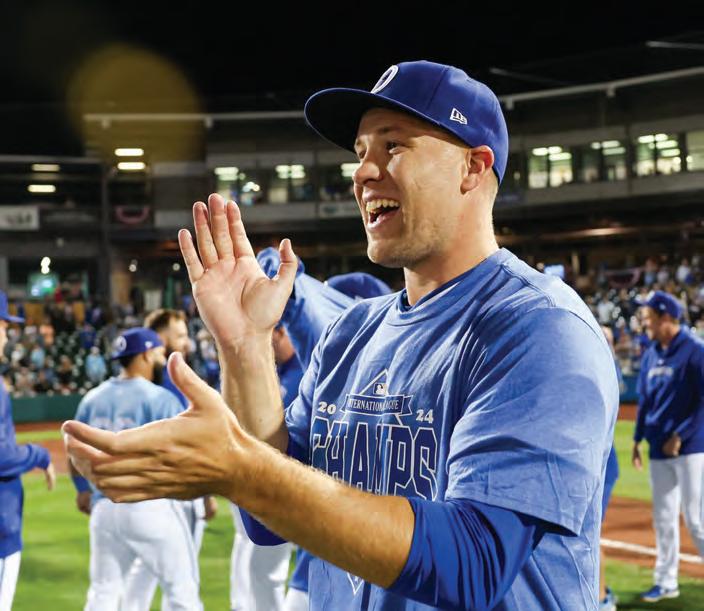

SPORTS-CRAZY CITY PASSIONATE ABOUT PRO TEAMS
2025 a Banner Year for Competition and Community
Omaha’s professional sports scene is trailblazing for the city that just hit 1 million residents. Omaha may not boast the size of a major metropolitan sports market, but in 2025, it proved its passion, pride, and performance rival any city.
From the crack of the bat to the roar of the crowd in packed arenas, Omaha’s professional teams delivered thrilling seasons across baseball, volleyball, soccer, arena football, and softball. Each team not only competed fiercely but also deepened its roots in the community, reinforcing Omaha’s identity as a sports-loving city.
STORM CHASERS FILL SEATS
Omaha’s professional baseball scene is anchored by the Triple-A Omaha Storm Chasers. Omaha has served as Kansas City’s Triple A affiliate since 1969, the third-longest active affiliation in Minor League Baseball.
The Storm Chasers in 2025 showcased rising talent like Carter Jensen and Jac Caglianone, who kept fans engaged with standout performances. Attendance remained strong, with over
Omaha Supernovas players celebrate after winning the Pro Volleyball Federation championship, at the CHI Health Center. NIKOS FRAZIER

140,000 fans passing through Werner Park, a testament to the team’s enduring local support.
The Chasers finished 2024 with the best record in the International League, featuring players such as John Rave, Nick Loftin, and Noah Cameron, who went on to play for the Kansas City Royals in 2025.
The Triple-A Omaha franchise has won seven league championships: four while playing in the American Association and three in the Pacific Coast League.
SUPERNOVAS SHINE BRIGHT
The Omaha Supernovas, Nebraska’s professional volleyball team in the Pro Volleyball Federation (PVF), had another historic season. After winning the inaugural PVF Championship in 2024, the Supernovas finished the regular 2025 season 21–7, clinching the PVF regular-season title. They were narrowly defeated in the playoff semifinals by Indy Ignite.
One dominant player was Brooke Nuneviller, who was named PVF’s outside hitter of the year. Nuneviller and Natalia ValentínAnderson earned All-League honors.
For the second year, the Supernovas led the U.S. in pro volleyball attendance, averaging nearly 11,000 fans per match. The CHI Health Center hosted all of the top 10 most-attended U.S. pro volleyball matches, underscoring the city’s love for the sport.
“Omaha and people from the state and region have truly rallied around our team, and it’s a reflection of how much love they show Nebraska and Creighton volleyball every year,” said Supernovas President Diane Mendenhall. “Nebraska helps lift us up every time we take the court. The support has been unbelievable.”
The Omaha Supernovas will continue to play their home games at the CHI Health Center in 2026. However, they will compete in a league formed by the merger of PVF and Major League Volleyball. The new league will have the MLV name. Another big change: John Cook, the former Nebraska volleyball coach, has become a co-owner and general manager of the Supernovas.
players

NEBRASKA LOVES LOVB
Nebraska’s other professional volleyball team is LOVB Omaha, which has rebranded as LOVB Nebraska for the 2026 season.
Nebraska’s inaugural LOVB (League One Volleyball) season was competitive but middle-of-the-pack in 2025 – until the playoffs. The team, led by Olympian and former Husker star Jordan Larson, finished the regular season with a 5-11 record but went on to make the championship match. In that match, LOVB Omaha lost in three competitive sets to top-seeded Atlanta.
Omaha LOVB enjoyed strong local support at their home venues, Baxter Arena and Liberty First Credit Union Arena, and performed better at home (4–3) than away (0–3).
The 2026 LOVB Nebraska roster features five Olympians, six NCAA All-Americans, 10 current and former members of

senior national teams, all while representing nine countries across the world. In addition, player Larson is becoming partowner of the team.
OMAHA BEEF CONQUERS
In their 26th season, the Omaha Beef, competing in the National Arena League (NAL), continued their dominance in indoor football.
The Beef finished the regular season 8–1, making their fifth straight championship appearance. They fell short in the final, losing 37–29 to the Beaumont Renegades. Omaha is now 3 for 7 in championship games and 1 for 4 in championship road games.
Known for their raucous home crowd at Liberty First Credit Union Arena, the Beef were named NAL Franchise of the Year and recognized for having the best fan base. The team – which reaches back to its 1999 founding – enjoys a local tradition that blends entertainment and community pride.
“Omaha proved once again that it is a sport town with its tremendous show of support for the Beef,” said Ricky Bertz, an owner of the Beef since 2018. “The Beef is the longestrunning team in the National Arena League, and we’ve filled the stands when we’ve been good and when we haven’t. I don’t know of any other team in the league with that kind of unwavering support.”
UNION OMAHA PREVAILS
Union Omaha, the city’s USL League One soccer team, had a successful 2024 season, culminating in winning the USL League One title and the Players’ Shield (awarded to the team with the best regular season record). The team became the first in the
Union Omaha
celebrate after winning the USL League One Final at Werner Park.
NIKOS FRAZIER
league’s history to win the championship twice. It also set a record for the largest crowd at a USL League One final.
Midway through the season, head coach Dominic Casciato departed for the Tampa Bay Rowdies, with assistant Vincenzo Candela stepping in as interim coach. He has since become the head coach.
In another big change, the Union’s proposed 7,000-seat stadium to be built in downtown Omaha is on the drawing board. Union owner Gary Green said he intends to keep searching for the right location and has no plans to build anywhere but Omaha –particularly downtown as originally intended.
AUSL IS WELCOMED
In 2025, Omaha stepped into the spotlight as a host city for the Athletes Unlimited Softball League (AUSL) – a new chapter in professional women’s sports. Though the league’s first season operated on a touring model, Omaha’s enthusiastic reception made it one of the standout stops, igniting hopes for a permanent team in the future.
The AUSL launched with four teams: Talons, Bandits, Blaze, and Volts, each playing a 24-game schedule across 10 cities. Omaha hosted a three-game series at Connie Claussen Field at the University of Nebraska at Omaha on July 11–13. The Talons (18–6 record, best in the league) and Bandits (15-9, secondbest) advanced to the AUSL Championship Series, held in Tuscaloosa, Alabama.
Omaha’s series drew sold-out crowds of 1,500-plus for each game, with fans creating an electric atmosphere. AUSL officials praised Omaha’s turnout, calling it “the crowd we expected –and they showed up.”
The AUSL plans to transition to city-based teams in 2026, and Omaha has made a strong case to be one of the six permanent franchises due to its central location – and, of course, because of its support for the league and for local youth softball development.
LANCERS LOOK TO FUTURE
Despite a tough 7-win season in 2024–25, new Omaha Lancers President Mike West is excited about what’s to come with a new head coach and a young but hungry roster.
“There were a lot of questions over the course of last season as to whether or not the right kids were playing and not playing, and there weren’t as many checks and balances in place to keep things on track,” West said. “Now, we have a much different culture, coaching stability, and outlook for great things to come.”
The Lancers are not a pro team but a top junior hockey program for developing players for potential future college and professional play.
The team went through three coaching changes during the 2024-25 season. At the conclusion of the season, the Lancers formed a community advisory board featuring local leaders, former NHL players, and business professionals to improve the team’s reputation and strengthen ties with fans. From those meetings, new coach Ron Fogarty was hired to lead the team. With over 25 years of coaching
experience at the NCAA, professional, and international levels, he is a proven leader in player development and team success.
WHAT IT MEANS FOR OMAHA
Omaha’s professional sports scene in 2025 wasn’t just about wins and losses – it was also about identity, pride, and connection.
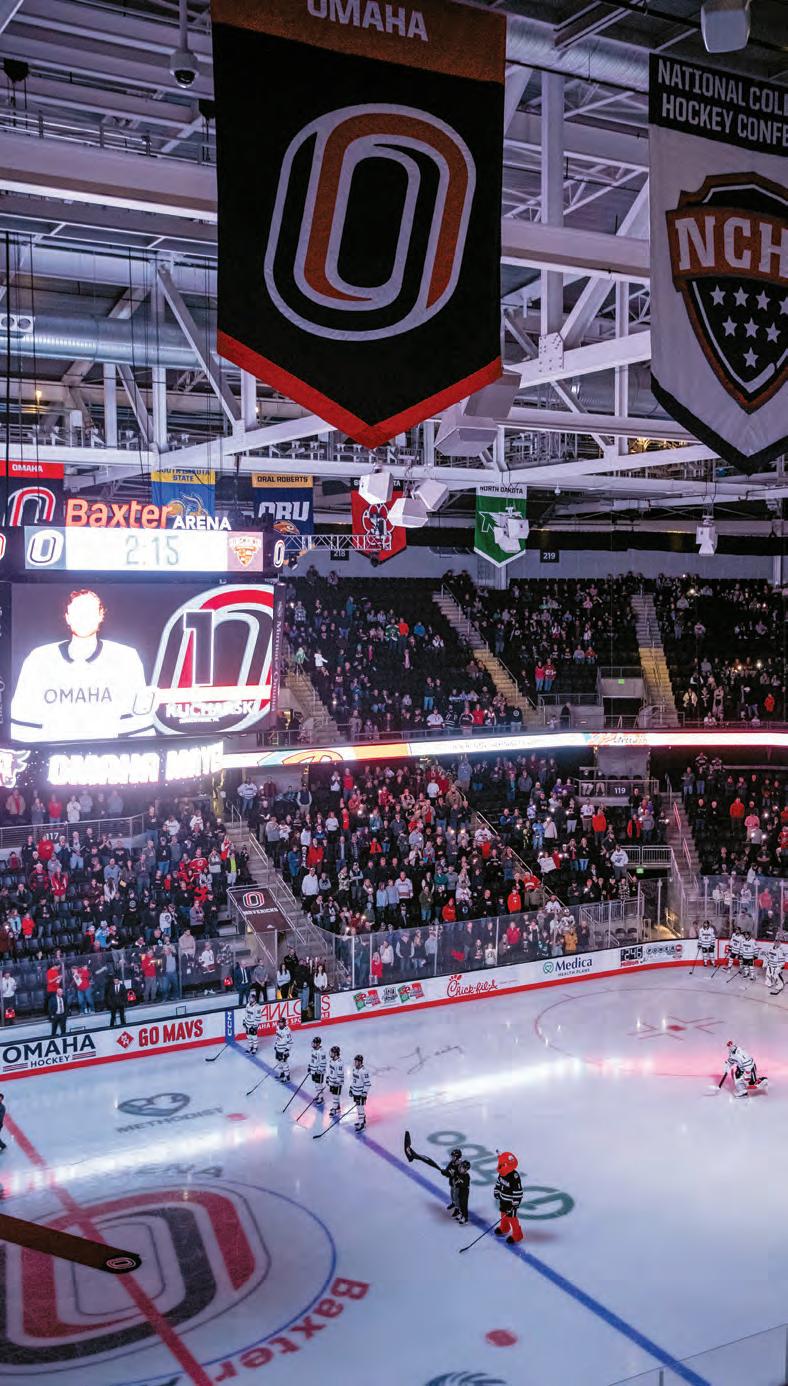
Packed stadiums and arenas brought revenue to local businesses, from restaurants to hotels. Local athletes and teams serve as role models, fueling youth participation in sports like volleyball, soccer, and softball.
Whether it’s with a walk-off homer or a volleyball ace, these teams give Omaha residents something to rally around. With new leagues emerging, rising stars developing, and community support stronger than ever, Omaha’s sports future looks bright. Whether you’re a die-hard fan or a casual spectator, there’s never been a better time to be part of the action.
“We have truly seen that sports galvanizes the community in a variety of different ways,” said Martie Cordaro, president of the Storm Chasers and Union Omaha.

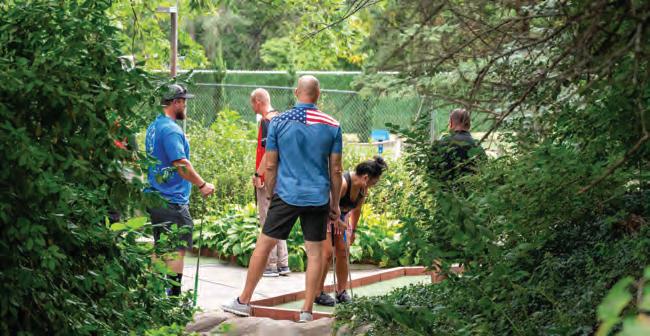
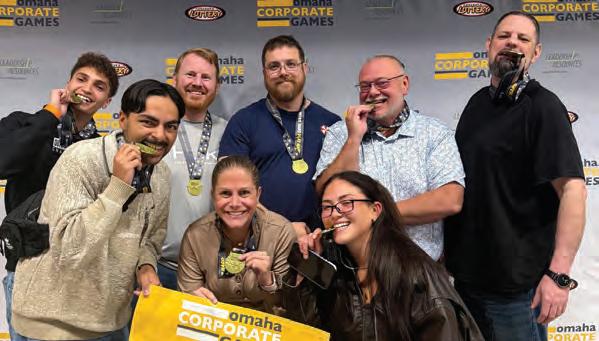
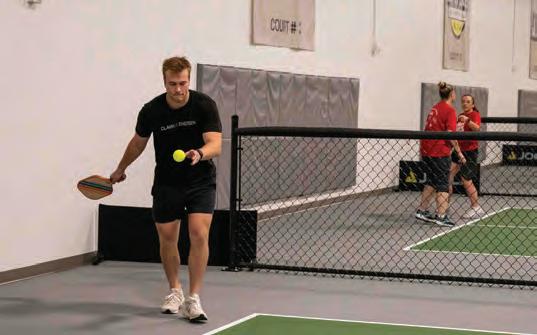
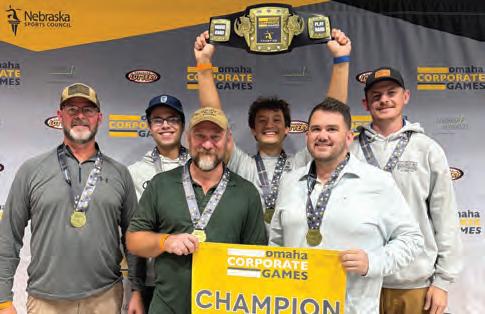
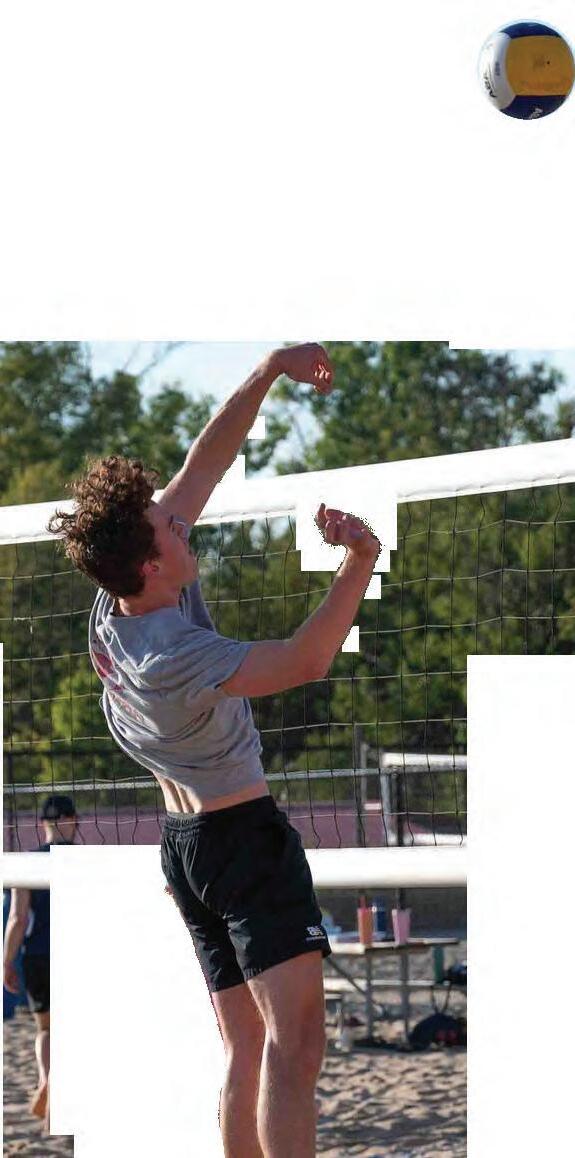
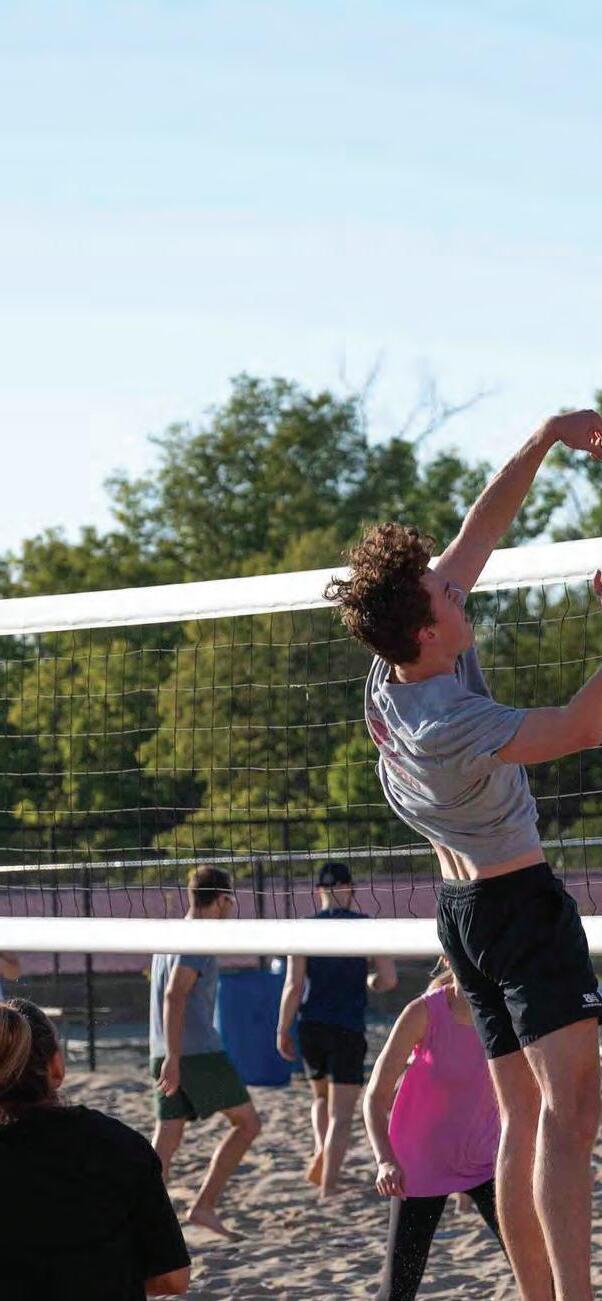









OMAHA’S ‘BUD’ CRAWFORD MAKES BOXING HISTORY
Boxer Terence “Bud” Crawford of Omaha defeated Canelo Alvarez by unanimous decision in September to capture the undisputed super middleweight title. This fight is one of the most significant in boxing history, as it means Crawford has been the undefeated champion in five divisions over 11 years — from the 135-pound lightweight division to the 168-pound super middleweight division.
“Bud has always carried Omaha with him into the ring, and his success continues to showcase our city to the world,” said Aron Wehr, Vice President of Marketing & Communications for the Greater Omaha Chamber. “What an honor it is to have one of the best athletes in the world call Omaha home.”
Crawford (42-0, with 31 knockouts) is the first male boxer in the modern era to be undisputed champion in three weight classes. After the fight, held in Las Vegas on Sept. 13, Crawford thanked his supporters – and his haters. “I appreciate every one of y’all,” he said.
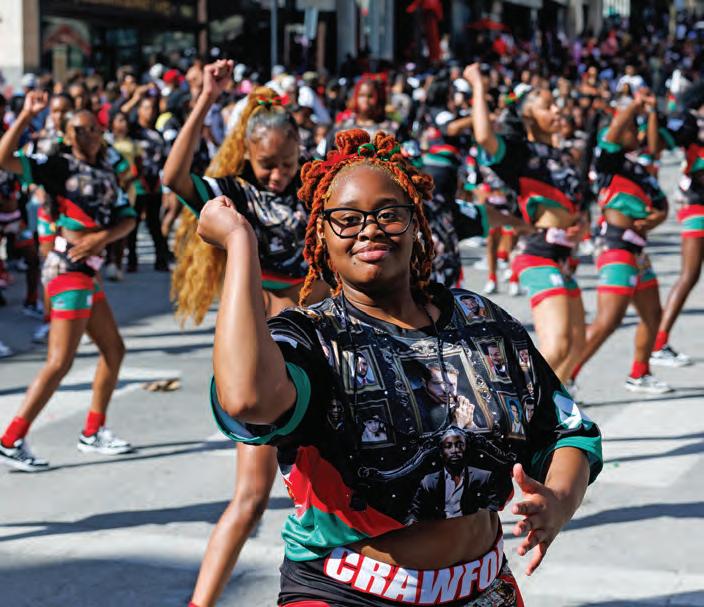

Dancers perform during the Terence “Bud” Crawford victory parade in downtown Omaha. NIKOS FRAZIER
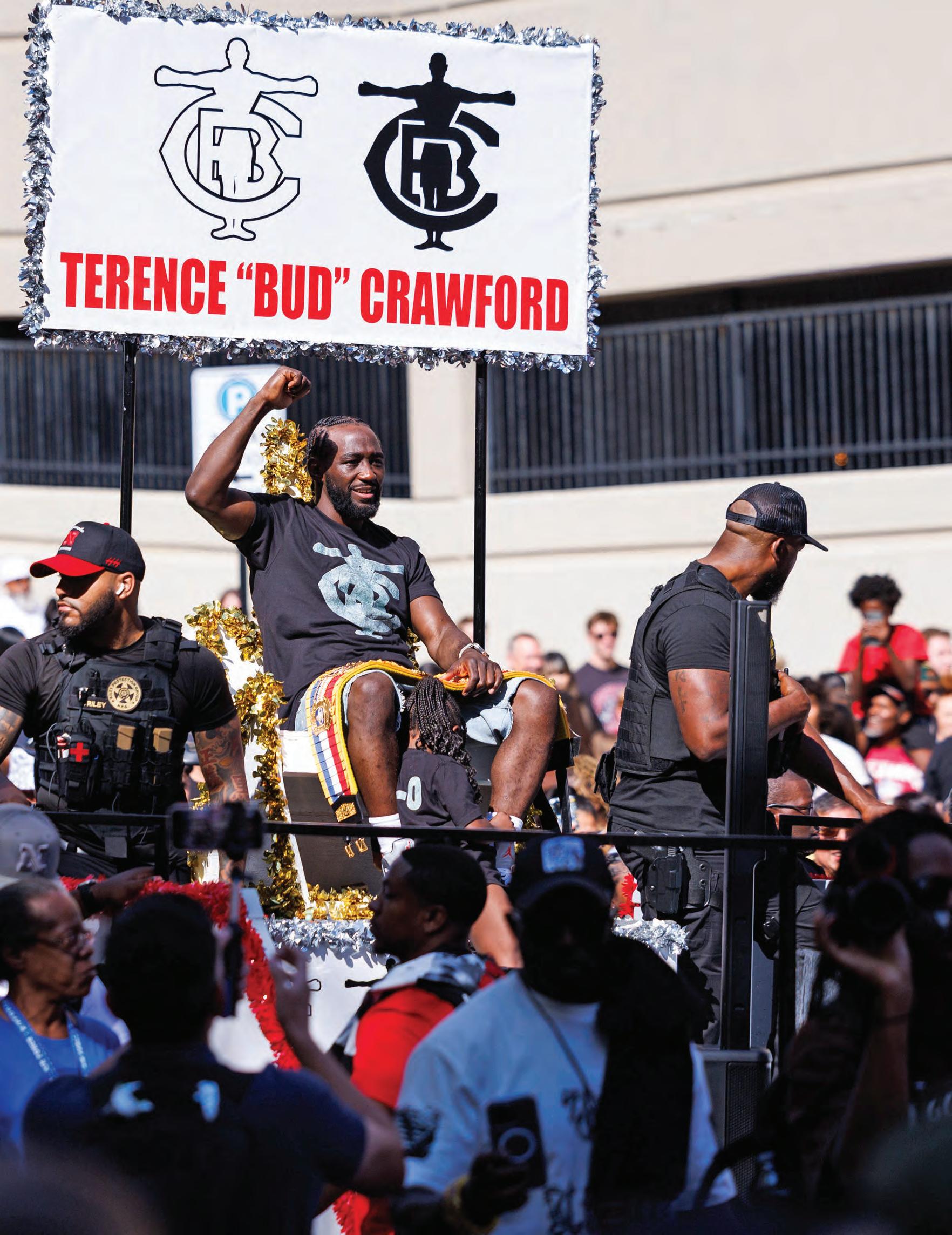
Terence “Bud” Crawford waves to the crowd during his victory parade in downtown Omaha. NIKOS FRAZIER
The College World Series: OMAHA’S DIAMOND LEGACY & ITS GRAND-SLAM IMPACT
Origins and Evolution
The College World Series began in 1947 in Kalamazoo, Michigan, and after a brief stint in Wichita, Kansas, the annual baseball tournament found its permanent home in Omaha in 1950. The move was championed by local leaders, including Mayor Johnny Rosenblatt, whose namesake stadium would host the event for six decades.
“From 1963 to 1989, we had one-year rolling contracts with the NCAA to host the CWS, but between ’87-89, the NCAA was changing with some younger people involved with the event,” said Jack Diesing Jr., president of the CWS since 1989 and a board member since 1985.
“The new leaders saw new changes needed to be made, and one of those was a longer-term contract for the CWS. We were happy to oblige, and the relationship has grown and matured ever since.”
Despite early financial struggles, the city’s
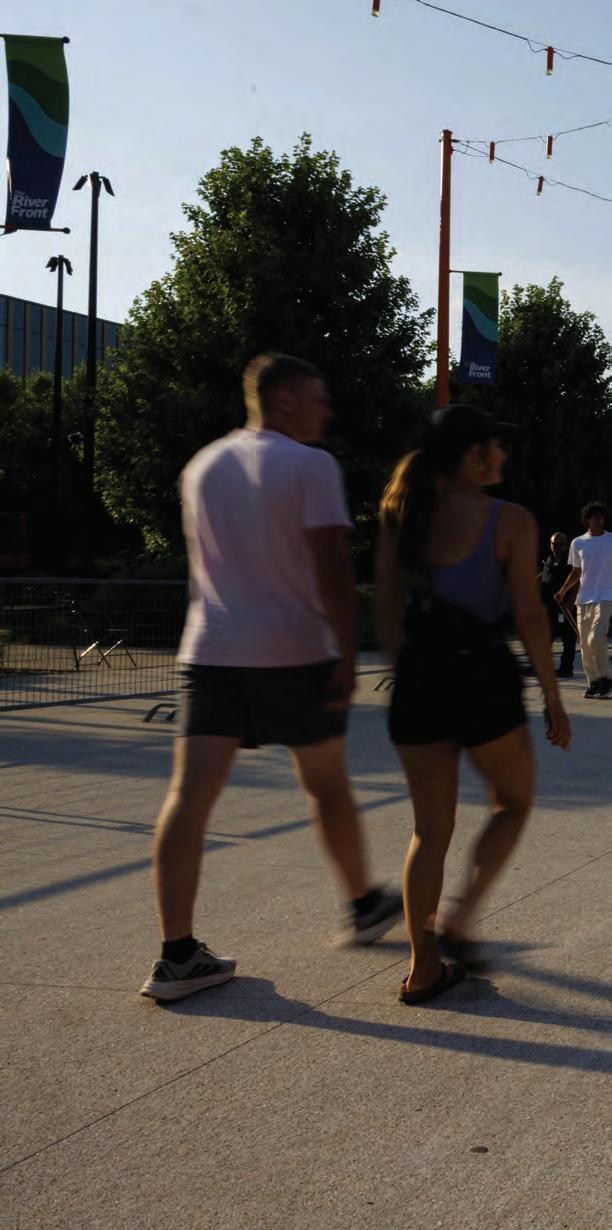

unwavering support – through volunteers, local businesses, and civic leaders – helped the tournament grow into a national spectacle.
Omaha signed a 25-year contract extension in 2008 to host the CWS through 2035, showcasing long-term commitment. In 2011, the event moved downtown to Charles Schwab Field Omaha, a


state-of-the-art stadium that reaffirmed Omaha’s commitment to hosting the championship.
Today, college teams across the country open their seasons with the mantra “Road to Omaha,” making the city synonymous with the annual championship.
“They don’t say ‘Road to the CWS Championship’;
they say ‘Road to Omaha.’ That means something,” said CWS Executive Director Amy Hornocker. “We revel in that. Coming to Omaha means your team is playing for a championship.”
Theydon’tsay‘RoadtotheCWS Championship’;theysay‘Roadto Omaha.’ That means something.
– CWS Executive Director Amy Hornocker

Local Impact
For Tim Addison, owner of Addy’s Sports Bar & Grill at 10th and Dodge Streets in the Capitol District, baseball fans’ annual pilgrimage to Omaha for the College World Series is a huge business boon.
During that 10-day window each June, his business brings in more money and people than any other time of the year –surpassing what he makes in two or three normal months.
“During regular weeks, we get deliveries twice a week, but during the CWS, we get daily deliveries of food and drinks; things amp up that much,” Addison said. “The volleyball championships, swim trials and youth baseball tournaments are big factors, but not to the magnitude of CWS.”
Every June, Omaha transforms into the epicenter of college baseball – a tradition that continues to shape the city’s identity, economy, and culture in profound ways.
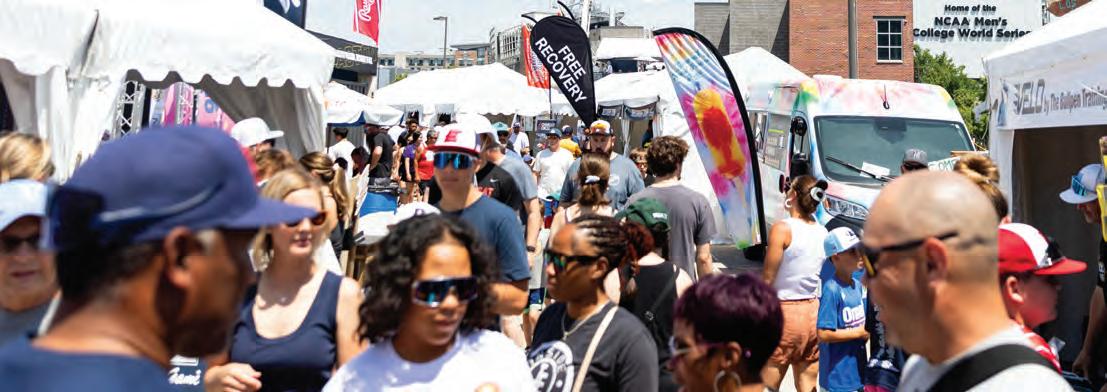

During these eight decades of impact – dating back to 1950 at Rosenblatt Stadium and evolving into college teams’ Road to Omaha mantra that culminates with fireworks and home runs at Schwab Field – the CWS has made the city an iconic symbol of success.
Economic Impact
Over the past 75 years, the College World Series has become more than a baseball tournament – it’s an economic powerhouse. The games in 2025 drew a total of 342,676 fans. Annually, the event generates in excess of $115 million for Nebraska’s economy, supports over 22,000 jobs, and fills 75,000 hotel room nights, contributing $3.5 million in local taxes.
The ripple effect touches nearly every sector – restaurants, retail, transportation, and entertainment all see a surge in business. Local vendors, from ice cream shops to breweries, prepare months in advance for the influx of fans.
The event also boosts Omaha’s visibility on national television, with millions tuning in to watch the games, further enhancing the city’s reputation as a premier sports destination.
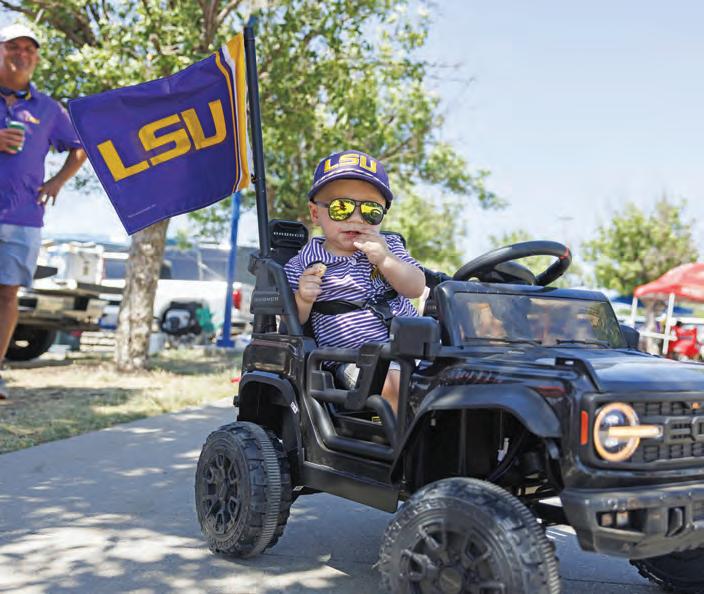
“CWS is the No. 1 economic driver in Omaha each year,” said Diesing Jr., whose father, Jack Sr., an executive at Brandeis, stepped into the local leadership role for CWS in 1963.
“Realizing this, we knew it was imperative to build the new stadium downtown and engage with a bigger business sector and audience.”
Charles Schwab Field replaced Rosenblatt Stadium in 2011 and now hosts the College World Series, seating over 24,000. GETTY IMAGES

Identity and Civic Pride
For Omaha, the College World Series is not just an event – it’s part of the city’s DNA. The tournament has shaped Omaha’s identity as a welcoming, sports-loving community. Local institutions like Creighton University and the University of Nebraska at Omaha now co-host the event, reinforcing its deep ties to education and civic engagement.
The city celebrates the CWS with street decals, sculpture tours, and riverfront fireworks. These festivities aren’t just for fans – they’re a tribute to Omaha’s role as the heart of college baseball. The tournament’s longevity and success are a testament to the city’s resilience, vision, and collaborative spirit.
In many ways, the CWS opened eyes and minds toward further sports and entertainment growth in Omaha – leading to NCAA volleyball and basketball tournament matches and games, hosting every U.S. Olympic Swim Trials between 2008 and 2021, U.S. Figure Skating Championships, and, most recently, the USA Triathlon Multisport National Championships Festival.
The consistency of the location – unlike other NCAA championships that rotate cities – has allowed Omaha to build a legacy unmatched in college sports. Fans know what to expect: world-class facilities, passionate crowds, and a city that embraces the game with open arms.
Looking Ahead
As the College World Series celebrates its 75th anniversary in Omaha, the city is already planning for the future. Investments in infrastructure, partnerships with local universities, and a commitment to innovation ensure that the tournament will continue to thrive.
The goal is clear: to host the CWS in Omaha forever.
In a world where sports often chase novelty and spectacle, the College World Series stands out for its authenticity, tradition, and community roots. It’s a celebration of baseball, yes – but also of Omaha itself: its people, its pride, and its enduring love for the game.
Omaha’s stewardship of the College World Series is a master class in civic pride, strategic planning, and community spirit.
“We absolutely love welcoming everyone in town for the CWS each year,” Addison said. “Even when we have crowds from different teams in the bar together, it’s a very fun environment filled with goodwill and friendly competition. It’s always a great time to be in Omaha, but it’s especially great in June.”
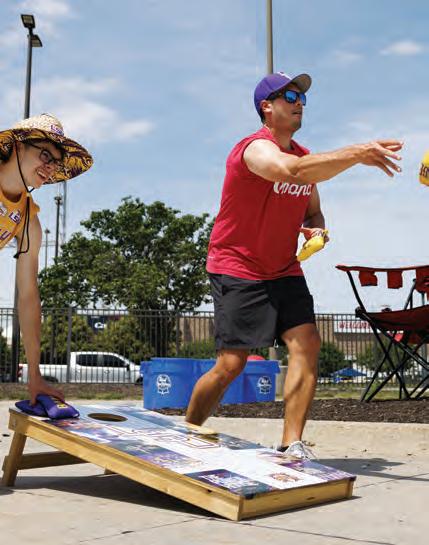
Fan Fest, located outside the stadium has family-friendly attractions like batting cages, speed pitch, food trucks, and a main stage with live music. Others take advantage of Omaha’s RiverFront parks and enjoy the nightlife. OMAHA WORLD-HERALD

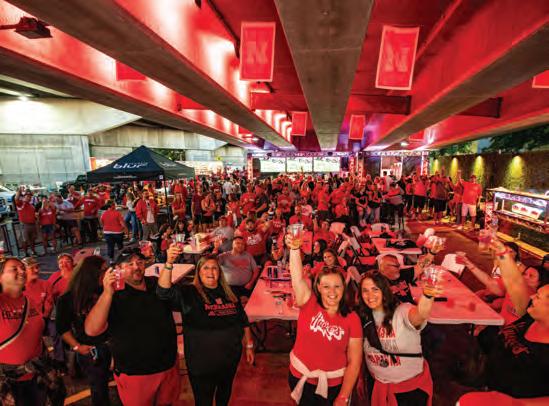



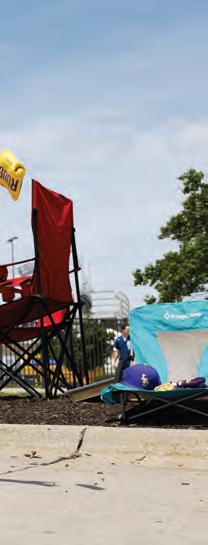
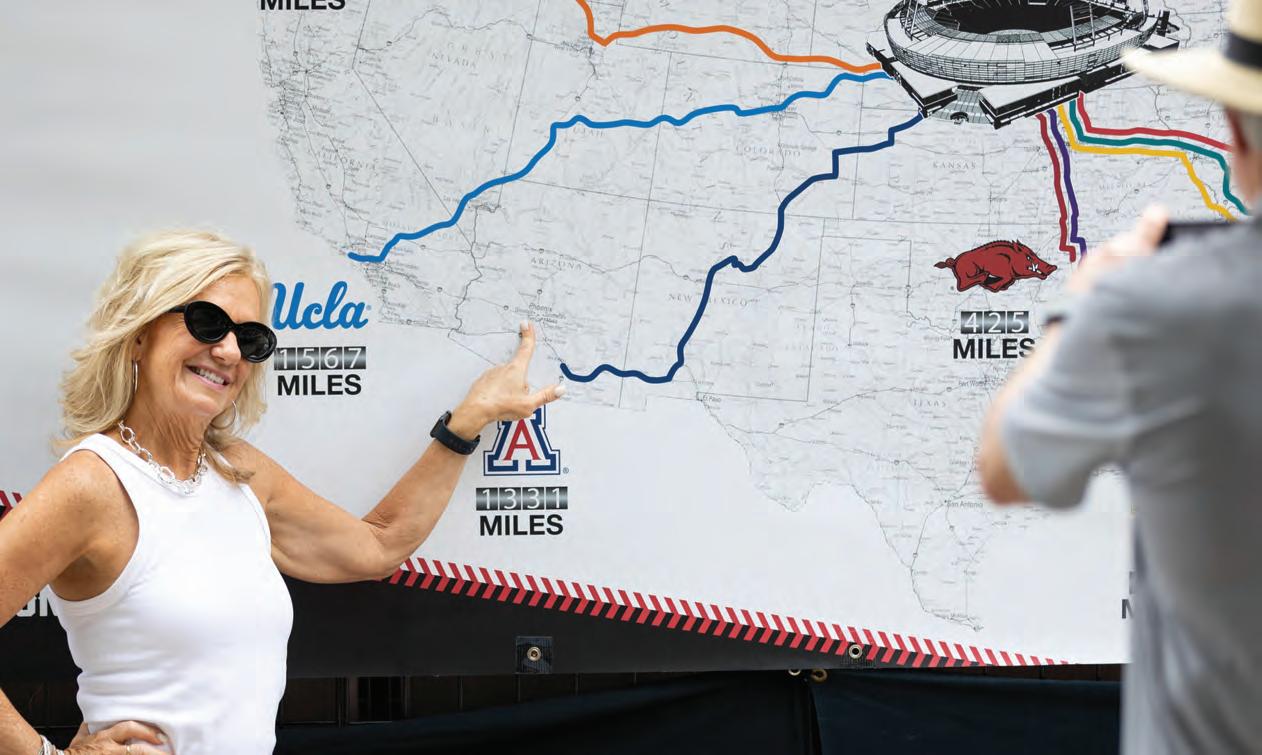

OVERWHELMING TRIATHLON SUCCESS ATTRACTS IRONMAN IN 2026

The USA Triathlon Multisport National Championships Festival in Omaha – presented by Mutual of Omaha – involved much more than running, swimming, and biking.
It was a full-blown trial of endurance, community, and economic vitality – and it truly took a village to make it successful in 2024 and 2025.
Not only did the Omaha Sports Commission (OSC) collaborate with USA Triathlon – an Olympic national governing body – but it also worked with Visit Omaha; the City of Omaha police, fire and emergency services; hotels and restaurant proprietors; and local triathlon clubs and sports volunteers.
“In a city like Omaha, where these services communicate and work with one another well ahead of the actual event, the end result is very successful,” said USA Triathlon Events Manager Brad Hildebrandt, who worked closely with the OSC.
The events, held at Cunningham Lake, featured a wide range of race formats, including triathlon, duathlon, aquathlon, aquabike, and paratriathlon; youth and age-group

championships; and mixed relay and team events. Qualifying athletes earned a spot on Team USA for the 2026 World Triathlon Championships.
This variety made the event accessible to athletes of all levels – from young to older, first-timers to Olympic hopefuls.
“This event really reaches people from all walks of life,” said Lindsay Toussant Brown, executive director of the Omaha Sports Commission. “We had such a great turnout all days both years we hosted the festival – participants, spectators and volunteers alike. And the cooperation and collaboration with the OSC, USA Triathlon, and City of Omaha was seamless.”
Community Impact
The festival’s return to Omaha in 2025 had a significant impact on the local economy and community spirit as 97% of athletes traveled from outside the metro area, filling 3,500-plus nights in hotel rooms. The event showcased Omaha as a national destination for sports tourism.
In the two years the event was held in Omaha, more than 1,100 elite athletes from all 50 states and across the world competed for five days. Spectators and volunteers raised that number to 2,341in 2024 and more than 2,000 in 2025.
On top of attendance and participation, the economic impact of a multi-day, multi-event festival is enormous. In 2024, the event brought in more than $3.7 million to the city, and in 2025, that number was at $3 million.
Then there are the local volunteers from the community who help run the event – many of them from local and regional triathlon clubs – fostering civic pride and telling their own stories as triathletes.
“It’s not just about dollars – it’s about bringing people together and putting Omaha on the map,” Toussant Brown said. “When we host a sporting event, we put our best foot forward. We want people to not only have a great experience while they’re here, but speak positively about it when they go back home. It’s great for the city and everyone involved.”
Christopher Navin competes in the Standard Aquabike Nationals during the USA Triathlon Multisport National Championships Festival at Cunningham Lake. CHRIS MACHIAN

Cunningham Lake proved ideal for this event because the 390-acre lake is surrounded by a 1,050-acre park; scenic, flat running courses; rolling bike terrain; and newly renovated facilities that make it ideal for large-scale events.
“It’s a natural gem that turns into a buzzing hub of activity during the festival,” said Emily Winckler, Omaha Sports Commission director of events.
Next Up: IRONMAN
While the USA Triathlon Multisport National Championships Festival is moving to a new city and venue in 2026 (the event moves every couple of years to reach a new audience), Omaha and the OSC will welcome an equally exciting event next June – again at Cunningham Lake.
A 70.3-mile IRONMAN race will feature a 1.2-mile swim in the lake, followed by a 56-mile bike course through rolling terrain in Douglas County, and a 13.1-mile run course across scenic urban trails and the Missouri riverfront, including the iconic Bob Kerrey Pedestrian Bridge.
The city’s commitment to youth engagement, adaptive athlete inclusion, and community outreach aligns with USA Triathlon’s and IRONMAN’s missions. Omaha’s infrastructure supports
large-scale events with ease – shuttles, bike valet services, and camping options make logistics smooth for athletes and spectators alike.
This event is set to run annually through 2028, so Omaha is officially on the IRONMAN map. Whether you’re racing or cheering from the sidelines, it’s going to be an unforgettable experience.
“Talk to anybody, and they will tell you Omaha is a sports town,” Toussant Brown said. “National and international sporting events heighten and ignite civic pride on top of beloved UNL, UNO and Creighton athletics. We love hosting them, and the city supports them on a level that is unrivaled. It’s win-win for everyone.”
Strong Local Support
Kristi Johnson agrees. She began triathlon competitions with the Omaha Women’s Triathlon in 2014, is the president of Team Nebraska Triathlon, and serves on the board of Ironhawk Juniors Triathlon.
In her experience as both a volunteer and participant, the Omaha community will come out in full force to support IRONMAN in 2026 and 2027 – just as it did the past two years.

“We have a very strong triathlete community, and really looking forward to supporting it, seeing the young women from Ironhawk Juniors volunteer and see what they can do as they continue to train and push themselves, and just excited to see an event like this finally be close to home,” said Johnson, a twotime IROMAN competitor and co-sport director for the Cornhusker State Games Triathlon.
“This should draw a huge number of athletes from all over, and will potentially grow into a professional race, drawing even more attention.”
Omaha’sinfrastructuresupports large-scaleeventswithease–shuttles, bikevaletservices,andcamping optionsmakelogisticssmooth for athletes and spectatorsalike.


Finisher meals for the Standard Aquabike Nationals during the USA Triathlon Multisport National Championships Festival. CHRIS MACHIAN
WHERE OPPORTUNITY HELPS PEOPLE FLOURISH
Greater Omaha creates opportunity for people through its diverse economy, and our people give the city vibrance, character, optimism, and growth. The folks who invest their time and talent in Greater Omaha make a broad range of industries succeed, including finance, health care, insurance, information technology, and trade. Our economy is built on people.
Future Economic Development
North Omaha Project
Civic Square
UNMC Project NExt
Leaders in the Community
Warren Buffett
Fortune 500 Companies
Rail Merger
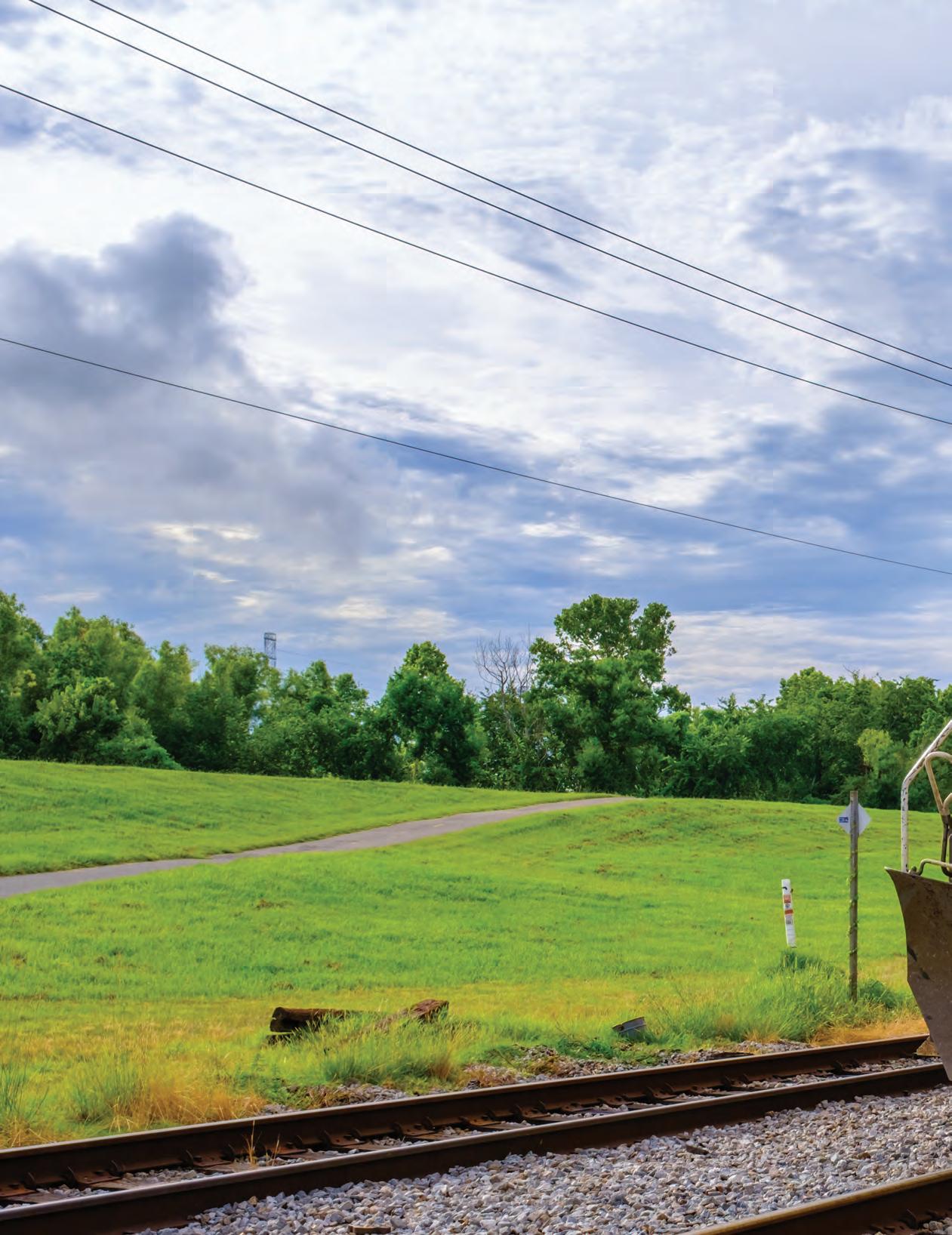
Union Pacific Railroad, headquartered in Omaha was established in 1862 as part of the Pacific Railway Act, becoming one of the companies tasked with building the nation’s first transcontinental railroad. Union Pacific has become one of the largest freight rail networks in the United States. ADOBE STOCK IMAGES

Omaha Steaks, founded in 1917 began as a small butcher shop in Omaha’s historic Old Market district. The company expanded from local meat sales to nationwide mail-order delivery. KENT SIEVERS
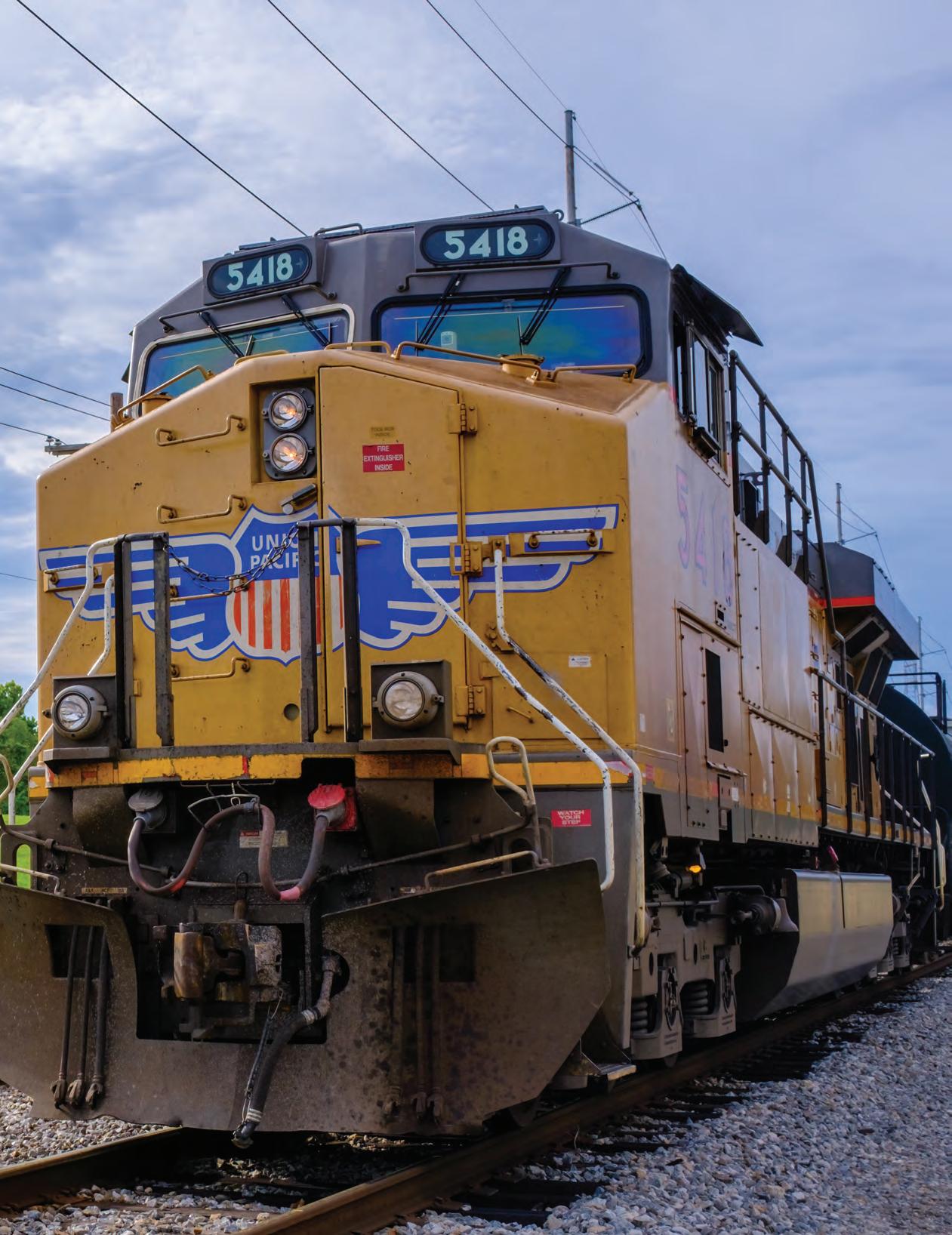
WE THRIVE.
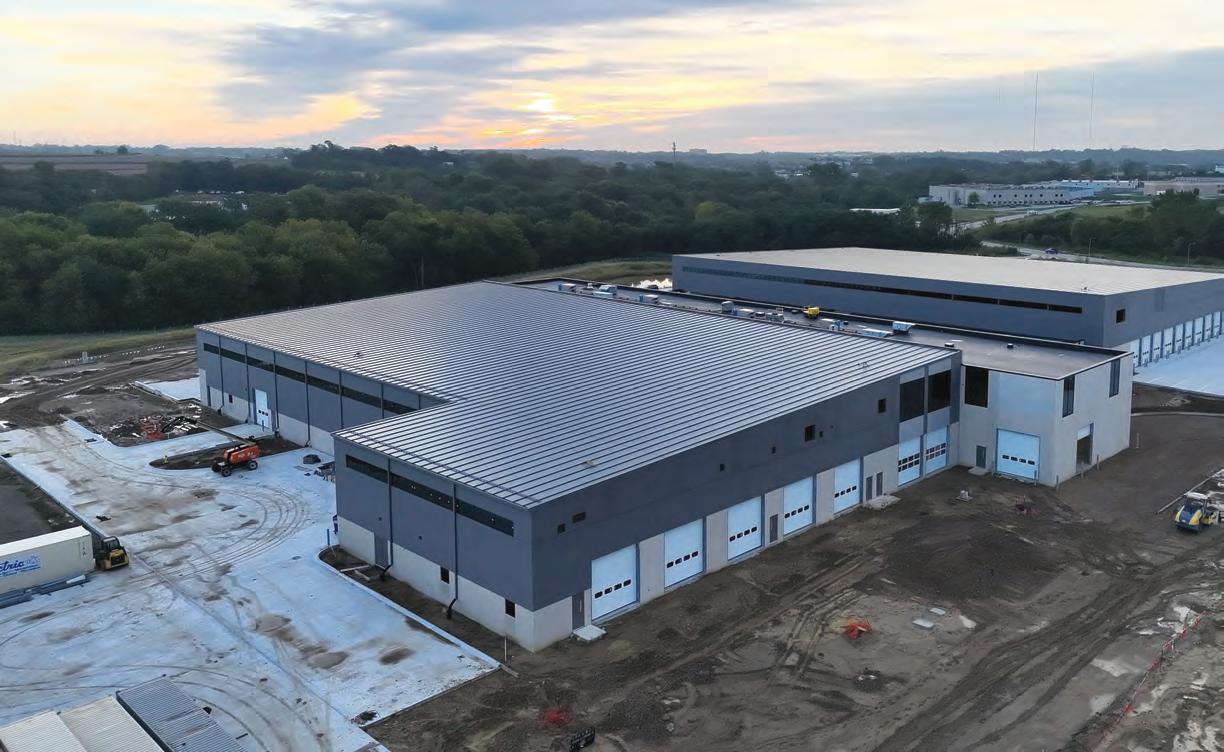
SPONSORED FEATURE
Delivering Reliability. Investing in Innovation. Strengthening Community.
At the Metropolitan Utilities District, our commitment goes beyond providing natural gas and water—we’re dedicated to strengthening the communities where WE THRIVE, work and play. Every day, we deliver safe, reliable and cost-effective services to more than 600,000 customer-owners, while preparing for the challenges and opportunities of tomorrow.
To support growth and ensure resiliency, we’re expanding with a second construction center. This investment enhances our ability to respond quickly, maintain business continuity and serve our community with excellence as demand increases. By modernizing infrastructure and investing in innovation, we’re building a stronger, more resilient system—one that safeguards today’s quality of life while laying the foundation for generations to come.
Our team of more than 900 employees is dedicated to the important work we do for our customers. They take pride in their contributions and recognize that our success is rooted in being a strong, reliable community partner.

M.U.D. is strengthening system resiliency by building a second construction center in northwest Omaha, scheduled to open in spring 2026.
M.U.D.’s dedicated crews are working to ensure access to safe, reliable and cost-effective natural gas and water to the community.

Balloons drop during Noon Year’s Eve at the Durham Museum. The museum celebrated its 50th year of operation this year. CHRIS MACHIAN

CREATING A GREATER OMAHA TOGETHER
People in Greater Omaha look to a future that’s rooted in a solid history of productivity and work ethic, following presentday career paths and making plans for coming generations.
Our economic philosophy calls for all people to succeed. The Chamber does not just talk about that. We support our growing population in work-life balance. We lead forwardthinking workplace development initiatives that open doors to opportunity in education, jobs, promotion, and leadership. We work to reward every person with the fruits of free enterprise, and those enterprises benefit in return.
Our businesses, new and established, are focused on making a bright future for newcomers of all backgrounds and ideas, as well as people who grew up being embraced by our community.
Greater Omaha businesses and their people grow and succeed in part because of the institutions our people have created. Vibrant public and private schools, comprehensive universities, visionary leadership, value-oriented philanthropists, inspiring cultural gems, and unique places — Omahans have created a backdrop for vital, impactful urban life.
Our Midwest traditions began with the basics of America
expansion: Riverboats and freight trains, farmers and ranchers, food processing and transportation. The bedrock of free enterprise in new lands.
As time passed, we adapted and created. We use the introduction of new technologies to create wealth. Our people found new ways of doing business, and our growing class of entrepreneurs is turning innovative ideas into reality every day. The Greater Omaha Chamber’s goals match our people, our businesses, and our future.
Now, Omaha’s metro area has a million people. Many have moved here from all over the country and the world, adding their new energy to the bustling economic scene set in place by those whose ancestors came generations ago.
When problems arise, our people find solutions. When new ideas are born, our people embrace them. When new ventures stride ahead, our people honor them. When new skills are needed, our people teach them. When new arrivals need help, we advance them.
Our people thrive, and Greater Omaha thrives in return.
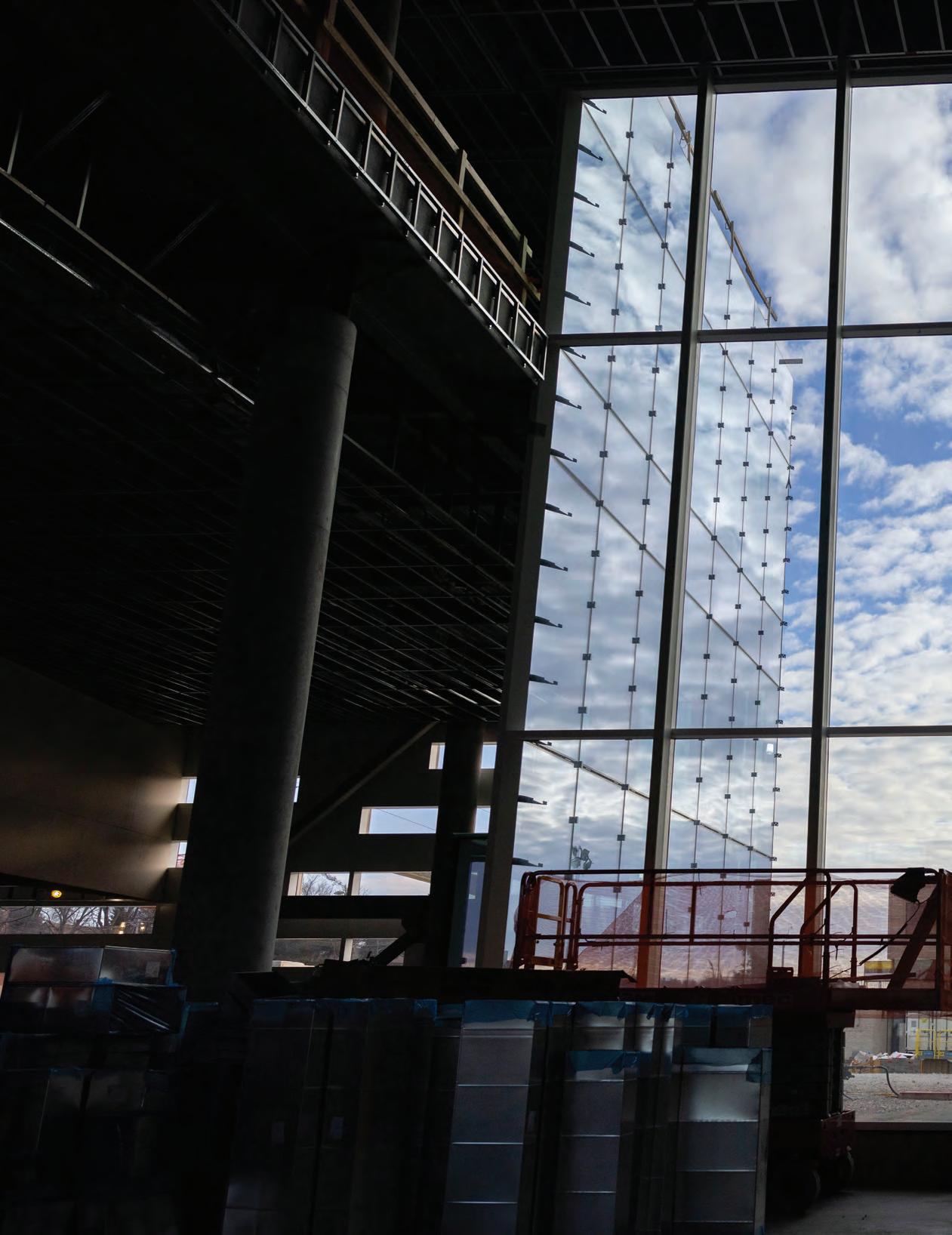
COLLABORATION UNDERPINS OMAHA’S ROBUST ECONOMY
Diverse Labor Supply Benefits Everyone
Economic development depends on people, as nutraceutical maker Vireo Resources knows.
People who are original thinkers.
Entrepreneurs who take risks.
Political leaders who work with visionaries, yet remain careful with taxpayer dollars.
Legislators who support business with incentives like training assistance.
Finance people who endorse others’ dreams.
Customers who want a better life.
For generations, such people have grown Greater Omaha’s economy by making businesses successful, from TV dinners to frozen steaks, railroads to insurance with a household name.
The Greater Omaha Chamber’s economic development efforts aim at bringing established businesses to town as well as encouraging home-grown ventures.
Progress is seen as construction continues on Omaha’s new Central Library at 72nd and Dodge Streets. This area will have the east entrance, a cafe space and a garden. MEGAN NIELSEN
“That works for the entire eight-county region,” said Alec Gorynski, the Chamber’s Senior Vice President of Economic Development. “It is much better to collaborate than compete with each other,” he said. Cooperation also helps with the labor supply, because Greater Omaha wants people living in all its communities to feel part of the entire metropolitan area, for work as well as leisure activities.
An ample labor supply helps a community grow, and that means people of all types. “Welcoming place” is not just a phrase but a business philosophy the Chamber believes benefits everyone.
In Cass County, Vireo Resources is one such success story.
After seven years of research, including collaboration with scientists at the University of Nebraska Medical Center, Mark Faulkner believed he had new nutritional supplements that could be commercial products.
He started Vireo — a Latin term related to health (think “vitality’’) — in Tennessee and in 2009 began production with a handful of employees in a small building in Plattsmouth, Nebraska.
“We’ve got Nebraska research producing Nebraska technology that formulates Nebraska products,” Faulkner said. “I thought, ‘Wouldn’t it be great if we had Nebraska people making those products in a Nebraska-based plant?’”
Faulkner grew up in Minnesota and learned about Nebraska mostly by watching Husker football on TV. “Then I fell in love with the business of science because my degree was in science,
but I didn’t want to go into graduate research or medical school.”
His interests led to work with researchers at UNMC. “ That technical firepower and the research resources helped develop what we have and yielded some fantastic innovations,” Faulkner said.
“We wanted it to yield Nebraska jobs and Nebraska homegrown products.”
Starting a new business is entirely different from creating a product.
“You have to have really good community networks and relationships, a people network to help make it happen,” Faulkner said.
Plattsmouth Mayor Paul Lambert, former city administrator Erv Portis, and state government staff put together an incentive package that laid the groundwork. Then-Gov. Dave Heineman helped cut a ribbon to open Vireo’s Nebraska building, with about 2,000 square feet of space.
State support included tax credits for training people in new job skills, since the production process was completely new. In 2026, Vireo expects to have more than 100 employees, and as many as 300 within five years.
Vireo now occupies more than 50,000 square feet and plans to expand. It has about two dozen supplement products on retailers’ shelves and twice that many in development.
“We pride ourselves on really good science,” Faulkner said.
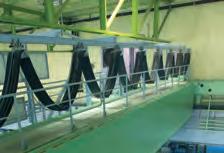
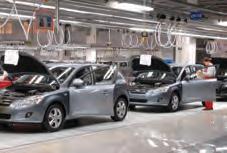


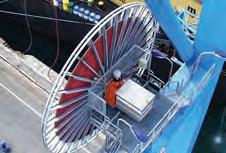
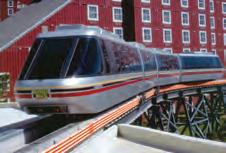

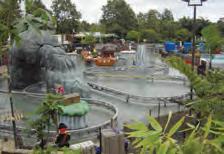
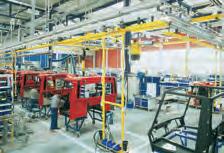

Once a company is up and running, he said, “it just gets down to having a work ethic with creativity to navigate through the ups and downs in the challenges, and the resolve and the perseverance that we’re going to make this work.”
Hiring people can be a challenge because of the Omaha area’s relatively low unemployment rate and high workforce participation — signs of a strong work ethic.
“The healthy job market really encourages us to do what we should anyway, which is to focus on culture and good compensation and good benefits,” Faulkner said. “We focus a lot on our core values. We train folks so they feel successful in their jobs.

“We top that off with making it a really good place to work and letting them participate in the success they’re helping support. We’re one of the few companies I know of that everybody, from top to bottom, participates in a really generous bonus program that is tied to how the company performs.
“We all work hard for success, and everybody gets to enjoy that success as if they were the owners. One of the reasons we’ve got outstanding employees and team members who have stayed with us for quite some time is because we take good care of them.”
Overall, Faulkner said, the Omaha business climate is very favorable.
“We have great team members,” he said. “It’s a great community that has embraced us. It’s through just simply a lot of hard work and determination.”
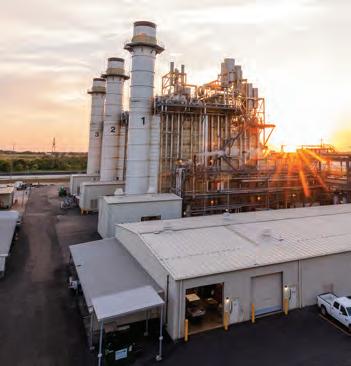




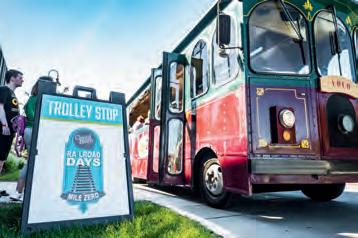
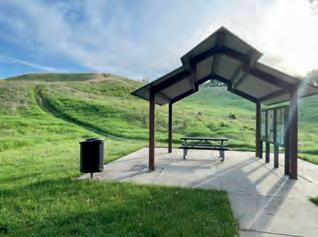
picture yourself in Council Bluffs
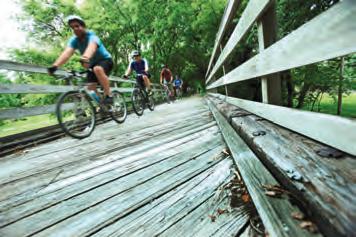
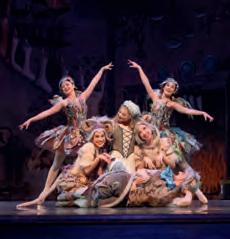
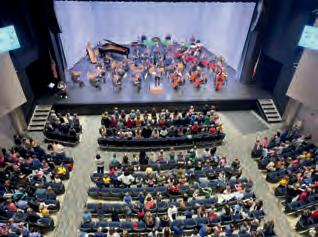
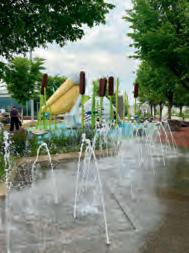
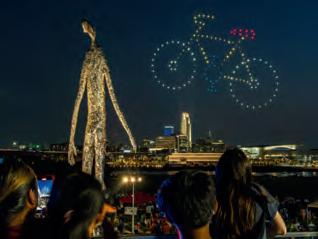
PROUDLY HEADQUARTERED IN OMAHA,

PROGRESS CREATES OPPORTUNITIES IN NORTH OMAHA
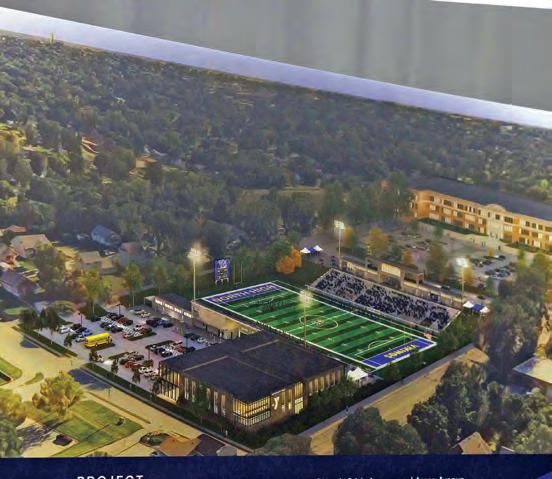
North Omaha – one of Omaha’s oldest parts of town – is a place where people can see progress in housing, commercial development, the arts, and life in general.
Among the goals: improved quality of life for residents, jobs, attractions for everyone, progress — in other words, North Omaha taking its place within the city’s range of growing, vital communities.
Investors, government, philanthropists, entrepreneurs, and homeowners are putting their resources into the part of Omaha roughly between Cuming Street and Sorensen Parkway, 72nd Street and the Missouri River.
Take a tour of North Omaha’s points of progress:
There is the Airport Business Park, which aims to attract businesses large and small to a unique site just minutes away from Eppley Airfield and downtown.
The newly formed Omaha Inland Port Authority, with jurisdiction over 3,000 acres of the land, is proposing an Innovation District. Funded by a $30 million state grant, it’s being coordinated by the Omaha investment group Burlington Capital and Omaha Economic Development Corp., which has been active in North Omaha development since 1977.
On the housing side, Habitat for Humanity of Omaha recently completed its $25 million, 85-family Bluestem Prairie neighborhood on the site of the long-vacant Wintergreen Apartments near 51st and Sorensen.
“Just believe in yourself -- never give up,” one of the new homeowners told KMTV. “Just know that you can do anything that you want to do for you, your family, your children. Just put your mind to it and just go with it.”
North Omaha Music & Arts is attracting performers and audiences (try Monday evening jazz sessions) to 24th and Lake Streets, the traditional center for Black culture and community life in Omaha.
Experienced musicians share the nightclub-style atmosphere with students earning their chops. A new music festival graces the spaces that were once a regular tour stop for Count Basie, Duke Ellington, and Ray Charles, among others.
Omaha North High School, built in 1924, is getting its first full-sized sports stadium, due to open in the summer of 2027 alongside a new Butler-Gast North Omaha YMCA at 34th Street and Ames Avenue.
Omaha philanthropists are supporting the project, appropriately titled “Game ON.”
Combined, the new stadium and the new Y “will enhance athletics and school engagement at North High while creating accessible, affordable health, wellness, and development opportunities for North Omaha communities,” the official announcement predicted.
The field and related facilities will be home to Viking football and soccer players, band members, drill teams, Junior ROTC cadets, and other students.
“Our students are amazing,” said Omaha School District Superintendent Matthew Ray. “For more than 100 years, North High has been a destination for academics, athletics, arts, and activities.
“We are thrilled to see the project take shape and are grateful for the generous support of our partners. This transformational effort benefits the entire student experience, boosting generations of Viking pride throughout our community.”
Separately, the privately funded Girls Inc. and its counterpart, NorthStar, offer after-school enrichment for boys and girls, with new facilities built in recent years.
The Highlander, a community created over more than a decade along the 30th Street corridor south of Lake Street, includes high-quality apartments, duplexes, and town homes with names like “The Heights,” “Nobility Point,” “The Rise,” and “Founders Row” — 310 residences in all The Highlander conference center aligns with open green spaces, recreation and retail options, high-speed Internet, a business center for startups, and more.
Designed along the lines of the “intentional communities” built in Atlanta and elsewhere, Highlander’s funding included $30 million in federal funding and millions more from private donors.
Its developers include Seventy Five North Revitalization Corp. and Brinshore Development, a Northbrook, Illinois, firm that works with public and private groups. Seventy Five North, named after 30th Street’s designation as part of U.S. Highway 75, said the heart of a community is its people.
“This belief shapes every aspect of our work,” the group’s web site says. “We strive to build a neighborhood where everyone feels heard, valued, and included. By actively listening to and collaborating with our community members, we aim to create a vibrant, supportive, and dynamic environment where everyone can thrive.”
The City of Omaha’s North Omaha Recovery Plan provides guidelines and coordination.
The president and chief executive officer of the YMCA of Greater Omaha, speaks during the announcement of Omaha North’s new football stadium. MEGAN NIELSEN
“The future of North Omaha and its people is tied to economic development, creating the opportunities that will help the community’s residents and businesses participate fully in the growth and dynamism of the metropolitan area,” the plan says, adding:
“The North Omaha Development Project is the first step in what will be both a long and rewarding journey for North Omaha and the entire Omaha community.”

Anewmusicfestivalgracesthe spacesthatwereoncea regulartourstopforCount Basie,DukeEllington, andRayCharles, amongothers.
CivicSquareaimstocreatea live-work-playenvironment thatencouragespeople tostaydowntownrather than commute elsewhere.
CIVIC SQUARE TO REWRITE THE DOWNTOWN STORYLINE
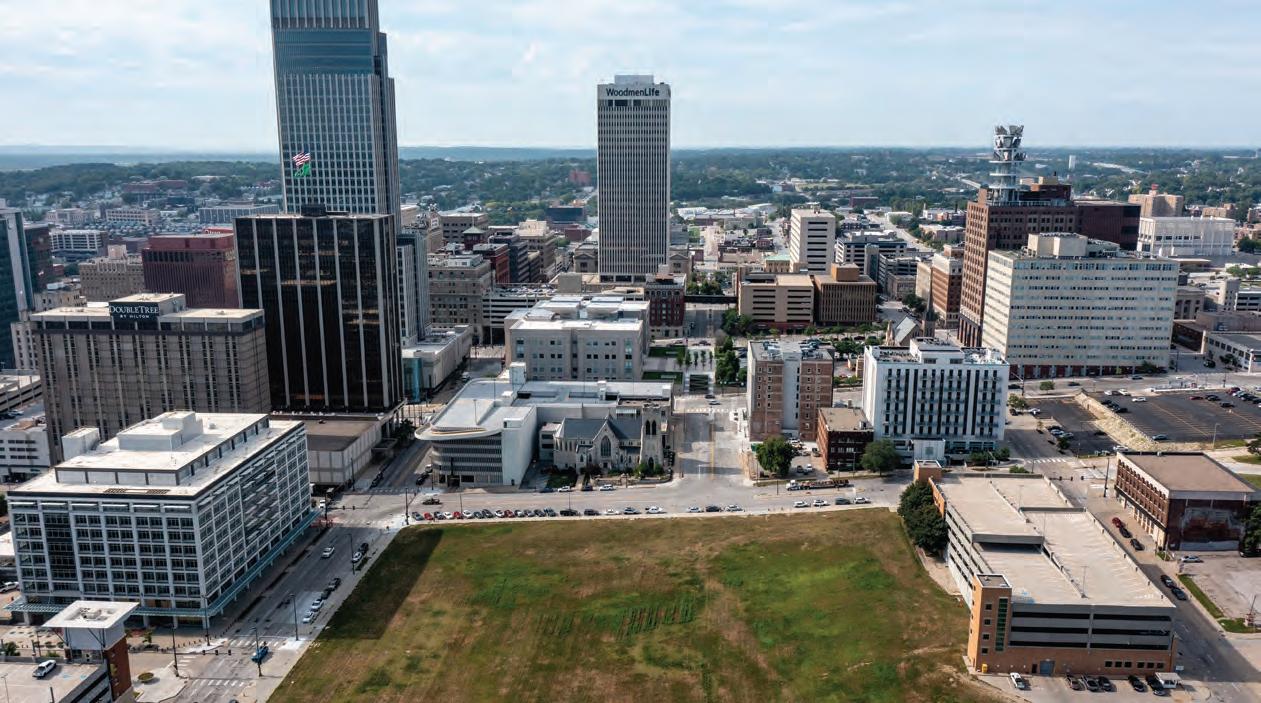
During its more than 60 years of entertainment, the Civic Auditorium provided Omahans with many special memories. People of all ages visited for concerts, Broadway shows, NBA and Creighton basketball, top comedians, UNO hockey, Omaha Beef football, circuses, graduations, and the 1988 vice presidential debate.
Even Elvis Presley played to a sold-out crowd of almost 11,000 at the Civic in June 1977 – several weeks before his death.
When the auditorium was demolished in 2016, plans were announced for the property – bounded by 17th and 19th Streets, Capitol Avenue, and Chicago Street – to be repurposed for an equally important function. It would be a mixed-use development that would benefit downtown but also nearby Creighton University and North Omaha.
Omaha-based developer White Lotus Group wants to transform the 9-acre site into an urban neighborhood. Arun Agarwal, CEO of White Lotus, identifies the project – aptly named Civic Square – as one of the most ambitious and transformative urban developments in Omaha’s recent history.
“Our latest version aims to help with several of the missing components of Omaha’s downtown revitalization plan and will actively contribute to building a strong urban core,” Agarwal said. “Distinct signage and impressive architecture will make southward images of downtown iconic, and embody the growth and innovation our urban core is experiencing.”
The vision includes:
• A national grocery store to address downtown’s food desert
• Affordable and market-rate housing (initially around 200 units)
• A five-story office and retail building
• Health and wellness facilities
• Reintroduction of 18th Street and parts of Davenport Street to improve connectivity
• 180 new on-street parking stalls plus a 500-stall garage
• Distinct architecture and signage to reshape Omaha’s skyline
The design drew inspiration from vibrant urban districts like Aggieville (Manhattan, Kansas), Wrigleyville (Chicago), and the Haymarket (Lincoln) – aiming to create a walkable, accessible, and culturally rich destination.
Agarwal has stated that while they want to be held accountable, they’re avoiding setting firm dates for completion to ensure thoughtful, community-driven decisions.
“Civic Square will offer urban residents and workers the lifestyle they want downtown – a destination they can walk to or park at easily, a place to buy groceries, work out, shop, dine, and convene with friends.”
Civic Square aims to create a live-work-play environment that encourages people to stay downtown rather than commute elsewhere.
While no firm completion date has been set, Agarwal offers assurances that updates will become more regular as civil infrastructure progresses over the next few quarters. Work to prepare the site for construction was beginning in fall of 2025.
Agarwal believes the project will reshape Omaha’s streetscape and appeal to new residents.
“We think that this site is an integral part of the pitch that one might make to a prospective migrant into our city or a potential Creighton graduate staying in our city,” he said.
ONE FOR OMAHA. One for you.

More than 20 locations in and around town. Stop on by.
Nebraska Medicine is the primary clinical partner of the University of Nebraska Medical Center (UNMC), which is Nebraska’s only public academic health science center.
ADOBE STOCK IMAGES
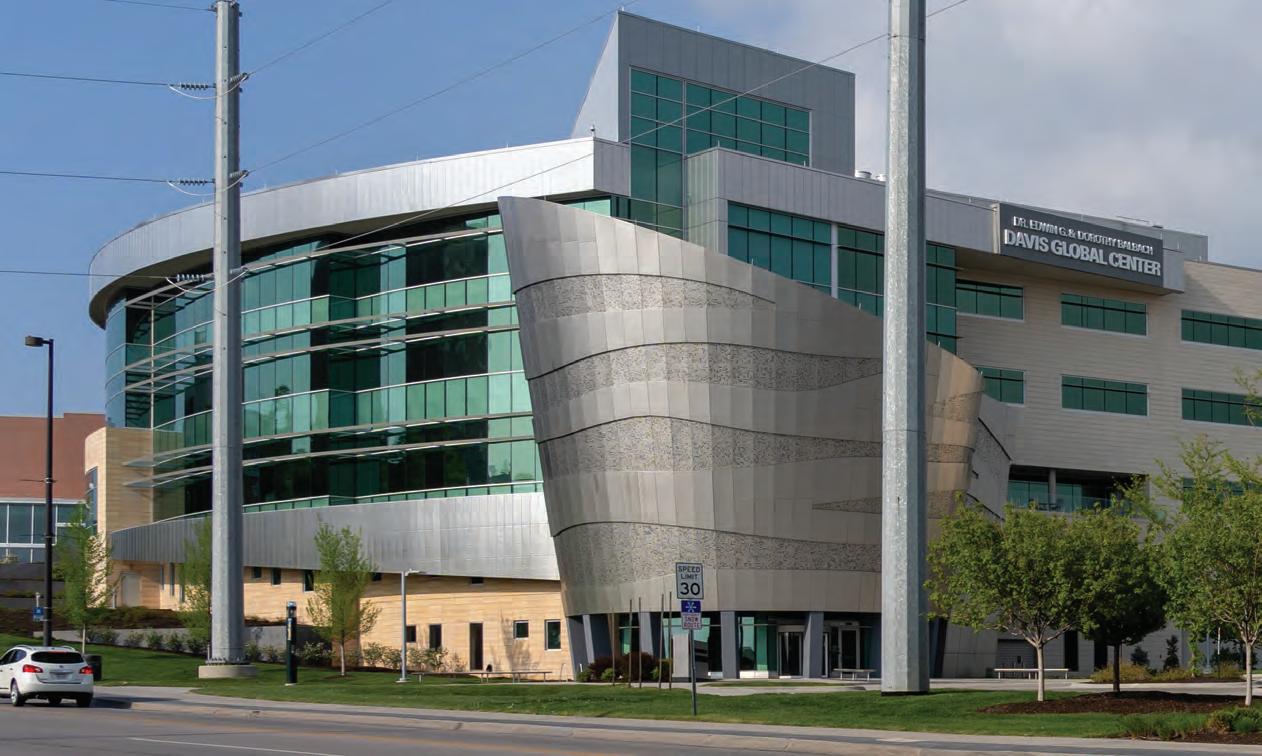
Dele Davies, University of Nebraska Medical Center interim chancellor, understands the responsibility UNMC and Nebraska Medicine have to the state of Nebraska.
For him, UNMC’s Project NExT, a visionary plan to build a state-of-the-art health care facility on UNMC’s Omaha campus, reaches beyond the physical buildings into the homes and lives of people it serves – as well as the Nebraska hospital system.
“UNMC and Nebraska Medicine’s paramount responsibility is to improve people’s lives in Nebraska and beyond,” Dr. Davies said. “We educate the next generation of health professionals and medical scientists, discover and develop lifesaving cures and treatments, and provide extraordinary care to our patients.’’
UNMC is undergoing a historic transformation through Project NExT – short for Nebraska Transformation – a multiphase initiative designed to redefine health care education, research, and delivery across the state.
At the heart of this effort is Project Health, a $2.19 billion expansion that will dramatically enhance UNMC’s facilities and services while addressing critical workforce shortages and improving access to care for Nebraskans statewide.
Project NExT represents the largest public-private partnership in Nebraska’s history and is set to become a cornerstone of the state’s health care future.
“The existing facilities, now over 70 years old, were not designed for learners to gain vital clinical experience nor for researchers to optimally administer breakthrough clinical trials,” Dr. Davies said. “Project Health is being built with these goals in mind, so we truly can fulfill our mission to create a healthy future for all individuals.”
Improving Health Care Education
The new center will serve multiple roles. It will be a clinical learning center for training future health care professionals, a hub for cutting-edge medical research and clinical trials, and a modern inpatient hospital with over 550 beds, designed to meet growing patient needs.
Project NExT will educate the next generation of Nebraska’s health care workforce and those responding to infectious disease, advance research, and provide patients with the best quality care possible in a state-of-the-art environment.
“Project Health is a highly ambitious effort which will significantly help rural and urban Nebraska communities maintain a growth trajectory for health professions workforce, highly relevant clinical research and care for generations to come,” said University of Nebraska System President Jeffrey Gold.
Cumulatively, 56% of practicing physicians, dentists, pharmacists, and physician assistants in Nebraska were trained at UNMC. Each year, more than 3,000 people train at Nebraska Medicine clinical locations.
Project NExT is expected to increase enrollment across all health professions, helping to address Nebraska’s shortage of nurses.
“To meet both the needs of rural and urban areas of our state, UNMC must grow professional learner enrollment by 20 to 25%,” Dr. Davies said. “This will be possible only with significant improvement of our physical environment.”
Strengthening Health Care
One of the most transformative aspects of Project NExT is its commitment to rural health care.
PROJECT NEXT: Transforming Health Care in Nebraska & Beyond
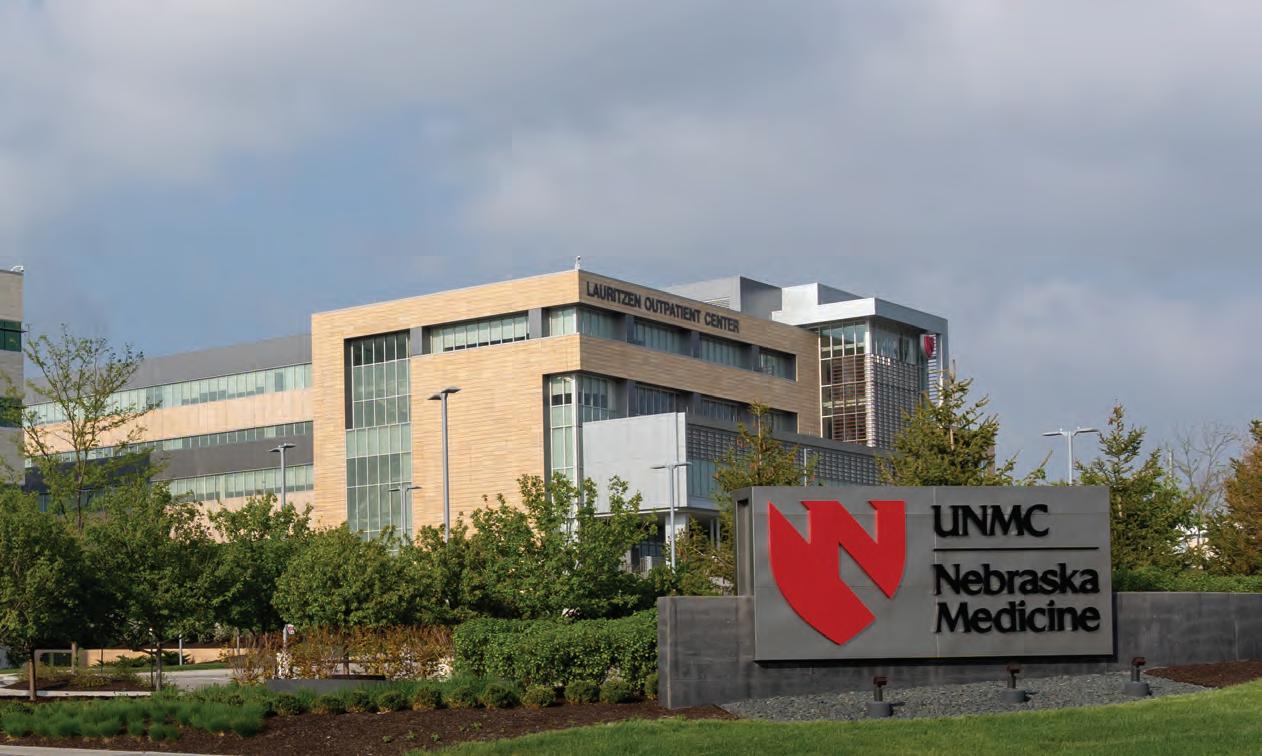
Eachyear,morethan 3,000peopletrain at Nebraska Medicine clinical locations.
UNMC will educate more physicians, pharmacists, and public health professionals in rural Nebraska. Expanded clinical rotations in rural hospitals will prepare students for practice in underserved areas.
It will also support rural education initiatives, including the Kristensen Rural Health Education Complex at the University of Nebraska at Kearney, which will host nearly 700 learners at full capacity.
This initiative is expected to increase the number of graduates who choose to work in rural communities – a critical need, as many counties in central and western Nebraska lack primary care providers.
Project NExT also will dramatically enhance Nebraska’s capacity for biomedical research and clinical trials. The facility will host world-class scientists conducting research on infectious diseases, cardiovascular conditions, cancer, and more.
Increased access to clinical trials will improve patient outcomes. For example, leukemia survival rates have risen due to trial participation. The goal is to ensure every patient has the opportunity to benefit from cutting-edge treatments.
NExT Ahead
The ripple effects of Project Health will be felt far beyond the walls of the hospital. Over the course of construction through 2033, the initiative is projected to generate $3.2 billion in economic impact, with an annual contribution of $1.5 billion once complete. It will support 4,272 additional jobs directly and indirectly, and generate $39.4 million in state tax revenue.
The project is projected to provide 32,000 temporary construction jobs and nearly 9,000 permanent positions statewide.
While Phase 1 has already begun, plans for Phases 2 and 3 will continue to solidify the future of health care throughout the state. Phase 2 will expand facilities for key regional partnerships, while Phase 3 will potentially create a joint civilian-military medical surge facility through additional public-private partnerships
As the project unfolds, Nebraska will not only meet its current health care challenges but also emerge as a national leader in medical education and innovation.
“UNMC always strives to be the preeminent health education institution in our nation; this initiative ensures that our clinical learning spaces are conducive to modern health education, and it will provide for dramatic expansion of facilities for clinical/ translational research, which our current and future students and residents require,” Dr. Gold said.
“Furthermore, this new facility will provide more health care workforce for Nebraska and beyond, something that is desperately needed in rural and urban communities across the state.”
TOMORROW STARTS TODAY



THE GREATER OMAHA ADVANTAGE
The Greater Omaha region stands at the heart of America’s economic crossroads—an interconnected landscape of innovation, industry, and opportunity spanning more than 4,000 square miles across eastern Nebraska and western Iowa. United under the Greater Omaha Economic Development Partnership, eight counties in two states work as one: Cass, Dodge, Douglas, Mills, Otoe, Pottawattamie, Sarpy, and Washington. This collaboration is built on a simple belief: when one part of the region succeeds, the entire region grows stronger.
Here, more than one million residents call Greater Omaha home, drawn by its balance of city energy and small-town character. The region’s range – urban, suburban, and rural – creates a dynamic environment where Fortune 500 companies thrive alongside start-ups, family farms, and advanced manufacturers. From financial services and technology to agriculture and food processing, Greater Omaha’s economy is both broad and resilient, designed to weather change and propel growth through collaboration, innovation, and a shared sense of purpose.
Businesses choose Greater Omaha for its stability and affordability. The region’s infrastructure – anchored by two major interstate systems, extensive rail networks, and some of the lowest utility costs in the nation – makes it a natural hub for logistics and industry. With more than a dozen GO-Ready sites and two megasites exceeding 1,500 acres, Greater Omaha offers room to expand and the confidence of shovel-ready opportunity.
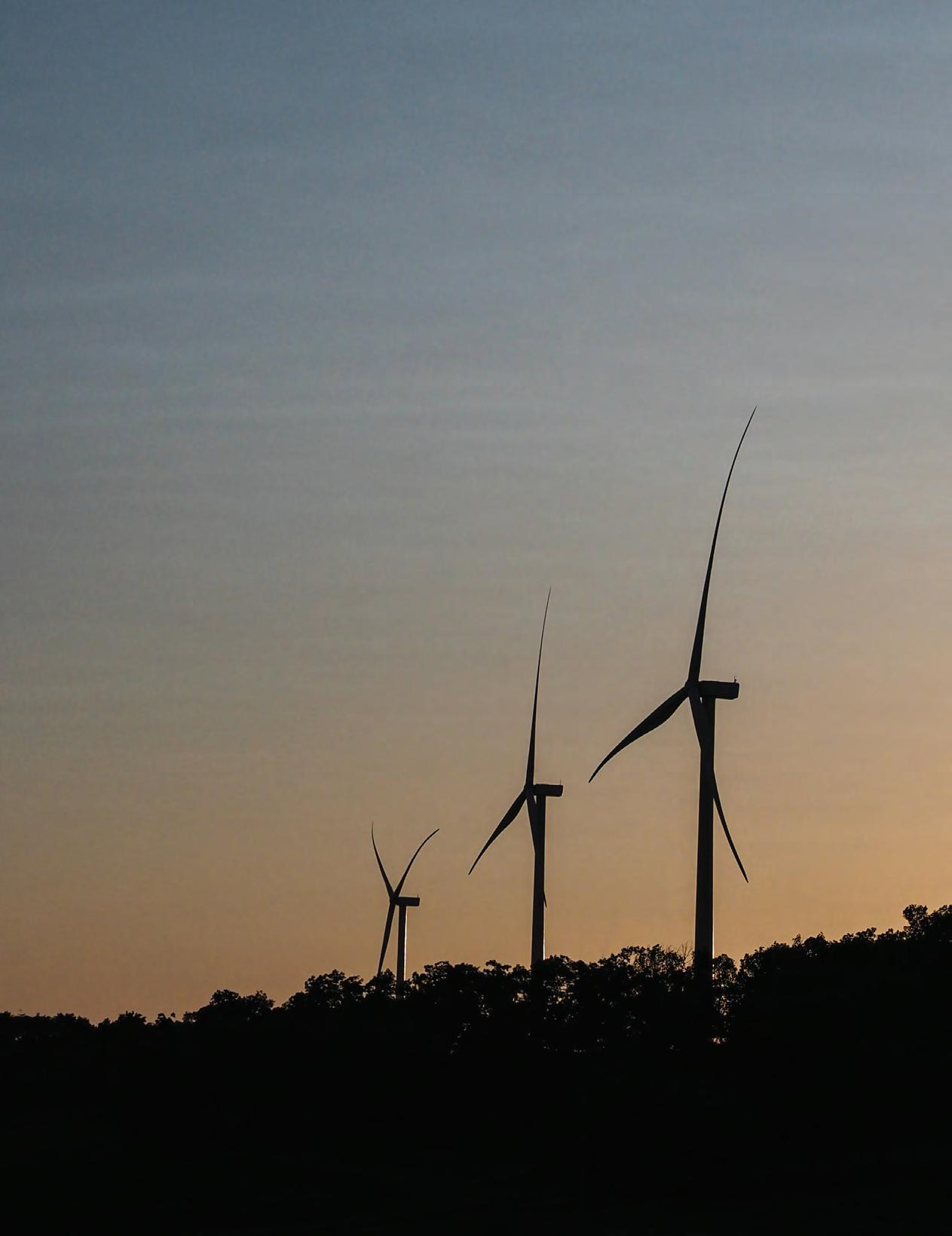
Fromtheenergy of the Urban Core to theopenlandscapesofthe countryside,GreaterOmaha offerseveryadvantage.

That same forward momentum is mirrored in the region’s workforce. Fueled by a network of universities, colleges, and technical programs graduating 25,000 students annually, this young yet experienced workforce reflects Greater Omaha’s recognition as one of the nation’s hardest-working metro areas.
Quality of life is often cited as Greater Omaha’s crown jewel. The cost of living is eight percent below the national average, and housing costs are 22 percent less, making it easier for families to enjoy exceptional schools, top-tier healthcare, and cultural amenities that rival the nation’s largest cities. From the energy of the Urban Core to the open landscapes of the countryside, Greater Omaha offers every advantage – an extraordinary region where collaboration drives prosperity, opportunity is built into the landscape, and life truly is great.

SARPY COUNTY
County seat: Papillion
County Description: Sarpy County, located immediately south of Omaha, is Nebraska’s fastest growing county and one of the state’s leading centers for business expansion. With over 200,000 residents, the county includes the thriving communities of Bellevue, Papillion, La Vista, Gretna, and Springfield. Its proximity to Omaha, strong transportation links, and growing workforce make Sarpy an essential part of the metro’s business ecosystem.
Largest employers include: Offutt Air Force Base, Amazon, Papillion La Vista Community Schools, Werner Enterprises, Kiewit, Google
MCC to Develop New Full-Service Campus
Nebraska’s largest community college – Metropolitan Community College – started development on its new 144-acre campus in Sarpy County, located near the interchange of Nebraska Highways 50 and 370, in 2025.
It will be a mixed-use site offering academic and employment opportunities for students as well as housing, retail, and dining options for the surrounding community.
This development marks MCC’s first new permanent campus since 1980 and will be its fourth full-service campus within Sarpy, Dodge, Douglas, and Washington Counties. The space will develop in phases contingent on partnerships, funding, and community needs.
“The Sarpy County Campus will be completed the ‘MCC Way’ – partnering with local and regional employers, K-12 educators, nonprofits, philanthropic leaders and the broader community to shape a campus that prepares students for the possibilities of tomorrow,” MCC President Randy Schmailzl said.
The community college has had a smaller Sarpy Center location since 1999 and acquired the property for the current project in 2015. Following significant population growth and development in the surrounding area, MCC jump-started construction.
Nate Barry, MCC vice president for strategic operations and initiatives, said MCC is envisioning some of the Sarpy County Campus coursework and facilities to be centered on first responder training and the transportation, distribution, and logistics industry.
Other subjects being considered include advanced diesel technology and hospitality and restaurant leadership. He said MCC seeks to partner with established companies in the area, such as Werner Enterprises, as well as the businesses, restaurants, and hotels that eventually build on the property. MCC will gather feedback from surrounding stakeholders on what types of skills and resources would benefit them.
It is estimated that it will take 15 to 20 years to complete the project.
Sarpy County and all of its cities are on the move and growing but keep that hometown feeling with great communities, parks, and excellent public places to enjoy with your family! We are home to the best schools in the region, and with an open and accepting environment! And it is our honor and privilege to have the United States Strategic Command, Offutt Air Force Base, Facebook, Google, and Amazon call Sarpy County ‘HOME.’ Go Sarpy Go!
– Timothy J Burke, president, Offutt Community Development Corporation
Nebraska Medicine to Anchor Gretna Project
A new Nebraska Medicine health center will anchor a planned 31-acre, approximately $200 million mixed-use project now under development along Nebraska Highway 370 in Gretna.
The 125,000-square-foot health center, which represents an $88 million investment, will include a primary care clinic, imaging and laboratory services, procedure rooms, and an advanced urgent care.
Other services are yet to be finalized, but could include orthopedics and sports medicine, given the center’s proximity to a nearby youth sports complex. Neurology and outpatient physical and occupational therapy are other options.
“It’s all a part of our commitment to make sure we have a wide array of health care services available in the metro area,” said Dr. James Linder, Nebraska Medicine’s CEO at the time of the announcement.
The project west of 192nd Street and north of Cyprus Drive is being developed by Noddle Companies. That development, in turn, is part of the larger 132-acre Gretna Landing development.
Linder said Nebraska Medicine has clinics in Sarpy County in the Chalco, Brentwood, and Twin Creek areas as well as a health center in Papillion but nothing yet in the Gretna area.
The new location also will allow the health system to tap the area’s employee base. The health center will employ about 70 people when it opens and 100 when it identifies all the services it will offer.
POTTAWATTAMIE COUNTY
County seat: Council Bluffs
County Description: Pottawattamie County lies just across the Missouri River from Omaha and serves as both a suburban and rural complement to the metro area. With about 90,000 residents across 13 communities, the county’s largest city, Council Bluffs, plays a major role in the region’s growth. The River’s Edge district in Council Bluffs is considered part of Omaha’s urban core, offering mixed use development and modern riverfront space for employers and residents alike.
Largest employers include: CHI Health Mercy Council Bluffs, the Council Bluffs Community School District, Google Data Center, Southwest Iowa Renewable Energy
New Housing Surges Across Council Bluffs
A housing boom in Council Bluffs, Iowa, is reshaping the landscape of Pottawattamie County.
With a mix of completed, active, and planned developments, the city is tackling its housing shortage head-on – bringing new life to underutilized areas and expanding opportunities for residents across income levels and ultimately improving the quality of life.
“Our community’s commitment to housing is a long-term effort,” said Mayor Matt Walsh. “When we set the goal in 2022 of creating at least 1,300 housing units in 10 years, we knew it would take partnership and vision.
“Today, with more than 800 new units already completed or under construction, it’s clear we are on the right track. The development community recognizes Council Bluffs as a place that prioritizes housing and supports growth, and that’s a testament to the hard work happening here.”
Along with single and multi-family projects completed over the past two years – namely the Ridgeline, Hillside Estates, the Row on First, and the Archive (the city’s former post office) – one of the most important projects is the multi-family Treehouse project which is adjacent to the 1st Avenue Trail and future multi-modal transit corridor.

When all parts are completed, the Treehouse will provide 224 units – one of the largest new developments in town. The first phase, with 90 units, is under construction. The two other phases are targeted for completion in 2028.
Among the projects aiming for completion this year are the 186-unit South Pointe Apartments. Those aiming for completion in 2027 include Union at Bluffs Run, which will have 192 units.
Two of the bigger projects in development are ones by Cornerstone (280 units) and Lockwood Development (264 units).
In addition to these developments, Council Bluffs secured a $6.87 million Community Development Block Grant Disaster Recovery (CDBG-DR) to fund an additional 40 affordable, owner-occupied housing units in the East Manawa Subdivision. This area is part of a larger housing effort in that City officials estimate this could catalyze the creation of 500 to 700 additional units, addressing a critical housing shortage. The city is also leveraging funds from the American Rescue Plan of 2021 to acquire land and build infrastructure, aiming to broaden the tax base and reduce property taxes over time.
“Housing is the foundation of Council Bluffs’ continued economic development success,” said Paula Hazlewood, chief executive officer of Advance Southwest Iowa Corporation. “As we compete for new businesses, attract top talent, and retain a thriving workforce, having diverse, high-quality housing options is absolutely critical.
“Council Bluffs continues to lead with vision and creativity — transforming neighborhoods, driving new development, and building a community that is not only competitive and welcoming today, but also poised for enduring success in the years ahead.”
I was living in Arizona and chose to move back to Council Bluffs to be closer to my family after my husband died. When I came back, I spent a while trying to find the best apartment for me. Then I stumbled upon the Ridgeline. They are modern and updated compared to what I was finding, and the quality of the complex was unlike any around so I chose to make it my home!
– Sally Hannaford of Council Bluff
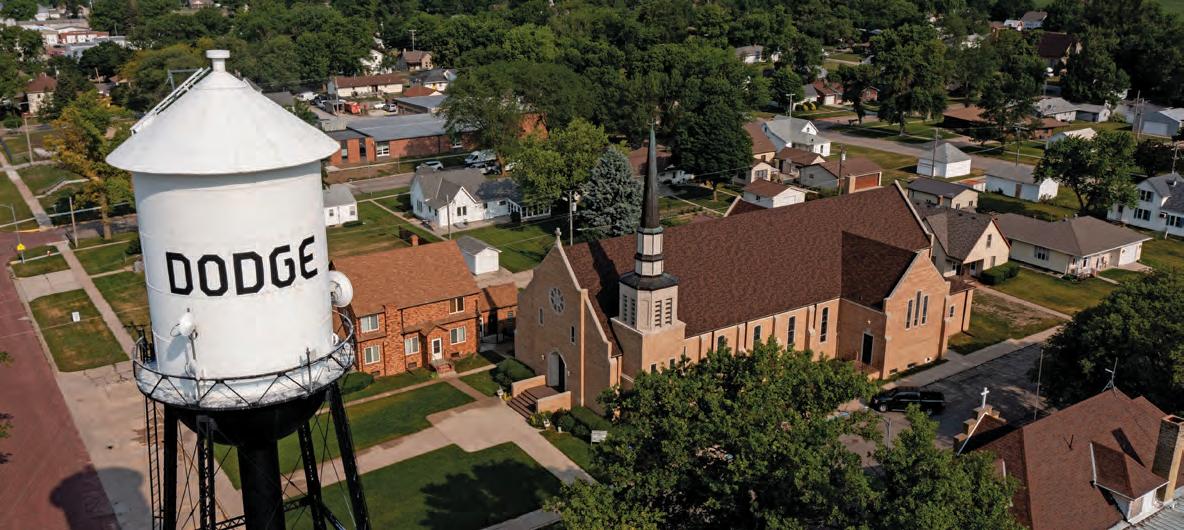
The ripple effect of these projects extends beyond Council Bluffs. As the county’s largest city, its housing initiatives directly influence Pottawattamie County’s overall housing stability.
Increased inventory helps ease pressure on surrounding communities, supports workforce retention, and attracts new residents. Mixed housing options – ranging from singlefamily homes to townhouses and apartments – create more opportunities, while infrastructure upgrades improve livability across the county.
“Council Bluffs has taken innovative and proactive steps to expand housing opportunities, recognizing the need for homes at all income levels,” said Debi Durham, director of the Iowa Economic Development Authority and Iowa Finance Authority. “That vision is critical as we work to recruit new Iowans to our communities and ensure that every Iowan has the opportunity to live near where they work.”
DODGE COUNTY
County seat: Fremont
County Description: Dodge County sits just northwest of Omaha and serves as a major center of business and manufacturing activity. With nearly 37,000 residents, it combines metropolitan access with small city affordability. Fremont, the county’s largest city, has become a destination for industrial investment thanks to its infrastructure, available sites, and pro-business leadership. Companies locating here benefit from a collaborative environment, strong utilities, and a community eager to support growth.
Largest employers include: Wholestone Farms, Methodist Fremont Health, Fremont Public Schools, Lincoln Premium Poultry, Midland University
Fremont Inland Port Earns Union Pacific Focus Site Status, Marking Major Milestone for Nebraska Logistics
A major step forward in Nebraska’s logistics and industrial development has arrived in Fremont.
The Fremont Municipal Inland Port has officially been named
a Union Pacific Focus Site — a designation that highlights shovel-ready rail-connected properties across the railroad’s 23-state network. The recognition positions Fremont as one of the Midwest’s premier locations for logistics and manufacturing, giving companies confidence in speed, infrastructure, and development readiness.
The Fremont site includes more than 1,600 acres of flat, developable land with direct access to Union Pacific’s mainline. Established in 2021, the Fremont Municipal Inland Port Authority was one of Nebraska’s first five inland port authorities. Its mission: to create a high-impact logistics and industrial hub that leverages Fremont’s strategic location and transportation assets.
– Dr. Brad Dahl, Superintendent, Fremont Public Schools
Union Pacific’s Focus Site program is designed to accelerate Fremont High School’s Career & Technical Education Center gives students direct access to real-world skills and technology they’ll use in their future careers. In labs that mirror today’s workplaces, our students earn industry-relevant skills, college credit, and the confidence to step into the workforce or further education. By connecting learning to real projects and local employers, we’re preparing graduates who are ready to contribute and succeed in the Fremont community.
“This is a monumental step for Fremont’s economic future,” said Fremont Mayor Joey Spellerberg. “We are pleased to have our inland port recognized as a Union Pacific Focus Site. It brings us closer to realizing the full potential of our infrastructure, location, and community partnerships to attract quality investment and jobs.”
development by vetting locations for key factors such as rail design, utility access, and infrastructure readiness. Sites receive pre-approved rail layouts and streamlined utility planning — a process that removes uncertainty for potential investors and site selectors.
“This designation dramatically enhances our ability to market Fremont as a logistics-ready, industrial-ready destination,” said Megan Skiles, President of the Greater Fremont Development Council (GFDC). “With Union Pacific’s pre-approved rail access and our own strategic investments, we can now offer companies speed, certainty, and efficiency.”
The inland port has already benefitted from strategic public investment. In 2022, the City of Fremont received a grant through the Nebraska Rural Projects Act to fund engineering studies, infrastructure planning, and site readiness efforts. That work — combined with the Union Pacific Focus Site designation — has accelerated Fremont’s trajectory toward becoming one of Nebraska’s most development-ready industrial sites.
“The Fremont Inland Port’s designation as a Union Pacific Focus Site is exactly the type of forward-looking planning Nebraska needs,” said former Nebraska Governor and current Fremont Municipal Inland Port Authority Board Chair Dave Heineman.
“It strengthens our state’s competitive position in logistics, supports rural and urban growth alike, and ensures Fremont plays a leading role in building Nebraska’s economic future.”
The designation aligns directly with Fremont’s Here We Grow 2030 initiative — a regional strategy focused on attracting industrial and logistics projects that create jobs, expand the local tax base, and strengthen economic resilience.
With development-ready land, utility planning, and rail access in place, Fremont leaders say the city is ready to welcome companies seeking a reliable, centrally located hub for distribution and manufacturing.
As Nebraska continues to strengthen its logistics and industrial ecosystem, Fremont’s inland port stands out as a model for how infrastructure investment and public-private collaboration can drive long-term growth — both for eastern Nebraska and the entire state.
New Center Trains Students in Trades
Fremont Public Schools’ $9.5 million state-of-the-art Career and Technical Education Center opened its doors in fall 2024

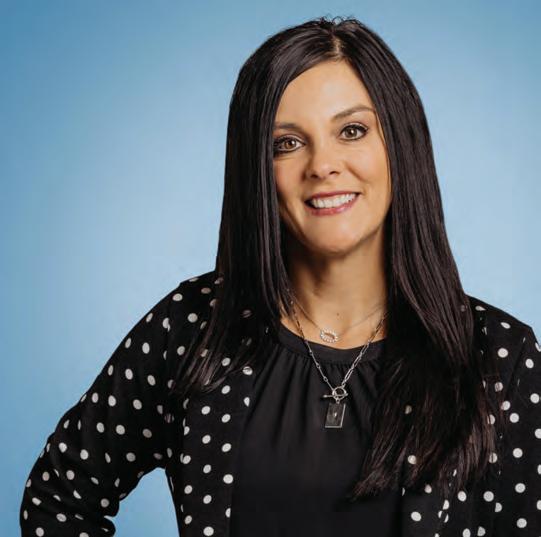
Personal service with a growth mindset
As your business grows, so does the need for efficiencies, improved cash flow, mitigating fraud — the list goes on. That’s why now is the perfect time to bring in a treasury management expert like Carrie. She’ll figure out what you need and what you don’t, then craft solutions to help your business thrive. How can we help you move forward? Contact Carrie today. Carrie
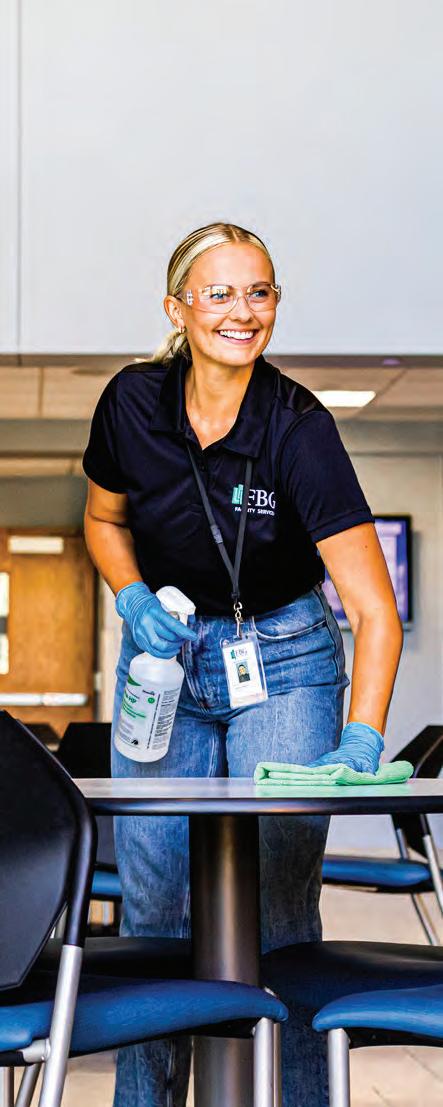
– operating with a solid vision to prepare the up-and-coming “toolbelt generation” for rewarding careers in the trades.
The Greater Fremont Development Council recognized the center for creating a pipeline of talented students to work in local industries.
Brad Dahl, the new superintendent of Fremont Public Schools, said the new center allows students to earn the skills, college credit, and confidence they need.
Mark Shepard, Dahl’s predecessor before he retired last summer, identified welding, automotive, diesel, automation/ robotics, computer design/manufacturing, construction, and health occupations as areas that allow individuals to grow in their trade as far as they want.
“We used to talk about many of these areas as ‘jobs,’” Shepard said. “Today, they position a student for a career with the opportunity for upward mobility. These areas are challenging and rewarding and pay well, leading to long-term job satisfaction.”
The 39,000-square-foot facility, designed by BVH Architecture and constructed by Hausmann Construction, contains six labs that immediately began humming. Students can take advantage of on-site training offered in collaboration with Metropolitan Community College that spans seven career fields: welding, auto tech, diesel tech, construction tech, health sciences, computer-aided design, and mechatronics.
The dual-enrollment classes also give students the ability to earn college credits while still in high school. Classes are taught by Fremont and MCC instructors.
Over 50 area businesses and individuals committed over $2 million to fund the project. In-kind donations over the next five years will bolster the center’s sustainability fund, covering operating expenses and equipment upgrades.
“The future of their workforce and meeting the challenges presented by an aging workforce and more skilled positions to fill creates a win-win-win for our students, local industry, and our community,” Shepard said.
Fremont to Improve Power Grid Resiliency
The City of Fremont was among 15 power providers in Nebraska to win grants in 2025 to support resiliency in their power grids.
The $1.9 million grant will help the city separate two transmission lines that currently follow the same path –eliminating the possibility of a single incident knocking out both of them and causing a significant power disruption. One of the transmission lines will be moved further east, near Highway 275. Those poles will be made of iron, not wood like the ones on Luther Road.
“Any time you can have multiple transmission paths, and diversification amongst your transmission paths, just gives us a better opportunity to keep the lights on more often and longer,” said Nate Royuk, the city’s director of transmission and distribution.
The project is expected to be complete no later than early 2028.
CASS COUNTY
County seat: Plattsmouth
County Description: Cass County lies just south of the Omaha metro area, offering the tranquility of rural Nebraska with easy access to the state’s two largest urban centers, Omaha and Lincoln. With over 27,000 residents across 15 communities, Cass balances small town character with forward looking development. Plattsmouth anchors the area with a historic downtown which plays host to a variety of annual events, and is home to a growing manufacturing base paired with a variety of new housing options. The county’s location along major highways and interstate access gives companies convenient connections to regional markets while offering a lower cost, high quality environment for investment.
Largest employers include: Mahoney State Park, Hy-Vee Plattsmouth, Ash Grove Cement, Liquid Trucking Companies Upgrades Will Please Kiewit Lodge Guests
Peter Kiewit Lodge – the “crown jewel” of Eugene T. Mahoney State Park – had a significant remodel in 2025.
The park is Cass County’s largest employer.
The heating, ventilation and air conditioning in all 40 lodge rooms – most of which overlook the Platte River Valley – have been replaced, providing a modern cooling and heating system for each room.
Dated systems controls were replaced with modern ones to ensure guest comfort. Additional improvements include renovated bathrooms, updated furniture, and new siding on the north side of the lodge.
A roofing project is ongoing at the lodge. The iconic green roof’s asphalt shingles are being replaced with composite shaker-style shingles.
A sewer system improvement project at Mahoney made critical infrastructure upgrades.
An Americans With Disabilities Act-compliant entrance and parking upgrade at the lodge are in the design phase. A new front entrance sidewalk and ADA parking spaces will be added to the north side of the lodge’s main entrance. Construction will be completed in phases to avoid any closures to the lodge or Carl’s at Mahoney restaurant.
Still early in the development and funding stages is a waterway
One of my favorite things about Historic Plattsmouth is the ability to step back in time and immerse oneself in the charm of a bygone era. Each December our historic community creates that special moment where the past comes to life during Victorian Christmas on Main, where everyone can participate in festive activities, browse unique shops, and experience the magic of a Victorian holiday celebration!
– Misty Stine

project. This would enhance and repair the waterway between the James Family Conservatory and Nature Center and Baright Lake, where the Owen Marina is located. Improvements could include a multi-tiered retention pond system, waterway access, and potential for improved fishing access at the lake.
Opportunities for outdoor recreation are key to Cass County’s quality of life. In addition to Mahoney State Park, the county offers 18 other parks and wildlife areas for outdoor enthusiasts to visit.
Baker’s Candies Expands Greenwood Store, Strengthening Nebraska’s Sweetest Legacy
One of Nebraska’s family businesses has taken a major step forward.
Baker’s Candies, the maker of the state’s signature chocolate meltaways, has opened an expanded outlet store and production facility at its Greenwood headquarters, a move designed to meet growing demand and elevate the visitor experience. The expanded facility now offers 14,000 square feet of fresh chocolate, candy, and Nebraska food and holds the title of the largest on-factory chocolate outlet store in the world.
The revamped store offers more space for guests and showcases the company’s blend of craftsmanship and nostalgia
WASHINGTON COUNTY
County seat: Blair
County Description: Washington County sits just north of Omaha and combines small town living with access to the region’s business core. With about 20,000 residents, it offers a rural lifestyle supported by strong communities in Blair, Arlington, and Fort Calhoun. Its proximity to Omaha and location along U S Highway 75 and Nebraska Highway 133 make it a strategic location for companies seeking expansion space and access to metropolitan markets.
Largest employers include: Cargill, Blair Community Schools, Dollar General Distribution Center, Memorial Community Hospital & Health System
New Partnership Strengthens Tradition
A new partnership and traditions came together in December 2024 at Blair’s annual Tannenbaum Festival – an opportunity to strengthen the cherished community celebration.
The event marked a significant transition in organization as the Washington County Chamber of Commerce became involved in the planning and promotion of the event. The City of Blair kept its central role and handled the lights and other decorations. The Tannenbaum Festival, named after the German word for fir tree, traditionally draws more than 600 people.
As it continues to evolve, the festival maintains its core mission of bringing together neighbors for a celebration of the holiday season – building on the heritage of previous community events while creating its own distinct traditions in Washington County.
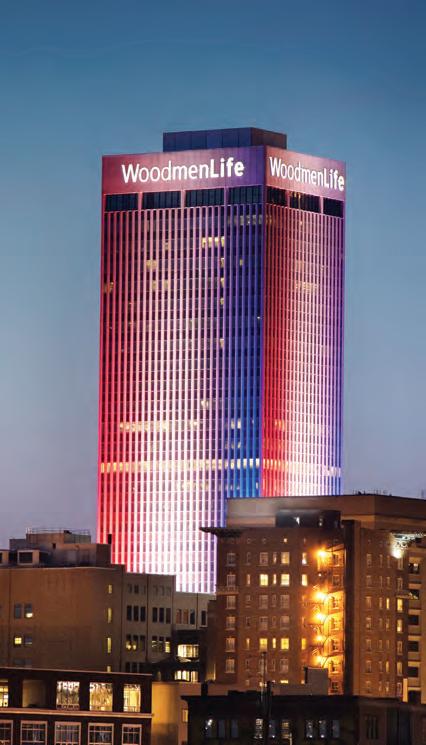
Blair, Nebraska, is proud to be home to a thriving bioeconomy anchored by Cargill and our Bio Campus partners, which continue to drive innovation and jobs for our region. The Blair Crossings development, the first major apartment project in over 20 years, will bring much-needed housing and strengthen quality of life for families. Add to that new amenities like Generations Park with its splash pad and amphitheater, top-notch schools, and the charm of small-town living just 20 minutes from Omaha, and it’s clear that Blair is building a brighter, more vibrant future for both residents and businesses.
– Phil Green, City Administrator, City of Blair
Blair Apartment Project Signals City’s Growth Momentum
Blair’s major apartment development is underway as the $27 million Blair Crossing Apartments take shape at the intersection of U.S. 30 and Highway 133. The 132-unit complex will feature modern amenities such as a pool, fitness center, and dog park — marking a new chapter in the city’s housing landscape.
Backed by a mix of local and state incentives, tax-increment financing, and infrastructure improvements, the project reflects a broader push to expand housing options and attract new investment. City leaders hope the development will help meet workforce needs while setting the stage for future growth across Washington County.
Because We’re More Than Life Insurance®...
For more than 135 years, WoodmenLife has been committed to providing financial stability and peace of mind. Our commitment extends beyond financial products; we donate time, money, and resources to help strengthen communities from the ground up.
Visit woodmenlife.org to learn more about how we work to build lasting legacies that benefit families, neighbors, and towns for generations to come.





















































































































































































































Rooted in Omaha.

















Reaching around the world.
















































































Every member of our global team leads with passion, developing state-of-the-art agricultural, infrastructure, and Industrial Internet of Things (IIoT) technology solutions and products that solve real-world challenges efciently, safely, and sustainably. Together, we’re improving the quality of life for people around the world and those right next door.






OTOE COUNTY
County Seat: Nebraska City
County Description: Otoe County lies southeast of Omaha and offers a rural lifestyle with strategic access to both Omaha and Lincoln. With roughly 16,000 residents, Nebraska City serves as the county’s anchor and cultural hub. The community’s Missouri River location, strong transportation network, and business friendly leadership make Otoe County an appealing place for companies seeking land, workforce, and quality of life in one package.
Largest employers include: Cargill Meat Solutions, Nebraska City Public Schools, Arbor Day Farm/Lied Lodge, Honeywell American Meter Co., OPPD, CHI Health St. Mary’s, Nebraska City Utilities, Ambassador Health
Recreational Trail Gets New Segment
Nebraska City residents cheered the completion of a new segment of the city’s planned five-mile recreational trail in June.
The segment runs seven-tenths of a mile from the North Table Creek Bridge on 11th Street to an intersection near the
Nebraska City is a historic community where great ideas grow. I love living and working here. Our success is rooted in what we call TREES (Traffic, Retail, Entrepreneurs, Education, and Sustainability): traffic flows through two major highways, railroads, and river barges, connecting us to the region and beyond. Retail thrives thanks to dedicated local merchants who serve both residents and visitors. Entrepreneurs have long shaped our downtown, from 19th-century pioneers to today’s tech-savvy innovators. Education
Nebraska City Softball Complex. The $630,000 in construction costs came from the Otoe County keno fund, the Nelson and Kropp Foundations, and a Nebraska Game and Parks Recreational Trails Program grant.
The project involved a lot of utility relocations, the installation of slopes compliant with the Americans With Disabilities Act, drainage features, and three street crossings. Users of the trail can enjoy the beauty of nature as the trail winds along the creek.
The Tree City Trail Committee is already planning future sections of the trail to enhance physical wellness, tourism, recreation, safe school routes, and connectivity between residential neighborhoods and the business community.
Alex Duryea, Nebraska Game and Parks recreational trail manager, expected up to 30 trail applications in 2025 for competitive grant funding as communities looked to add pathways through nature.
“It’s a big component of livability within your community,” he said. “It also helps reinforce community health. It gives people places to go outside and enjoy nature and also a place to exercise and recreate and just spend time with loved ones.”
is a cornerstone, with strong public and parochial schools, a regional learning center, and the Nebraska Center for the Education of Children who are Blind or Visually Impaired. And sustainability is more than a value — it’s a practice, with tree planting efforts and community foundations investing over $2 million annually back into Nebraska City.
– Doug Friedli, Executive Director of the Missouri River Basin Lewis & Clark Visitor Center
Funds Renew Pretty Streetscape
Otoe County commissioners approved $30,000 in matching funds in 2025 to renew the streetscape at the East Fourth Corso entrance to Nebraska City.
Sally DuBois of Keep Nebraska City Beautiful said the organization adopted the area as a project more than two years previously and worked with the state regarding the rightof-way along the J. Sterling Morton Beltway.
The streetscape’s Victorian theme shows that Nebraska City is proud of its origins and history. The original design featured five globe Victorian lights. Twelve pillars were erected with a metal mesh on top. The columns were intended to reflect the porticos at Arbor Lodge.
Nebraska City received a Roads Department grant of $39,000 for the lighting and trellis near the Missouri River bridge entrance.
MILLS COUNTY
County seat: Glenwood
County Description: Mills County sits in southwest Iowa, directly across the Missouri River from Omaha. With about 15,000 residents, it offers the space and infrastructure needed for business expansion while maintaining strong connections to the metro area. Glenwood serves as the county’s civic and commercial center, offering a welcoming environment for families and companies seeking room to grow.
Largest employers include: Glenwood Community School District, Mills County Government, Bunge North America
Mills Crossing Mega Site Offers Advantages
Economic development officials in Mills County, Iowa, are hopeful that Mills Crossing attracts world-class businesses and the jobs they would bring. The development-ready mega site has been certified by Quest Site Solutions through the Iowa Economic Development Authority’s Certified Sites program.
The site is east of Glenwood, population 5,358, which is considered part of the Omaha metropolitan area and its 1 million people.
The 1,650-acre industrial site is accessible via a four-lane highway (Highway 34 to Interstates 29 and 80), a BNSF Railway track, and a major commercial airport a half-hour away. Mills Crossing is fully served by MidAmerican’s electric and natural

Living in Mills County offers residents the best of both worlds. You’ve got that great small town atmosphere yet are less than 30 minutes from the heart of Omaha’s cultural and entertainment districts. Living options are numerous ranging from historic turn-of-the-century homes, suburbanstyle homes, to beautiful acreages nestled into the scenic Loess Hills. And you get to know your neighbor here as well. We are also in the beginning stages of developing a 245-acre residential community sitting on a hill looking over the City of Glenwood, with direct access off Highway 34. This new-urbanism development will offer many types of residences including townhomes/rowhomes, multifamily and single family homes. This development will be a draw for families from across the region.
– Larry Winum, CEO of Glenwood State Bank
gas systems. Robust fiber optics are onsite, and water/ wastewater service can be readily and economically extended for a wide variety of uses.
Potential employers looking to move to Glenwood will notice that local businesses – a key component of quality of life – also thrive here. Keg Creek Brewing is a community hub for locals to gather and socialize. Outdoor activities abound throughout the picturesque Loess Hills including hiking and the famous Taco Night bicycle ride along the Wabash Trace Trail.

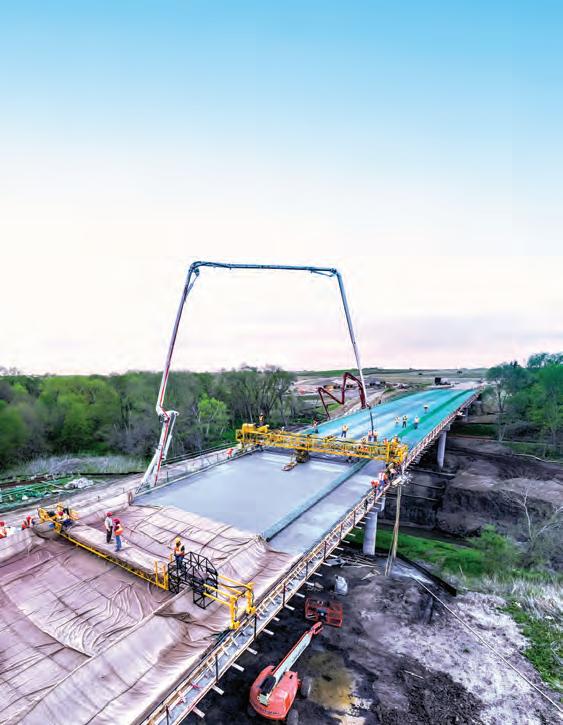



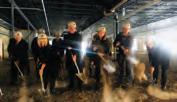



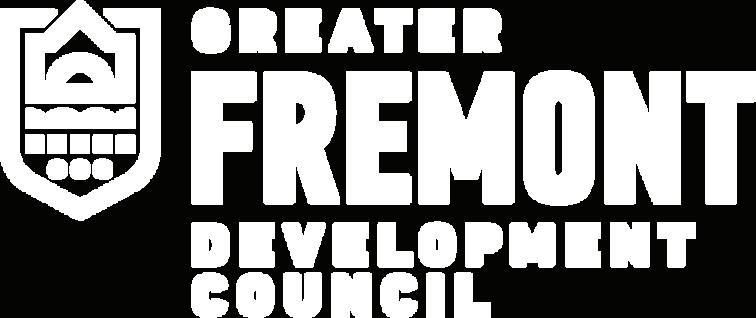


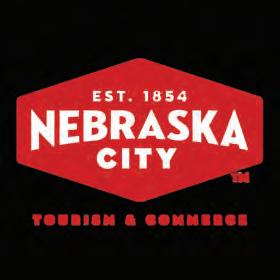


PAUL WEST HELPS BUILD OMAHA’S FUTURE LEADERS
Carson Wealth Partner Encourages the Next
Generation

Leadership is about the future.
Finding the next leaders and bringing them to the forefront to continue Omaha’s development is a challenge Paul West takes seriously.
“How do we train and build the leaders we need for the future?” said West, who is managing partner of the investment consulting firm Carson Wealth and 2026 chair of the Greater Omaha Chamber’s board of directors.
Omaha has benefited from strong, foresighted leaders, from construction magnates Peter Kiewit Jr. and Walter Scott to political leaders Johnny Rosenblatt and Eugene Leahy to philanthropists Susan Buffett and Richard Holland.
They and many others set the city moving forward with a solid foundation to grow further.
“There are a lot of transformational things happening in the city, and we have a lot of amazing people,” West said. “We need this next generation of leaders to step up and continue to help.”
Economic growth is under way, including efforts to bring the city’s older sections into the mode of success. For example, West works with the upcoming innovation hub in North Omaha, one of three to receive State of Nebraska money to encourage business growth.
“I think Omaha, overall, is making a lot of the right efforts to get the brain gain we're looking for,” West said, “keeping our youth in our state and providing wage growth and employment opportunities, a work-life balance by having enough things to do.
“We're always going to push to say, ‘What else are we doing to really be thinking 10, 20, 30 years-plus ahead to help put the next generation in the right position?”
In a way, he said, today’s leaders are a bridge between the leaders of the past and those of the future.
“I’m part of this turnover generation,” West said. “I do acknowledge the challenge but also call it a welcome opportunity.”
One Person at a Time
Leaders can emerge in many ways.
Omani Carson started a finance business in his University of Nebraska-Lincoln dormitory room in 1983. When West joined in 2012, the firm had 36 employees; today there are more than 500.
That doesn’t count two spin-off businesses: Carson Coaching, with 11,000 alumni who learned the business from company experts, and Carson Group Partners, a network of more than 150 locations plugged into Carson’s computer infrastructure, marketing platform, and other elements.
Such entrepreneurial efforts help leaders emerge. West encourages similar pathways one person at a time through mentoring and in batches, including entrepreneurial collectives and a new social club called Apiary (think of a beehive of business activity). Its 300-plus members meet regularly and learn from each other.
“We’ve called this the infinite stage, wanting people to think infinitely in terms of the future,” he said, including ways to keep young people in Omaha.
“One of the things we at Carson wanted for our younger employees is not to have the pressure of having to sell,” West said, “but rather to come in and learn the business and learn how to work with families and learn the technical components.”
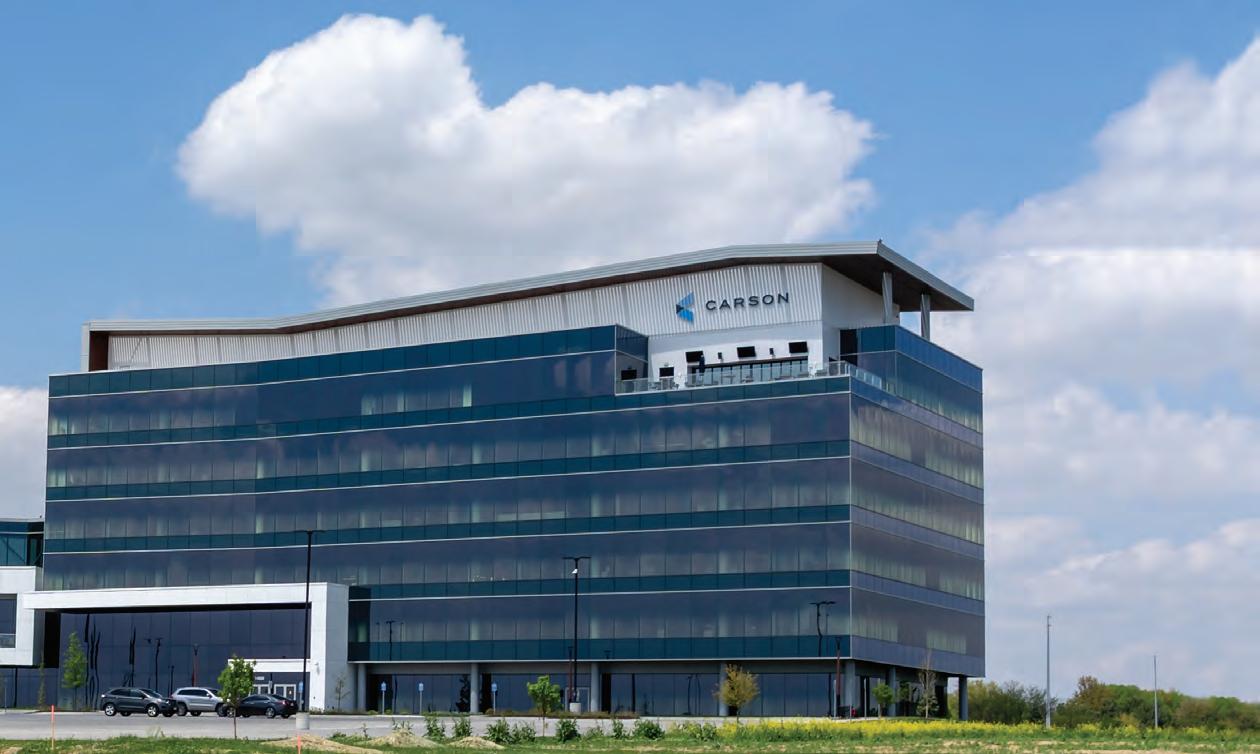
Asavolunteerandsupporter, heisactiveinDreamweaver, anonprofitthathelps terminallyillseniors achieve their dreams.

The firm’s para-planner program does just that. West's son, Liam, is a para-planner for the Carson office in Fairmont, Minnesota, but works remotely from the Omaha headquarters.
“It's a great pathway for a lot of our young professionals, who have done really well for us,” West said.
He mentors a half-dozen individuals outside Carson. “Others have helped me. I’m trying to reciprocate.”
From his mentors, West said, he learned that emotional intelligence is important.
“You can be successful, but you need to be emotionally aware of everyone you're working with and what's important to them,” he said. “Mentors helped me find ways to get all the things off my plate that I shouldn't be doing and being comfortable with empowering your people to let them do what they do best.”
Branching Out
w He also gave back in a significant way to his alma mater with friend Jon Bruning, former Nebraska attorney general, fellow University of Nebraska alumnus, and supporter of UNL sports.
When the new rules allowed student-athletes to receive cash for their name, image, and likeness (NIL), West and Bruning formed Athlete Branding & Marketing to raise money for those payments.
“We really cared about Nebraska athletics and wanted to foster their success, so we needed a way to work within the rules,” West said. “Nobody knew what to do, so we really dug in and learned what we could and couldn’t do.
“We were able to talk to a lot of the donors about what we were doing and how we were going to compete and support studentathletes in football, basketball, volleyball, and other sports.”
In 2024 a new group stepped forward and took over that function as 1890 Nebraska, now the official NIL collective for Nebraska athletics.
Carson remains active on the 1890 Foundation board of directors and also is working with University of Nebraska at Omaha athletics.
Such changes are likely for Omaha’s entire economy, West said.
“How much of it is going tech-based?” he said. “I do a lot in the entrepreneurial ecosystem, and I know they dig in and roll their sleeves up.
“We're always going to have entrepreneurs here, and hopefully we keep supporting them. If we do, there are always going to be success stories.”
Paul West is the Managing Partner at Carson Wealth. PHOTO COURTESY OF CARSON WEALTH.
Global Reach. Local Strength.
Gallup helps leaders and organizations turn data into decisions that create thriving workplaces and communities.
Our presence on Omaha’s Riverfront anchors Gallup’s global mission, connecting the work of 500+ local associates to leaders around the world.
Learn more at Gallup.com.
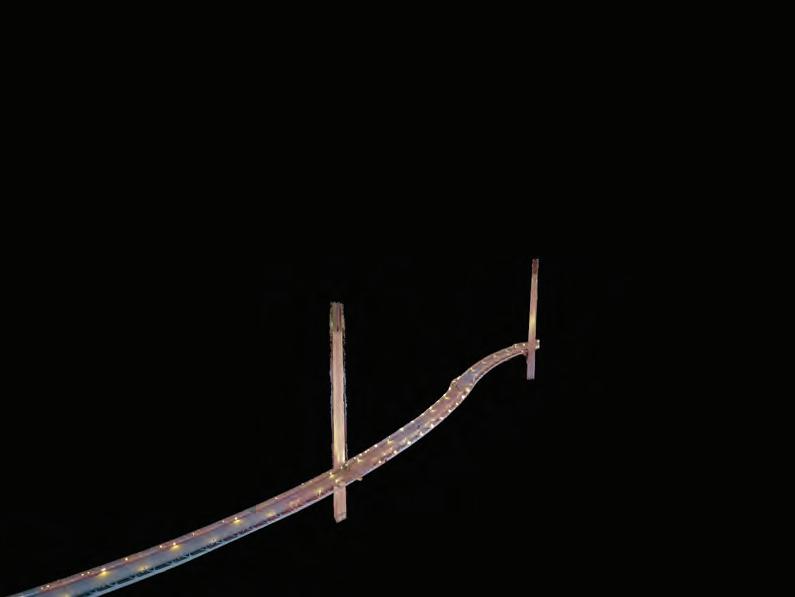
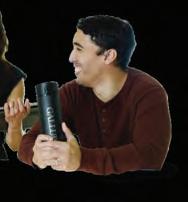







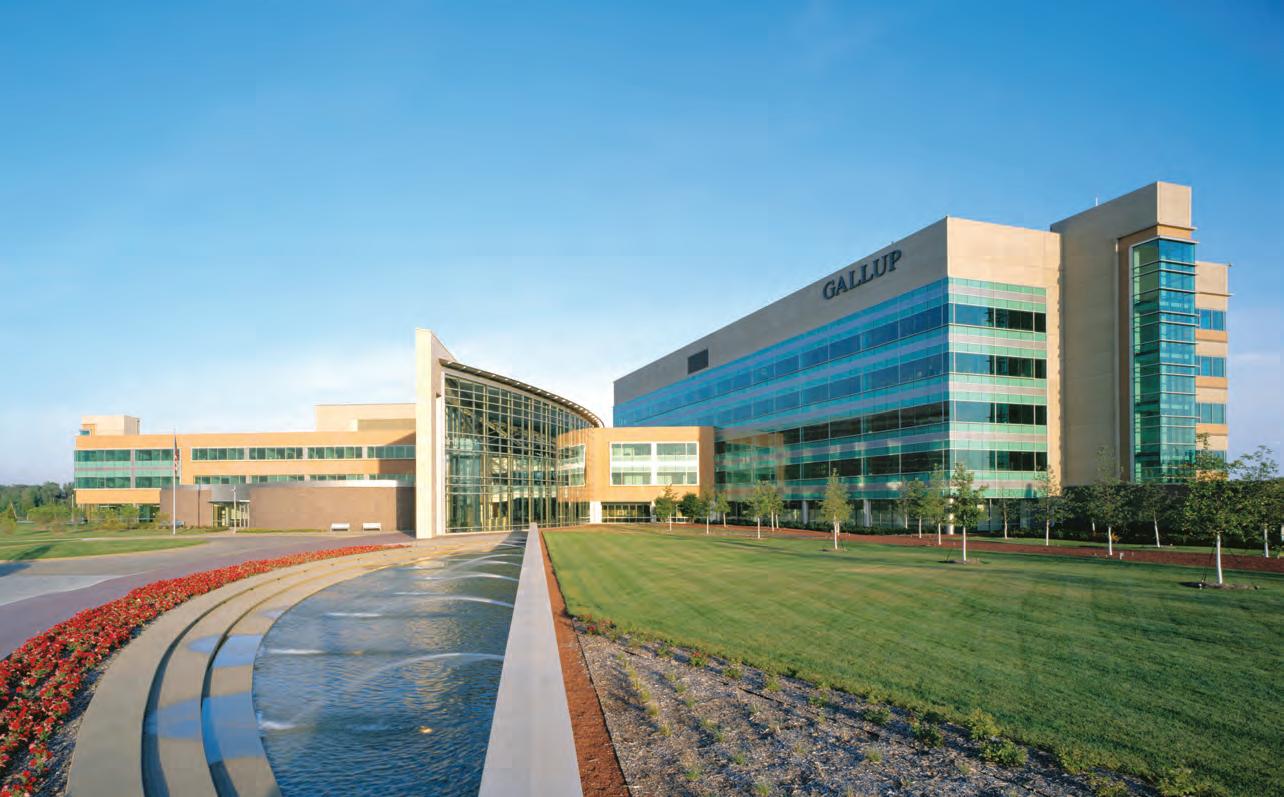
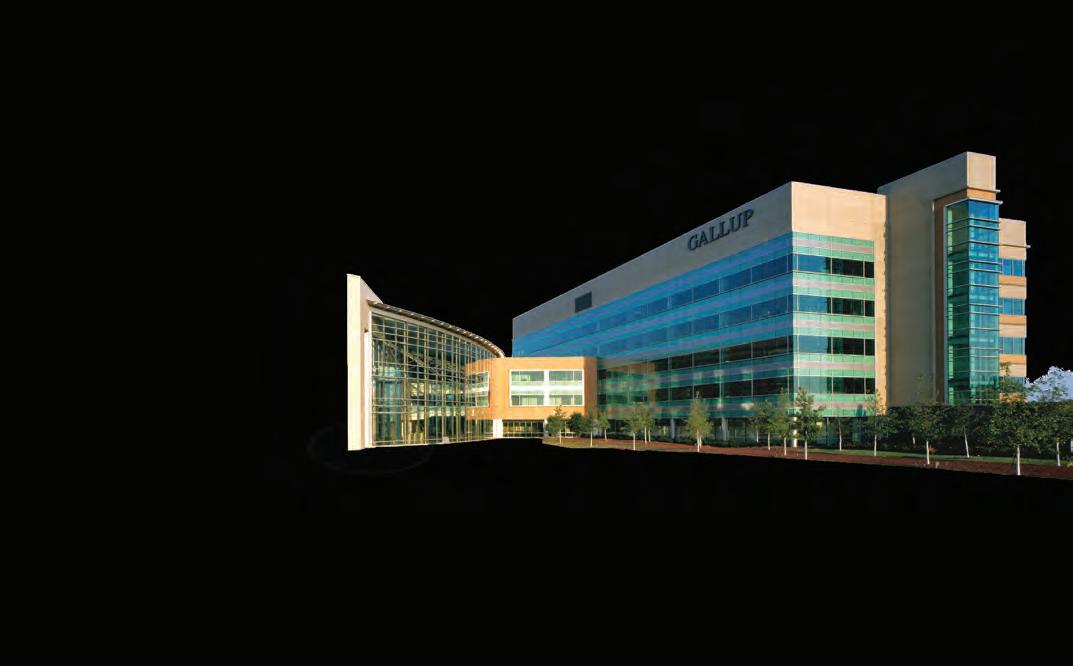






CARMEN TAPIO BUILT BUSINESS WITH PURPOSE
Trailblazer Has Succeeded in Creating Jobs and Changing Lives in North Omaha
Keisha Thomas remembers her first lunch meeting with Carmen Tapio more than 10 years ago as one filled with inspiring conversation and opportunity for change – both of which she was looking for in her next career move.
“Carmen talked about her vision and mission for starting North End Teleservices to engage and lift up people from underrepresented and underserved communities, and I knew I had to be part of that,” said Thomas, who was working for a large medical recruiting company at the time. “I knew I wanted and needed to be part of something so important and life-changing.”
As the first employee of Tapio’s startup venture in 2015, Thomas, now the vice president of human resources, employee & community relations, has been with Tapio every step of the way as she has built North End Teleservices (NET) into one of the fastest-growing businesses in the United States. Thomas, originally a team of one as human resources project manager, has built up her team to 19 while helping Tapio grow NET to 1,000 employees.
Throughout her career, Tapio has thought of others first –grounded in the values she learned from her parents. As she climbed ladders in some of the country’s largest business process outsourcing companies, she shattered glass and concrete ceilings to forge her own path.
“My father, in particular, taught me to create change in any way you can and to live my life as an example to others,” said Tapio, who moved to Bellevue for her father’s work in the Air Force in 1976 and has called Omaha home ever since.
“I try to do that every day with every decision I make, every action I take. It’s not always easy, but the intent is to always stay true to dreaming and creating possibilities.”
Purpose-Driven Business
Tapio launched NET with a bold mission: to create jobs and change lives in North Omaha, a historically underserved area marked by high unemployment and systemic barriers.
Carmen Tapio, left, speaks during a news conference announcing economic recovery grants at Metro Community College. NIKOS FRAZIER
Celebrating Women’s Leadership
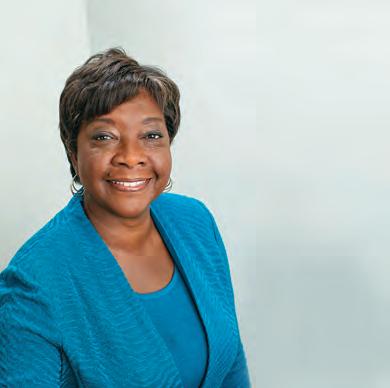
And while hard work and dedication helped get her where she is today, she acknowledges she hasn’t accomplished it alone.
“Every job and position I’ve held since my first job working for the (Henry Doorly) Zoo during the summer as a teenager has taught me the value of hard work and teamwork,” she said. “We rarely accomplish big things without help or support from others.”
Tapio’s journey began in teleservices at age 18 – working her way up to global leadership roles in business process outsourcing and a consulting business – before founding North End.
NET provides outsourced contact center services to both public and private sectors – including one of the largest service contracts in the U.S. government. The company is part of the $250 billion global outsourcing industry. But its real innovation lies in its holistic approach to employment.
Tapio’s decision to locate the company in the heart of North Omaha was intentional. She wanted to bring opportunity to the neighborhood – not just jobs.
In addition to being one of six employers that provide onsite social workers through its Work Lab program, NET offers a transportation program that provides rides to and from work for anyone who wants to participate.
Its transportation fleet embodies inspiration with the names Faith, Hope, Joy, Peace, Grace, and Unity.
“Each member of our fleet is named for these virtues because they represent opportunities to overcome the barriers such as transportation,” said Tapio, who was inducted into the Omaha Business Hall of Fame in 2022. “Our city is still working on solving transportation shortcomings.
“Everyone should have the opportunity to work, and if getting there is an obstacle, I want to take that away so they can work. This isn’t just about workforce development. It’s about life transformation.”
Economic Impact and National Recognition
Over the past decade, NET has created hundreds of jobs in Omaha while generating more than $500 million in economic impact. In addition to its five-time Inc. 5000 designation, NET
was recognized by the U.S. Chamber of Commerce in 2024 as one of the top 100 U.S. small businesses.
North Omaha has long faced challenges – double-digit unemployment, limited access to capital, and historic disinvestment.
Tapio’s work is helping reverse that trajectory by investing not only in people but also in blighted areas, breathing new life into neighborhoods through real estate including their business location at 72nd Street and Mercy Road.
She founded Nebraska Black Women United, a statewide network focused on mentorship, access, and legacy-building. Her efforts are creating a pipeline of opportunity – not just for employees, but for entrepreneurs, students, and families.
Tapio and her husband, Bob, are deeply involved in educational initiatives, including the CBA Prep Academy at the University of Nebraska at Omaha, which supports first-generation and underrepresented students, offers early exposure to college and career pathways, and builds a diverse talent pipeline from high school to the Omaha workforce.
Tapio believes that early exposure to possibility is key.
“What young people believe is possible helps them understand what is accessible to them,” she said.
Community Impact
Tapio’s impact extends far beyond NET. She serves on numerous boards, highlighted by the Federal Reserve Bank of Kansas City, Werner Enterprises, and the Omaha Inland Port Authority.
She is the past chair of the Greater Omaha Chamber of Commerce board of directors and is a trustee of the Ewing Marion Kauffman Foundation, a national organization focused on entrepreneurship, education, and workforce development.
Her business accolades include being named USA Today’s Woman of the Year for Nebraska in 2022 and a Forbes Next 1000 Entrepreneur. She also won an Urban League African American Leadership Award and the Better Business Bureau’s BBB Torch Award for Ethics.
But her true legacy is in the lives she’s helped change – those who walked through NET’s doors and found not just a job, but a career and a future – as well as others in the community who have benefited from her philanthropy.
Her philanthropic vision also includes place-based investment. Her Forever North project – a mixed-use development near 24th and Lake Streets – aims to be transformative. The project will feature a new global headquarters for North End Teleservices, affordable housing, and child care and retail spaces.
The development, designed as an anchor, is the largest privately funded development in North Omaha, serving as a model for comprehensive community revitalization.
“Since its founding in 2015, NET has exemplified the power of purpose-driven business – creating pathways to opportunity and transforming lives right here in Omaha,” said Heath Mello, Greater Omaha Chamber of Commerce president and CEO.
“Under Carmen’s visionary leadership, NET has anchored their business in community while seeing exponential growth, bringing quality jobs to our region and building lasting relationships for the betterment of Omaha.”
Carmen Tapio received top honors as Woman of the Year in the 2023 Inspire Awards, which recognize and celebrate women's leadership in Omaha. WORLD-HERALD














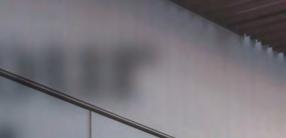
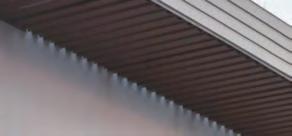





















WhenevervisitorsstopbytheState Capitol,Gov.Pillenremindsthemofwhathe hasknownasalife-longresident–Nebraska isthesafestandgreatestplacetolive.Itisa statewithamazingpeople,tremendous potentialandlimitlessopportunities.

PILLEN AT THE HELM OF THE STATE OF NEBRASKA
A Deeper Look at the 41st Governor of Nebraska
A lifelong Nebraskan, Governor Jim Pillen is shaped by hard work, love of family and commitment to community – values instilled in him by his parents – tenant farmers who raised three boys in a modest home in Platte Center. Growing up, Gov. Pillen had two goals – to play football at the University of Nebraska – Lincoln and to become a veterinarian.
Despite being told by a college school counselor he would likely have to choose one or the other if he wanted to be successful, Gov. Pillen achieved recognition in both areas. He was a two-time First Team All-Big Eight Huskers defensive back for legendary Coach Tom Osborne, he was named an Academic All-American and later, earned his Doctor of Veterinary Medicine from Kansas State University in 1983.
In Columbus, Gov. Pillen opened his own veterinary clinic, treating dogs, cats and small animals, as well as a swine consulting practice. He then opted to combine his veterinary expertise with his farming roots, partnering with his dad on a hog operation that began with 60 sows and 1,200 market hogs on a dirt lot. In 1993, he founded Pillen Family Farms and later added a genetics company. Today, the family business is managed by two of his adult children.
Throughout his time in Columbus, Gov. Pillen remained active in community organizations and would eventually serve for a decade as a University of Nebraska regent. After that, he felt the need to heed a different calling. Joined by family members, he toured the state, embarking on a campaign for Governor that would take him from the Missouri River all the way to Harrison, with stops in all 93 counties.
Gov. Pillen’s pride in his home state, the places he’s visited and the people he’s met, have all had significant influence on his philosophy around governance. Every event is an opportunity to brag about Nebraska’s exceptional people, abundant natural resources and innovative edge. As the state’s 41st Governor and the first governor in more than 100 years to come from a background in agriculture, Gov. Pillen keeps his focus on four key pillars: kids, taxes, agriculture and values. They are the basis of his administration and the foundation for growing the state’s Good Life, for “the next seven generations.”
When it comes to leading the state, Gov. Pillen approaches it in much the same way he did as an entrepreneur and businessman — with a systems-driven mindset focused on
finding efficiencies, improving processes and ultimately, delivering
and
to Nebraskans.
Ranked as one of the nation’s most fiscally conservative governors and never one to shy away from competition, Gov. Pillen embraces an all-in, non-stop attitude to his role as governor and encourages the same high-value focus and topnotch results from his agency cabinet.
Approaching the third year of his administration, Gov. Pillen has launched initiatives aimed at addressing workforce, childcare and other issues at a grassroots level: driving and rewarding entrepreneurial ideas; providing students with in-state scholarships; positioning Nebraska as a leader in agriculture and the bioeconomy; improving the state’s critical infrastructure; preserving and protecting state resources like land and water; supporting business development in both urban and rural areas; connecting high schoolers with corporate apprenticeships and other opportunities; boosting mentorship and much more.
Top of mind among the Governor’s goals -- fixing the state’s property tax crisis so that having a home remains within reach for young adults and doesn’t force seniors from staying in theirs. Addressing property taxes is foundational to making the state more competitive and keeping families here for generations to come. It’s also essential for economic growth. Attracting people to the state will help with workforce, giving Nebraska-based businesses opportunity to grow. From Nebraska’s existing Fortune 500 companies to family-owned enterprises and mom and pop stores, Gov. Pillen is committed to growing businesses that are already here, giving them greater opportunity for success.
One standout in that regard is Offutt Air Force Base near Omaha. As the headquarters for STRATCOM, it plays a central role in the nation’s nuclear force and national defense – a role that continues to expand and includes a pressing need for people trained in software engineering, cyber security and related technologies.
Whenever visitors stop by the State Capitol, Gov. Pillen reminds them of what he has known as a life-long resident – Nebraska is the safest and greatest place to live. It is a state with amazing people, tremendous potential and limitless opportunities. Nebraska has a lot to offer, if we take the time to appreciate it.







FERNANDEZ ENERGIZES OPPD FOR THE FUTURE
Leader of publicly owned utility is committed to innovation
During a December 2016 stop in Omaha to interview for the vice president and chief financial officer role at OPPD, Javier Fernandez learned firsthand that “Nebraska Nice” is a real thing. His flight arrived late, and with limited taxi availability and Uber not popular yet in Omaha, he waited outside in the cold for transportation to his hotel.
“Two guys ahead of me got the last taxi at the terminal, so I just waited to see if another would be coming along soon,” said Fernandez, originally from Mexico City but no stranger to the North American cold, having lived in Oregon and having just flown in from New York City.
“The taxi got about 20 feet ahead, and then stopped. The guys got out, asked if I needed a lift, and invited me to share the ride. Who knows how long I would have had to wait if it wasn’t for their kindness?”
From that moment, Fernandez said, he knew Omaha was the right next move for his family.
“While living in Portland, my wife and I were actually looking for a next place to live, somewhere that was family-friendly – we have three children – with good business opportunities and a good way of life,” he said.
“Even before I pursued the job at OPPD, we had identified Omaha as one of our top choices. So this all worked out for the best for me professionally and for my family. We love Omaha.”
Fernandez accepted the position with OPPD in 2017 and four years later was promoted by the board to president and chief executive officer.
Lessons Learned
Before coming to Omaha he was executive vice president and chief financial officer of the Bonneville Power Administration, an agency of the U.S. Department of Energy, in Portland, Oregon.
Along with his OPPD duties, Fernandez serves as chair of the Omaha Branch Board of the Federal Reserve Bank of Kansas City. He also is chairman of the Habitat for Humanity Omaha board and serves on other local boards including that of the Greater Omaha Chamber.
Born and raised in Mexico City, Fernandez came to the United States to pursue higher education, earning an MBA from Yale University and later becoming a U.S. citizen.
“One of the most important lessons I learned in coming to work in the U.S. was that I needed to learn about football,” he said. “We, of course, had football in Mexico, but that’s soccer in the
States, so learning about football in the U.S. and being able to discuss it with people served an important purpose – especially once I arrived in Nebraska.”
Fresh Perspective
His leadership is marked by urgency, innovation, and a deep commitment to both internal excellence and external collaboration – qualities that are reshaping how OPPD operates in the business and energy markets.
As OPPD’s first president and CEO of color, he said he understands the power and influence of his position. His background offers a fresh perspective, a deep commitment to public service, and a bold vision for the future of energy in Nebraska.
“I understand my responsibility (as a leader of color), but 95% of what and who I am is not that different from previous presidents,” Fernandez said. “Because I am international, I think I see things through a different lens.
“I’ve worked hard to get my citizenships, my education, the positions I have had. That makes me the same as any other person, regardless of race or nationality, in this and other leadership roles.”
Navigating Changes
In an era of unprecedented energy transformation, Fernandez is steering one of the nation’s largest publicly owned electric utilities through a complex and rapidly evolving landscape.
Under Fernandez’s leadership, OPPD is pursuing a bold expansion of its power generation capacity, with a mix of clean energy and natural gas projects designed to meet growing demand while staying on track for its net-zero carbon goal by 2050.
OPPD is doubling its generation portfolio by the end of the decade. In 2024 alone, the utility energized two new power stations and acquired solar and wind farms totaling 1.6 gigawatts. The total buildout includes 3.2 gigawatts of new capacity – half from natural gas-fired peaking stations and half from renewables.
This expansion is not just about growth – it’s about resilience.
“I’m very proud of these additional power stations and what they mean to the people of Omaha, specifically a longterm solution to maintaining consistent power delivery at an affordable price,” he said.
For decades, utilities operated in a world of abundant energy and predictable demand. Today, Fernandez must balance decarbonization, electrification, and resource adequacy – all while maintaining affordability and reliability.
Customer Service Key
He is vocal about the need to shift the narrative.
“Nebraska provides some of the least expensive power in the country,” he said. “We always have, and because we’re public power, we’re able to keep providing that.”
Fernandez is clear-eyed about the road ahead. He understands that electrification of the economy will strain existing systems – and he is committed to decarbonizing OPPD’s fleet without compromising reliability.
Fernandez is not just leading OPPD – he is redefining what leadership in the field of public power looks like.
“I’m super proud of the addition of the power plants, but I’m equally excited that we’re also implementing a complete change to the meters on customers’ homes,” Fernandez said. “They’ll be sensored, so when you’re on vacation in Arizona, for instance, and there’s an interruption or outage, we will be notified so we can restore power quickly.
“Technology continues to improve, and that will help us improve our service to our customers. Because we’re public power, the only people we have to report to are our customers. They are our investors. We do what we do for them.”
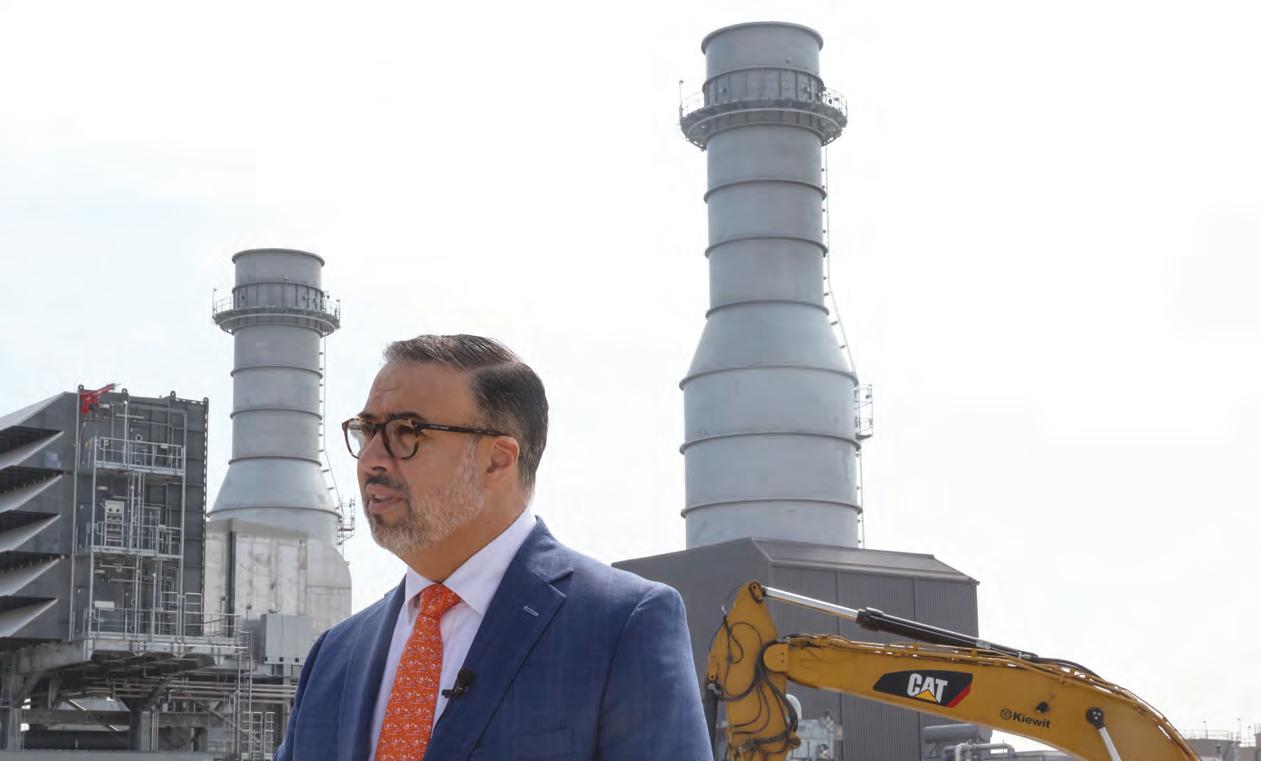
OPPD president & CEO Javier Fernandez speaks to the media during the ribbon and ground breaking ceremony celebrating the completion of two new generation facilities in Papillion. MATTHEW MUELLER

TRANSITIONS IN OMAHA
Buffett Leaves Berkshire in Good Hands
Warren Buffett’s decision to step down as chief executive of Berkshire Hathaway Inc. at the end of 2025 marked a transition like no other for Omaha.
The immediate impact is on Berkshire, whose 400,000 employees have a new boss and whose millions of investors have a new CEO, Greg Abel.
For Omaha, questions arise from Buffett's decision to end his practice of spending hours on stage answering shareholder questions at the company’s annual meeting. He’s apparently delegating that duty to Abel, too.
Instead of being on center stage, non-executive Chairman Buffett will sit in the audience with other Berkshire directors and do the same thing he promises to do the rest of the year: speak up if and when he’s asked.
Still, Buffett’s in-person observations, advice, and humor, was able to pull 40,000 or so people to come to the meeting each spring, filling hotels, renting cars, spending more than $20 million, and in general enjoying Omaha.
Local officials believe the aura of Buffett, Omaha’s hospitality, and the history of friendships and side activities surrounding Berkshire weekend will continue to make the event the “Woodstock for Capitalists.”
Buffett hasn’t said whether ending his executive responsibilities will change his Omaha role, although he has been more behind-the-scenes in civic affairs anyway.
Other early local Berkshire shareholders have been strong supporters of the city and show no signs of letting up. His daughter, Susie, is the source of Buffett support for Omaha projects with her nonprofit, the Sherwood Foundation.
In fact, Susie Buffett is part of a group that grew out of what was perhaps an even greater financial transition for Omaha: the transfer of wealth amassed by the city's 20th century generation of leaders to, in large part, the community itself.
Key players in that transition were Walter Scott Jr., Willis Strauss, and Robert Daugherty, corporate CEOs who in 1989 founded a group now called Heritage Omaha.
Since then Heritage has supported 17 major public and private improvements in the Omaha area, from high school athletic fields to a veterans hospital to a future children’s museum along the Missouri River.
In all, $800 million in Heritage-raised private funds have created more than $1.7 billion in projects, most of them also supported by public agencies.
Walter Scott’s goal, shared by his fellow past business leaders and current dozen Heritage board members, is to channel financial successes created in Omaha to improve the city itself, rather than leaking out to other cities and states.
Ken Stinson, Scott’s successor as CEO of construction giant Kiewit and a Heritage director, once said, “The stronger and more vibrant we make our community, the better place it is for business, the better place it is for everyone.”
Scott’s predecessor, Peter Kiewit Jr., had set the tone for business owners whose wealth outstripped their needs. The Kiewit Foundation, started in 1980 and due to “sunset" in 2030, became a force for community improvement, alongside a community group known as the Knights of Ak-Sar-Ben and later supplemented by Heritage Omaha.
As for Buffett’s transition, the timing of his step-aside announcement was a surprise. He explained that once he hit 90 years old, in 2020, he was less energetic than the executives around him.
But plans for a successor were in place decades ago, well before Greg Abel joined Berkshire as head of an energy subsidiary in 1999.
In fact, Buffett’s investment partners in the 1950s once formed a committee to plan what to do if Buffett died suddenly — the “runaway truck” scenario.
For many years, Buffett would reassure shareholders that his directors at all times knew the name of the person who could take over immediately if needed. The name of that person remained secret and changed over the years due to age, departures from the company, and other factors.
The late Charlie Munger, Berkshire vice chairman and a major influence on Buffett’s investment philosophy, once chided people who were critical of Buffett for not naming a successor earlier. If you believe Buffett’s decisions created a successful company over 60 years, Munger said, why would you doubt that he would do a good job of naming a successor?
As time went on, Buffett said that he realized he was an outlier according to actuarial tables that predict human life spans, although he frequently said he hoped to emulate Rose Blumkin, who founded Nebraska Furniture Mart and continued working until she was 103.
As it turned out, the transition to Greg Abel, who was born in 1962, has been gradual. He rose steadily within Berkshire, becoming head of Berkshire’s broad collection of non-insurance companies and sharing the meeting stage with Buffett and Vice Chairman Ajit Jain, head of the insurance businesses.
In 2021, a slip of the tongue by Munger revealed that Abel was
the chosen successor. When it finally happened, there was immediate praise, including a comment in The Omaha WorldHerald from Adam Johnson, CEO of Berkshire’s NetJets:
“No one has done a better job at that than Warren himself in naming Greg as his successor.”
Buffett’s three children, who were the only ones informed in advance about his decision, support his choice. “I think the company will continue to get stronger and better with Greg,” Susie Buffett told The World-Herald. “I really believe that.”
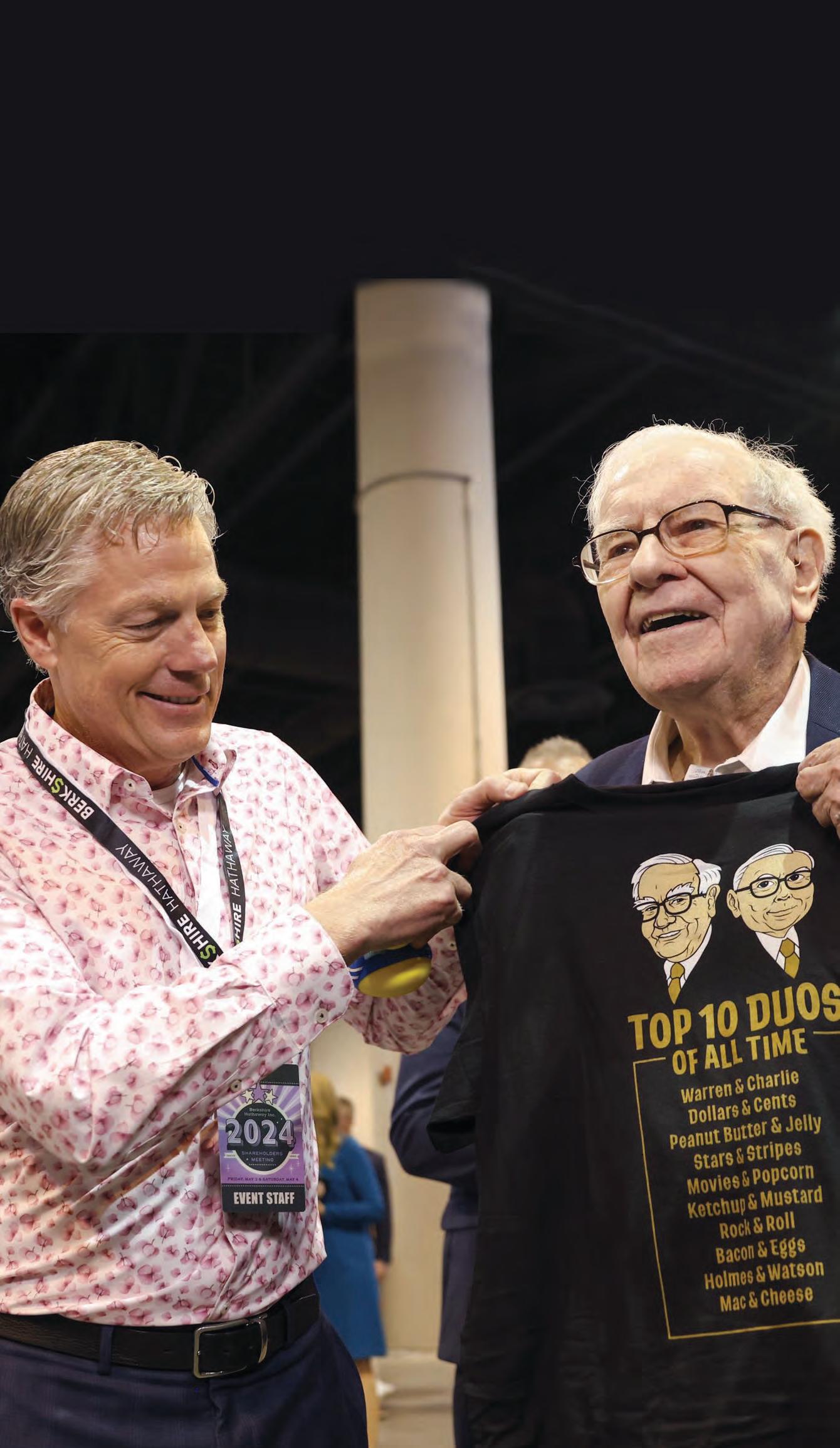
Formanyyears,Buffettwould reassure shareholders that his directors at all times knew thenameoftheperson who could take over immediately if needed.
Warren Buffett is presented a T-shirt during Berkshire Hathaway’s Shareholder Shopping Day at the CHI Health Center, complimenting him and his long-time business partner, Charlie Munger. NIKOS FRAZIER

FORTUNE 500 COMPANIES REV UP CITY'S ENGINE
In One Way of Counting, There Are Six Omaha-Based Companies on the List

Omaha has four Fortune 500 companies – pretty good for a city of a million people. You can probably name them: Warren Buffett’s Berkshire Hathaway, Union Pacific, Kiewit, and Mutual of Omaha.
However, in a different angle, there are actually six Omahabased companies listed by Fortune magazine among the 500 U.S. businesses with the most annual revenue. By that count, Omaha and Nebraska rank among the top cities and states, per capita, as homes for big businesses.
Rankedbysheernumber ofcompanies,throughthis lens Omaha is tied with Milwaukee and St. Louis with six each.
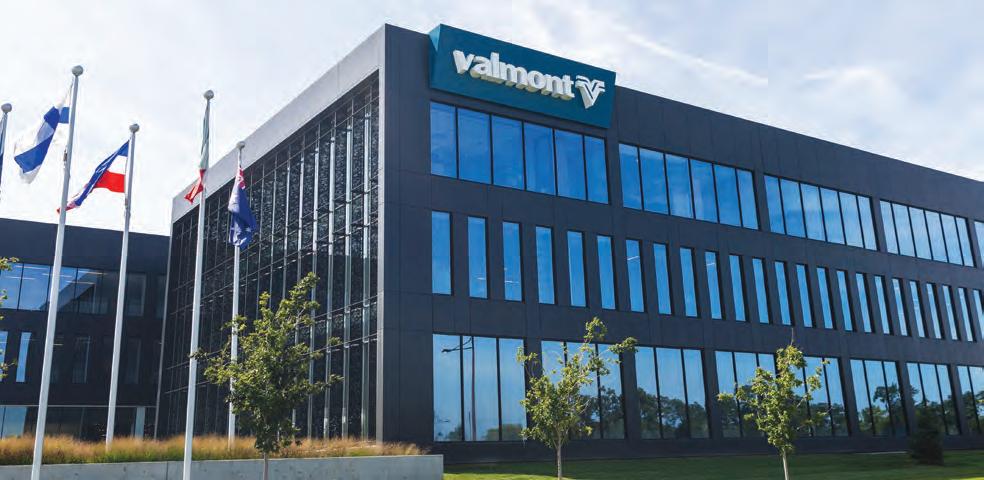
It’s not just bragging rights at stake, although that’s allowed.
Big businesses mean people with good-paying jobs, generating money that filters to the other 40,000 businesses in Omaha, to philanthropy, to the tax base, and to the general well-being of a city.
They’re engines of growth, competitive on a global scale, part of the city’s identity, and a reputation for good things happening.
“Fortune 500 companies are foundational pillars of our region’s economic success,” says Heath Mello, Omaha Chamber president and CEO. “Their global reach, deep community roots, and continued reinvestment have helped make Omaha one of
the most resilient and opportunity-rich cities in the country.”
Mello added that the companies “serve as innovation engines, infrastructure builders and are vital partners in the team effort of elevating Omaha,” contributing to a business-friendly reputation that helps attract talent and investment.
In other words, big businesses help Omaha and its people thrive.
Two more Fortune 500 businesses slipped into Omaha, with a different story from the more-recognized four, which grew from small to big over decades or even a century, slowly building their sales into billions with longtime headquarters in the city.
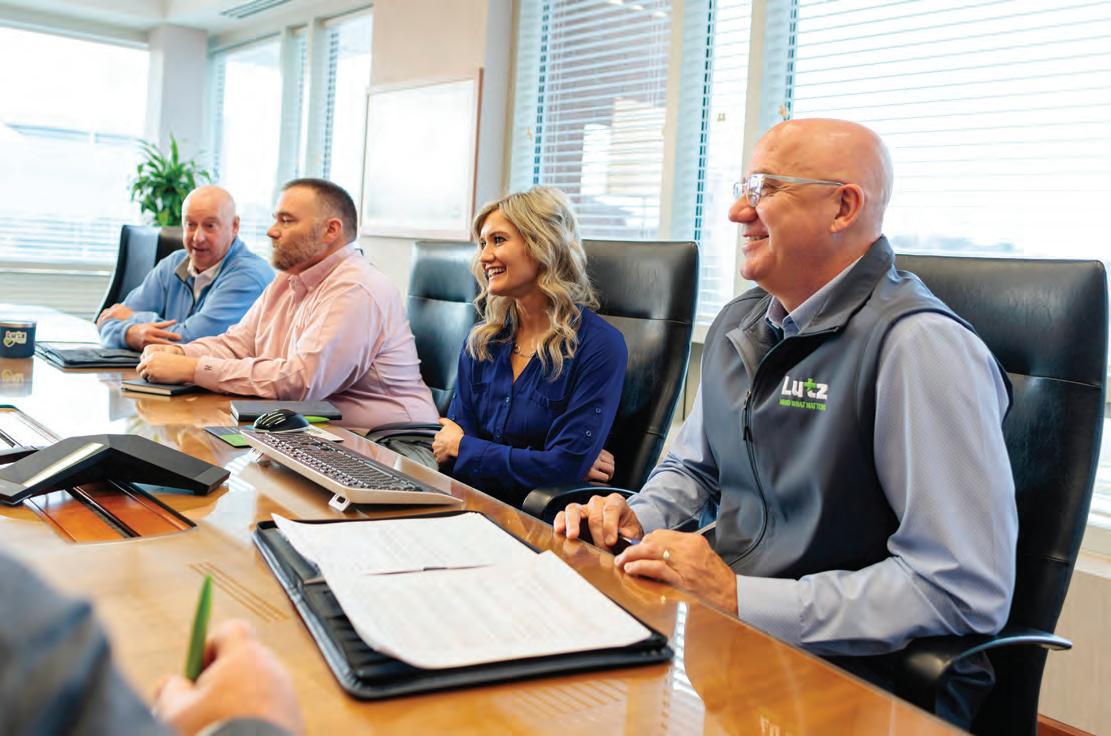
The “usual” four Omaha heavyweights, their Fortune rankings, and their latest annual revenues:
• No. 6, Berkshire Hathaway Inc., $371.4 billion.
• No. 177, Union Pacific Corp., $24.2 billion.
• No. 247, Kiewit Corp., $16.8 billion.
• No. 299, Mutual of Omaha, $14.6 billion.
That’s $427.1 billion total. (Berkshire Hathaway has, besides its investment holdings, a collection of more than 70 companies — BNSF Railway, NetJets, Geico, Fruit of the Loom, Nebraska Furniture Mart, Berkshire Hathaway Energy, National Indemnity, etc.)
The other two companies on the 500 list are two of Omaha's two “newcomer" giants:
• No. 222, Aflac Insurance, $18.9 billion.
• No. 272, Pacific Life Insurance, $15.8 billion.
The key element they share: Both are insurance companies that declared Omaha to be their official corporate homes, even though their main headquarters may be elsewhere.
It works like this: Insurance companies that set their legal residence in Nebraska are “domiciled” in the state, meaning they are subject to the state’s insurance laws and oversight by the Nebraska Department of Insurance, a state agency.
For some insurance companies, those regulations provide financial advantages. State government touts those potential savings as an incentive for insurance companies to declare domicile in the state.
In particular, Nebraska has a relatively low tax rate on insurance
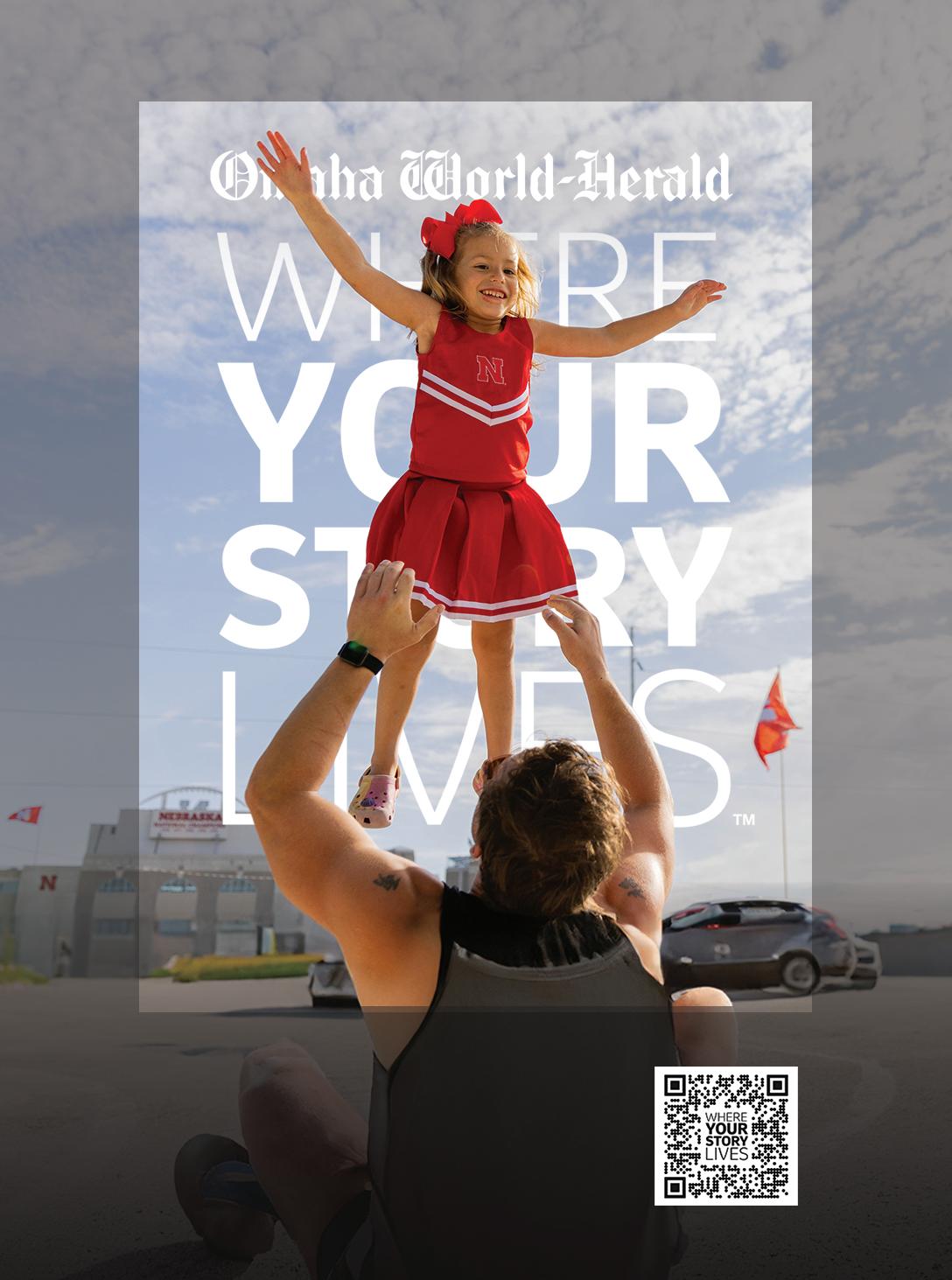




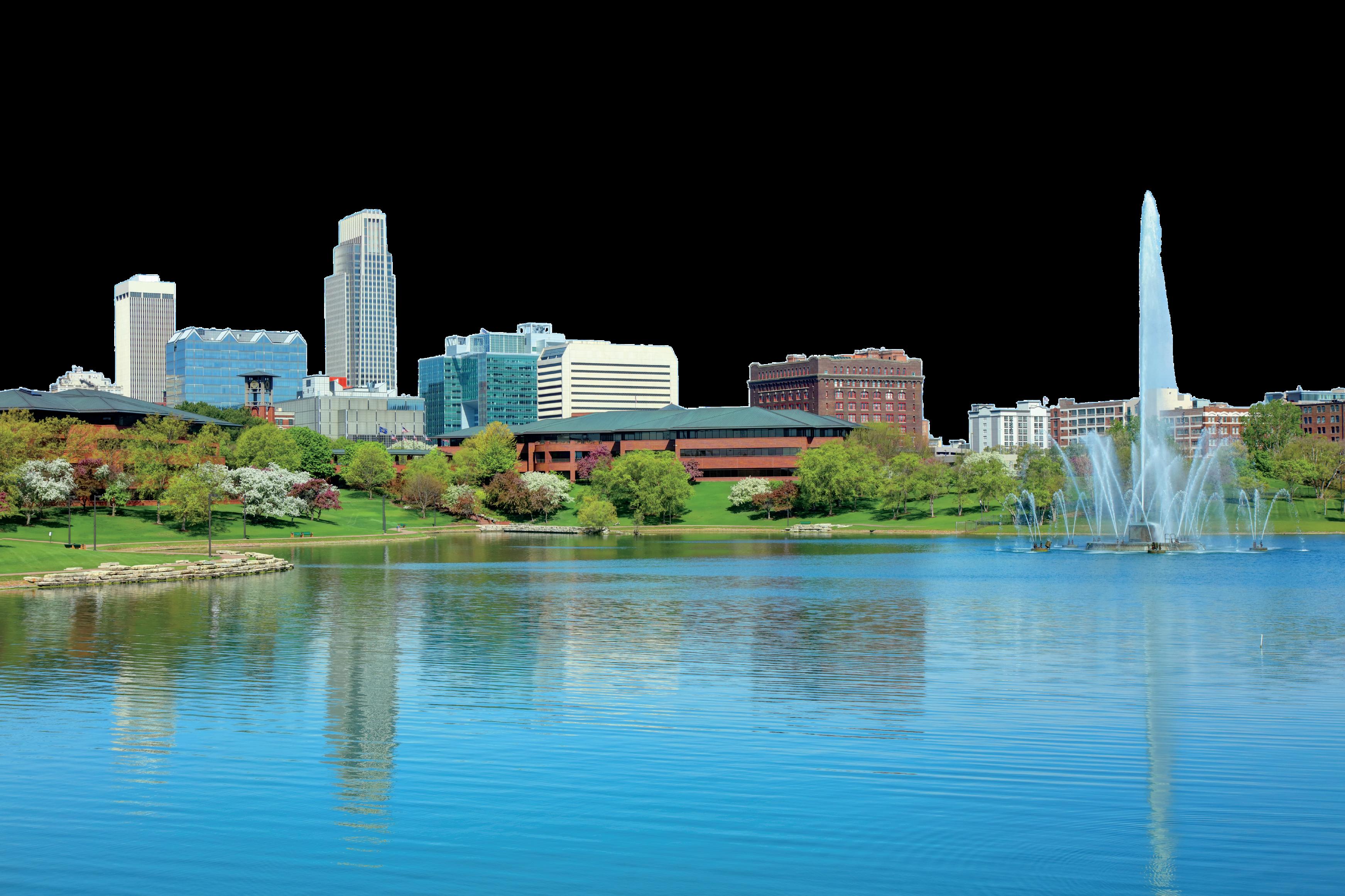


premiums, a direct boost for a domiciled company’s bottom line. In return, the Department of Insurance requires them to maintain offices in the state, employing people to carry out such functions as claims processing, law, information technology, sales support, or customer relations.
Given Omaha’s familiarity with insurance and financial services, those white-collar jobs are right in line with Omaha’s educated workforce.
Aflac, headquartered in Columbus, Georgia, moved its domicile to Nebraska in 2001. Pacific Life, headquartered in Newport Beach, California, moved in 2004. Both have regional offices in Nebraska.
Others attracted by the state regulations include Metropolitan Tower Life Insurance Co., a subsidiary of MetLife Inc. of New York City; American Interstate Insurance Co.; First American Title Insurance; and Fidelity National Title Group, which later merged into a Florida-domiciled company and is inactive in Nebraska. While their local work force may be as robust as the better-

known four, their presence adds feathers to Omaha’s corporate cap. Together, they employ several hundred people.
As for the other four, they’ve been growing. Compared with 2018, Berkshire’s revenue is up by 53 percent, Union Pacific's by 14.2 percent, Kiewit's by 96 percent, and Mutual's by 67 percent.
Ranked by sheer number of companies, through this lens Omaha is tied with Milwaukee and St. Louis with six each. With a metro population of about 1 million, that means Omaha has six Fortune 500 companies per million people, a big number even though national city comparisons are lacking.
For Nebraska, with a population a little more than 2 million, that’s 2.99 Fortune 500 companies per million, compared with the next highest state, Minnesota, at 2.96 per million.
Of course, Omaha has other big businesses, even if they haven’t reached the Fortune 500 level yet. Who's to say they might move up from the Fortune 1,000 list:
There’s Valmont Industries, No. 768 with $4.1 billion in revenue. First National of Nebraska, No. 879 with $3.2 billion. Werner Enterprises, No. 906 with $3 billion.
Just missing the Fortune 1,000 list this year is Green Plains Energy, with $2.5 billion in revenue.
Will there be more big businesses in Omaha’s future – the free enterprise system is competitive, so every other company on the list is trying to grow, too. It’s up to Omaha to provide the people, the atmosphere, and the ideas that will make that happen.

Recruiting & Staffing
Find the best people for your most important positions. Connect with one of our recruiting experts today.

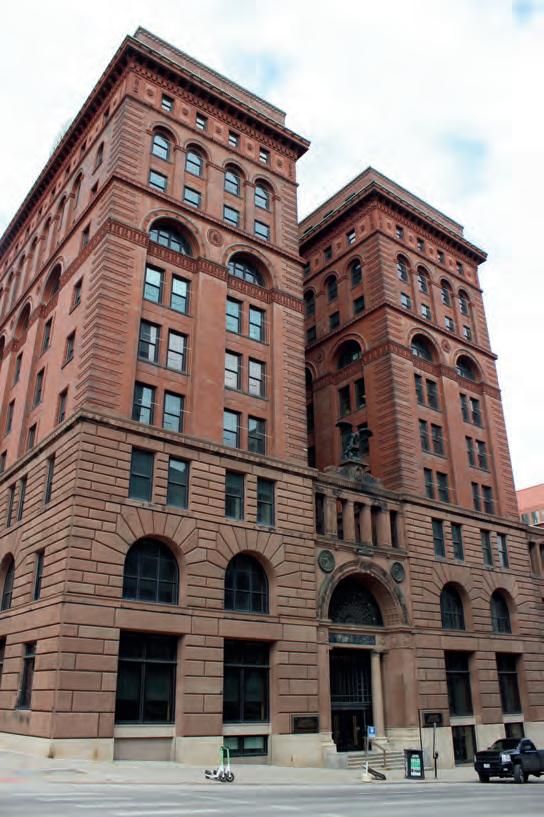

FREIGHT EXPECTATIONS
Railroad Merger Promises Seamless Shipping Across the Country
The 2025 announcement of Union Pacific’s $85 billion acquisition of Norfolk Southern marked a significant shift in the U.S. freight rail industry, setting the stage for the creation of America’s first coast-to-coast railroad.
This merger will unite over 50,000 miles of track across 43 states, linking approximately 100 ports and forming a $250 billion transportation powerhouse.
Once the merger is approved by federal regulators, the resulting railroad will be known as the Union Pacific Transcontinental Railroad and will be based in Omaha, as U.P. is now.
“A single coast-to-coast network will deliver faster, more competitive service,’’ said Jim Vena, U.P. CEO. He said the merger will reduce interchange delays, open new routes, expand intermodal services, and ensure faster transit times on key rail corridors.
Union Pacific and Norfolk Southern are two of the strongest railroads in the United States, with a combined 360 years of history.
Strategically, the merger is designed to eliminate bottlenecks and
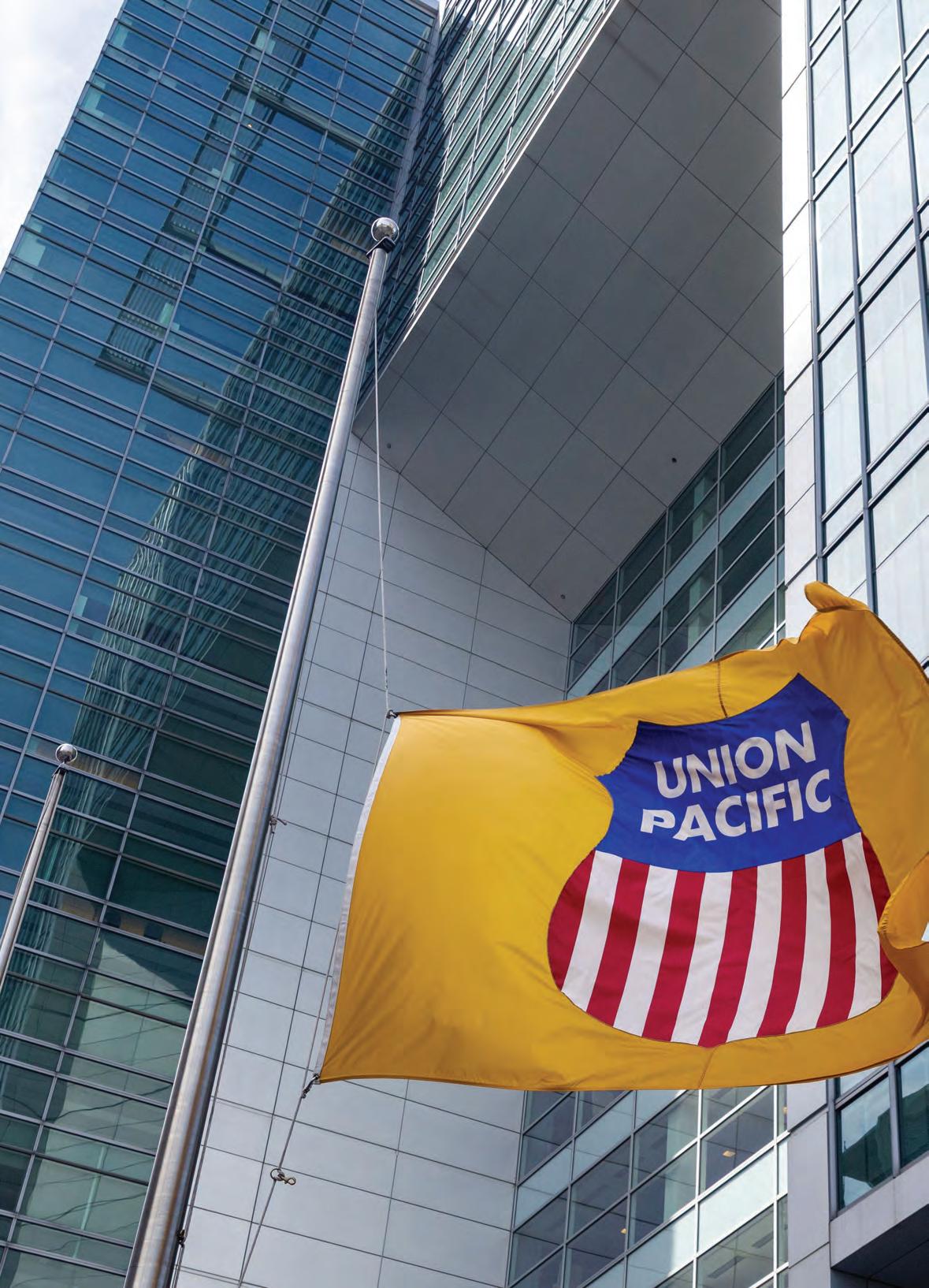
U.P.employsabout5,500 peopleinNebraska,with roughly3,000ofthemin theOmahaarea,and operatesmorethan 1,000milesof track in the state.
inefficiencies that have long plagued cross-country rail freight, such as in the Ohio Valley and both sides of the Mississippi River. Currently, shipments often require handoffs between carriers – especially in hubs like Chicago and New Orleans – causing delays and increasing costs.
A unified network will enable single-line service from origin to destination, shaving days from transit times and significantly improving reliability.
The merger also promises substantial economic and environmental benefits. Union Pacific estimates $2.75 billion in annualized synergies, driven by operational efficiencies, fuel savings, and streamlined logistics.
“This landmark achievement honors the very spirit upon which our nation’s railroads were founded: to connect a growing country through infrastructure, innovation, and purpose,” said Heath Mello, President & CEO of the Greater Omaha Chamber.
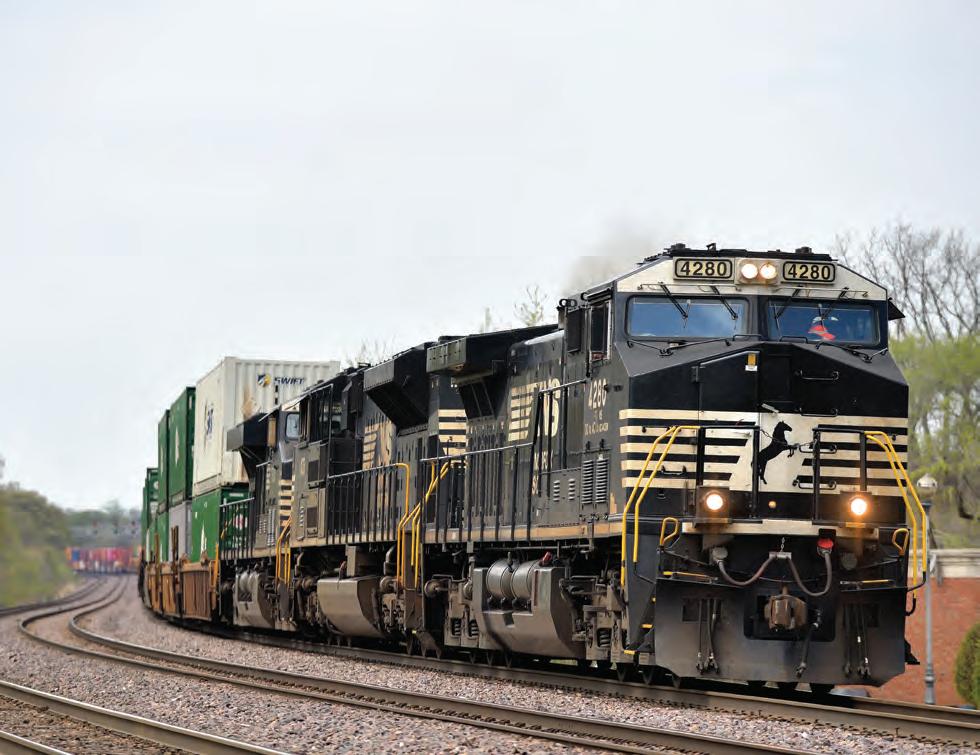
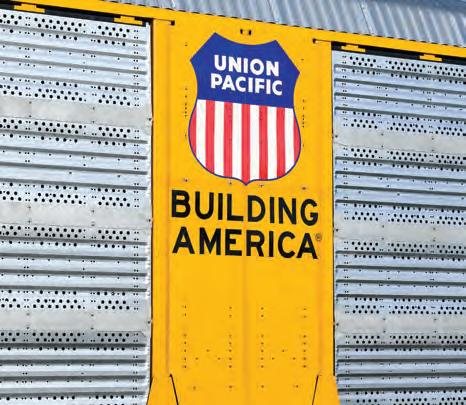
THE NEWS TEAM AT THE OMAHA WORLD-HERALD IS COMMITTED TO COVERING OUR COMMUNITY WITH DEPTH, TENACITY, AND PASSION.
WHETHER IT’S COVERING LOCAL BUSINESS, BRINGING YOU THE LATEST HOME & GARDEN TRENDS, OR FOLLOWING THE ACTION IN LOCAL SPORTS, OUR PASSION FOR TELLING THE STORY OF OMAHA REMAINS UNWAVERING.
“This partnership will strengthen domestic supply chains, open new markets, and reinforce our nation’s global competitiveness.”
Shippers stand to gain from reduced costs and expanded market access. Companies that will benefit from the merger have voiced support, citing the potential to transform supply chains and strengthen U.S. manufacturing competitiveness.
The path to finalizing the merger is complex. It must be approved by the U.S. Surface Transportation Board, which will scrutinize its impact on competition, labor, and safety. The railroads hope to complete the merger in 2027.
U.P. employs about 5,500 people in Nebraska, with roughly 3,000 of them in the Omaha area, and operates more than 1,000 miles of track in the state. The companies said union employees, including train crew members and mechanical and engineering workers, will have job opportunities with the combined company.
Rail volume growth is also expected to drive additional employment in towns and cities across the network.
“We are especially proud that Union Pacific Railroad, one of the most iconic names in American industry, continues to call Omaha, Nebraska, home,” Mello said. "Their leadership in reshaping the future of freight transportation reinforces our region’s central role in building a more connected and prosperous nation.
“The Chamber and business community looks forward to supporting this new rail partnership that will deliver for generations to come.”





